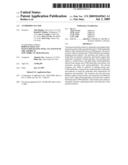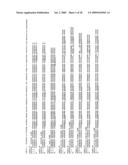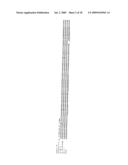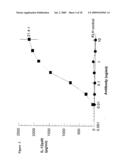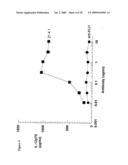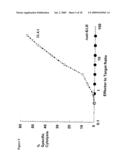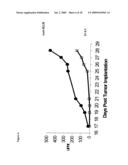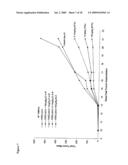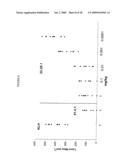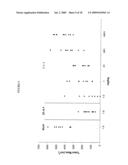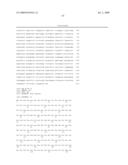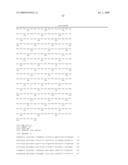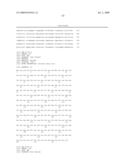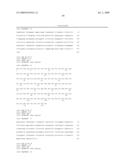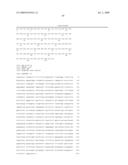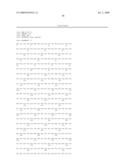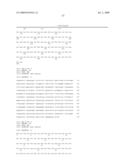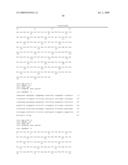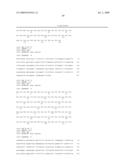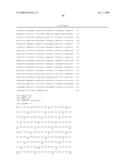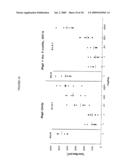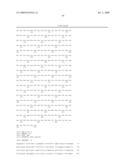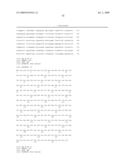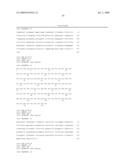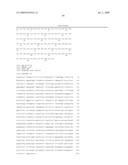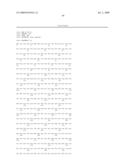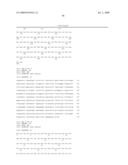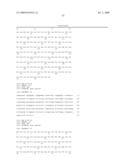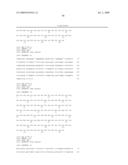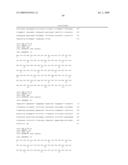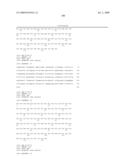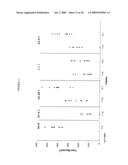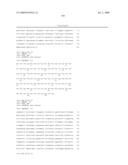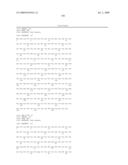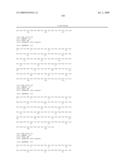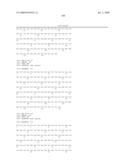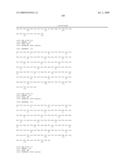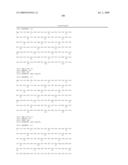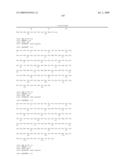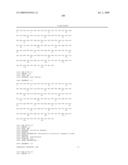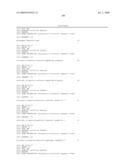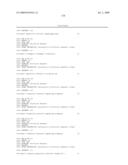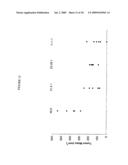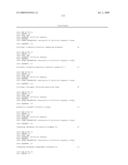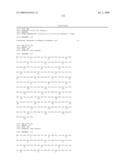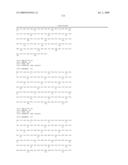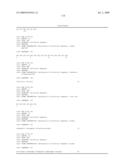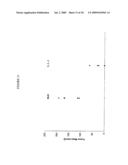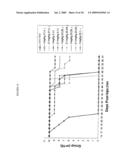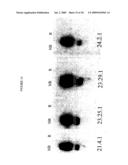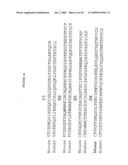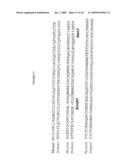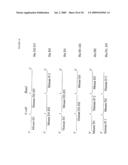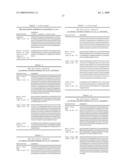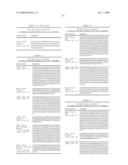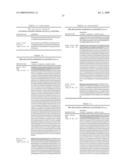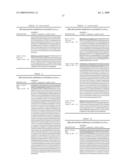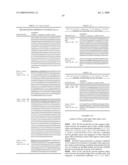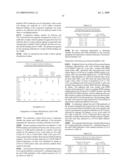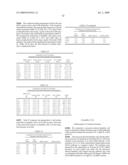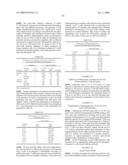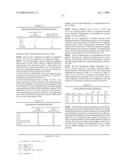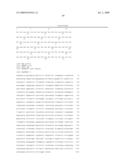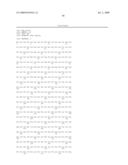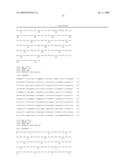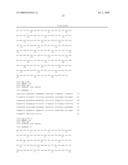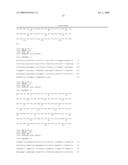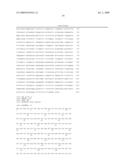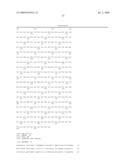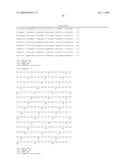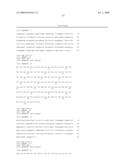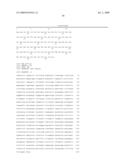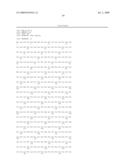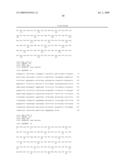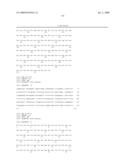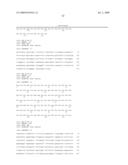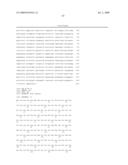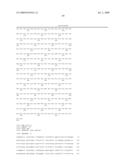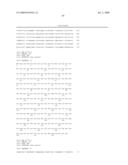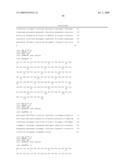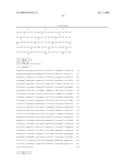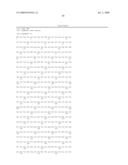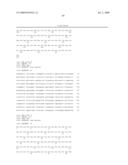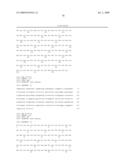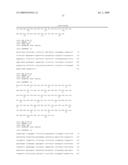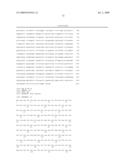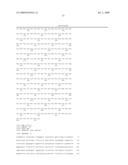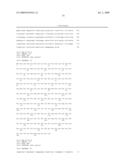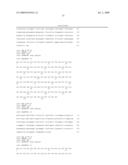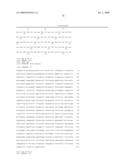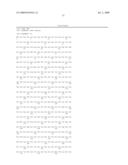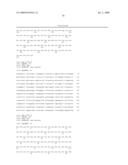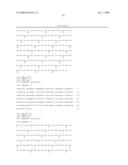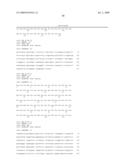Patent application title: Antibodies to CD40
Inventors:
Vahe Bedian (East Lyme, CT, US)
Vahe Bedian (East Lyme, CT, US)
Ronald P. Gladue (Stonington, CT, US)
Ronald P. Gladue (Stonington, CT, US)
Jose Corvalan (Foster City, CA, US)
Jose Corvalan (Foster City, CA, US)
Xiao-Chi Jia (San Mateo, CA, US)
Xiao-Chi Jia (San Mateo, CA, US)
Xiao Feng (Union City, CA, US)
Assignees:
Abgenix, Inc.
PFIZER INC.
IPC8 Class: AA61K39395FI
USPC Class:
4241431
Class name: Immunoglobulin, antiserum, antibody, or antibody fragment, except conjugate or complex of the same with nonimmunoglobulin material monoclonal antibody or fragment thereof (i.e., produced by any cloning technology) binds receptor
Publication date: 2009-07-02
Patent application number: 20090169563
Claims:
1-31. (canceled)
32. A monoclonal antibody or an antigen-binding portion thereof that specifically binds to and activates CD40, wherein said antibody comprises a heavy chain and a light chain, wherein said heavy chain and said light chain comprise the heavy and light chain CDR1, CDR2 and CDR3 amino acid sequences, respectively, of an antibody selected from the group consisting of: 7.1.2, 10.8.3, 15.1.1, 21.2.1, 22.1.1, 23.5.1, 23.25.1, 23.28.1, 23.29.1 and 24.2.1.
33. The monoclonal antibody or antigen-binding portion thereof of claim 32, wherein said heavy chain and said light chain comprise the amino acid sequences of the heavy and light chain variable domains, respectively, of an antibody selected from the group consisting of: 7.1.2, 10.8.3, 15.1.1, 21.2.1, 22.1.1, 23.5.1, 23.25.1, 23.28.1, 23.29.1 and 24.2.1.
34. The monoclonal antibody of claim 32, wherein said heavy chain and said light chain comprise the amino acid sequences of the heavy chain and the light chain, respectively, of an antibody selected from the group consisting of: 7.1.2, 10.8.3, 15.1.1, 21.2.1, 22.1.1, 23.5.1, 23.25.1, 23.28.1, 23.29.1 and 24.2.1.
35. The monoclonal antibody of claim 32, wherein said heavy chain and said light chain consist of the amino acid sequences of the heavy chain and the light chain, respectively, of an antibody selected from the group consisting of: 7.1.2, 10.8.3, 15.1.1, 21.2.1, 22.1.1, 23.5.1, 23.25.1, 23.28.1, 23.29.1 and 24.2.1.
36. A human monoclonal antibody or an antigen-binding portion thereof that specifically binds to and activates CD40, wherein said antibody comprises the heavy chain variable domain amino acid sequence of an antibody selected from the group consisting of: 7.1.2, 10.8.3, 15.1.1, 21.2.1, 22.1.1, 23.5.1, 23.25.1, 23.28.1, 23.29.1 and 24.2.1.
37. The monoclonal antibody or antigen-binding portion thereof of claim 36, wherein said antibody comprises the heavy chain amino acid sequence of an antibody selected from the group consisting of: 7.1.2, 10.8.3, 15.1.1, 21.2.1, 22.1.1, 23.5.1, 23.25.1, 23.28.1, 23.29.1 and 24.2.1.
38. A human monoclonal antibody or an antigen-binding portion thereof that specifically binds to and activates CD40, wherein said antibody comprises the light chain variable domain amino acid sequence of an antibody selected from the group consisting of: 7.1.2, 10.8.3, 15.1.1, 21.2.1, 22.1.1, 23.5.1, 23.25.1, 23.28.1, 23.29.1 and 24.2.1.
39. The monoclonal antibody or antigen-binding portion thereof of claim 38, wherein said antibody comprises the light chain amino acid sequence of an antibody selected from the group consisting of: 7.1.2, 10.8.3, 15.1.1, 21.2.1, 22.1.1, 23.5.1, 23.25.1, 23.28.1, 23.29.1 and 24.2.1.
40. An isolated cell line that produces the antibody according to claim 32.
41. The isolated cell line according to claim 40, wherein said cell line produces an antibody whose heavy chain and light chain consist of the amino acid sequences of the heavy chain and the light chain, respectively, of an antibody selected from the group consisting of: 7.1.2, 10.8.3, 15.1.1, 21.2.1, 22.1.1, 23.5.1, 23.25.1, 23.28.1, 23.29.1 and 24.2.1.
42. The antibody or antigen-binding portion according to claim 32, wherein said antibody or antigen-binding portion is an Fab fragment, an F(ab')2 fragment, an Fv fragment, a single chain antibody, or a bispecific antibody.
43. The antibody according to claim 32, wherein said antibody is an immunoglobulin G (IgG), an IgM, an IgE, an IgA or an IgD molecule, or is derived therefrom.
44. The antibody according to claim 43, wherein said antibody is an IgG1, IgG2, or IgG3 molecule.
45. The antibody according to claim 44, wherein said antibody is an IgG2 molecule.
46. The antibody according to claim 44, wherein said antibody is an IgG1 molecule.
47. A pharmaceutical composition comprising the antibody or antigen-binding portion-according to claim 32 and a pharmaceutically acceptable carrier.
48. A method of enhancing an immune response in a subject in need thereof, wherein said response is indicated by activation of antigen presenting cells, comprising the step of administering to the subject an effective amount of the antibody or antigen-binding portion according to claim 32.
49. A method of treating cancer in a human, comprising the step of administering to the human the antibody or antigen-binding portion according to claim 32 in an amount effective to treat said cancer.
50. The method according to claim 49, further comprising the step of administering to the human radiotherapy, photodynamic therapy, or surgery.
51. The method according to claim 49, further comprising the step of administering to the human an anti-cancer agent.
52. The method according to claim 51, wherein the anti-cancer agent is a chemotherapeutic agent.
53. The method according to claim 52, wherein the chemotherapeutic agent is taxol or adriamycin.
54. The method according to claim 51, wherein the anti-cancer agent is a signal transduction inhibitor.
55. The method according to claim 54, wherein the signal transduction inhibitor is an ErbB inhibitor.
56. The method according to claim 54, wherein the signal transduction inhibitor is a VEGF inhibitor.
57. The method according to claim 49, wherein the cancer is breast cancer.
58. The method according to claim 49, wherein the cancer is prostate cancer.
59. The method according to claim 49, wherein the cancer is lymphoma.
60. The method according to claim 49, wherein the cancer is lung cancer.
61. A pharmaceutical composition comprising the antibody according to claim 35 and a pharmaceutically acceptable carrier.
62. A method of enhancing an immune response in a subject in need thereof, wherein said response is indicated by activation of antigen presenting cells, comprising the step of administering to the subject an effective amount of the antibody according to claim 35.
63. A method of treating cancer in a human, comprising the step of administering to the human the antibody according to claim 35 in an amount effective to treat said cancer.
64. The method according to claim 63, further comprising the step of administering to the human radiotherapy, photodynamic therapy, or surgery.
65. The method according to claim 63, further comprising the step of administering to the human an anti-cancer agent.
66. The method according to claim 65, wherein the anti-cancer agent is a chemotherapeutic agent.
67. The method according to claim 66, wherein the chemotherapeutic agent is taxol or adriamycin.
68. The method according to claim 65, wherein the anti-cancer agent is a signal transduction inhibitor.
69. The method according to claim 68, wherein the signal transduction inhibitor is an ErbB inhibitor.
70. The method according to claim 68, wherein the signal transduction inhibitor is a VEGF inhibitor.
71. The method according to claim 63, wherein the cancer is breast cancer.
72. The method according to claim 63, wherein the cancer is prostate cancer.
73. The method according to claim 63, wherein the cancer is lymphoma.
74. The method according to claim 63, wherein the cancer is lung cancer.
75. A method for producing a monoclonal antibody or an antigen-binding portion thereof that specifically binds to and activates CD40, comprising culturing the cell line according to claim 40 under suitable conditions and recovering said antibody or antigen-binding portion.
76. A method for producing a monoclonal antibody or an antigen-binding portion thereof that specifically binds to and activates CD40, comprising culturing the cell line according to claim 41 under suitable conditions and recovering said antibody or antigen-binding portion.
Description:
[0001]This application is a continuation application of U.S. patent
application Ser. No. 10/292,088, filed Nov. 8, 2002, which claims the
benefit of U.S. Provisional Application 60/348,980, filed Nov. 9, 2001.
BACKGROUND OF THE INVENTION
[0002]The CD40 antigen is a 50 kDa cell surface glycoprotein which belongs to the Tumor Necrosis Factor Receptor (TNF-R) family. (Stamenkovic et al., EMBO J. 8:1403-10 (1989).) CD40 is expressed in many normal and tumor cell types, including B lymphocytes, dendritic cells, monocytes, macrophages, thymic epithelium, endothelial cells, fibroblasts, and smooth muscle cells. (Paulie S. et al., Cancer Immunol. Immunother. 20:23-8 (1985); Banchereau J. et al., Adv. Exp. Med. & Biol. 378:79-83 (1995); Alderson M. R. et al., J. of Exp. Med. 178:669-74 (1993); Ruggiero G. et al., J. of Immunol. 156:3737-46 (1996); Hollenbaugh D. et al., J. of Exp. Med. 182:33-40 (1995); Yellin M. J. et al., J. of Leukocyte Biol. 58:209-16 (1995); and Lazaar A. L. et al., J. of Immunol. 161:3120-7 (1998).) CD40 is expressed in all B-lymphomas and in 70% of all solid tumors. Although constitutively expressed, CD40 is up-regulated in antigen presenting cells by maturation signals, such as LPS, IL-1β, IFN-γ and GM-CSF.
[0003]CD40 activation plays a critical role in regulating humoral and cellular immune responses. Antigen presentation without CD40 activation can lead to tolerance, while CD40 signaling can reverse such tolerance, enhance antigen presentation by all antigen presenting cells (APCs), lead to secretion of helper cytokines and chemokines, increase co-stimulatory molecule expression and signaling, and stimulate cytolytic activity of immune cells.
[0004]CD40 plays a critical role in B cell proliferation, maturation and class switching. (Foy T. M. et al., Ann. Rev. of Immunol. 14:591-617 (1996).) Disruption of the CD40 signaling pathway leads to abnormal serum immunoglobulin isotype distribution, lack of CD4+ T cell priming, and defects in secondary humoral responses. For example, the X-linked hyper-IgM syndrome is a disease associated with a mutation in the human CD40L gene, and it is characterized by the inability of affected individuals to produce antibodies other than those of the IgM isotype, indicating that the productive interaction between CD40 and CD40L is required for an effective immune response.
[0005]CD40 engagement by CD40L leads to the association of the CD40 cytoplasmic domain with TRAFs (TNF-R associated factors). (Lee H. H. et al., Proc. Natl. Acad. Sci. USA 96:1421-6 (1999); Pullen S. S. et al., Biochemistry 37: 1836-45 (1998); Grammar A. C. et al., J. of Immunol. 161:1183-93 (1998); Ishida T. K. et al., Proc. Natl. Acad. Sci. USA 93:9437-42 (1996); Pullen S. S. et al., J. of Biol. Chem. 274:14246-54 (1999)). The interaction with TRAFs can culminate in the activation of both NFκB and Jun/AP1 pathways. (Tsukamoto N. et al., Proc. Natl. Acad. Sci. USA 96:1234-9 (1999); Sutherland C. L. et al., J. of Immunol. 162:4720-30 (1999).) Depending on cell type, this signaling leads to enhanced secretion of cytokines such as IL-6 (Jeppson J. D. et al., J. of Immunol. 161:1738-42 (1998); Uejima Y. et al., Int. Arch. of Allergy & Immunol. 110:225-32, (1996), IL-8 (Gruss H. J. et al., Blood 84:2305-14 (1994); von Leoprechting A. et al., Cancer Res. 59:1287-94 (1999); Denfeld R. W. et al., Europ. J. of Immunol. 26:2329-34 (1996)), IL-12 (Cella M. et al., J. of Exp. Med. 184:747-52 (1996); Ferlin W. G. et al., Europ. J. of Immunol. 28:525-31 (1998); Armant M. et al., Europ. J. of Immunol. 26:1430-4 (1996); Koch F. et al., J. of Exp. Med. 184:741-6 (1996); Seguin R. and L. H. Kasper, J. of Infect. Diseases 179:467-74 (1999); Chaussabel D. et al., Infection & Immunity 67:1929-34 (1999)), IL-15 (Kuniyoshi J. S. et al., Cellular Immunol. 193:48-58 (1999)) and chemokines (MIP1α, MIP1β, RANTES, and others) (McDyer J. F. et al., J. of Immunol. 162:3711-7 (1999); Schaniel C. et al., J. of Exp. Med. 188:451-63 (1998); Altenburg A. et al., J. of Immunol. 162:4140-7 (1999); Deckers J. G. et al., J. of the Am. Society of Nephrology 9:1187-93 (1998)), increased expression of MHC class I and II (Santos-Argumedo L. et al., Cellular Immunol. 156:272-85 (1994)), and increased expression of adhesion molecules (e.g., ICAM) (Lee H. H. et al., Proc. Natl. Acad. Sci. USA. 96:1421-6 (1999); Grousson J. et al., Archives of Dermatol. Res. 290:325-30 (1998); Katada Y. et al., Europ. J. of Immunol. 26:192-200 (1996); Mayumi M. et al., J. of Allergy & Clin. Immunol. 96:1136-44 (1995); Flores-Romo L. et al., Immunol. 79:445-51 (1993)) and costimulatory molecules (e.g., B7) (Roy M. et al., Europ. J. of Immunol. 25:596-603 (1995); Jones K. W. and C. J. Hackett, Cellular Immunol. 174:42-53 (1996); Caux C. et al., Journal of Exp. Med. 180:1263-72 (1994); Kiener P. A. et al., J. of Immunol. 155:4917-25 (1995)). Cytokines induced by CD40 engagement enhance T cell survival and activation.
[0006]In addition to enhancement of cellular and immune function, the effects of CD40 activation include: cell recruitment and differentiation by chemokines and cytokines; activation of monocytes; increased cytolytic activity of cytolytic T lymphocyte (CTL) and natural killer (NK) cells; induction of apoptosis in CD40 positive tumors; enhancement of immunogenicity of CD40 positive tumors; and tumor-specific antibody production. The role of CD40 activation in cell-mediated immune responses is also well established, and it is reviewed in: Grewal et al., Ann. Rev. of Immunol. 16:111-35 (1998); Mackey et al., J. of Leukocyte Biol. 63:418-28 (1998); and Noelle R. J., Agents & Actions-Suppl. 49:17-22 (1998).
[0007]Studies using a cross-priming model system showed that CD40 activation of APCs can replace helper T cell requirement for the generation of cytolytic T lymphocyte (CTL). (Bennett et al., Nature 393:478-480 (1998).) Evidence from CD40L deficient mice indicates a clear requirement for CD40 signaling in helper T cell priming. (Grewal I. S. et al., Science 273:1864-7 (1996); Grewal I. S. et al., Nature 378:617-20 (1995).) CD40 activation converts otherwise tolerogenic, antigen bearing B cells into competent APCs. (Buhlmann J. E. et al., Immunity 2:645-53 (1995).) CD40 activation induces maturation and differentiation of cord blood progenitors into dendritic cells. (Flores-Romo L. et al., J. of Exp. Med. 185:341-9 (1997); Mackey M. F. et al., J. of Immunol. 161:2094-8 (1998).) CD40 activation also induces differentiation of monocytes into functional dendritic cells. (Brossart P. et al., Blood 92:4238-47 (1998).) Further, CD40 activation enhances cytolytic activity of NK cells through APC-CD40 induced cytokines. (Carbone E. et al., J. of Exp. Med. 185:2053-60 (1997); Martin-Fontecha A. et al., J. of Immunol. 162:5910-6 (1999).) These observations indicate that CD40 plays an essential role in the initiation and enhancement of immune responses by inducing maturation of APCs, secretion of helper cytokines, upregulation of costimulatory molecules, and enhancement of effector functions.
[0008]The critical role of CD40 signaling in the initiation and maturation of humoral and cytotoxic immune responses makes this system an ideal target for immune enhancement. Such enhancement can be particularly important for mounting effective immune responses to tumor antigens, which are generally presented to the immune system through cross-priming of activated APCs. (Huang A. Y. et al., Ciba Foundation Symp. 187:229-44 (1994); Toes R. E. M. et al., Seminars in Immunol. 10:443-8 (1998); Albert M. L. et al., Nature 392:86-9 (1998); Bennett S. R. et al., J. of Exp. Med. 186:65-70 (1997).)
[0009]Several groups have demonstrated the effectiveness of CD40 activation for antitumor responses in vitro and in vivo. (Toes R. E. M. et al., Seminars in Immunol. 10:443-8 (1998).) Two groups, using lung metastatic model of renal cell carcinoma and subcutaneous tumors by virally transformed cells, have independently demonstrated that CD40 activation can reverse tolerance to tumor-specific antigens, resulting in efficient antitumor priming of T cells. (Sotomayor E. M. et al., Nature Medicine 5:780-787 (1999); Diehl L. et al., Nature Medicine 5:774-9 (1999).) Antitumor activity in the absence of immune cells was also reported by CD40L and anti-CD40 antibody treatment in a human breast cancer line model in SCID mice. (Hirano A. et al., Blood 93:2999-3007 (1999).) CD40 activation by anti-CD40 antibody was recently shown to eradicate CD40+ and CD40-lymphoma in mouse models. (French R. R. et al., Nature Medicine 5:548-53 (1999).) Furthermore, previous studies by Glennie and co-workers conclude that signaling activity by anti-CD40 antibodies is more effective for inducing in vivo tumor clearance than other anti-surface marker antibodies capable of recruiting effectors. (Tutt A. L. et al., J. of Immunol. 161:3176-85 (1998).) Consistent with these observations, when anti-CD40 antibodies were tested for activity against CD40+ tumor cells in vivo, most but not all of the tumoricidal activity was associated with CD40 signaling rather than ADCC. (Funakoshi S. et al., J. of Immunotherapy with Emphasis on Tumor Immunol. 19:93-101 (1996).) In another study, bone marrow dendritic cells were treated ex vivo with a variety of agents, and tested for in vivo antitumor activity. These studies demonstrated that CD40L stimulated DCs were the most mature and most effective cells that mounting an antitumor response.
[0010]The essential role of CD40 in antitumor immunity has also been demonstrated by comparing responses of wild-type and CD40-/- mice to tumor vaccines. These studies show that CD40-/- mice are incapable of achieving the tumor immunity observed in normal mice. (Mackey M. F. et al., Cancer Research 57:2569-74 (1997).) In another study, splenocytes from tumor bearing mice were stimulated with tumor cells and treated with activating anti-CD40 antibodies ex vivo, and were shown to have enhanced tumor specific CTL activity. (Donepudi M. et al., Cancer Immunol. Immunother. 48:153-164 (1999).) These studies demonstrate that CD40 occupies a critical position in antitumor immunity, in both CD40 positive and negative tumors. Since CD40 is expressed in lymphomas, leukemias, multiple myeloma, a majority of carcinomas of nasopharynx, bladder, ovary, and liver, and some breast and colorectal cancers, activation of CD40 can have a broad range of clinical applications.
[0011]Anti-CD40 activating monoclonal antibodies can contribute to tumor eradication via several important mechanisms. Foremost among these is activation of host dendritic cells for enhanced tumor antigen processing and presentation, as well as enhanced antigen presentation or immunogenicity of CD40 positive tumor cells themselves, leading to activation of tumor specific CD4.sup.+ and CD8.sup.+ lymphocytes. Additional antitumor activity can be mediated by other immune-enhancing effects of CD40 signaling (production of chemokines and cytokines, recruitment and activation monocytes, and enhanced CTL and NK cytolytic activity), as well as direct killing of CD40.sup.+ tumors by induction of apoptosis or by stimulating a humoral response leading to ADCC. Apoptotic and dying tumor cells can also become an important source of tumor-specific antigens that are processed and presented by CD40 activated APCs.
[0012]Accordingly, there is a critical need for therapeutic, clinically relevant anti-CD40 agonist antibodies.
SUMMARY OF THE INVENTION
[0013]The present invention provides an isolated antibody or antigen-binding portion thereof that binds CD40 and acts as a CD40 agonist.
[0014]The invention provides a composition comprising the anti-CD40 antibody, or antigen binding portion thereof, and a pharmaceutically acceptable carrier. The composition may further comprise another component, such as an anti-tumor agent or an imaging agent. Diagnostic and therapeutic methods are also provided by the invention.
[0015]The invention provides an isolated cell line, such as a hybridoma, that produces an anti-CD40 antibody or antigen binding portion thereof.
[0016]The invention also provides nucleic acid molecules encoding the heavy and/or light chain, or antigen-binding portions thereof, of an anti-CD40 antibody.
[0017]The invention provides vectors and host cells comprising the nucleic acid molecules, as well as methods of recombinantly producing the polypeptides encoded by nucleic acid molecules.
[0018]Non-human transgenic animals that express the heavy and/or light chain, or antigen-binding portions thereof, of an anti-CD40 antibody are also provided.
[0019]The invention also provides a method for treating a subject in need thereof with an effective amount of a nucleic acid molecule encoding the heavy and/or light chain, or antigen-binding portions thereof, of an anti-CD40 antibody.
BRIEF DESCRIPTION OF THE DRAWINGS
[0020]FIGS. 1A-1H are sequence alignments of predicted amino acid sequences of isolated anti-CD40 monoclonal antibody light and heavy chain variable domains with the germline amino acid sequences of the corresponding light and heavy chain genes.). Differences between the clones and the germline sequence are indicated by shading. The germline CDR1, CDR2, and CDR3 sequences are underlined. In alignments of heavy chain sequences, apparent insertions to the CDR3 region are indicated by a dash (-) in the germline sequence and apparent deletions in the CDR3 region are indicated by a dash (-) in the clone sequence.
[0021]FIG. 1A: the predicted kappa light chain variable region amino acid sequences of mAbs 3.1.1 (SEQ ID NO: 4) and 7.1.2 (SEQ ID NO: 12) with the Vκ=A3/A19 and J=Jκ1 gene germline (SEQ ID NO: 103) amino acid sequences.
[0022]FIG. 1B: the predicted kappa light chain variable region amino acid sequence from clone 15.1.1 (SEQ ID NO: 28) and the germline amino acid sequence (Vκ=A3/A19 and J=Jκ2) (SEQ ID NO: 104);
[0023]FIG. 1C: the predicted kappa light chain variable region amino acid sequences from mAbs 10.8.3 (SEQ ID NO: 20) and 21.4.1 (SEQ ID NO: 44) and the germline amino acid sequence (Vκ=L5 (DP5) and J=Jκ4) (SEQ ID NO: 105);
[0024]FIG. 1D: the predicted heavy chain variable region amino acid sequence from mAb 3.1.1 (SEQ ID NO: 2) and the germline amino acid sequence (VH=3-30+(DP-49), D=D4+DIR3 and J=JH6) (SEQ ID NO: 106);
[0025]FIG. 1E: the predicted heavy chain variable region amino acid sequence from mAb 7.1.2 (SEQ ID NO: 10) and the germline amino acid sequence (VH=3-30+(DP-49), D=DIR5+D1-26 and J=JH6) (SEQ ID NO: 107);
[0026]FIG. 1F: the predicted heavy chain amino acid sequences from mAb 10.8.3 (SEQ ID NO: 18) and the germline amino acid sequence (VH=4.35 (VIV-4), D=DIR3 and J=JH6) (SEQ ID NO: 108);
[0027]FIG. 1G: the predicted heavy chain variable region amino acid sequences from mAb 15.1.1 (SEQ ID NO: 26) and the germline amino acid sequence (VH=4-59 (DP-71), D=D4-23 and J=JH4) (SEQ ID NO: 109); and
[0028]FIG. 1H: the predicted heavy variable region chain amino acid sequences from mAb 21.4.1 (SEQ ID NO: 42) and the germline amino acid sequence (VH=1-02 (DP-75), D=DLR1 and J=JH4) (SEQ ID NO: 110).
[0029]FIG. 2A-2H are sequence alignments of predicted amino acid sequences of isolated anti-CD40 monoclonal antibody light and heavy chain variable domains with the germline amino acid sequences of the corresponding light and heavy chain genes.). Differences between the clones and the germline sequence are indicated in bold. The germline CDR1, CDR2, and CDR3 sequences are underlined. In alignments of heavy chain sequences, apparent insertions to the CDR3 region are indicated by a dash (-) in the germline sequence and apparent deletions in the CDR3 region are indicated by a dash (-) in the clone sequence.
[0030]FIG. 2A: the predicted kappa light chain amino acid sequences from mAbs 22.1.1 (SEQ ID NO: 52), 23.5.1 (SEQ ID NO: 60) and 23.29.1 (SEQ ID NO: 76) and the germline amino acid sequence (Vκ=A3/A19 and J=Jκ1) (SEQ ID NO: 111);
[0031]FIG. 2B: the predicted kappa light chain amino acid sequence from mAb 21.2.1 (SEQ ID NO: 36) and the germline amino acid sequence (Vκ=A3/A19 and J=Jκ3) (SEQ ID NO: 112);
[0032]FIG. 2C: the predicted kappa light chain amino acid sequences from mAbs 23.28.1 (SEQ ID NO: 68), 23.28.1L-C92A (SEQ ID NO: 100) and 24.2.1 (SEQ ID NO: 84) and the germline amino acid sequence (Vκ=A27 and J=Jκ3) (SEQ ID NO: 113);
[0033]FIG. 2D: the predicted heavy chain amino acid sequence from mAb 21.2.1 (SEQ ID NO: 34) and the germline amino acid sequence (VH=3-30+, D=DIR3+D6-19 and J=JH4) (SEQ ID NO: 114);
[0034]FIG. 2E: the predicted heavy chain amino acid sequence from mAbs 22.1.1 (SEQ ID NO: 50), 22.1.1H-C109A (SEQ ID NO: 96) and the germline amino acid sequence (VH=3-30+, D=D1-1 and J=JH6) (SEQ ID NO: 115);
[0035]FIG. 2F: the predicted heavy chain amino acid sequence from mAb 23.5.1 (SEQ ID NO: 58) and the germline amino acid sequence (VH=3-30+, D=D4-17 and J=JH6) (SEQ ID NO: 116);
[0036]FIG. 2G: the predicted heavy chain amino acid sequence from mAb 23.29.1 (SEQ ID NO: 74) and the germline amino acid sequence (VH=3-30.3, D=D4-17 and J=JH6) (SEQ ID NO: 117); and
[0037]FIG. 2H: the predicted heavy chain amino acid sequences from mAb 23.28.1 (SEQ ID NO: 66), 23.28.1H-D16E (SEQ ID NO: 98) and 24.2.1 (SEQ ID NO: 82) and the germline amino acid sequence (VH=4-59, D=DIR1+D4-17 and J=JH5) (SEQ ID NO: 142).
[0038]FIG. 3 is a dose-response curve that illustrates the ability of an anti-CD40 antibody of the invention (21.4.1) to enhance IL-12p40 production by human dendritic cells.
[0039]FIG. 4 is a dose-response curve that illustrates the ability of an anti-CD40 antibody of the invention (21.4.1) to enhance IL-12p70 production by human dendritic cells.
[0040]FIG. 5 is a graph that illustrates the ability of an anti-CD40 antibody of the invention (21.4.1) to increase immunogenicity of Jy stimulator cells and enhance CTL activity against Jy target cells.
[0041]FIG. 6 is a tumor growth inhibition curve that illustrates the reduced growth of CD40 positive Daudi tumors in SCID-beige mice treated with an anti-CD40 antibody of the invention (21.4.1).
[0042]FIG. 7 is a tumor growth inhibition curve that illustrates the reduced growth of CD40 negative K562 tumors in SCID-beige mice treated with an anti-CD40 antibody of the invention (21.4.1) and human dendritic cells and T cells.
[0043]FIG. 8 shows inhibition in the growth of CD40 negative K562 tumors in SCID mice by different concentrations of anti-CD40 agonist mAb 23.29.1.
[0044]FIG. 9 shows inhibition in the growth of CD40 negative K562 tumors in SCID mice by different concentrations of anti-CD40 agonist mAb 3.1.1.
[0045]FIG. 10 shows inhibition in the growth of CD40 positive Raji tumors in the presence and absence of T cells and dendritic cells in SCID mice by an anti-CD40 agonist mAb.
[0046]FIG. 11 shows inhibition in the growth of CD40 positive Raji tumors in SCID mice by anti-CD40 agonist antibodies.
[0047]FIG. 12 shows inhibition in the growth of BT 474 breast cancer cells in SCID-beige mice by anti-CD40 agonist antibodies.
[0048]FIG. 13 shows inhibition in the growth of PC-3 prostate tumors in SCID-beige mice by anti-CD40 agonist antibodies.
[0049]FIG. 14 is a survival curve for SCID-beige mice injected (iv) with Daudi tumor cells and treated with anti-CD40 agonist antibodies.
[0050]FIG. 15 is a Western blot analysis of anti-CD40 agonist antibodies to reduced (R) and non-reduced (NR) human CD40.
[0051]FIG. 16 is an alignment of the D1-D4 domains of mouse and human CD40.
[0052]FIG. 17 is an alignment of the mouse and human CD40 amino acid sequences showing the location of the fusion sites of the chimeras.
[0053]FIG. 18 is a group of schematic diagrams of the chimeric CD40 constructs.
DETAILED DESCRIPTION OF THE INVENTION
Definitions and General Techniques
[0054]Unless otherwise defined herein, scientific and technical terms used in connection with the present invention shall have the meanings that are commonly understood by those of ordinary skill in the art. Further, unless otherwise required by context, singular terms shall include pluralities and plural terms shall include the singular. Generally, nomenclatures used in connection with, and techniques of, cell and tissue culture, molecular biology, immunology, microbiology, genetics and protein and nucleic acid chemistry and hybridization described herein are those well known and commonly used in the art.
[0055]The methods and techniques of the present invention are generally performed according to conventional methods well known in the art and as described in various general and more specific references that are cited and discussed throughout the present specification unless otherwise indicated. See, e.g., Sambrook et al. Molecular Cloning: A Laboratory Manual 2d ed., Cold Spring Harbor Laboratory Press, Cold Spring Harbor, N.Y. (1989) and Ausubel et al., Current Protocols in Molecular Biology, Greene Publishing Associates (1992), and Harlow and Lane Antibodies: A Laboratory Manual, Cold Spring Harbor Laboratory Press, Cold Spring Harbor, N.Y. (1990), which are incorporated herein by reference. Enzymatic reactions and purification techniques are performed according to manufacturer's specifications, as commonly accomplished in the art or as described herein. The nomenclatures used in connection with, and the laboratory procedures and techniques of, analytical chemistry, synthetic organic chemistry, and medicinal and pharmaceutical chemistry described herein are those well known and commonly used in the art. Standard techniques are used for chemical syntheses, chemical analyses, pharmaceutical preparation, formulation, and delivery, and treatment of patients.
[0056]The following terms, unless otherwise indicated, shall be understood to have the following meanings:
[0057]The term "polypeptide" encompasses native or artificial proteins, protein fragments and polypeptide analogs of a protein sequence. A polypeptide may be monomeric or polymeric.
[0058]The term "isolated protein", "isolated polypeptide" or "isolated antibody" is a protein, polypeptide or antibody that by virtue of its origin or source of derivation (1) is not associated with naturally associated components that accompany it in its native state, (2) is free of other proteins from the same species, (3) is expressed by a cell from a different species, or (4) does not occur in nature. Thus, a polypeptide that is chemically synthesized or synthesized in a cellular system different from the cell from which it naturally originates will be "isolated" from its naturally associated components. A protein may also be rendered substantially free of naturally associated components by isolation, using protein purification techniques well known in the art.
[0059]Examples of isolated antibodies include an anti-CD40 antibody that has been affinity purified using CD40, an anti-CD40 antibody that has been synthesized by a hybridoma or other cell line in vitro, and a human anti-CD40 antibody derived from a transgenic mouse.
[0060]A protein or polypeptide is "substantially pure," "substantially homogeneous," or "substantially purified" when at least about 60 to 75% of a sample exhibits a single species of polypeptide. The polypeptide or protein may be monomeric or multimeric. A substantially pure polypeptide or protein will typically comprise about 50%, 60%, 70%, 80% or 90% W/W of a protein sample, more usually about 95%, and preferably will be over 99% pure. Protein purity or homogeneity may be indicated by a number of means well known in the art, such as polyacrylamide gel electrophoresis of a protein sample, followed by visualizing a single polypeptide band upon staining the gel with a stain well known in the art. For certain purposes, higher resolution may be provided by using HPLC or other means well known in the art for purification.
[0061]The term "polypeptide fragment" as used herein refers to a polypeptide that has an amino-terminal and/or carboxy-terminal deletion, but where the remaining amino acid sequence is identical to the corresponding positions in the naturally-occurring sequence. In some embodiments, fragments are at least 5, 6, 8 or 10 amino acids long. In other embodiments, the fragments are at least 14, at least 20, at least 50, or at least 70, 80, 90, 100, 150 or 200 amino acids long.
[0062]The term "polypeptide analog" as used herein refers to a polypeptide that comprises a segment that has substantial identity to a portion of an amino acid sequence and that has at least one of the following properties: (1) specific binding to CD40 under suitable binding conditions, (2) ability to activate CD40, (3) the ability to upregulate the expression of cell surface molecules such as ICAM, MHC-II, B7-1, B7-2, CD71, CD23 and CD83, or (4) the ability to enhance the secretion of cytokines such as IFN-β1, IL-2, IL-8, IL-12, IL-15, IL-18 and IL-23. Typically, polypeptide analogs comprise a conservative amino acid substitution (or insertion or deletion) with respect to the naturally-occurring sequence. Analogs typically are at least 20 or 25 amino acids long, preferably at least 50, 60, 70, 80, 90, 100, 150 or 200 amino acids long or longer, and can often be as long as a full-length naturally-occurring polypeptide.
[0063]Preferred amino acid substitutions are those which: (1) reduce susceptibility to proteolysis, (2) reduce susceptibility to oxidation, (3) alter binding affinity for forming protein complexes, and (4) confer or modify other physicochemical or functional properties of such analogs. Analogs can include various muteins of a sequence other than the naturally-occurring peptide sequence. For example, single or multiple amino acid substitutions (preferably conservative amino acid substitutions) may be made in the naturally-occurring sequence (preferably in the portion of the polypeptide outside the domain(s) forming intermolecular contacts). A conservative amino acid substitution should not substantially change the structural characteristics of the parent sequence (e.g., a replacement amino acid should not tend to break a helix that occurs in the parent sequence, or disrupt other types of secondary structure that characterizes the parent sequence). Examples of art-recognized polypeptide secondary and tertiary structures are described in Proteins, Structures and Molecular Principles (Creighton, Ed., W. H. Freeman and Company, New York (1984)); Introduction to Protein Structure (C. Branden and J. Tooze, eds., Garland Publishing, New York, N.Y. (1991)); and Thornton et al., Nature 354:105 (1991), which are each incorporated herein by reference.
[0064]Non-peptide analogs are commonly used in the pharmaceutical industry as drugs with properties analogous to those of the template peptide. These types of non-peptide compound are termed "peptide mimetics" or "peptidomimetics." Fauchere, J. Adv. Drug Res. 15:29 (1986); Veber and Freidinger, TINS p. 392 (1985); and Evans et al., J. Med. Chem. 30:1229 (1987), which are incorporated herein by reference. Such compounds are often developed with the aid of computerized molecular modeling. Peptide mimetics that are structurally similar to therapeutically useful peptides may be used to produce an equivalent therapeutic or prophylactic effect. Generally, peptidomimetics are structurally similar to a paradigm polypeptide (i.e., a polypeptide that has a desired biochemical property or pharmacological activity), such as a human antibody, but have one or more peptide linkages optionally replaced by a linkage selected from the group consisting of: --CH2NH--, --CH2S--, --CH2--CH2--, --CH═CH--(cis and trans), --COCH2--, --CH(OH)CH2--, and --CH2SO--, by methods well known in the art. Systematic substitution of one or more amino acids of a consensus sequence with a D-amino acid of the same type (e.g., D-lysine in place of L-lysine) may also be used to generate more stable peptides. In addition, constrained peptides comprising a consensus sequence or a substantially identical consensus sequence variation may be generated by methods known in the art (Rizo and Gierasch, Ann. Rev. Biochem. 61:387 (1992), incorporated herein by reference); for example, by adding internal cysteine residues capable of forming intramolecular disulfide bridges which cyclize the peptide.
[0065]An "antibody" refers to a complete antibody or to an antigen-binding portion thereof, that competes with the intact antibody for specific binding. See generally, Fundamental Immunology, Ch. 7 (Paul, W., ed., 2nd ed. Raven Press, N.Y. (1989)) (incorporated by reference in its entirety for all purposes). Antigen-binding portions may be produced by recombinant DNA techniques or by enzymatic or chemical cleavage of intact antibodies. Antigen-binding portions include, inter alia, Fab, Fab', F(ab')2, Fd, Fv, dAb, and complementarity determining region (CDR) fragments, single-chain antibodies (scFv), chimeric antibodies, diabodies and polypeptides that contain at least a portion of an antibody that is sufficient to confer specific antigen binding to the polypeptide.
[0066]From N-terminus to C-terminus, both light and heavy chain variable domains comprise the regions FR1, CDR1, FR2, CDR2, FR3, CDR3 and FR4. The assignment of amino acids to each domain is in accordance with the definitions of Kabat, Sequences of Proteins of Immunological Interest (National Institutes of Health, Bethesda, Md. (1987 and 1991)), or Chothia & Lesk, J. Mol. Biol. 196:901-917 (1987); Chothia et al., Nature 342:878-883 (1989).
[0067]As used herein, an antibody that is referred to by number is a monoclonal antibody that is obtained from the hybridoma of the same number. For example, monoclonal antibody 3.1.1 is obtained from hybridoma 3.1.1.
[0068]As used herein, a Fd fragment means an antibody fragment that consists of the VH and CH 1 domains; an Fv fragment consists of the VL and VH domains of a single arm of an antibody; and a dAb fragment (Ward et al., Nature 341:544-546 (1989)) consists of a VH domain.
[0069]In some embodiments, the antibody is a single-chain antibody (scFv) in which a VL and VH domains are paired to form a monovalent molecules via a synthetic linker that enables them to be made as a single protein chain. (Bird et al., Science 242:423-426 (1988) and Huston et al., Proc. Natl. Acad. Sci. USA 85:5879-5883 (1988).) In some embodiments, the antibodies are diabodies, i.e., are bivalent antibodies in which VH and VL domains are expressed on a single polypeptide chain, but using a linker that is too short to allow for pairing between the two domains on the same chain, thereby forcing the domains to pair with complementary domains of another chain and creating two antigen binding sites. (See e.g., Holliger P. et al., Proc. Natl. Acad. Sci. USA 90:6444-6448 (1993), and Poljak R. J. et al., Structure 2:1121-1123 (1994).) In some embodiments, one or more CDRs from an antibody of the invention may be incorporated into a molecule either covalently or noncovalently to make it an immunoadhesin that specifically binds to CD40. In such embodiments, the CDR(s) may be incorporated as part of a larger polypeptide chain, may be covalently linked to another polypeptide chain, or may be incorporated noncovalently.
[0070]In embodiments having one or more binding sites, the binding sites may be identical to one another or may be different.
[0071]As used herein, the term "human antibody" means any antibody in which all of the variable and constant domain sequences are human sequences. These antibodies may be prepared in a variety of ways, as described below.
[0072]The term "chimeric antibody" as used herein means an antibody that comprises regions from two or more different antibodies. In one embodiment, one or more of the CDRs are derived from a human anti-CD40 antibody. In another embodiment, all of the CDRs are derived from a human anti-CD40 antibody. In another embodiment, the CDRs from more than one human anti-CD40 antibodies are combined in a chimeric antibody. For instance, a chimeric antibody may comprise a CDR1 from the light chain of a first human anti-CD40 antibody, a CDR2 from the light chain of a second human anti-CD40 antibody and a CDR3 and CDR3 from the light chain of a third human anti-CD40 antibody, and the CDRs from the heavy chain may be derived from one or more other anti-CD40 antibodies. Further, the framework regions may be derived from one of the same anti-CD40 antibodies or from one or more different human.
[0073]An "activating antibody" (also referred to herein as an "agonist antibody" as used herein means an antibody that increases one or more CD40 activities by at least about 20% when added to a cell, tissue or organism expressing CD40. In some embodiments, the antibody activates CD40 activity by at least 40%, 50%, 60%, 70%, 80%, 85%. In some embodiments, the activating antibody is added in the presence of CD40L. In some embodiments, the activity of the activating antibody is measured using a whole blood surface molecule upregulation assay. See Example VII. In another embodiment, the activity of the activating antibody is measured using a dendritic cell assay to measure IL-12 release. See Example VIII. In another embodiment the activity of the activating antibody is measured using an in vivo tumor model. See Example X.
[0074]Fragments or analogs of antibodies or immunoglobulin molecules can be readily prepared by those of ordinary skill in the art following the teachings of this specification. Preferred amino- and carboxy-termini of fragments or analogs occur near boundaries of functional domains. Structural and functional domains can be identified by comparison of the nucleotide and/or amino acid sequence data to public or proprietary sequence databases. Preferably, computerized comparison methods are used to identify sequence motifs or predicted protein conformation domains that occur in other proteins of known structure and/or function. Methods to identify protein sequences that fold into a known three-dimensional structure are known. See Bowie et al., Science 253:164 (1991).
[0075]The term "surface plasmon resonance", as used herein, refers to an optical phenomenon that allows for the analysis of real-time biospecific interactions by detection of alterations in protein concentrations within a biosensor matrix, for example using the BIAcore® system (Pharmacia Biosensor AB, Uppsala, Sweden and Piscataway, N.J.). For further descriptions, see Jonsson U. et al., Ann. Biol. Clin. 51:19-26 (1993); Jonsson U. et al., Biotechniques 11:620-627 (1991); Jonsson B. et al., J. Mol. Recognit. 8:125-131 (1995); and Johnsson B. et al., Anal. Biochem. 198:268-277 (1991).
[0076]The term "KD" refers to the equilibrium dissociation constant of a particular antibody-antigen interaction.
[0077]The term "epitope" includes any protein determinant capable of specific binding to an immunoglobulin or T-cell receptor. Epitopic determinants usually consist of chemically active surface groupings of molecules such as amino acids or sugar side chains and usually have specific three dimensional structural characteristics, as well as specific charge characteristics. An antibody is said to specifically bind an antigen when the equilibrium dissociation constant is ≦1 μM, preferably ≦100 nM and most preferably ≦10 nM.
[0078]As used herein, the twenty conventional amino acids and their abbreviations follow conventional usage. See Immunology--A Synthesis (2nd Edition, E. S. Golub and D. R. Gren, Eds., Sinauer Associates, Sunderland, Mass. (1991)), which is incorporated herein by reference.
[0079]The term "polynucleotide" as referred to herein means a polymeric form of nucleotides of at least 10 bases in length, either ribonucleotides or deoxynucleotides or a modified form of either type of nucleotide. The term includes single and double stranded forms.
[0080]The term "isolated polynucleotide" as used herein means a polynucleotide of genomic, cDNA, or synthetic origin or some combination thereof, which by virtue of its origin the "isolated polynucleotide" (1) is not associated with all or a portion of a polynucleotides with which the "isolated polynucleotide" is found in nature, (2) is operably linked to a polynucleotide to which it is not linked in nature, or (3) does not occur in nature as part of a larger sequence.
[0081]The term "oligonucleotide" as used herein includes naturally occurring, and modified nucleotides linked together by naturally occurring and non-naturally occurring oligonucleotide linkages. Oligonucleotides are a polynucleotide subset generally comprising a length of 200 bases or fewer. Preferably oligonucleotides are 10 to 60 bases in length and most preferably 12, 13, 14, 15, 16, 17, 18, 19, or to 40 bases in length. Oligonucleotides are usually single stranded, e.g. for primers and probes; although oligonucleotides may be double stranded, e.g. for use in the construction of a gene mutant. Oligonucleotides of the invention can be either sense or antisense oligonucleotides.
[0082]The term "naturally occurring nucleotides" as used herein includes deoxyribonucleotides and ribonucleotides. The term "modified nucleotides" as used herein includes nucleotides with modified or substituted sugar groups and the like. The term "oligonucleotide linkages" referred to herein includes oligonucleotides linkages such as phosphorothioate, phosphorodithioate, phosphoroselenoate, phosphorodiselenoate, phosphoroanilothioate, phoshoraniladate, phosphoroamidate, and the like. See e.g., LaPlanche et al., Nucl. Acids Res. 14:9081 (1986); Stec et al., J. Am. Chem. Soc. 106:6077 (1984); Stein et al., Nucl. Acids Res. 16:3209 (1988); Zon et al., Anti-Cancer Drug Design 6:539 (1991); Zon et al., Oligonucleotides and Analogues: A Practical Approach, pp. 87-108 (F. Eckstein, Ed., Oxford University Press, Oxford England (1991)); U.S. Pat. No. 5,151,510; Uhlmann and Peyman, Chemical Reviews 90:543 (1990), the disclosures of which are hereby incorporated by reference. An oligonucleotide can include a label for detection, if desired.
[0083]"Operably linked" sequences include both expression control sequences that are contiguous with the gene of interest and expression control sequences that act in trans or at a distance to control the gene of interest. The term "expression control sequence" as used herein means polynucleotide sequences that are necessary to effect the expression and processing of coding sequences to which they are ligated. Expression control sequences include appropriate transcription initiation, termination, promoter and enhancer sequences; efficient RNA processing signals such as splicing and polyadenylation signals; sequences that stabilize cytoplasmic mRNA; sequences that enhance translation efficiency (i.e., Kozak consensus sequence); sequences that enhance protein stability; and when desired, sequences that enhance protein secretion. The nature of such control sequences differs depending upon the host organism; in prokaryotes, such control sequences generally include promoter, ribosomal binding site, and transcription termination sequence; in eukaryotes, generally, such control sequences include promoters and transcription termination sequence. The term "control sequences" is intended to include, at a minimum, all components whose presence is essential for expression and processing, and can also include additional components whose presence is advantageous, for example, leader sequences and fusion partner sequences.
[0084]The term "vector", as used herein, means a nucleic acid molecule capable of transporting another nucleic acid to which it has been linked. In some embodiments, the vector is a plasmid, i.e., a circular double stranded DNA loop into which additional DNA segments may be ligated. In some embodiments, the vector is a viral vector, wherein additional DNA segments may be ligated into the viral genome. In some embodiments, the vectors are capable of autonomous replication in a host cell into which they are introduced (e.g., bacterial vectors having a bacterial origin of replication and episomal mammalian vectors). In other embodiments, the vectors (e.g., non-episomal mammalian vectors) can be integrated into the genome of a host cell upon introduction into the host cell, and thereby are replicated along with the host genome. Moreover, certain vectors are capable of directing the expression of genes to which they are operatively linked. Such vectors are referred to herein as "recombinant expression vectors" (or simply, "expression vectors").
[0085]The term "recombinant host cell" (or simply "host cell"), as used herein, means a cell into which a recombinant expression vector has been introduced. It should be understood that "recombinant host cell" and "host cell" mean not only the particular subject cell but also the progeny of such a cell. Because certain modifications may occur in succeeding generations due to either mutation or environmental influences, such progeny may not, in fact, be identical to the parent cell, but are still included within the scope of the term "host cell" as used herein.
[0086]The term "selectively hybridize" referred to herein means to detectably and specifically bind. Polynucleotides, oligonucleotides and fragments thereof in accordance with the invention selectively hybridize to nucleic acid strands under hybridization and wash conditions that minimize appreciable amounts of detectable binding to nonspecific nucleic acids. "High stringency" or "highly stringent" conditions can be used to achieve selective hybridization conditions as known in the art and discussed herein. One example of "high stringency" or "highly stringent" conditions is the incubation of a polynucleotide with another polynucleotide, wherein one polynucleotide may be affixed to a solid surface such as a membrane, in a hybridization buffer of 6×SSPE or SSC, 50% formamide, 5× Denhardt's reagent, 0.5% SDS, 100 μg/ml denatured, fragmented salmon sperm DNA at a hybridization temperature of 42° C. for 12-16 hours, followed by twice washing at 55° C. using a wash buffer of 1×SSC, 0.5% SDS. See also Sambrook et al., supra, pp. 9.50-9.55.
[0087]The term "percent sequence identity" in the context of nucleic acid sequences means the residues in two sequences that are the same when aligned for maximum correspondence. The length of sequence identity comparison may be over a stretch of at least about nine nucleotides, usually at least about 18 nucleotides, more usually at least about 24 nucleotides, typically at least about 28 nucleotides, more typically at least about 32 nucleotides, and preferably at least about 36, 48 or more nucleotides. There are a number of different algorithms known in the art which can be used to measure nucleotide sequence identity. For instance, polynucleotide sequences can be compared using FASTA, Gap or Bestfit, which are programs in Wisconsin Package Version 10.0, Genetics Computer Group (GCG), Madison, Wis. FASTA, which includes, e.g., the programs FASTA2 and FASTA3, provides alignments and percent sequence identity of the regions of the best overlap between the query and search sequences (Pearson, Methods Enzymol. 183:63-98 (1990); Pearson, Methods Mol. Biol. 132:185-219 (2000); Pearson, Methods Enzymol. 266:227-258 (1996); Pearson, J. Mol. Biol. 276:71-84 (1998); herein incorporated by reference). Unless otherwise specified, default parameters for a particular program or algorithm are used. For instance, percent sequence identity between nucleic acid sequences can be determined using FASTA with its default parameters (a word size of 6 and the NOPAM factor for the scoring matrix) or using Gap with its default parameters as provided in GCG Version 6.1, herein incorporated by reference.
[0088]A reference to a nucleotide sequence encompasses its complement unless otherwise specified. Thus, a reference to a nucleic acid having a particular sequence should be understood to encompass its complementary strand, with its complementary sequence.
[0089]In the molecular biology art, researchers use the terms "percent sequence identity", "percent sequence similarity" and "percent sequence homology" interchangeably. In this application, these terms shall have the same meaning with respect to nucleic acid sequences only.
[0090]The term "substantial similarity" or "substantial sequence similarity," when referring to a nucleic acid or fragment thereof, means that when optimally aligned with appropriate nucleotide insertions or deletions with another nucleic acid (or its complementary strand), there is nucleotide sequence identity in at least about 85%, preferably at least about 90%, and more preferably at least about 95%, 96%, 97%, 98% or 99% of the nucleotide bases, as measured by any well-known algorithm of sequence identity, such as FASTA, BLAST or Gap, as discussed above.
[0091]As applied to polypeptides, the term "substantial identity" means that two peptide sequences, when optimally aligned, such as by the programs GAP or BESTFIT using default gap weights, share at least 70, 75 or 80 percent sequence identity, preferably at least 90 or 95 percent sequence identity, and more preferably at least 97, 98 or 99 percent sequence identity. Preferably, residue positions that are not identical differ by conservative amino acid substitutions. A "conservative amino acid substitution" is one in which an amino acid residue is substituted by another amino acid residue having a side chain R group) with similar chemical properties (e.g., charge or hydrophobicity). In general, a conservative amino acid substitution will not substantially change the functional properties of a protein. In cases where two or more amino acid sequences differ from each other by conservative substitutions, the percent sequence identity or degree of similarity may be adjusted upwards to correct for the conservative nature of the substitution. Means for making this adjustment are well-known to those of skill in the art. See, e.g., Pearson, Methods Mol. Biol. 243:307-31 (1994). Examples of groups of amino acids that have side chains with similar chemical properties include 1) aliphatic side chains: glycine, alanine, valine, leucine, and isoleucine; 2) aliphatic-hydroxyl side chains: serine and threonine; 3) amide-containing side chains: asparagine and glutamine; 4) aromatic side chains: phenylalanine, tyrosine, and tryptophan; 5) basic side chains: lysine, arginine, and histidine; 6) acidic side chains: aspartic acid and glutamic acid; and 7) sulfur-containing side chains: cysteine and methionine. Preferred conservative amino acids substitution groups are: valine-leucine-isoleucine, phenylalanine-tyrosine, lysine-arginine, alanine-valine, glutamate-aspartate, and asparagine-glutamine.
[0092]Alternatively, a conservative replacement is any change having a positive value in the PAM250 log-likelihood matrix disclosed in Gonnet et al., Science 256:1443-45 (1992), herein incorporated by reference. A "moderately conservative" replacement is any change having a nonnegative value in the PAM250 log-likelihood matrix.
[0093]Sequence similarity for polypeptides, which is also referred to as sequence identity, is typically measured using sequence analysis software. Protein analysis software matches similar sequences using measures of similarity assigned to various substitutions, deletions and other modifications, including conservative amino acid substitutions. For instance, GCG contains programs such as "Gap" and "Bestfit" which can be used with default parameters to determine sequence homology or sequence identity between closely related polypeptides, such as homologous polypeptides from different species of organisms or between a wild type protein and a mutein thereof. See, e.g., GCG Version 6.1. Polypeptide sequences also can be compared using FASTA using default or recommended parameters, a program in GCG Version 6.1. FASTA (e.g., FASTA2 and FASTA3) provides alignments and percent sequence identity of the regions of the best overlap between the query and search sequences (Pearson, Methods Enzymol. 183:63-98 (1990); Pearson, Methods Mol. Biol. 132:185-219 (2000)). Another preferred algorithm when comparing a sequence of the invention to a database containing a large number of sequences from different organisms is the computer program BLAST, especially blastp or tblastn, using default parameters. See, e.g., Altschul et al., J. Mol. Biol. 215:403-410 (1990); Altschul et al., Nucleic Acids Res. 25:3389-402 (1997); herein incorporated by reference.
[0094]The length of polypeptide sequences compared for homology will generally be at least about 16 amino acid residues, usually at least about 20 residues, more usually at least about 24 residues, typically at least about 28 residues, and preferably more than about 35 residues. When searching a database containing sequences from a large number of different organisms, it is preferable to compare amino acid sequences.
[0095]As used herein, the terms "label" or "labeled" refers to incorporation of another molecule in the antibody. In one embodiment, the label is a detectable marker, e.g., incorporation of a radiolabeled amino acid or attachment to a polypeptide of biotinyl moieties that can be detected by marked avidin (e.g., streptavidin containing a fluorescent marker or enzymatic activity that can be detected by optical or colorimetric methods). In another embodiment, the label or marker can be therapeutic, e.g., a drug conjugate or toxin. Various methods of labeling polypeptides and glycoproteins are known in the art and may be used. Examples of labels for polypeptides include, but are not limited to, the following: radioisotopes or radionuclides (e.g., 3H, 14C, 15N, 35S, 90Y, 99Tc, 111In, 125I, 131I), fluorescent labels (e.g., FITC, rhodamine, lanthanide phosphors), enzymatic labels (e.g., horseradish peroxidase, β-galactosidase, luciferase, alkaline phosphatase), chemiluminescent markers, biotinyl groups, predetermined polypeptide epitopes recognized by a secondary reporter (e.g., leucine zipper pair sequences, binding sites for secondary antibodies, metal binding domains, epitope tags), magnetic agents, such as gadolinium chelates, toxins such as pertussis toxin, taxol, cytochalasin B, gramicidin D, ethidium bromide, emetine, mitomycin, etoposide, tenoposide, vincristine, vinblastine, colchicin, doxorubicin, daunorubicin, dihydroxy anthracin dione, mitoxantrone, mithramycin, actinomycin D, 1-dehydrotestosterone, glucocorticoids, procaine, tetracaine, lidocaine, propranolol, and puromycin and analogs or homologs thereof. In some embodiments, labels are attached by spacer arms of various lengths to reduce potential steric hindrance.
[0096]The term patient includes human and veterinary subjects.
[0097]Throughout this specification and claims, the word "comprise," or variations such as "comprises" or "comprising," will be understood to imply the inclusion of a stated integer or group of integers but not the exclusion of any other integer or group of integers.
Human Anti-CD40 Antibodies and Characterization Thereof
[0098]Human antibodies avoid certain of the problems associated with antibodies that possess non-human (e.g., rodent) variable and/or constant regions. Such problems include the rapid clearance of the antibodies or immune response against the antibody. Therefore, in one embodiment, the invention provides humanized anti-CD40 antibodies. In another embodiment, the invention provides human anti-CD40 antibodies. In some embodiments, human anti-CD40 antibodies are produced by immunizing a rodent whose genome comprises human immunoglobulin genes so that the rodent produces human antibodies. Human anti-CD40 antibodies are expected to minimize the immunogenic and allergic responses intrinsic to non-human or non-human-derivatized monoclonal antibodies (Mabs) and thus to increase the efficacy and safety of the administered antibodies. The use of fully human antibodies can be expected to provide a substantial advantage in the treatment of chronic and recurring human diseases, such as inflammation and cancer, which may require repeated antibody administrations.
[0099]The invention provides eleven activating human anti-CD40 monoclonal antibodies (mAbs) and the hybridoma cell lines that produce them. Table A lists the sequence identifiers (SEQ ID NOS:) of the nucleic acids encoding the full-length heavy and light chains (including leader sequence), the corresponding full-length deduced amino acid sequences, and the nucleotide and deduced amino acid sequence of the heavy and light chain variable regions.
TABLE-US-00001 TABLE A HUMAN ANTI-CD40 ANTIBODIES SEQUENCE IDENTIFIER (SEQ ID NO:) Variable Region Full Length Heavy Light Heavy Light MAb DNA Protein DNA Protein DNA Protein DNA Protein 3.1.1 1 2 3 4 5 6 7 8 7.1.2 9 10 11 12 13 14 15 16 10.8.3 17 18 19 20 21 22 23 24 15.1.1 25 26 27 28 29 30 31 32 21.2.1 33 34 35 36 37 38 39 40 21.4.1 41 42 43 44 45 46 47 48 22.1.1 49 50 51 52 53 54 55 56 23.5.1 57 58 59 60 61 62 63 64 23.28.1 65 66 67 68 69 70 71 72 23.29.1 73 74 75 76 77 78 79 80 24.2.1 81 82 83 84 85 86 87 88
[0100]The invention further provides human anti-CD40 mAb 23.25.1 and the hybridoma cell line that produces it.
[0101]The invention further provides heavy and/or light chain variants of certain of the above-listed human anti-CD40 mAbs, comprising one or more amino acid substitutions. The invention provides two variant heavy chains of mAb 3.1.1. In one, the alanine at residue 78 is changed to threonine. In the second, the alanine at residue 78 is changed to threonine, and the valines at residues 88 and 97 are changed to alanines. The invention also provides a variant light chain of mAb 3.1.1 in which the leucine at residue 4 and the leucine at residue 83 are changed to methionine and valine, respectively. Combination with a variant heavy or light chain with a wild type light or heavy chain, respectively is designated by the mutant chain. Thus, an antibody containing a wild type light chain and a heavy chain comprising the alanine to threonine mutation at residue 78 is designated as 3.1.1H-A78T. However, in other embodiments of the invention, antibodies containing any combination of a variant heavy chain and the variant light chain of 3.1.1 are included.
[0102]Further, the invention provides a variant of the heavy chain of mAb 22.1.1 in which the cysteine at residue 109 is changed to an alanine. A monoclonal antibody comprising the variant heavy chain and the 22.1.1 light chain is designated mAb 22.1.1H-C109A. The invention further provides two variant heavy chains and a variant light chain of mAb 23.28.1. In one heavy chain variant, the aspartic acid at residue 16 is changed to glutamic acid. A mAb comprising the variant heavy chain variant and the 23.28.1 light chain is designated 23.28.1H-D16E. The invention also includes a 23.28.1 light chain variant in which the cysteine at residue 92 is changed to an alanine. A mAb comprising the 23.28.1 heavy chain and the variant light chain is designated 23.28.1 L C92A. The invention also provides mAbs comprising either of the 23.28.1 heavy chain variants with the 23.28.1 light chain variant.
[0103]The light chain produced by hybridoma 23.29.1 contains a mutation in the constant region at residue 174. The light chain produced by the hybridoma has arginine at this position instead of the canonical lysine. Accordingly, the invention also provides a 23.29.1 light chain with the canonical lysine at residue 174 and a mAb, designated 23.29.1L-R174K, comprising the 23.29.1 heavy chain and the variant light chain.
[0104]In a preferred embodiment, the anti-CD40 antibody is 3.1.1, 3.1.1H-A78T, 3.1.1H-A78T-V88A-V97A, 3.1.1L-L4M-L83V, 7.1.2, 10.8.3, 15.1.1, 21.4.1, 21.2.1, 22.1.1, 22.1.1H-C109A, 23.5.1, 23.25.1, 23.28.1, 23.28.1H-D16E, 23.28.1L-C92A, 23.29.1, 23.29.1L-R174K and 24.2.1. In some embodiments, the anti-CD40 antibody comprises a light chain comprising an amino acid sequence selected from SEQ ID NO: 8, 16, 24, 32, 40, 48, 56, 64, 72, 80, 88, 94, 100 or 102 or the variable region therefrom, or encoded by a nucleic acid sequence selected from SEQ ID NO: 7, 15, 23, 31, 39, 47, 55, 63, 71, 79, 87, 93, 99 or 101. In some embodiments, the anti-CD40 antibody comprises a light chain comprising at least the CDR2 from one of listed antibodies, one of the above-identified amino acid sequences (as shown in FIGS. 1A-1C and 2A-2C) or encoded by one of the above-identified nucleic acid sequences. In another embodiment, the light chain further comprises a CDR1 and CDR3 independently selected from a light chain variable region that comprises no more than ten amino acids from the amino acid sequence encoded by a germline Vκ A3/A19, L5 or A27 gene, or comprises a CDR1 and CDR3 independently selected from one of a CDR1 and CDR3 of (1) an antibody selected from 3.1.1, 3.1.1L-L4M-L83V, 7.1.2, 10.8.3, 15.1.1, 21.4.1, 21.2.1, 22.1.1, 23.5.1, 23.25.1, 23.28.1, 23.28.1L-C92A, 23.29.1, 23.29.1L-R174K or 24.2.1; (2) the amino acid sequence of SEQ ID NO: 4, 12, 20, 28, 36, 44, 52, 60, 68, 76, 84, 94, 100 or 102 or (3) encoded by the nucleic acid sequence of SEQ ID NO: 3, 11, 19, 27, 35, 43, 51, 59, 67, 75, 83, 93, 99 or 101.
[0105]In another preferred embodiment, the anti-CD40 antibody comprises a heavy chain comprising an amino acid sequence selected from SEQ ID NOS: 6, 14, 22, 30, 38, 46, 54, 62, 70, 78 or 86 or the variable region therefrom or encoded by a nucleic acid sequence selected from SEQ ID NOS: 5, 13, 21, 29, 37, 45, 53, 61, 69, 77 or 85. In some embodiments, the anti-CD40 antibody comprises a heavy chain comprising at least the CDR3 from one of listed antibodies, one of the above-identified amino acid sequences (as shown in FIGS. 1A-1C and 2A-2C) or encoded by one of the above-identified nucleic acid sequences. In another embodiment, the heavy chain further comprises a CDR1 and CDR2 independently selected from a heavy chain variable region that comprises no more than eighteen amino acids from the amino acid sequence encoded by a germline VH 3-30++, 4-59, 1-02, 4.35 or 3-30.3 gene, or comprises a CDR1 and CDR2 independently selected from one of a CDR1 and CDR2 of (1) an antibody selected from 3.1.1, 3.1.1H-A78T, 3.1.1H-A78T-V88A-V97A, 7.1.2, 10.8.3, 15.1.1, 21.4.1, 21.2.1, 22.1.1, 22.1.1H-C109A, 23.5.1, 23.25.1, 23.28.1, 23.28.1H-D16E, 23.29.1 and 24.2.1; (2) the amino acid sequence of SEQ ID NO: 2, 10, 18, 26, 34, 42, 50, 58, 66, 74, 82, 90, 92, 96 or 98 or (3) encoded by the nucleic acid sequence of SEQ ID NO: 1, 9, 17, 25, 33, 41, 49, 57, 65, 73, 81, 89, 91, 95 or 97. In another embodiment, the anti-CD40 antibody comprises a heavy chain and a light chain as defined above. As used herein, antibody 3.1.1H-A78T is identical to that of 3.1.1 except that residue 78 of the heavy chain is threonine instead of alanine. Similarly, in antibody 3.1.1H-A78T-V88A-V97A, residue 78 is changed to A, and residues 88 and 97 are changed from valine to alanine in the heavy chain. Antibody 3.1.1 L-L4M-L83V is identical to that of 3.1.1 except that residue 4 is methionine instead of leucine and residue 83 is valine instead of leucine in the light chain. Antibody 22.1.1H-C109A is identical to that of 22.1.1 except that residue 109 of the heavy chain is changed from a cysteine to an alanine. Antibodies 23.28.1H-D16E and 23.28.1 L-C92A are identical to that of 23.28.1 except that residue 16 of the heavy chain is changed from aspartate to glutamate, and residue 92 of the light chain is changed from cysteine to alanine, respectively. Antibody 23.29.1L-R174K is identical to that of 23.29.1 except that residue 174 of the light chain is changed from arginine to lysine.
Class and Subclass of Anti-CD40 Antibodies
[0106]The class and subclass of anti-CD40 antibodies may be determined by any method known in the art. In general, the class and subclass of an antibody may be determined using antibodies that are specific for a particular class and subclass of antibody. Such antibodies are available commercially. The class and subclass can be determined by ELISA, or Western Blot as well as other techniques. Alternatively, the class and subclass may be determined by sequencing all or a portion of the constant domains of the heavy and/or light chains of the antibodies, comparing their amino acid sequences to the known amino acid sequences of various class and subclasses of immunoglobulins, and determining the class and subclass of the antibodies.
[0107]In some embodiments, the anti-CD40 antibody is a monoclonal antibody. The anti-CD40 antibody can be an IgG, an IgM, an IgE, an IgA or an IgD molecule. In a preferred embodiment, the anti-CD40 antibody is an IgG and is an IgG1, IgG2, IgG3 or IgG4 subclass. In another preferred embodiment, the anti-CD40 antibodies are subclass IgG2.
Species and Molecule Selectivity
[0108]In another aspect of the invention, the anti-CD40 antibodies demonstrate both species and molecule selectivity. In some embodiments, the anti-CD40 antibody binds to primate and human CD40. In some embodiments, the anti-CD40 antibody binds to human, cynomolgus or rhesus CD40. In other embodiments, the anti-CD40 antibody does not bind to mouse, rat, dog or rabbit CD40. Following the teachings of the specification, one can determine the species selectivity for the anti-CD40 antibody using methods well known in the art. For instance, one can determine species selectivity using Western blot, FACS, ELISA or RIA. (See, e.g., Example IV.)
[0109]In some embodiments, the anti-CD40 antibody has a selectivity for CD40 that is more than 100 times greater than its selectivity for RANK (receptor activator of nuclear factor-kappa B), 4-1BB (CD137), TNFR-1 (Tumor Necrosis Factor Receptor-1) and TNFR-2 (Tumor Necrosis Factor Receptor-2). In some embodiments, the anti-CD40 antibody does not exhibit any appreciable specific binding to any other protein other than CD40. One can determine the selectivity of the anti-CD40 antibody for CD40 using methods well known in the art following the teachings of the specification. For instance, one can determine the selectivity using Western blot, FACS, ELISA or RIA. (See, e.g., Example V.)
Identification of CD40 Epitopes Recognized by Anti-CD40 Antibody
[0110]Further, the invention provides a human anti-CD40 monoclonal antibody that binds CD40 and cross-competes with and/or binds the same epitope and/or binds to CD40 with the same KD as a human anti-CD40 antibody selected from an antibody 3.1.1, 3.1.1H-A78T, 3.1.1H-A78T-V88A-V97A, 3.1.1L-L4M-L83V, 7.1.2, 10.8.3, 15.1.1, 21.4.1, 21.2.1, 22.1.1, 22.1.1H-C109A, 23.5.1, 23.25.1, 23.28.1, 23.28.1H-D16E, 23.28.1L-C92A, 23.29.1, 23.29.1L-R174K or 24.2.1; or a human anti-CD40 antibody that comprises a heavy chain variable region having an amino acid sequence of SEQ ID NO: 2, 10, 18, 26, 34, 42, 50, 58, 66, 74, 82, 90, 92, 96 or 98 or a human anti-CD40 antibody that comprises a light chain variable region having an amino acid sequence of SEQ ID NO: 4, 12, 20, 28, 36, 44, 52, 60, 68, 76, 84, 94, 100 or 102.
[0111]One can determine whether an antibody binds to the same epitope as or cross competes for binding with an anti-CD40 antibody by using any method known in the art. In one embodiment, one can allow the anti-CD40 antibody of the invention to bind to CD40 under saturating conditions and then measure the ability of the test antibody to bind to CD40. If the test antibody is able to bind to the CD40 at the same time as the anti-CD40 antibody, then the test antibody binds to a different epitope as the anti-CD40 antibody. However, if the test antibody is not able to bind to the CD40 at the same time, then the test antibody binds to the same epitope, an overlapping epitope, or an epitope that is in close proximity to the epitope bound by the human anti-CD40 antibody. This experiment can be performed using ELISA, RIA, FACS or surface plasmon resonance. (See, e.g., Example VI.) In a preferred embodiment, the experiment is performed using surface plasmon resonance. In a more preferred embodiment, BIAcore is used.
Binding Affinity of Anti-CD40 Antibodies to CD40
[0112]In some embodiments of the invention, the anti-CD40 antibody binds to CD40 with high affinity. In some embodiments, the anti-CD40 antibody binds to CD40 with a KD of 2×10-8 M or less. In another preferred embodiments, the antibody binds to CD40 with a KD of 2×10-9, 2×10-10, 4.0×10-11 M or less. In an even more preferred embodiment, the antibody binds to CD40 with a KD of 2.5×10-12 M or less. In some embodiments, the antibody binds to CD40 with substantially the same KD as an antibody selected from 3.1.1, 3.1.1H-A78T, 3.1.1H-A78T-V88A-V97A, 3.1.1L-L4M-L83V, 7.1.2, 10.8.3, 15.1.1, 21.4.1, 21.2.1, 22.1.1, 22.1.1H-C109A, 23.5.1, 23.25.1, 23.28.1, 23.28.1H-D16E, 23.28.1 L-C92A, 23.29.1, 23.29.1 L-R174K or 24.2.1. In another preferred embodiment, the antibody binds to CD40 with substantially the same KD as an antibody that comprises a CDR2 of a light chain, and/or a CDR3 of a heavy chain from an antibody selected from 3.1.1, 3.1.1H-A78T, 3.1.1H-A78T-V88A-V97A, 3.1.1L-L4M-L83V, 7.1.2, 10.8.3, 15.1.1, 21.4.1, 21.2.1, 22.1.1, 22.1.1H-C109A, 23.5.1, 23.25.1, 23.28.1, 23.28.1H-D16E, 23.28.1L-C92A, 23.29.1, 23.29.1L-R174K and 24.2.1. In still another preferred embodiment, the antibody binds to CD40 with substantially the same KD as an antibody that comprises a heavy chain variable region having an amino acid sequence of SEQ ID NO: 2, 10, 18, 26, 34, 42, 50, 58, 66, 74, 82, 90, 92, 96 or 98 or that comprises a light chain having an amino acid sequence of SEQ ID NO: 4, 12, 20, 28, 36, 44, 52, 60, 68, 76, 84, 94, 100 or 102. In another preferred embodiment, the antibody binds to CD40 with substantially the same KD as an antibody that comprises a CDR2 of a light chain variable region having an amino acid sequence of SEQ ID NO: 4, 12, 20, 28, 36, 44, 52, 60, 68, 76, 84, 94, 100 or 102 or a CDR3 of a heavy chain variable region having an amino acid sequence of SEQ ID NO: 2, 10, 18, 26, 34, 42, 50, 58, 66, 74, 82, 90, 92, 96 or 98.
[0113]In some embodiments, the anti-CD40 antibody has a low dissociation rate. In some embodiments, the anti-CD40 antibody has an Koff of 2.0×10-4 or lower. In some embodiments, the Koff is 2.0×10-7 or lower. In some embodiments, the Koff is substantially the same as an antibody described herein, including an antibody selected from 3.1.1, 3.1.1H-A78T, 3.1.1H-A78T-V88A-V97A, 3.1.1L-L4M-L83V, 7.1.2, 10.8.3, 15.1.1, 21.4.1, 21.2.1, 22.1.1, 22.1.1H-C109A, 23.5.1, 23.25.1, 23.28.1, 23.28.1H-D16E, 23.28.1L-C92A, 23.29.1, 23.29.1L-R174K and 24.2.1. In some embodiments, the antibody binds to CD40 with substantially the same Koff as an antibody that comprises a CDR3 of a heavy chain or a CDR2 of a light chain from an antibody selected from 3.1.1, 3.1.1H-A78T, 3.1.1H-A78T-V88A-V97A, 3.1.1L-L4M-L83V, 7.1.2, 10.8.3, 15.1.1, 21.4.1, 21.2.1, 22.1.1, 22.1.1H-C109A, 23.5.1, 23.25.1, 23.28.1, 23.28.1H-D16E, 23.28.1L-C92A, 23.29.1, 23.29.1L-R174K and 24.2.1. In some embodiments, the antibody binds to CD40 with substantially the same Koff as an antibody that comprises a heavy chain variable region having an amino acid sequence of SEQ ID NO: 2, 10, 18, 26, 34, 42, 50, 58, 66, 74, 82, 90, 92, 96 or 98 or that comprises a light chain variable region having an amino acid sequence of SEQ ID NO: 4, 12, 20, 28, 36, 44, 52, 60, 68, 76, 84, 94, 100 or 102. In another preferred embodiment, the antibody binds to CD40 with substantially the same Koff as an antibody that comprises a CDR2 of a light chain variable region having an amino acid sequence of SEQ ID NO: 4, 12, 20, 28, 36, 44, 52, 60, 68, 76, 84, 94, 100 or 102 or a CDR3 of a heavy chain variable region having an amino acid sequence of SEQ ID NO: 6, 14, 22, 30, 38, 46, 54, 62, 70, 78, 86, 90, 92, 96 or 98.
[0114]The binding affinity and dissociation rate of an anti-CD40 antibody to CD40 can be determined by any method known in the art. The binding affinity can be measured by competitive ELISAs, RIAs or surface plasmon resonance, such as BIAcore. The dissociation rate also can be measured by surface plasmon resonance. Preferably, the binding affinity and dissociation rate is measured by surface plasmon resonance. More preferably, the binding affinity and dissociation rate are measured using a BIAcore®. See, e.g., Example XIV.
Light and Heavy Chain Gene Usage
[0115]An anti-CD40 antibody of the invention can comprise a human kappa or a human lambda light chain or an amino acid sequence derived therefrom. In some embodiments comprising a kappa light chain, the light chain variable domain (VL) is encoded in part by a human A3/A19 (DPK-15), L5 (DP5), or A27 (DPK-22) Vκ gene.
[0116]In some embodiments, the VL of the anti-CD40 antibody contains one or more amino acid substitutions relative to the germline amino acid sequence. In some embodiments, the VL of the anti-CD40 antibody comprises 1, 2, 3, 4, 5, 6, 7, 8, 9, or 10 amino acid substitutions relative to the germline amino acid sequence. In some embodiments, one or more of those substitutions from germline is in the CDR regions of the light chain. In some embodiments, the amino acid substitutions relative to germline are at one or more of the same positions as the substitutions relative to germline in any one or more of the VL of antibodies 3.1.1, 3.1.1L-L4M-L83V, 7.1.2, 10.8.3, 15.1.1, 21.4.1, 21.2.1, 22.1.1, 23.5.1, 23.25.1, 23.28.1, 23.28.1L-C92A, 23.29.1, 23.29.1L-R174K and 24.2.1. For example, the VL of the anti-CD40 antibody may contain one or more amino acid substitutions compared to germline found in antibody 21.4.1, and other amino acid substitutions compared to germline found in antibody 10.8.3 which utilizes the same VK gene as antibody 21.4.1. In some embodiments, the amino acid changes are at one or more of the same positions but involve a different mutation than in the reference antibody.
[0117]In some embodiments, amino acid changes relative to germline occur at one or more of the same positions as in any of the VL of antibodies 3.1.1, 3.1.1 L-L4M-L83V, 7.1.2, 10.8.3, 15.1.1, 21.4.1, 21.2.1, 22.1.1, 23.5.1, 23.25.1, 23.28.1, 23.28.1 L-C92A, 23.29.1, 23.29.1 L-R174K and 24.2.1, but the changes may represent conservative amino acid substitutions at such position(s) relative to the amino acid in the reference antibody. For example, if a particular position in one of these antibodies is changed relative to germline and is glutamate, one may conservatively substitute aspartate at that position. Similarly, if an amino acid substitution compared to germline is serine, one may conservatively substitute threonine for serine at that position. Conservative amino acid substitutions are discussed supra.
[0118]In some embodiments, the light chain of the human anti-CD40 antibody comprises the amino acid sequence that is the same as the amino acid sequence of the VL of antibody 3.1.1 (SEQ. ID NO: 4), 3.1.1 L-L4M-L83V (SEQ ID NO: 94), 7.1.2 (SEQ. ID NO: 12), 10.8.3 (SEQ. ID NO: 20), 15.1.1 (SEQ. ID NO: 28), 21.4.1 (SEQ. ID NO:), 21.2.1 (SEQ. ID NO: 36), 21.4.1 (SEQ ID NO: 44), 22.1.1 (SEQ. ID NO: 52), 23.5.1 (SEQ. ID NO: 60), 23.28.1 (SEQ. ID NO: 68), 23.28.1L-C92A (SEQ. ID NO: 100), 23.29.1 (SEQ. ID NO: 76), 23.29.1L-R174K (SEQ ID NO: 102) or 24.2.1 (SEQ. ID NO: 84), or said amino acid sequence having up to 1, 2, 3, 4, 6, 8 or 10 conservative amino acid substitutions and/or a total of up to 3 non-conservative amino acid substitutions.
[0119]In some embodiments, the light chain of the anti-CD40 antibody comprises at least the light chain CDR2, and may also comprise the CDR1 and CDR3 regions of a germline sequence, as described herein. In another embodiment, the light chain may comprise a CDR1 and CDR2 of an antibody independently selected from 3.1.1, 3.1.1 L-L4M-L83V, 7.1.2, 10.8.3, 15.1.1, 21.4.1, 21.2.1, 22.1.1, 23.5.1, 23.25.1, 23.28.1, 23.28.1L-C92A, 23.29.1 and 24.2.1, or CDR regions each having less than 8, less than 6, less than 4 or less than 3 conservative amino acid substitutions and/or a total of three or fewer non-conservative amino acid substitutions. In other embodiments, the light chain of the anti-CD40 antibody comprises at least the light chain CDR2, and may also comprise the CDR1 and CDR3 regions, each of which are independently selected from the CDR1 and CDR3 regions of an antibody having a light chain variable region comprising the amino acid sequence selected from SEQ ID NOS: 4, 12, 20, 28, 36, 44, 52, 60, 68, 76, 84, 94 or 100, or encoded by a nucleic acid molecule selected from SEQ ID NOS: 3, 11, 19, 27, 35, 43, 51, 59, 67, 75, 83, 93 or 99. With regard to the heavy chain, in some embodiments, the variable region of the heavy chain amino acid sequence is encoded in part by a human VH 3-30+, VH 4-59, VH 1-02, VH 4.35 or VH 3-30.3 gene. In some embodiments, the VH of the anti-CD40 antibody contains one or more amino acid substitutions, deletions or insertions (additions) relative to the germline amino acid sequence. In some embodiments, the variable domain of the heavy chain comprises 1, 2, 3, 4, 5, 6, 7, 8, 9, 10, 11, 12, 13, 14, 15, 16, 17 or 18 mutations from the germline amino acid sequence. In some embodiments, the mutation(s) are non-conservative substitutions compared to the germline amino acid sequence. In some embodiments, the mutations are in the CDR regions of the heavy chain. In some embodiments, the amino acid changes are made at one or more of the same positions as the mutations from germline in any one or more of the VH of antibodies 3.1.1, 3.1.1H-A78T, 3.1.1H-A78T-V88A-V97A, 7.1.2, 10.8.3, 15.1.1, 21.4.1, 21.2.1, 22.1.1, 22.1.1H-C109A, 23.5.1, 23.25.1, 23.28.1, 23.28.1H-D16E, 23.29.1 and 24.2.1. In other embodiments, the amino acid changes are at one or more of the same positions but involve a different mutation than in the reference antibody.
[0120]In some embodiments, the heavy chain comprises an amino acid sequence of the variable domain (VH) of antibody 3.1.1 (SEQ ID NO: 2), 3.1.1H-A78T (SEQ ID NO: 90), 3.1.1H-A78T-V88A-V97A (SEQ ID NO: 92), 7.1.2 (SEQ ID NO: 10), 10.8.3 (SEQ ID NO: 18), 15.1.1 (SEQ ID NO: 26), 21.2.1 (SEQ ID NO: 34), 21.4.1 (SEQ ID NO: 42), 22.1.1 (SEQ ID NO: 50), 22.1.1H-C109A (SEQ ID NO: 96), 23.5.1 (SEQ ID NO: 58), 23.28.1 (SEQ ID NO: 66), 23.28.1H-D16E (SEQ ID NO: 98), 23.29.1 (SEQ ID NO: 74) and 24.2.1 (SEQ ID NO: 82), or said amino acid sequence having up to 1, 2, 3, 4, 6, 8 or 10 conservative amino acid substitutions and/or a total of up to 3 non-conservative amino acid substitutions.
[0121]In some embodiments, the heavy chain comprises the heavy chain CDR1, CDR2 and CDR3 regions of antibody 3.1.1, 3.1.1H-A78T, 3.1.1H-A78T-V88A-V97A, 7.1.2, 10.8.3, 15.1.1, 21.4.1, 21.2.1, 22.1.1, 22.1.1H-C109A, 23.5.1, 23.25.1, 23.28.1, 23.28.1H-D16E, 23.29.1 and 24.2.1 (as shown in FIG. 1D-1H or 2D-2H), or said CDR regions each having less than 8, less than 6, less than 4, or less than 3 conservative amino acid substitutions and/or a total of three or fewer non-conservative amino acid substitutions.
[0122]In some embodiments, the heavy chain comprises a CDR3, and may also comprise the CDR1 and CDR2 regions of a germline sequence, as described above, or may comprise a CDR1 and CDR2 of an antibody, each of which are independently selected from an antibody comprising a heavy chain of an antibody selected from 3.1.1, 3.1.1H-A78T, 3.1.1H-A78T-V88A-V97A, 7.1.2, 10.8.3, 15.1.1, 21.4.1, 21.2.1, 22.1.1, 22.1.1H-C109A, 23.5.1, 23.25.1, 23.28.1, 23.28.1H-D16E, 23.29.1 and 24.2.1. In another embodiment, the heavy chain comprises a CDR3, and may also comprise the CDR1 and CDR2 regions, each of which are independently selected from a CDR1 and CDR2 region of a heavy chain variable region comprising an amino acid sequence selected from SEQ ID NOS: 2, 10, 18, 26, 34, 42, 50, 58, 66, 74, 82, 90, 92, 96 or 98 (as shown in FIGS. 1D-1H or FIGS. 2D-2H) or encoded by a nucleic acid sequence selected from SEQ ID NOS: 1, 9, 17, 25, 33, 41, 49, 57, 65, 73, 81, 89, 91, 95 or 97. In another embodiment, the antibody comprises a heavy chain as disclosed above and a light chain as disclosed above.
[0123]One type of amino acid substitution that may be made is to change one or more cysteines in the antibody, which may be chemically reactive, to another residue, such as, without limitation, alanine or serine. In one embodiment, the cysteine substitution is made in a framework region of a variable domain or in the constant domain of an antibody. In another embodiment, the cysteine is in a non-canonical region of the antibody. Another type of amino acid substitution that may be made is to change any potential proteolytic sites in the antibody, particularly those that are in a framework region of a variable domain, in the constant domain of an antibody, or in a non-canonical region of the antibody Substitution of cysteine residues and removal of proteolytic sites may decrease the risk of any heterogeneity in the antibody product and thus increase its homogeneity. Another type of amino acid substitution is to eliminate asparagine-glycine pairs, which form potential deamidation sites, by altering one or both of the residues. This is preferably done in framework regions, the constant domain or non-canonical regions of the antibody.
Activation of CD40 by Anti-CD40 Antibody
[0124]Another aspect of the present invention involves an anti-CD40 antibody that is an activating antibody, i.e., a CD40 agonist. An activating antibody amplifies or substitutes for the effects of CD40L on CD40. In some embodiments, the activating antibody is essentially a mimic of CD40L, and competes with CD40L for binding to CD40. In some embodiments, the antibody does not compete with CD40L for binding to CD40, but amplifies the effect of CD40L binding to CD40. In some embodiments, the anti-CD40 antibody activates CD40 in the presence or absence of CD40L.
Inhibition of Tumor Growth In Vivo by Anti-CD40 Antibodies
[0125]According to some embodiments, the invention provides an anti-CD40 antibody that inhibits the proliferation of tumor cells in vitro or tumor growth in vivo.
[0126]In some embodiments, the antibody inhibits tumor growth by at least 50%, 55%, 60%, 65%, 70%, 75%. In some embodiments, the antibody inhibits tumor growth by 75%. In one embodiment, the inhibition of tumor growth is detectable 14 days after initial treatment with the antibody. In other embodiments, the inhibition of tumor growth is detectable 7 days after initial treatment with the antibody. In some embodiments, another antineoplastic agent is administered to the animal with the anti-CD40 antibody. In some embodiments, the antineoplastic agent further inhibits tumor growth. In some embodiments, the antineoplastic agent is adriamycin or taxol. In some embodiments, the co-administration of an antineoplastic agent and the anti-CD40 antibody inhibits tumor growth by at least 50%, after a period of 22-24 days from initiation of treatment compared to tumor growth on an untreated animal.
Induction of Apoptosis by Anti-CD40 Antibodies
[0127]Another aspect of the invention provides an anti-CD40 antibody that induces cell death of CD40 positive cells. In some embodiments, the antibody causes apoptosis of CD40 positive cells either in vivo or in vitro.
Enhancement of Expression of Cell Surface Molecules
[0128]In some embodiments, the anti-CD40 antibody enhances the expression of B cell surface molecules, including but not limited to ICAM, MHC-II, B7-2, CD71, CD23 and CD83. In some embodiments, 1 μg/ml of the antibody enhances ICAM expression in a whole blood B-cell surface molecule up-regulation assay by at least 2 fold, or more preferably by at least 4 fold. In some embodiments, 1 μg/ml of the antibody enhances MHC-II expression in a whole blood B-cell surface molecule upregulation assay by at least 2 fold, or more preferably by at least 3 fold. In some embodiments, 1 μg/ml of the antibody enhances CD23 expression in whole blood B-cell surface molecule up-regulation assay by at least 2 fold, or more preferably by at least 5 fold. See, e.g., Example VII, Table 25.
[0129]In some embodiments, the anti-CD40 antibody enhances the expression of dendritic cell surface molecules including but not limited to MHC-II, ICAM, B7-2, CD83 and B7-1. In some embodiments the range of upregulation is similar to the range of upregulation observed in B cells. See, e.g., Tables 25 and 26, infra. In some embodiments, the antibody preferentially upregulates the expression of dendritic cell surface molecules, such as B7-2 and MHC-II, compared to B cell expression of these molecules. See, e.g., Table 27.
Enhancement of Secretion of Cellular Cytokines
[0130]In some embodiments the antibody enhances cellular secretion of cytokines including but not limited to IL-8, IL-12, IL-15, IL-18 and IL-23.
[0131]In some embodiments the antibody enhances cytokine secretion by dendritic cells and adherent monocytes. In some embodiments cytokine production is further enhanced by co-stimulation with one or more of LPS, IFN-γ or IL-1β. In yet another aspect of the invention, the antibody with LPS co-stimulation enhances IL-12p70 production in a dendritic cell assay with an EC50 of about 0.48 μg/ml. In some embodiments, the antibody enhances IL-12p40 production in dendritic cells with an EC50 of about 0.21 μg/ml. (See, e.g., Example VIII.)
[0132]In some embodiments, the antibody enhances secretion of IFN-gamma by T cells in an allogenic T cell/dendritic cell assay, as described in Example VIII. In some embodiments, the antibody enhances IFN-gamma secretion in an allogenic T cell/dendritic cell assay with an EC50 of about 0.3 μg/ml. In some embodiments, the antibody enhances IFN-gamma secretion in an allogenic T cell/dendritic cell assay with an EC50 of about 0.2 μg/ml. In one embodiment, the antibody enhances IFN-gamma secretion in an allogenic T cell/dendritic cell assay with an EC50 of about 0.03 μg/ml.
Methods of Producing Antibodies and Antibody-Producing Cell Lines
Immunization
[0133]In some embodiments, human antibodies are produced by immunizing a non-human animal comprising in its genome some or all of human immunoglobulin heavy chain and light chain loci with a CD40 antigen. In a preferred embodiment, the non-human animal is a XenoMouse® animal.
[0134]XenoMouse® mice are engineered mouse strains that comprise large fragments of human immunoglobulin heavy chain and light chain loci and are deficient in mouse antibody production. See, e.g., Green et al., Nature Genetics 7:13-21 (1994) and U.S. Pat. Nos. 5,916,771, 5,939,598, 5,985,615, 5,998,209, 6,075,181, 6,091,001, 6,114,598, 6,130,364, 6,162,963 and 6,150,584. See also WO 91/10741, WO 94/02602, WO 96/34096, WO 96/33735, WO 98/16654, WO 98/24893, WO 98/50433, WO 99/45031, WO 99/53049, WO 00/09560, and WO 00/037504.
[0135]In another aspect, the invention provides a method for making anti-CD40 antibodies from non-human, non-mouse animals by immunizing non-human transgenic animals that comprise human immunoglobulin loci with a CD40 antigen. One can produce such animals using the methods described in the above-cited documents. The methods disclosed in these documents can be modified as described in U.S. Pat. No. 5,994,619. In preferred embodiments, the non-human animals are rats, sheep, pigs, goats, cattle or horses.
[0136]XenoMouse® mice produce an adult-like human repertoire of fully human antibodies and generate antigen-specific human antibodies. In some embodiments, the XenoMouse® mice contain approximately 80% of the human antibody V gene repertoire through introduction of megabase sized, germline configuration yeast artificial chromosome (YAC) fragments of the human heavy chain loci and kappa light chain loci. See Mendez et al., Nature Genetics 15:146-156 (1997), Green and Jakobovits, J. Exp. Med. 188:483-495 (1998), and WO 98/24893, the disclosures of which are hereby incorporated by reference.
[0137]In some embodiments, the non-human animal comprising human immunoglobulin genes are animals that have a human immunoglobulin "minilocus". In the minilocus approach, an exogenous Ig locus is mimicked through the inclusion of individual genes from the Ig locus. Thus, one or more VH genes, one or more DH genes, one or more JH genes, a mu constant domain, and a second constant domain (preferably a gamma constant domain) are formed into a construct for insertion into an animal. This approach is described, inter alia, in U.S. Pat. Nos. 5,545,807, 5,545,806, 5,569,825, 5,625,126, 5,633,425, 5,661,016, 5,770,429, 5,789,650, 5,814,318, 5,591,669, 5,612,205, 5,721,367, 5,789,215, and 5,643,763, hereby incorporated by reference.
[0138]An advantage of the minilocus approach is the rapidity with which constructs including portions of the Ig locus can be generated and introduced into animals. However, a potential disadvantage of the minilocus approach is that there may not be sufficient immunoglobulin diversity to support full B-cell development, such that there may be lower antibody production.
[0139]In another aspect, the invention provides a method for making humanized anti-CD40 antibodies. In some embodiments, non-human animals are immunized with a CD40 antigen as described below under conditions that permit antibody production. Antibody-producing cells are isolated from the animals, fused with myelomas to produce hybridomas, and nucleic acids encoding the heavy and light chains of an anti-CD40 antibody of interest are isolated. These nucleic acids are subsequently engineered using techniques known to those of skill in the art and as described further below to reduce the amount of non-human sequence, i.e., to humanize the antibody to reduce the immune response in humans
[0140]In some embodiments, the CD40 antigen is isolated and/or purified CD40. In a preferred embodiment, the CD40 antigen is human CD40. In some embodiments, the CD40 antigen is a fragment of CD40. In some embodiments, the CD40 fragment is the extracellular domain of CD40. In some embodiments, the CD40 fragment comprises at least one epitope of CD40. In other embodiments, the CD40 antigen is a cell that expresses or overexpresses CD40 or an immunogenic fragment thereof on its surface. In some embodiments, the CD40 antigen is a CD40 fusion protein.
[0141]Immunization of animals can be by any method known in the art. See, e.g., Harlow and Lane, Antibodies: A Laboratory Manual, New York: Cold Spring Harbor Press, 1990. Methods for immunizing non-human animals such as mice, rats, sheep, goats, pigs, cattle and horses are well known in the art. See, e.g., Harlow and Lane, supra, and U.S. Pat. No. 5,994,619. In a preferred embodiment, the CD40 antigen is administered with an adjuvant to stimulate the immune response. Exemplary adjuvants include complete or incomplete Freund's adjuvant, RIBI (muramyl dipeptides) or ISCOM (immunostimulating complexes). Such adjuvants may protect the polypeptide from rapid dispersal by sequestering it in a local deposit, or they may contain substances that stimulate the host to secrete factors that are chemotactic for macrophages and other components of the immune system. Preferably, if a polypeptide is being administered, the immunization schedule will involve two or more administrations of the polypeptide, spread out over several weeks.
[0142]Example I describes the production of anti-CD40 monoclonal antibodies.
Production of Antibodies and Antibody-Producing Cell Lines
[0143]After immunization of an animal with a CD40 antigen, antibodies and/or antibody-producing cells can be obtained from the animal. In some embodiments, anti-CD40 antibody-containing serum is obtained from the animal by bleeding or sacrificing the animal. The serum may be used as it is obtained from the animal, an immunoglobulin fraction may be obtained from the serum, or the anti-CD40 antibodies may be purified from the serum. It is well known to one of ordinary skill in the art that serum or immunoglobulins obtained in this manner will be polyclonal. The disadvantage is using polyclonal antibodies prepared from serum is that the amount of antibodies that can be obtained is limited and the polyclonal antibody has a heterogeneous array of properties.
[0144]In some embodiments, antibody-producing immortalized cell lines are prepared from cells isolated from the immunized animal. After immunization, the animal is sacrificed and lymph node and/or splenic B cells are immortalized. Methods of immortalizing cells include, but are not limited to, transferring them with oncogenes, inflecting them with the oncogenic virus cultivating them under conditions that select for immortalized cells, subjecting them to carcinogenic or mutating compounds, fusing them with an immortalized cell, e.g., a myeloma cell, and inactivating a tumor suppressor gene. See, e.g., Harlow and Lane, supra. If fusion with myeloma cells is used, the myeloma cells preferably do not secrete immunoglobulin polypeptides (a non-secretory cell line). Immortalized cells are screened using CD40, a portion thereof, or a cell expressing CD40. In a preferred embodiment, the initial screening is performed using an enzyme-linked immunoassay (ELISA) or a radioimmunoassay. An example of ELISA screening is provided in WO 00/37504, herein incorporated by reference.
[0145]Anti-CD40 antibody-producing cells, e.g., hybridomas, are selected, cloned and further screened for desirable characteristics, including robust growth, high antibody production and desirable antibody characteristics, as discussed further below. Hybridomas can be expanded in vivo in syngeneic animals, in animals that lack an immune system, e.g., nude mice, or in cell culture in vitro. Methods of selecting, cloning and expanding hybridomas are well known to those of ordinary skill in the art.
[0146]In a preferred embodiment, the immunized animal is a non-human animal that expresses human immunoglobulin genes and the splenic B cells are fused to a myeloma cell line from the same species as the non-human animal. In a more preferred embodiment, the immunized animal is a XENOMOUSE® animal and the myeloma cell line is a non-secretory mouse myeloma. In an even more preferred embodiment, the myeloma cell line is P3-X63-AG8.653. See, e.g., Example I.
[0147]In another aspect, the invention provides hybridomas that produce an human anti-CD40 antibody. In a preferred embodiment, the hybridomas are mouse hybridomas, as described above. In other embodiments, the hybridomas are produced in a non-human, non-mouse species such as rats, sheep, pigs, goats, cattle or horses. In another embodiment, the hybridomas are human hybridomas.
Nucleic Acids, Vectors, Host Cells and Recombinant Methods of Making Antibodies
Nucleic Acids
[0148]The present invention also encompasses nucleic acid molecules encoding anti-CD40 antibodies. In some embodiments, different nucleic acid molecules encode a heavy chain and a light chain of an anti-CD40 immunoglobulin. In other embodiments, the same nucleic acid molecule encodes a heavy chain and a light chain of an anti-CD40 immunoglobulin.
[0149]In some embodiments, the nucleic acid molecule encoding the variable domain of the light chain comprises a human A3/A19 (DPK-15), L5 (DP5) or A27 (DPK-22) Vκ gene sequence or a sequence derived therefrom. In some embodiments, the nucleic acid molecule comprises a nucleotide sequence of a A3/A19 Vκ gene and a Jκ1, Jκ2 or Jκ3 gene or sequences derived therefrom. In some embodiments, the nucleic acid molecule comprises a nucleotide sequence of an L5 Vκ gene and a Jκ4 gene. In some embodiments, the nucleic acid molecule comprises a nucleotide sequence of a A27 Vκ gene and a Jκ3 gene.
[0150]In some embodiments, the nucleic acid molecule encoding the light chain, encodes an amino acid sequence comprising 1, 2, 3, 4, 5, 6, 7, 8, 9 or 10 mutations from the germline amino acid sequence. In some embodiments, the nucleic acid molecule comprises a nucleotide sequence that encodes a VL amino acid sequence comprising 1, 2, 3, 4, 5, 6, 7, 8, 9 or 10 non-conservative amino acid substitutions and/or 1, 2 or 3 non-conservative substitutions compared to the germline sequence. Substitutions may be in the CDR regions, the framework regions or in the constant domain.
[0151]In some embodiments, the nucleic acid molecule encoding the variable domain of the light chain (VL) encodes a VL amino acid sequence comprising one or more mutations compared to the germline sequence that are identical to the mutations found in the VL of one of the antibodies 3.1.1, 3.1.1 L-L4M-L83V, 7.1.2, 10.8.3, 15.1.1, 21.4.1, 21.2.1, 22.1.1, 23.5.1, 23.25.1, 23.28.1, 23.28.1L-C92A, 23.29.1 and 24.2.1. In some embodiments, the nucleic acid molecule encodes at least three amino acid mutations compared to the germline sequence found in the VL of one of the antibodies 3.1.1, 3.1.1L-L4M-L83V, 7.1.2, 10.8.3, 15.1.1, 21.4.1, 21.2.1, 22.1.1, 23.5.1, 23.25.1, 23.28.1, 23.28.1L-C92A, 23.29.1 and 24.2.1.
[0152]In some embodiments, the nucleic acid molecule comprises a nucleotide sequence that encodes the VL amino acid sequence of monoclonal antibody 3.1.1 (SEQ ID NO: 4), 3.1.1L-L4M-L83V (SEQ ID NO: 94), 7.1.2 (SEQ ID NO: 12), 10.8.3 (SEQ ID NO: 20), 15.1.1 (SEQ ID NO: 28), 21.2.1 (SEQ ID NO: 36), 2.1.4.1 (SEQ ID NO: 44), 22.1.1 (SEQ ID NO: 52), 23.5.1 (SEQ ID NO: 60), 23.28.1 (SEQ ID NO: 68), 23.28.1L-C92A (SEQ ID NO: 100), 23.29.1 (SEQ ID NO: 76) or 24.2.1 (SEQ ID NO: 84), or a portion thereof. In some embodiments, said portion comprises at least the CDR3 region. In some embodiments, the nucleic acid encodes the amino acid sequence of the light chain CDRs of said antibody. In some embodiments, said portion is a contiguous portion comprising CDR1-CDR3.
[0153]In some embodiments, the nucleic acid molecule comprises a nucleotide sequence that encodes the amino acid sequence of one of SEQ ID NOS: 4, 12, 20, 28, 36, 44, 52, 60, 68, 76, 84, 94 or 100, or said sequence lacking the signal sequence. In some preferred embodiments, the nucleic acid molecule comprises the nucleotide sequence of SEQ ID NOS: 3, 11, 19, 27, 35, 43, 51, 59, 67, 75, 83, 93 or 99, or a portion thereof, said sequences optionally lacking the signal sequence.
[0154]In some embodiments, said portion encodes a VL region. In some embodiments, said portion encodes at least the CDR2 region. In some embodiments, the nucleic acid encodes the amino acid sequence of the light chain CDRs of said antibody. In some embodiments, said portion encodes a contiguous region from CDR1-CDR3.
[0155]In some embodiments, the nucleic acid molecule encodes a VL amino acid sequence that is at least 70%, 75%, 80%, 85%, 90%, 95%, 97%, 98% or 99% identical to a VL amino acid sequence of any one of antibodies 3.1.1, 3.1.1 L-L4M-L83V, 7.1.2, 10.8.3, 15.1.1, 21.4.1, 21.2.1, 22.1.1, 23.5.1, 23.25.1, 23.28.1, 23.28.1L-C92A, 23.29.1 or 24.2.1, or a VL amino acid sequence of any one of SEQ ID NOS: 4, 12, 20, 28, 36, 44, 52, 60, 68, 76, 84, 94 or 100. Nucleic acid molecules of the invention include nucleic acids that hybridize under highly stringent conditions, such as those described above, to a nucleic acid sequence encoding the amino acid sequence of SEQ ID NOS: 4, 12, 20, 28, 36, 44, 52, 60, 68, 76, 84, 94 or 100, or that has the nucleic acid sequence of SEQ ID NOS: 3, 11, 19, 27, 35, 43, 51, 59, 67, 75, 83, 93 or 99.
[0156]In another embodiment, the nucleic acid encodes a full-length light chain of an antibody selected from 3.1.1, 3.1.1L-L4M-L83V, 7.1.2, 10.8.3, 15.1.1, 21.4.1, 21.2.1, 22.1.1, 23.5.1, 23.25.1, 23.28.1, 23.28.1L-C92A, 23.29.1, 23.29.1L-R174K or 24.2.1, or a light chain comprising the amino acid sequence of SEQ ID NOS: 8, 16, 24, 32, 40, 48, 56, 64, 72, 80, 88, 94, 100 or 102, or a light chain comprising a mutation, such as one disclosed herein. Further, the nucleic acid may comprise the nucleotide sequence of SEQ ID NOS: 7, 15, 23, 31, 39, 47, 55, 63, 71, 79 or 87, or a nucleic acid molecule encoding a light chain comprise a mutation, such as one disclosed herein.
[0157]In another preferred embodiment, the nucleic acid molecule encodes the variable domain of the heavy chain (VH) that comprises a human 3-30+, 4-59, 1-02, 4.35 or 3-30.3 VH gene sequence or a sequence derived therefrom. In various embodiments, the nucleic acid molecule comprises a human 3-30+VH gene, a D4 (DIR3) gene and a human JH6 gene; a human 3-30+VH gene, a human D1-26 (DIR5) gene and a human JH6 gene; a human 4.35 VH gene, a human DIR3 gene and a human JH6 gene; a human 4-59 VH gene, a human D4-23 gene and a human JH4 gene; a human 1-02 VH gene, a human DLR1 gene and a human JH4 gene; a human 3-30+ VH gene, a human D6-19 (DIR3) gene and a human JH4 gene; a human 3-30+ VH gene, a human D1-1 gene and a human JH6 gene; a human 3-30+ VH gene, a human D4-17 gene and a human JH6 gene; a human 3-30.3 VH gene, a human D4-17 gene and a human JH6 gene; a human 4-59 VH gene, a human D4-17 (DIR1) gene and a human JH5 gene, or sequence derived from the human genes.
[0158]In some embodiments, the nucleic acid molecule encodes an amino acid sequence comprising 1, 2, 3, 4, 5, 6, 7, 8, 9, 10, 11, 12, 13, 14, 15, 16, 17 or 18 mutations compared to the germline amino acid sequence of the human V, D or J genes. In some embodiments, said mutations are in the VH region. In some embodiments, said mutations are in the CDR regions.
[0159]In some embodiments, the nucleic acid molecule encodes one or more amino acid mutations compared to the germline sequence that are identical to amino acid mutations found in the VH of monoclonal antibody 3.1.1, 3.1.1H-A78T, 3.1.1H-A78T-V88A-V97A, 7.1.2, 10.8.3, 15.1.1, 21.4.1, 21.2.1, 22.1.1, 22.1.1H-C109A, 23.5.1, 23.25.1, 23.28.1, 23.28.1H-D16E, 23.29.1 or 24.2.1. In some embodiments, the nucleic acid encodes at least three amino acid mutations compared to the germline sequences that are identical to at least three amino acid mutations found in one of the above-listed monoclonal antibodies.
[0160]In some embodiments, the nucleic acid molecule comprises a nucleotide sequence that encodes at least a portion of the VH amino acid sequence of antibody 3.1.1 (SEQ ID NO: 2), 3.1.1H-A78T (SEQ ID NO: 90), 3.1.1H-A78T-V88A-V97A (SEQ ID NO: 92), 7.1.2 (SEQ ID NO: 10), 10.8.3 (SEQ ID NO: 18), 15.1.1 (SEQ ID NO: 26), 21.2.1 (SEQ ID NO: 34), 21.4.1 (SEQ ID NO: 42), 22.1.1 (SEQ ID NO: 50), 22.1.1H-C109A (SEQ ID NO: 96), 23.5.1 (SEQ ID NO: 58), 23.28.1 (SEQ ID NO: 66), 23.28.1H-D16E (SEQ ID NO: 98), 23.29.1 (SEQ ID NO: 74) or 24.2.1 (SEQ ID NO: 82), or said sequence having conservative amino acid mutations and/or a total of three or fewer non-conservative amino acid substitutions. In various embodiments the sequence encodes one or more CDR regions, preferably a CDR3 region, all three CDR regions, a contiguous portion including CDR1-CDR3, or the entire VH region, with or without a signal sequence.
[0161]In some embodiments, the nucleic acid molecule comprises a nucleotide sequence that encodes the amino acid sequence of one of SEQ ID NOS: 2, 10, 18, 26, 34, 42, 50, 58, 66, 74, 82, 90, 92, 96 or 98, or said sequence lacking the signal sequence. In some preferred embodiments, the nucleic acid molecule comprises at least a portion of the nucleotide sequence of SEQ ID NO: 1, 9, 17, 25, 33, 41, 49, 57, 65, 73, 81, 89, 91, 95 or 97, or said sequence lacking the signal sequence. In some embodiments, said portion encodes the VH region (with or without a signal sequence), a CDR3 region, all three CDR regions, or a contiguous region including CDR1-CDR3.
[0162]In some embodiments, the nucleic acid molecule encodes a VH amino acid sequence that is at least 70%, 75%, 80%, 85%, 90%, 95%, 97%, 98% or 99% identical to the VH amino acid sequences shown in FIGS. 1A-1C or 2A-2C or to a VH amino acid sequence of any one of SEQ ID NOS: 2, 10, 18, 26, 34, 42, 50, 58, 66, 74, 82, 90, 92, 96 or 98. Nucleic acid molecules of the invention include nucleic acids that hybridize under highly stringent conditions, such as those described above, to a nucleic acid sequence encoding the amino acid sequence of SEQ ID NOS: 2, 10, 18, 26, 34, 42, 50, 58, 66, 74, 82, 90, 92, 96 or 98, or that has the nucleic acid sequence of SEQ ID NOS: 1, 9, 17, 25, 33, 41, 49, 57, 65, 73, 81, 89, 91, 95 or 97. Nucleic acid molecule of the invention include nucleic acid molecule that hybridize under highly stringent conditions, such as those described above, to a nucleic acid sequence encoding a VH described immediately above.
[0163]In another embodiment, the nucleic acid encodes a full-length heavy chain of an antibody selected from 3.1.1, 3.1.1H-A78T, 3.1.1H-A78T-V88A-V97A, 7.1.2, 10.8.3, 15.1.1, 21.4.1, 21.2.1, 22.1.1, 22.1.1H-C109A, 23.5.1, 23.25.1, 23.28.1, 23.28.1H-D16E, 23.29.1 and 24.2.1, or a heavy chain having the amino acid sequence of SEQ ID NOS: 6, 14, 22, 30, 38, 46, 54, 62, 70, 78 or 86, or a heavy chain comprising a mutation, such as one of the mutations discussed herein Further, the nucleic acid may comprise the nucleotide sequence of SEQ ID NOS: 5, 13, 21, 29, 37, 45, 53, 61, 69, 77, 85 or 89, or a nucleic acid molecule encoding a heavy chain comprising a mutation, such as one of the mutations discussed herein.
[0164]A nucleic acid molecule encoding the heavy or entire light chain of an anti-CD40 antibody or portions thereof can be isolated from any source that produces such antibody. In various embodiments, the nucleic acid molecules are isolated from a B cell isolated from an animal immunized with CD40 or from an immortalized cell derived from such a B cell that expresses an anti-CD40 antibody. Methods of isolating mRNA encoding an antibody are well-known in the art. See, e.g., Sambrook et al. The mRNA may be used to produce cDNA for use in the polymerase chain reaction (PCR) or cDNA cloning of antibody genes. In a preferred embodiment, the nucleic acid molecule is isolated from a hybridoma that has as one of its fusion partners a human immunoglobulin-producing cell from a non-human transgenic animal. In an even more preferred embodiment, the human immunoglobulin producing cell is isolated from a XenoMouse® animal. In another embodiment, the human immunoglobulin-producing cell is from a non-human, non-mouse transgenic animal, as described above. In another embodiment, the nucleic acid is isolated from a non-human, non-transgenic animal. The nucleic acid molecules isolated from a non-human, non-transgenic animal may be used, e.g., for humanized antibodies.
[0165]In some embodiments, a nucleic acid encoding a heavy chain of an anti-CD40 antibody of the invention can comprise a nucleotide sequence encoding a VH domain of the invention joined in-frame to a nucleotide sequence encoding a heavy chain constant domain from any source. Similarly, a nucleic acid molecule encoding a light chain of an anti-CD40 antibody of the invention can comprise a nucleotide sequence encoding a VL domain of the invention joined in-frame to a nucleotide sequence encoding a light chain constant domain from any source.
[0166]In a further aspect of the invention, nucleic acid molecules encoding the variable domain of the heavy (VH) and light (VL) chains are "converted" to full-length antibody genes. In one embodiment, nucleic acid molecules encoding the VH or VL domains are converted to full-length antibody genes by insertion into an expression vector already encoding heavy chain constant or light chain constant domains, respectively, such that the VH segment is operatively linked to the CH segment(s) within the vector, and the VL segment is operatively linked to the CL segment within the vector. In another embodiment, nucleic acid molecules encoding the VH and/or VL domains are converted into full-length antibody genes by linking, e.g., ligating, a nucleic acid molecule encoding a VH and/or VL domains to a nucleic acid molecule encoding a CH and/or CL domain using standard molecular biological techniques. Nucleic acid sequences of human heavy and light chain immunoglobulin constant domain genes are known in the art. See, e.g., Kabat et al., Sequences of Proteins of Immunological Interest, 5th Ed., NIH Publ. No. 91-3242, 1991. Nucleic acid molecules encoding the full-length heavy and/or light chains may then be expressed from a cell into which they have been introduced and the anti-CD40 antibody isolated.
[0167]The nucleic acid molecules may be used to recombinantly express large quantities of anti-CD40 antibodies. The nucleic acid molecules also may be used to produce chimeric antibodies, bispecific antibodies, single chain antibodies, immunoadhesins, diabodies, mutated antibodies and antibody derivatives, as described further below. If the nucleic acid molecules are derived from a non-human, non-transgenic animal, the nucleic acid molecules may be used for antibody humanization, also as described below.
[0168]In another embodiment, a nucleic acid molecule of the invention is used as a probe or PCR primer for a specific antibody sequence. For instance, the nucleic acid can be used as a probe in diagnostic methods or as a PCR primer to amplify regions of DNA that could be used, inter alia, to isolate additional nucleic acid molecules encoding variable domains of anti-CD40 antibodies. In some embodiments, the nucleic acid molecules are oligonucleotides. In some embodiments, the oligonucleotides are from highly variable regions of the heavy and light chains of the antibody of interest. In some embodiments, the oligonucleotides encode all or a part of one or more of the CDRs of antibody 3.1.1, 3.1.1H-A78T, 3.1.1H-A78T-V88A-V97A, 3.1.1L-L4M-L83V, 7.1.2, 10.8.3, 15.1.1, 21.4.1, 21.2.1, 22.1.1, 22.1.1H-C109A, 23.5.1, 23.25.1, 23.28.1, 23.28.1H-D16E, 23.28.1 L-C92A, 23.29.1 or 24.2.1.
Vectors
[0169]The invention provides vectors comprising nucleic acid molecules that encode the heavy chain of an anti-CD40 antibody of the invention or an antigen-binding portion thereof. The invention also provides vectors comprising nucleic acid molecules that encode the light chain of such antibodies or antigen-binding portion thereof. The invention further provides vectors comprising nucleic acid molecules encoding fusion proteins, modified antibodies, antibody fragments, and probes thereof.
[0170]In some embodiments, the anti-CD40 antibodies, or antigen-binding portions of the invention are expressed by inserting DNAs encoding partial or full-length light and heavy chains, obtained as described above, into expression vectors such that the genes are operatively linked to necessary expression control sequences such as transcriptional and translational control sequences. Expression vectors include plasmids, retroviruses, adenoviruses, adeno-associated viruses (AAV), plant viruses such as cauliflower mosaic virus, tobacco mosaic virus, cosmids, YACs, EBV derived episomes, and the like. The antibody gene is ligated into a vector such that transcriptional and translational control sequences within the vector serve their intended function of regulating the transcription and translation of the antibody gene. The expression vector and expression control sequences are chosen to be compatible with the expression host cell used. The antibody light chain gene and the antibody heavy chain gene can be inserted into separate vectors. In a preferred embodiment, both genes are inserted into the same expression vector. The antibody genes are inserted into the expression vector by standard methods (e.g., ligation of complementary restriction sites on the antibody gene fragment and vector, or blunt end ligation if no restriction sites are present).
[0171]A convenient vector is one that encodes a functionally complete human CH or CL immunoglobulin sequence, with appropriate restriction sites engineered so that any VH or VL sequence can easily be inserted and expressed, as described above. In such vectors, splicing usually occurs between the splice donor site in the inserted J region and the splice acceptor site preceding the human C domain, and also at the splice regions that occur within the human CH exons. Polyadenylation and transcription termination occur at native chromosomal sites downstream of the coding regions. The recombinant expression vector also can encode a signal peptide that facilitates secretion of the antibody chain from a host cell. The antibody chain gene may be cloned into the vector such that the signal peptide is linked in-frame to the amino terminus of the immunoglobulin chain. The signal peptide can be an immunoglobulin signal peptide or a heterologous signal peptide (i.e., a signal peptide from a non-immunoglobulin protein).
[0172]In addition to the antibody chain genes, the recombinant expression vectors of the invention carry regulatory sequences that control the expression of the antibody chain genes in a host cell. It will be appreciated by those skilled in the art that the design of the expression vector, including the selection of regulatory sequences may depend on such factors as the choice of the host cell to be transformed, the level of expression of protein desired, etc. Preferred regulatory sequences for mammalian host cell expression include viral elements that direct high levels of protein expression in mammalian cells, such as promoters and/or enhancers derived from retroviral LTRs, cytomegalovirus (CMV) (such as the CMV promoter/enhancer), Simian Virus 40 (SV40) (such as the SV40 promoter/enhancer), adenovirus, (e.g., the adenovirus major late promoter (AdMLP)), polyoma and strong mammalian promoters such as native immunoglobulin and actin promoters. For further description of viral regulatory elements, and sequences thereof, see e.g., U.S. Pat. No. 5,168,062, U.S. Pat. No. 4,510,245 and U.S. Pat. No. 4,968,615. Methods for expressing antibodies in plants, including a description of promoters and vectors, as well as transformation of plants is known in the art. See, e.g., U.S. Pat. No. 6,517,529, herein incorporated by reference. Methods of expressing polypeptides in bacterial cells or fungal cells, e.g., yeast cells, are also well known in the art.
[0173]In addition to the antibody chain genes and regulatory sequences, the recombinant expression vectors of the invention may carry additional sequences, such as sequences that regulate replication of the vector in host cells (e.g., origins of replication) and selectable marker genes. The selectable marker gene facilitates selection of host cells into which the vector has been introduced (see e.g., U.S. Pat. Nos. 4,399,216, 4,634,665 and 5,179,017). For example, typically the selectable marker gene confers resistance to drugs, such as G418, hygromycin or methotrexate, on a host cell into which the vector has been introduced. Preferred selectable marker genes include the dihydrofolate reductase (DHFR) gene (for use in dhfr-host cells with methotrexate selection/amplification), the neo gene (for G418 selection), and the glutamate synthetase gene.
Non-Hybridoma Host Cells and Methods of Recombinantly Producing Protein
[0174]Nucleic acid molecules encoding anti-CD40 antibodies and vectors comprising these nucleic acid molecules can be used for transfection of a suitable mammalian, plant, bacterial or yeast host cell. Transformation can be by any known method for introducing polynucleotides into a host cell. Methods for introduction of heterologous polynucleotides into mammalian cells are well known in the art and include dextran-mediated transfection, calcium phosphate precipitation, polybrene-mediated transfection, protoplast fusion, electroporation, encapsulation of the polynucleotide(s) in liposomes, and direct microinjection of the DNA into nuclei. In addition, nucleic acid molecules may be introduced into mammalian cells by viral vectors. Methods of transforming cells are well known in the art. See, e.g., U.S. Pat. Nos. 4,399,216, 4,912,040, 4,740,461, and 4,959,455 (which patents are hereby incorporated herein by reference). Methods of transforming plant cells are well known in the art, including, e.g., Agrobacterium-mediated transformation, biolistic transformation, direct injection, electroporation and viral transformation. Methods of transforming bacterial and yeast cells are also well known in the art.
[0175]Mammalian cell lines available as hosts for expression are well known in the art and include many immortalized cell lines available from the American Type Culture Collection (ATCC). These include, inter alia, Chinese hamster ovary (CHO) cells, NSO, SP2 cells, HeLa cells, baby hamster kidney (BHK) cells, monkey kidney cells (COS), human hepatocellular carcinoma cells (e.g., Hep G2), A549 cells, and a number of other cell lines. Cell lines of particular preference are selected through determining which cell lines have high expression levels. Other cell lines that may be used are insect cell lines, such as Sf9 cells. When recombinant expression vectors encoding antibody genes are introduced into mammalian host cells, the antibodies are produced by culturing the host cells for a period of time sufficient to allow for expression of the antibody in the host cells or, more preferably, secretion of the antibody into the culture medium in which the host cells are grown. Antibodies can be recovered from the culture medium using standard protein purification methods. Plant host cells include, e.g., Nicotiana, Arabidopsis, duckweed, corn, wheat, potato, etc. Bacterial host cells include E. coli and Streptomyces species. Yeast host cells include Schizosaccharomyces pombe, Saccharomyces cerevisiae and Pichia pastoris.
[0176]Further, expression of antibodies of the invention (or other moieties therefrom) from production cell lines can be enhanced using a number of known techniques. For example, the glutamine synthetase gene expression system (the GS system) is a common approach for enhancing expression under certain conditions. The GS system is discussed in whole or part in connection with European Patent Nos. 0 216 846, 0 256 055, and 0 323 997 and European Patent Application No. 89303964.4.
[0177]It is likely that antibodies expressed by different cell lines or in transgenic animals will have different glycosylation from each other. However, all antibodies encoded by the nucleic acid molecules provided herein, or comprising the amino acid sequences provided herein are part of the instant invention, regardless of the glycosylation of the antibodies.
Transgenic Animals and Plants
[0178]Anti-CD40 antibodies of the invention also can be produced transgenically through the generation of a mammal or plant that is transgenic for the immunoglobulin heavy and light chain sequences of interest and production of the antibody in a recoverable form therefrom. In connection with the transgenic production in mammals, anti-CD40 antibodies can be produced in, and recovered from, the milk of goats, cows, or other mammals. See, e.g., U.S. Pat. Nos. 5,827,690, 5,756,687, 5,750,172, and 5,741,957. In some embodiments, non-human transgenic animals that comprise human immunoglobulin loci are immunized with CD40 or an immunogenic portion thereof, as described above. Methods for making antibodies in plants are described, e.g., in U.S. Pat. No. 6,046,037 and U.S. Pat. No. 5,959,177.
[0179]In some embodiments, non-human transgenic animals or plants are produced by introducing one or more nucleic acid molecules encoding an anti-CD40 antibody of the invention into the animal or plant by standard transgenic techniques. See Hogan and U.S. Pat. No. 6,417,429, supra. The transgenic cells used for making the transgenic animal can be embryonic stem cells or somatic cells. The transgenic non-human organisms can be chimeric, nonchimeric heterozygotes, and nonchimeric homozygotes. See, e.g., Hogan et al., Manipulating the Mouse Embryo: A Laboratory Manual 2ed., Cold Spring Harbor Press (1999); Jackson et al., Mouse Genetics and Transgenics: A Practical Approach, Oxford University Press (2000); and Pinkert, Transgenic Animal Technology: A Laboratory Handbook, Academic Press (1999). In some embodiments, the transgenic non-human animals have a targeted disruption and replacement by a targeting construct that encodes a heavy chain and/or a light chain of interest. In a preferred embodiment, the transgenic animals comprise and express nucleic acid molecules encoding heavy and light chains that specifically bind to CD40, preferably human CD40. In some embodiments, the transgenic animals comprise nucleic acid molecules encoding a modified antibody such as a single-chain antibody, a chimeric antibody or a humanized antibody. The anti-CD40 antibodies may be made in any transgenic animal. In a preferred embodiment, the non-human animals are mice, rats, sheep, pigs, goats, cattle or horses. The non-human transgenic animal expresses said encoded polypeptides in blood, milk, urine, saliva, tears, mucus and other bodily fluids.
Phage Display Libraries
[0180]The invention provides a method for producing an anti-CD40 antibody or antigen-binding portion thereof comprising the steps of synthesizing a library of human antibodies on phage, screening the library with CD40 or a portion thereof, isolating phage that bind CD40, and obtaining the antibody from the phage. By way of example, one method for preparing the library of antibodies for use in phage display techniques comprises the steps of immunizing a non-human animal comprising human immunoglobulin loci with CD40 or an antigenic portion thereof to create an immune response, extracting antibody producing cells from the immunized animal; isolating RNA from the extracted cells, reverse transcribing the RNA to produce cDNA, amplifying the cDNA using a primer, and inserting the cDNA into a phage display vector such that antibodies are expressed on the phage. Recombinant anti-CD40 antibodies of the invention may be obtained in this way.
[0181]Recombinant anti-CD40 human antibodies of the invention can be isolated by screening a recombinant combinatorial antibody library. Preferably the library is a scFv phage display library, generated using human VL and VH cDNAs prepared from mRNA isolated from B cells. Methodologies for preparing and screening such libraries are known in the art. There are commercially available kits for generating phage display libraries (e.g., the Pharmacia Recombinant Phage Antibody System, catalog no. 27-9400-01; and the Stratagene SurfZAP® phage display kit, catalog no. 240612). There also are other methods and reagents that can be used in generating and screening antibody display libraries (see, e.g., U.S. Pat. No. 5,223,409; PCT Publication Nos. WO 92/18619, WO 91/17271, WO 92/20791, WO 92/15679, WO 93/01288, WO 92/01047, WO 92/09690; Fuchs et al., Bio/Technology 9:1370-1372 (1991); Hay et al., Hum. Antibod. Hybridomas 3:81-85 (1992); Huse et al., Science 246:1275-1281 (1989); McCafferty et al., Nature 348:552-554 (1990); Griffiths et al., EMBO J. 12:725-734 (1993); Hawkins et al., J. Mol. Biol. 226:889-896 (1992); Clackson et al., Nature 352:624-628 (1991); Gram et al., Proc. Natl. Acad. Sci. USA 89:3576-3580 (1992); Garrad et al., Bio/Technology 9:1373-1377 (1991); Hoogenboom et al., Nuc. Acid Res. 19:4133-4137 (1991); and Barbas et al., Proc. Natl. Acad. Sci. USA 88:7978-7982 (1991).
[0182]In one embodiment, to isolate a human anti-CD40 antibodies with the desired characteristics, a human anti-CD40 antibody as described herein is first used to select human heavy and light chain sequences having similar binding activity toward CD40, using the epitope imprinting methods described in PCT Publication No. WO 93/06213. The antibody libraries used in this method are preferably scFv libraries prepared and screened as described in PCT Publication No. WO 92/01047, McCafferty et al., Nature 348:552-554 (1990); and Griffiths et al., EMBO J. 12:725-734 (1993). The scFv antibody libraries preferably are screened using human CD40 as the antigen.
[0183]Once initial human VL and VH domains are selected, "mix and match" experiments are performed, in which different pairs of the initially selected VL and VH segments are screened for CD40 binding to select preferred VL/VH pair combinations. Additionally, to further improve the quality of the antibody, the VL and VH segments of the preferred VL/VH pair(s) can be randomly mutated, preferably within the CDR3 region of VH and/or VL, in a process analogous to the in vivo somatic mutation process responsible for affinity maturation of antibodies during a natural immune response. This in vitro affinity maturation can be accomplished by amplifying VH and VL domains using PCR primers complimentary to the VH CDR3 or VL CDR3, respectively, which primers have been "spiked" with a random mixture of the four nucleotide bases at certain positions such that the resultant PCR products encode VH and VL segments into which random mutations have been introduced into the VH and/or VL CDR3 regions. These randomly mutated VH and VL segments can be rescreened for binding to CD40.
[0184]Following screening and isolation of an anti-CD40 antibody of the invention from a recombinant immunoglobulin display library, nucleic acids encoding the selected antibody can be recovered from the display package (e.g., from the phage genome) and subcloned into other expression vectors by standard recombinant DNA techniques. If desired, the nucleic acid can further be manipulated to create other antibody forms of the invention, as described below. To express a recombinant human antibody isolated by screening of a combinatorial library, the DNA encoding the antibody is cloned into a recombinant expression vector and introduced into a mammalian host cells, as described above.
Class Switching
[0185]Another aspect of the invention provides a method for converting the class or subclass of an anti-CD40 antibody to another class or subclass. In some embodiments, a nucleic acid molecule encoding a VL or VH that does not include any nucleic acid sequences encoding CL or CH is isolated using methods well-known in the art. The nucleic acid molecule then is operatively linked to a nucleic acid sequence encoding a CL or CH from a desired immunoglobulin class or subclass. This can be achieved using a vector or nucleic acid molecule that comprises a CL or CH chain, as described above. For example, an anti-CD40 antibody that was originally IgM can be class switched to an IgG. Further, the class switching may be used to convert one IgG subclass to another, e.g., from IgG1 to IgG2. Another method for producing an antibody of the invention comprising a desired isotype comprises the steps of isolating a nucleic acid encoding a heavy chain of an anti-CD40 antibody and a nucleic acid encoding a light chain of an anti-CD40 antibody, isolating the sequence encoding the VH region, ligating the VH sequence to a sequence encoding a heavy chain constant domain of the desired isotype, expressing the light chain gene and the heavy chain construct in a cell, and collecting the anti-CD40 antibody with the desired isotype.
Deimmunized Antibodies
[0186]Another way of producing antibodies with reduced immunogenicity is the deimmunization of antibodies. In another aspect of the invention, the antibody may be deimmunized using the techniques described in, e.g., PCT Publication Nos. WO98/52976 and WO00/34317 (which incorporated herein by reference in their entirety).
Mutated Antibodies
[0187]In another embodiment, the nucleic acid molecules, vectors and host cells may be used to make mutated anti-CD40 antibodies. The antibodies may be mutated in the variable domains of the heavy and/or light chains, e.g., to alter a binding property of the antibody. For example, a mutation may be made in one or more of the CDR regions to increase or decrease the KD of the antibody for CD40, to increase or decrease Koff, or to alter the binding specificity of the antibody. Techniques in site-directed mutagenesis are well-known in the art. See, e.g., Sambrook et al. and Ausubel et al., supra. In a preferred embodiment, mutations are made at an amino acid residue that is known to be changed compared to germline in a variable domain of an anti-CD40 antibody. In another embodiment, one or more mutations are made at an amino acid residue that is known to be changed compared to the germline in a CDR region or framework region of a variable domain, or in a constant domain of a monoclonal antibody 3.1.1, 3.1.1H-A78T, 3.1.1H-A78T-V88A-V97A, 3.1.1L-L4M-L83V, 7.1.2, 10.8.3, 15.1.1, 21.4.1, 21.2.1, 22.1.1, 22.1.1H-C109A, 23.5.1, 23.25.1, 23.28.1, 23.28.1H-D16E, 23.28.1 L-C92A, 23.29.1, 23.29.1 L-R174K and 24.2.1. In another embodiment, one or more mutations are made at an amino acid residue that is known to be changed compared to the germline in a CDR region or framework region of a variable domain of an amino acid sequence selected from SEQ ID NOS: 4, 12, 20, 28, 36, 44, 52, 60, 68, 76, 84, 94, 100, 102, 2, 10, 18, 26, 34, 42, 50, 58, 66, 74, 82, 90, 92, 96, 98, 100 or 102, or whose nucleic acid sequence is presented in SEQ ID NOS: 3, 11, 19, 27, 35, 43, 51, 59, 67, 75, 83, 93, 99, 101, 1, 9, 17, 25, 33, 41, 49, 57, 65, 73, 81, 89, 91, 95, 97, 99 or 101.
[0188]In one embodiment, the framework region is mutated so that the resulting framework region(s) have the amino acid sequence of the corresponding germline gene. A mutation may be made in a framework region or constant domain to increase the half-life of the anti-CD40 antibody. See, e.g., PCT Publication No. WO 00/09560, herein incorporated by reference. A mutation in a framework region or constant domain also can be made to alter the immunogenicity of the antibody, to provide a site for covalent or non-covalent binding to another molecule, or to alter such properties as complement fixation, FcR binding and ADCC. According to the invention, a single antibody may have mutations in any one or more of the framework regions, the constant domain and in the variable regions.
[0189]In some embodiments, there are from 1 to 18, including any number in between, amino acid mutations in either the VH or VL domains of the mutated anti-CD40 antibody compared to the anti-CD40 antibody prior to mutation. In any of the above, the mutations may occur in one or more CDR regions. Further, any of the mutations can be conservative amino acid substitutions. In some embodiments, there are no more than 5, 4, 3, 2, or 1 amino acid changes in the constant domains.
Modified Antibodies
[0190]In another embodiment, a fusion antibody or immunoadhesin may be made that comprises all or a portion of an anti-CD40 antibody of the invention linked to another polypeptide. In a preferred embodiment, only the variable domains of the anti-CD40 antibody are linked to the polypeptide. In another preferred embodiment, the VH domain of an anti-CD40 antibody is linked to a first polypeptide, while the VL domain of an anti-CD40 antibody is linked to a second polypeptide that associates with the first polypeptide in a manner such that the VH and VL domains can interact with one another to form an antibody binding site. In another preferred embodiment, the VH domain is separated from the VL domain by a linker such that the VH and VL domains can interact with one another (see below under Single Chain Antibodies). The VH-linker-VL antibody is then linked to the polypeptide of interest. The fusion antibody is useful for directing a polypeptide to a CD40-expressing cell or tissue. The polypeptide may be a therapeutic agent, such as a toxin, growth factor or other regulatory protein, or may be a diagnostic agent, such as an enzyme that may be easily visualized, such as horseradish peroxidase. In addition, fusion antibodies can be created in which two (or more) single-chain antibodies are linked to one another. This is useful if one wants to create a divalent or polyvalent antibody on a single polypeptide chain, or if one wants to create a bispecific antibody.
[0191]To create a single chain antibody, (scFv) the VH and VL-encoding DNA fragments are operatively linked to another fragment encoding a flexible linker, e.g., encoding the amino acid sequence (Gly4-Ser)3 (SEQ ID NO: 143), such that the VH and VL sequences can be expressed as a contiguous single-chain protein, with the VL and VH domains joined by the flexible linker. See, e.g., Bird et al., Science 242:423-426 (1988); Huston et al., Proc. Natl. Acad. Sci. USA 85:5879-5883 (1988); McCafferty et al., Nature 348:552-554 (1990). The single chain antibody may be monovalent, if only a single VH and VL are used, bivalent, if two VH and VL are used, or polyvalent, if more than two VH and VL are used. Bispecific or polyvalent antibodies may be generated that bind specifically to CD40 and to another molecule.
[0192]In other embodiments, other modified antibodies may be prepared using anti-CD40 antibody-encoding nucleic acid molecules. For instance, "Kappa bodies" (Ill et al., Protein Eng. 10: 949-57 (1997)), "Minibodies" (Martin et al., EMBO J. 13: 5303-9 (1994)), "Diabodies" (Holliger et al., Proc. Natl. Acad. Sci. USA 90: 6444-6448 (1993)), or "Janusins" (Traunecker et al., EMBO J. 10:3655-3659 (1991) and Traunecker et al., Int. J. Cancer (Suppl.) 7:51-52 (1992)) may be prepared using standard molecular biological techniques following the teachings of the specification.
[0193]Bispecific antibodies or antigen-binding fragments can be produced by a variety of methods including fusion of hybridomas or linking of Fab' fragments. See, e.g., Songsivilai & Lachmann, Clin. Exp. Immunol. 79: 315-321 (1990), Kostelny et al., J. Immunol. 148:1547-1553 (1992). In addition, bispecific antibodies may be formed as "diabodies" or "Janusins." In some embodiments, the bispecific antibody binds to two different epitopes of CD40. In some embodiments, the bispecific antibody has a first heavy chain and a first light chain from monoclonal antibody 3.1.1, 3.1.1H-A78T, 3.1.1H-A78T-V88A-V97A, 3.1.1L-L4M-L83V, 7.1.2, 10.8.3, 15.1.1, 21.4.1, 21.2.1, 22.1.1, 22.1.1H-C109A, 23.5.1, 23.25.1, 23.28.1, 23.28.1H-D16E, 23.28.1L-C92A, 23.29.1, 23.29.1L-R174K and 24.2.1, and an additional antibody heavy chain and light chain. In some embodiments, the additional light chain and heavy chain also are from one of the above-identified monoclonal antibodies, but are different from the first heavy and light chains.
[0194]In some embodiments, the modified antibodies described above are prepared using one or more of the variable domains or CDR regions from a human anti-CD40 monoclonal antibody provided herein, from an amino acid sequence of said monoclonal antibody, or from a heavy chain or light chain encoded by a nucleic acid sequence encoding said monoclonal antibody.
Derivatized and Labeled Antibodies
[0195]An anti-CD40 antibody or antigen-binding portion of the invention can be derivatized or linked to another molecule (e.g., another peptide or protein). In general, the antibodies or portion thereof is derivatized such that the CD40 binding is not affected adversely by the derivatization or labeling. Accordingly, the antibodies and antibody portions of the invention are intended to include both intact and modified forms of the human anti-CD40 antibodies described herein. For example, an antibody or antibody portion of the invention can be functionally linked (by chemical coupling, genetic fusion, noncovalent association or otherwise) to one or more other molecular entities, such as another antibody (e.g., a bispecific antibody or a diabody), a detection agent, a cytotoxic agent, a pharmaceutical agent, and/or a protein or peptide that can mediate associate of the antibody or antibody portion with another molecule (such as a streptavidin core region or a polyhistidine tag).
[0196]One type of derivatized antibody is produced by crosslinking two or more antibodies (of the same type or of different types, e.g., to create bispecific antibodies). Suitable crosslinkers include those that are heterobifunctional, having two distinctly reactive groups separated by an appropriate spacer (e.g., m-maleimidobenzoyl-N-hydroxysuccinimide ester) or homobifunctional (e.g., disuccinimidyl suberate). Such linkers are available from Pierce Chemical Company, Rockford, Ill.
[0197]Another type of derivatized antibody is a labeled antibody. Useful detection agents with which an antibody or antigen-binding portion of the invention may be derivatized include fluorescent compounds, including fluorescein, fluorescein isothiocyanate, rhodamine, 5-dimethylamine-1-naphthalenesulfonyl chloride, phycoerythrin, lanthanide phosphors and the like. An antibody can also be labeled with enzymes that are useful for detection, such as horseradish peroxidase, β-galactosidase, luciferase, alkaline phosphatase, glucose oxidase and the like. When an antibody is labeled with a detectable enzyme, it is detected by adding additional reagents that the enzyme uses to produce a reaction product that can be discerned. For example, when the agent horseradish peroxidase is present, the addition of hydrogen peroxide and diaminobenzidine leads to a colored reaction product, which is detectable. An antibody can also be labeled with biotin, and detected through indirect measurement of avidin or streptavidin binding. An antibody can also be labeled with a predetermined polypeptide epitope recognized by a secondary reporter (e.g., leucine zipper pair sequences, binding sites for secondary antibodies, metal binding domains, epitope tags). In some embodiments, labels are attached by spacer arms of various lengths to reduce potential steric hindrance.
[0198]An anti-CD40 antibody can also be labeled with a radiolabeled amino acid. The radiolabel can be used for both diagnostic and therapeutic purposes. For instance, the radiolabel can be used to detect CD40-expressing tumors by x-ray or other diagnostic techniques. Further, the radiolabel can be used therapeutically as a toxin for cancerous cells or tumors. Examples of labels for polypeptides include, but are not limited to, the following radioisotopes or radionuclides--3H, 14C, 15N, 35S, 90Y, 99Tc, 111In, 125I, 131I.
[0199]An anti-CD40 antibody can also be derivatized with a chemical group such as polyethylene glycol (PEG), a methyl or ethyl group, or a carbohydrate group. These groups are useful to improve the biological characteristics of the antibody, e.g., to increase serum half-life or to increase tissue binding.
Pharmaceutical Compositions and Kits
[0200]The invention also relates to compositions comprising a human anti-CD40 agonist antibody for the treatment of subjects in need of immunostimulation. Such compositions are useful to treat, prevent, reduce the frequency of or severity. of infection, including viral and bacterial infection, for treating a hyperproliferative disorder, including cancerous and pre-cancerous conditions, for treating genetic immunodeficiency conditions, such as hyper-IgM syndrome and for treating primary or combined immunodeficiency conditions, including conditions characterized by neutropenia, in a mammal, including humans. Subjects for treatment with agonist anti-CD40 antibody therapy include any subject in need of immune enhancement, including but not limited to the elderly and individuals who are immunosuppressed, for example due to chemotherapy.
[0201]Hyperproliferative disorders that may be treated by an agonist anti-CD40 antibody of the invention can involve any tissue or organ and include but are not limited to brain, lung, squamous cell, bladder, gastric, pancreatic, breast, head, neck, liver, renal, ovarian, prostate, colorectal, esophageal, gynecological, nasopharynx, or thyroid cancers, melanomas, lymphomas, leukemias or multiple myelomas. In particular, human agonist anti-CD40 antibodies of the invention are useful to treat carcinomas of the breast, prostate, colon and lung.
[0202]Treatment may involve administration of one or more agonist anti-CD40 monoclonal antibodies of the invention, or antigen-binding fragments thereof, alone or with a pharmaceutically acceptable carrier. As used herein, "pharmaceutically acceptable carrier" means any and all solvents, dispersion media, coatings, antibacterial and antifungal agents, isotonic and absorption delaying agents, and the like that are physiologically compatible. Some examples of pharmaceutically acceptable carriers are water, saline, phosphate buffered saline, dextrose, glycerol, ethanol and the like, as well as combinations thereof. In many cases, it will be preferable to include isotonic agents, for example, sugars, polyalcohols such as mannitol, sorbitol, or sodium chloride in the composition. Additional examples of pharmaceutically acceptable substances are wetting agents or minor amounts of auxiliary substances such as wetting or emulsifying agents, preservatives or buffers, which enhance the shelf life or effectiveness of the antibody.
[0203]Agonist anti-CD40 antibodies of the invention and compositions comprising them, can be administered in combination with one or more other therapeutic, diagnostic or prophylactic agents. Additional therapeutic agents include other anti-neoplastic, anti-tumor, anti-angiogenic or chemotherapeutic agents. Such additional agents may be included in the same composition or administered separately. In some embodiments, one or more agonist anti-CD40 antibodies of the invention can be used as a vaccine or as adjuvants to a vaccine.
[0204]The compositions of this invention may be in a variety of forms, for example, liquid, semi-solid and solid dosage forms, such as liquid solutions (e.g., injectable and infusible solutions), dispersions or suspensions, tablets, pills, powders, liposomes and suppositories. The preferred form depends on the intended mode of administration and therapeutic application. Typical preferred compositions are in the form of injectable or infusible solutions, such as compositions similar to those used for passive immunization of humans. The preferred mode of administration is parenteral (e.g., intravenous, subcutaneous, intraperitoneal, intramuscular). In a preferred embodiment, the antibody is administered by intravenous infusion or injection. In another preferred embodiment, the antibody is administered by intramuscular or subcutaneous injection.
[0205]Therapeutic compositions typically must be sterile and stable under the conditions of manufacture and storage. The composition can be formulated as a solution, microemulsion, dispersion, liposome, or other ordered structure suitable to high drug concentration. Sterile injectable solutions can be prepared by incorporating the anti-CD40 antibody in the required amount in an appropriate solvent with one or a combination of ingredients enumerated above, as required, followed by filtered sterilization. Generally, dispersions are prepared by incorporating the active compound into a sterile vehicle that contains a basic dispersion medium and the required other ingredients from those enumerated above. In the case of sterile powders for the preparation of sterile injectable solutions, the preferred methods of preparation are vacuum drying and freeze-drying that yields a powder of the active ingredient plus any additional desired ingredient from a previously sterile-filtered solution thereof. The proper fluidity of a solution can be maintained, for example, by the use of a coating such as lecithin, by the maintenance of the required particle size in the case of dispersion and by the use of surfactants. Prolonged absorption of injectable compositions can be brought about by including in the composition an agent that delays absorption, for example, monostearate salts and gelatin.
[0206]The antibodies of the present invention can be administered by a variety of methods known in the art, although for many therapeutic applications, the preferred route/mode of administration is subcutaneous, intramuscular, or intravenous infusion. As will be appreciated by the skilled artisan, the route and/or mode of administration will vary depending upon the desired results.
[0207]In certain embodiments, the antibody compositions active compound may be prepared with a carrier that will protect the antibody against rapid release, such as a controlled release formulation, including implants, transdermal patches, and microencapsulated delivery systems. Biodegradable, biocompatible polymers can be used, such as ethylene vinyl acetate, polyanhydrides, polyglycolic acid, collagen, polyorthoesters, and polylactic acid. Many methods for the preparation of such formulations are patented or generally known to those skilled in the art. See, e.g., Sustained and Controlled Release Drug Delivery Systems (J. R. Robinson, ed., Marcel Dekker, Inc., New York, 1978).
[0208]In certain embodiments, an anti-CD40 antibody of the invention can be orally administered, for example, with an inert diluent or an assimilable edible carrier. The compound (and other ingredients, if desired) can also be enclosed in a hard or soft shell gelatin capsule, compressed into tablets, or incorporated directly into the subject's diet. For oral therapeutic administration, the anti-CD40 antibodies can be incorporated with excipients and used in the form of ingestible tablets, buccal tablets, troches, capsules, elixirs, suspensions, syrups, wafers, and the like. To administer a compound of the invention by other than parenteral administration, it may be necessary to coat the compound with, or co-administer the compound with, a material to prevent its inactivation.
[0209]Additional active compounds also can be incorporated into the compositions. In certain embodiments, an anti-CD40 antibody of the invention is co-formulated with and/or co-administered with one or more additional therapeutic agents. These agents include, without limitation, antibodies that bind other targets (e.g., antibodies that bind one or more growth factors or cytokines or their cell surface receptors, such as anti-CTL4-antibody), antineoplastic agents, antitumor agents, chemotherapeutic agents, peptide analogues that activate CD40, soluble CD40L, one or more chemical agents that activates CD40, and/or other agents known in the art that can enhance an immune response against tumor cells, e.g., IFN-β1, IL-2, IL-8, IL-12, IL-15, IL-18, IL-23, IFN-γ, and GM-CSF. Such combination therapies may require lower dosages of the anti-CD40 antibody as well as the co-administered agents, thus avoiding possible toxicities or complications associated with the various monotherapies.
[0210]Agonist anti-CD40 antibodies of the invention and compositions comprising them also may be administered in combination with other therapeutic regimens, in particular in combination with radiation treatment.
[0211]The compositions of the invention may include a "therapeutically effective amount" or a "prophylactically effective amount" of an antibody or antigen-binding portion of the invention. A "therapeutically effective amount" refers to an amount effective, at dosages and for periods of time necessary, to achieve the desired therapeutic result. A therapeutically effective amount of the antibody or antibody portion may vary according to factors such as the disease state, age, sex, and weight of the individual, and the ability of the antibody or antibody portion to elicit a desired response in the individual. A therapeutically effective amount is also one in which any toxic or detrimental effects of the antibody or antibody portion are outweighed by the therapeutically beneficial effects. A "prophylactically effective amount" refers to an amount effective, at dosages and for periods of time necessary, to achieve the desired prophylactic result. Typically, since a prophylactic dose is used in subjects prior to or at an earlier stage of disease, the prophylactically effective amount will be less than the therapeutically effective amount.
[0212]Dosage regimens can be adjusted to provide the optimum desired response (e.g., a therapeutic or prophylactic response). For example, a single bolus can be administered, several divided doses can be administered over time or the dose can be proportionally reduced or increased as indicated by the exigencies of the therapeutic situation. It is especially advantageous to formulate parenteral compositions in dosage unit form for ease of administration and uniformity of dosage. Dosage unit form as used herein refers to physically discrete units suited as unitary dosages for the mammalian subjects to be treated; each unit containing a predetermined quantity of active compound calculated to produce the desired therapeutic effect in association with the required pharmaceutical carrier. The specification for the dosage unit forms of the invention are dictated by and directly dependent on (a) the unique characteristics of the anti-CD40 antibody or portion and the particular therapeutic or prophylactic effect to be achieved, and (b) the limitations inherent in the art of compounding such an antibody for the treatment of sensitivity in individuals.
[0213]An exemplary, non-limiting range for a therapeutically or prophylactically effective amount of an antibody or antibody portion of the invention is 0.025 to 50 mg/kg, more preferably 0.1 to 50 mg/kg, more preferably 0.1-25, 0.1 to 10 or 0.1 to 3 mg/kg. It is to be noted that dosage values may vary with the type and severity of the condition to be alleviated. It is to be further understood that for any particular subject, specific dosage regimens should be adjusted over time according to the individual need and the professional judgment of the person administering or supervising the administration of the compositions, and that dosage ranges set forth herein are exemplary only and are not intended to limit the scope or practice of the claimed composition.
[0214]Another aspect of the present invention provides kits comprising an anti-CD40 antibody or antibody portion of the invention or a composition comprising such an antibody. A kit may include, in addition to the antibody or composition, diagnostic or therapeutic agents. A kit can also include instructions for use in a diagnostic or therapeutic method. In a preferred embodiment, the kit includes the antibody or a composition comprising it and a diagnostic agent that can be used in a method described below. In another preferred embodiment, the kit includes the antibody or a composition comprising it and one or more therapeutic agents that can be used in a method described below.
[0215]This invention also relates to compositions for inhibiting abnormal cell growth in a mammal comprising an amount of an antibody of the invention in combination with an amount of a chemotherapeutic, wherein the amounts of the compound, salt, solvate, or prodrug, and of the chemotherapeutic are together effective in inhibiting abnormal cell growth. Many chemotherapeutics are presently known in the art. In some embodiments, the chemotherapeutic is selected from the group consisting of mitotic inhibitors, alkylating agents, anti-metabolites, intercalating antibiotics, growth factor inhibitors, cell cycle inhibitors, enzymes, topoisomerase inhibitors, biological response modifiers, anti-hormones, e.g. anti-androgens, and anti-angiogenesis agents.
[0216]Anti-angiogenic agents, such as MMP-2 (matrix-metalloproteinase 2) inhibitors, MMP-9 (matrix-metalloproteinase 9) inhibitors, and COX-II (cyclooxygenase II) inhibitors, can be used in conjunction with an anti-CD40 antibody of the invention. Examples of useful COX-II inhibitors include CELEBREX® (alecoxib), valdecoxib, and rofecoxib. Examples of useful matrix metalloproteinase inhibitors are described in WO 96/33172 (published Oct. 24, 1996), WO 96/27583 (published Mar. 7, 1996), European Patent Application No. 97304971.1 (filed Jul. 8, 1997), European Patent Application No. 99308617.2 (filed Oct. 29, 1999), WO 98/07697 (published Feb. 26, 1998), WO 98/03516 (published Jan. 29, 1998), WO 98/34918 (published Aug. 13, 1998), WO 98/34915 (published Aug. 13, 1998), WO 98/33768 (published Aug. 6, 1998), WO 98/30566 (published Jul. 16, 1998), European Patent Publication 606,046 (published Jul. 13, 1994), European Patent Publication 931,788 (published Jul. 28, 1999), WO 90/05719 (published May 31, 1990), WO 99/52910 (published Oct. 21, 1999), WO 99/52889 (published Oct. 21, 1999), WO 99/29667 (published Jun. 17, 1999), PCT International Application No. PCT/IB98/01113 (filed Jul. 21, 1998), European Patent Application No. 99302232.1 (filed Mar. 25, 1999), Great Britain patent application number 9912961.1 (filed Jun. 3, 1999), U.S. Provisional Application No. 60/148,464 (filed Aug. 12, 1999), U.S. Pat. No. 5,863,949 (issued Jan. 26, 1999), U.S. Pat. No. 5,861,510 (issued Jan. 19, 1999), and European Patent Publication 780,386 (published Jun. 25, 1997), all of which are incorporated herein in their entireties by reference. Preferred MMP inhibitors are those that do not demonstrate arthralgia. More preferred, are those that selectively inhibit MMP-2 and/or MMP-9 relative to the other matrix-metalloproteinases (i.e. MMP-1, MMP-3, MMP-4, MMP-5, MMP-6, MMP-7, MMP-8, MMP-10, MMP-11, MMP-12, and MMP-13). Some specific examples of MMP inhibitors useful in the present invention are AG-3340, RO 32-3555, RS 13-0830, and the compounds recited in the following list: 3-[[4-(4-fluoro-phenoxy)-benzenesulfonyl]-(1-hydroxycarbamoyl-cyclopentyl- )-amino]-propionic acid; 3-exo-3-[4-(4-fluoro-phenoxy)-benzenesulfonylamino]-8-oxa-bicyclo[3.2.1]o- ctane-3-carboxylic acid hydroxyamide; (2R,3R) 1-[4-(2-chloro-4-fluoro-benzyloxy)-benzenesulfonyl]-3-hydroxy-3-methyl-pi- peridine-2-carboxylic acid hydroxyamide; 4-[4-(4-fluoro-phenoxy)-benzenesulfonylamino]-tetrahydro-pyran-4-carboxyl- ic acid hydroxyamide; 3-[[4-(4-fluoro-phenoxy)-benzenesulfonyl]-(1-hydroxycarbamoyl-cyclobutyl)- -amino]-propionic acid; 4-[4-(4-chloro-phenoxy)-benzenesulfonylamino]-tetrahydro-pyran-4-carboxyl- ic acid hydroxyamide; (R) 3-[4-(4-chloro-phenoxy)-benzenesulfonylamino]-tetrahydro-pyran-3-carboxyl- ic acid hydroxyamide; (2R,3R) 1-[4-(4-fluoro-2-methyl-benzyloxy)-benzenesulfonyl]-3-hydroxy-3-methyl-pi- peridine-2-carboxylic acid hydroxyamide; 3-[[4-(4-fluoro-phenoxy)-benzenesulfonyl]-(1-hydroxycarbamoyl-1-methyl-et- hyl)-amino]-propionic acid; 3-[[4-(4-fluoro-phenoxy)-benzenesulfonyl]-(4-hydroxycarbamoyl-tetrahydro-- pyran-4-yl)-amino]-propionic acid; 3-exo-3-[4-(4-chloro-phenoxy)-benzenesulfonylamino]-8-oxa-bicyclo[3.2.1]o- ctane-3-carboxylic acid hydroxyamide; 3-endo-3-[4-(4-fluoro-phenoxy)-benzenesulfonylamino]-8-oxa-bicyclo[3.2.1]- octane-3-carboxylic acid hydroxyamide; and (R) 3-[4-(4-fluoro-phenoxy)-benzenesulfonylamino]-tetrahydro-furan-3-carboxyl- ic acid hydroxyamide; and pharmaceutically acceptable salts and solvates of said compounds.
[0217]A compound of the invention can also be used with signal transduction inhibitors, such as agents that can inhibit EGF-R (epidermal growth factor receptor) responses, such as EGF-R antibodies, EGF antibodies, and molecules that are EGF-R inhibitors; VEGF (vascular endothelial growth factor) inhibitors, such as VEGF receptors and molecules that can inhibit VEGF; and erbB2 receptor inhibitors, such as organic molecules or antibodies that bind to the erbB2 receptor, for example, HERCEPTIN® (Genentech, Inc.). EGF-R inhibitors are described in, for example in WO 95/19970 (published Jul. 27, 1995), WO 98/14451 (published Apr. 9, 1998), WO 98/02434 (published Jan. 22, 1998), and U.S. Pat. No. 5,747,498 (issued May 5, 1998), and such substances can be used in the present invention as described herein. EGFR-inhibiting agents include, but are not limited to, the monoclonal antibodies C225 and anti-EGFR 22Mab (ImClone Systems Incorporated), ABX-EGF (Abgenix/Cell Genesys), EMD-7200 (Merck KgaA), EMD-5590 (Merck KgaA), MDX-447/H-477 (Medarex Inc. and Merck KgaA), and the compounds ZD-1834, ZD-1838 and ZD-1839 (AstraZeneca), PKI-166 (Novartis), PKI-166/CGP-75166 (Novartis), PTK 787 (Novartis), CP 701 (Cephalon), leflunomide (Pharmacia/Sugen), CI-1033 (Warner Lambert Parke Davis), CI-1033/PD 183,805 (Warner Lambert Parke Davis), CL-387,785 (Wyeth-Ayerst), BBR-1611 (Boehringer Mannheim GmbH/Roche), Naamidine A (Bristol Myers Squibb), RC-3940-II (Pharmacia), BIBX-1382 (Boehringer Ingelheim), OLX-103 (Merck & Co.), VRCTC-310 (Ventech Research), EGF fusion toxin (Seragen Inc.), DAB-389 (Seragen/Lilgand), ZM-252808 (Imperial Cancer Research Fund), RG-50864 (INSERM), LFM-A12 (Parker Hughes Cancer Center), WHI-P97 (Parker Hughes Cancer Center), GW-282974 (Glaxo), KT-8391 (Kyowa Hakko) and EGF-R Vaccine (York Medical/Centro de Immunologia Molecular (CIM)). These and other EGF-R-inhibiting agents can be used in the present invention.
[0218]VEGF inhibitors, for example SU-5416 and SU-6668 (Sugen Inc.), SH-268 (Schering), and NX-1838 (NeXstar) can also be combined with the compound of the present invention. VEGF inhibitors are described in, for example in WO 99/24440 (published May 20, 1999), PCT International Application PCT/IB99/00797 (filed May 3, 1999), in WO 95/21613 (published Aug. 17, 1995), WO 99/61422 (published Dec. 2, 1999), U.S. Pat. No. 5,834,504 (issued Nov. 10, 1998), WO 98/50356 (published Nov. 12, 1998), U.S. Pat. No. 5,883,113 (issued Mar. 16, 1999), U.S. Pat. No. 5,886,020 (issued Mar. 23, 1999), U.S. Pat. No. 5,792,783 (issued Aug. 11, 1998), WO 99/10349 (published Mar. 4, 1999), WO 97/32856 (published Sep. 12, 1997), WO 97/22596 (published Jun. 26, 1997), WO 98/54093 (published Dec. 3, 1998), WO 98/02438 (published Jan. 22, 1998), WO 99/16755 (published Apr. 8, 1999), and WO 98/02437 (published Jan. 22, 1998), all of which are incorporated herein in their entireties by reference. Other examples of some specific VEGF inhibitors useful in the present invention are IM862 (Cytran Inc.); anti-VEGF monoclonal antibody of Genentech, Inc.; and angiozyme, a synthetic ribozyme from Ribozyme and Chiron. These and other VEGF inhibitors can be used in the present invention as described herein. ErbB2 receptor inhibitors, such as GW-282974 (Glaxo Welcome plc), and the monoclonal antibodies AR-209 (Aronex Pharmaceuticals Inc.) and 2B-1 (Chiron), can furthermore be combined with the compound of the invention, for example those indicated in WO 98/02434 (published Jan. 22, 1998), WO 99/35146 (published Jul. 15, 1999), WO 99/35132 (published Jul. 15, 1999), WO 98/02437 (published Jan. 22, 1998), WO 97/13760 (published Apr. 17, 1997), WO 95/19970 (published Jul. 27, 1995), U.S. Pat. No. 5,587,458 (issued Dec. 24, 1996), and U.S. Pat. No. 5,877,305 (issued Mar. 2, 1999), which are all hereby incorporated herein in their entireties by reference. ErbB2 receptor inhibitors useful in the present invention are also described in U.S. Provisional Application No. 60/117,341, filed Jan. 27, 1999, and in U.S. Provisional Application No. 60/117,346, filed Jan. 27, 1999, both of which are incorporated in their entireties herein by reference. The erbB2 receptor inhibitor compounds and substance described in the aforementioned PCT applications, U.S. patents, and U.S. provisional applications, as well as other compounds and substances that inhibit the erbB2 receptor, can be used with the compound of the present invention in accordance with the present invention.
[0219]Anti-survival agents include anti-IGF-IR antibodies and anti-integrin agents, such as anti-integrin antibodies.
Diagnostic Methods of Use
[0220]In another aspect, the invention provides diagnostic methods. The anti-CD40 antibodies can be used to detect CD40 in a biological sample in vitro or in vivo. In one embodiment, the invention provides a method for diagnosing the presence or location of an CD40-expressing tumor in a subject in need thereof, comprising the steps of injecting the antibody into the subject, determining the expression of CD40 in the subject by localizing where the antibody has bound, comparing the expression in the subject with that of a normal reference subject or standard, and diagnosing the presence or location of the tumor.
[0221]The anti-CD40 antibodies can be used in a conventional immunoassay, including, without limitation, an ELISA, an RIA, FACS, tissue immunohistochemistry, Western blot or immunoprecipitation. The anti-CD40 antibodies of the invention can be used to detect CD40 from humans. In another embodiment, the anti-CD40 antibodies can be used to detect CD40 from Old World primates such as cynomolgus and rhesus monkeys, chimpanzees and apes. The invention provides a method for detecting CD40 in a biological sample comprising contacting a biological sample with an anti-CD40 antibody of the invention and detecting the bound antibody. In one embodiment, the anti-CD40 antibody is directly labeled with a detectable label. In another embodiment, the anti-CD40 antibody (the first antibody) is unlabeled and a second antibody or other molecule that can bind the anti-CD40 antibody is labeled. As is well known to one of skill in the art, a second antibody is chosen that is able to specifically bind the particular species and class of the first antibody. For example, if the anti-CD40 antibody is a human IgG, then the secondary antibody could be an anti-human-IgG. Other molecules that can bind to antibodies include, without limitation, Protein A and Protein G, both of which are available commercially, e.g., from Pierce Chemical Co.
[0222]Suitable labels for the antibody or secondary antibody have been disclosed supra, and include various enzymes, prosthetic groups, fluorescent materials, luminescent materials and radioactive materials. Examples of suitable enzymes include horseradish peroxidase, alkaline phosphatase, β-galactosidase, or acetylcholinesterase; examples of suitable prosthetic group complexes include streptavidin/biotin and avidin/biotin; examples of suitable fluorescent materials include umbelliferone, fluorescein, fluorescein isothiocyanate, rhodamine, dichlorotriazinylamine fluorescein, dansyl chloride or phycoerythrin; an example of a luminescent material includes luminol; and examples of suitable radioactive material include 125I, 131I, 35S or 3H.
[0223]In other embodiments, CD40 can be assayed in a biological sample by a competition immunoassay utilizing CD40 standards labeled with a detectable substance and an unlabeled anti-CD40 antibody. In this assay, the biological sample, the labeled CD40 standards and the anti-CD40 antibody are combined and the amount of labeled CD40 standard bound to the unlabeled antibody is determined. The amount of CD40 in the biological sample is inversely proportional to the amount of labeled CD40 standard bound to the anti-CD40 antibody.
[0224]One can use the immunoassays disclosed above for a number of purposes. For example, the anti-CD40 antibodies can be used to detect CD40 in cells in cell culture. In a preferred embodiment, the anti-CD40 antibodies are used to determine the amount of CD40 on the surface of cells that have been treated with various compounds. This method can be used to identify compounds that are useful to activate or inhibit CD40. According to this method, one sample of cells is treated with a test compound for a period of time while another sample is left untreated. If the total level of CD40 is to be measured, the cells are lysed and the total CD40 level is measured using one of the immunoassays described above. The total level of CD40 in the treated versus the untreated cells is compared to determine the effect of the test compound.
[0225]A preferred immunoassay for measuring total CD40 levels is an ELISA or Western blot. If the cell surface level of CD40 is to be measured, the cells are not lysed, and the cell surface levels of CD40 are measured using one of the immunoassays described above. A preferred immunoassay for determining cell surface levels of CD40 includes the steps of labeling the cell surface proteins with a detectable label, such as biotin or 125I, immunoprecipitating the CD40 with an anti-CD40 antibody and then detecting the labeled CD40. Another preferred immunoassay for determining the localization of CD40, e.g., cell surface levels, is by using immunohistochemistry. Methods such as ELISA, RIA, Western blot, immunohistochemistry, cell surface labeling of integral membrane proteins and immunoprecipitation are well known in the art. See, e.g., Harlow and Lane, supra. In addition, the immunoassays can be scaled up for high throughput screening in order to test a large number of compounds for either activation or inhibition of CD40.
[0226]The anti-CD40 antibodies of the invention can also be used to determine the levels of CD40 in a tissue or in cells derived from the tissue. In some embodiments, the tissue is a diseased tissue. In some embodiments, the tissue is a tumor or a biopsy thereof. In some embodiments of the method, a tissue or a biopsy thereof is excised from a patient. The tissue or biopsy is then used in an immunoassay to determine, e.g., total CD40 levels, cell surface levels of CD40 or localization of CD40 by the methods discussed above.
[0227]The above-described diagnostic method can be used to determine whether a tumor expresses high levels of CD40, which could be indicative that the tumor is a target for treatment with anti-CD40 antibody. Further, the same method can also be used to monitor the effect of the treatment with anti-CD40 antibody by detecting cell death in the tumor. The diagnostic method can also be used to determine whether a tissue or cell expresses insufficient levels of CD40 or activated CD40, and thus is a candidate for treatment with activating anti-CD40 antibodies, CD40L and/or other therapeutic agents for increasing CD40 levels or activity.
[0228]The antibodies of the present invention can also be used in vivo to identify tissues and organs that express CD40. In some embodiments, the anti-CD40 antibodies are used to identify CD40-expressing tumors. One advantage of using the human anti-CD40 antibodies of the present invention is that they may safely be used in vivo without eliciting an immune response to the antibody upon administration, unlike antibodies of non-human origin or with humanized antibodies.
[0229]The method comprises the steps of administering a detectably labeled an anti-CD40 antibody or a composition comprising them to a patient in need of such a diagnostic test and subjecting the patient to imaging analysis to determine the location of the CD40-expressing tissues. Imaging analysis is well known in the medical art, and includes, without limitation, x-ray analysis, magnetic resonance imaging (MRI) or computed tomography (CE). The antibody can be labeled with any agent suitable for in vivo imaging, for example a contrast agent, such as barium, which can be used for x-ray analysis, or a magnetic contrast agent, such as a gadolinium chelate, which can be used for MRI or CE. Other labeling agents include, without limitation, radioisotopes, such as 99Tc. In another embodiment, the anti-CD40 antibody will be unlabeled and will be imaged by administering a second antibody or other molecule that is detectable and that can bind the anti-CD40 antibody. In embodiment, a biopsy is obtained from the patient to determine whether the tissue of interest expresses CD40.
Therapeutic Methods of Use
[0230]In another aspect, invention provides therapeutic methods of using an anti-CD40 antibody of the invention.
[0231]A human agonist anti-CD40 antibody of the invention can be administered to a human or to a non-human mammal that expresses a cross-reacting CD40. The antibody can be administered to such a non-human mammal (i.e., a primate, cynomolgus or rhesus monkey) for veterinary purposes or as an animal model of human disease. Such animal models are useful for evaluating the therapeutic efficacy of antibodies of this invention.
[0232]In some embodiments, the anti-CD40 antibody is administered to a subject who suffers from primary and/or combined immunodeficiencies, including CD40-dependent immunodeficiency with Hyper-IgM syndrome, Common Variable Immunodeficiency, Bruton's Agammaglobulinemia, IgG subclass deficiencies, and X-linked SCID (common gamma chain mutations). In some embodiments, the anti-CD40 antibody is administered to treat a subject who is immunosuppressed, for example due to chemotherapy, or has an immune-debilitating disease, including any acquired immune deficiency disease, such as HIV. In some embodiments, the anti-CD40 antibody is administered to enhance the immunity of an elderly subject. In some embodiments, the anti-CD40 antibody is administered to treat a subject who has a bacterial, viral, fungal or parasitic infection. In some embodiments, a human agonist anti-CD40 antibody of the invention may be administered prophylactically to a subject who, because of age, illness or general poor health is susceptible to infection to prevent or to reduce the number or severity of infections.
[0233]In some embodiments, the anti-CD40 antibody is administered to a subject who has a hyperproliferative disorder.
[0234]In some embodiments, the anti-CD40 antibody is administered to treat a subject who has a tumor. In some embodiments, the tumor is CD40 positive. In some embodiments, the tumor is a CD40 negative. The tumor can be a solid tumor or a non-solid tumor such as lymphoma. In some embodiments, an anti-CD40 antibody is administered to a patient who has a tumor that is cancerous. In some embodiments, the antibody inhibits cancer cell proliferation, inhibits or prevents an increase in tumor weight or volume, and/or causes a decrease in tumor weight or volume.
[0235]Patients that can be treated with anti-CD40 antibodies or antibody portions of the invention include, but are not limited to, patients that have been diagnosed as having brain cancer, lung cancer, bone cancer, pancreatic cancer, skin cancer, cancer of the head and neck, cutaneous or intraocular melanoma, uterine cancer, ovarian cancer, rectal cancer, cancer of the anal region, stomach cancer, gastric cancer, colorectal cancer, colon cancer, breast cancer, gynecologic tumors (e.g., uterine sarcomas, carcinoma of the fallopian tubes, carcinoma of the endometrium, carcinoma of the cervix, carcinoma of the vagina or carcinoma of the vulva), cancer of the esophagus, cancer of the small intestine, cancer of the endocrine system (e.g., cancer of the thyroid, parathyroid or adrenal glands), sarcomas of soft tissues, leukemia, myeloma, multiple myeloma, cancer of the urethra, cancer of the penis, prostate cancer, chronic or acute leukemia, solid tumors of childhood, Hodgkin's disease, lymphocytic lymphomas, non-Hodgkin lymphoma, cancer of the bladder, liver cancer, renal cancer, cancer of the kidney or ureter (e.g., renal cell carcinoma, carcinoma of the renal pelvis), or neoplasms of the central nervous system (e.g., primary CNS lymphoma, spinal axis tumors, brain stem gliomas or pituitary adenomas), glioma or fibrosarcoma.
[0236]The antibody may be administered from three times daily to once every six months, and preferably may be administered via an oral, mucosal, buccal, intranasal, inhalable, intravenous, subcutaneous, intramuscular, parenteral, intratumor, transdermal or topical route. The antibody can also be administered continuously via a minipump. The antibody generally will be administered for as long as the tumor is present provided that the antibody causes the tumor or cancer to stop growing or to decrease in weight or volume. The dosage of antibody generally will be in the range of 0.025 to 50 mg/kg, more preferably 0.1 to 50 mg/kg, more preferably 0.1-20 mg/kg, 0.1-10 mg/kg, 0.1-5 mg/kg or even more preferable 0.1-2 mg/kg. The antibody can also be administered prophylactically.
[0237]In some embodiments, the anti-CD40 antibody is administered as part of a therapeutic regimen that includes one or more additional antineoplastic drugs or molecules to a patient who has a hyperproliferative disorder, such as cancer or a tumor. Exemplary antitumor agents include, but are not limited to, mitotic inhibitors, alkylating agents, anti-metabolites, intercalating agents, growth factor inhibitors, cell cycle inhibitors, enzymes, topoisomerase inhibitors, biological response modifiers, anti-hormones, kinase inhibitors, matrix metalloprotease inhibitors, genetic therapeutics and anti-androgens. In more preferred embodiments, the anti-CD40 antibody is administered with an antineoplastic agent, such as adriamycin or taxol. In some preferred embodiments, the anti-CD40 therapy is performed along with radiotherapy, chemotherapy, photodynamic therapy, surgery or other immunotherapy. In some embodiments, the anti-CD40 antibody is administered with one or more additional antibodies. For example, the anti-CD40 antibody can be administered with antibodies that are known to inhibit tumor or cancer cell proliferation. Such antibodies include, but are not limited to, an antibody that inhibits CTLA4, erbB2 receptor, EGF-R, IGF-1R, CD20 or VEGF.
[0238]In some embodiments, the anti-CD40 antibody is labeled with a radiolabel, an immunotoxin or a toxin, or is a fusion protein comprising a toxic peptide. The anti-CD40 antibody or anti-CD40 antibody fusion protein directs the radiolabel, immunotoxin, toxin or toxic peptide to the tumor or cancer cell. In a preferred embodiment, the radiolabel, immunotoxin, toxin or toxic peptide is internalized by the tumor or cancer cell after the anti-CD40 antibody binds to the CD40 on the surface of the cell.
[0239]In another aspect, the anti-CD40 antibody can be used therapeutically to induce apoptosis of specific cells in a patient. In many cases, the cells targeted for apoptosis are cancerous or tumor cells. Thus, the invention provides a method of inducing apoptosis by administering an anti-CD40 antibody to a patient in need thereof.
[0240]In another aspect, the invention provides a method of administering an activating anti-CD40 antibody to a patient to increase CD40 activity. An anti-CD40 antibody is administered with one or more other factors that increase CD40 activity. Such factors include CD40L, and/or analogues of CD40L that activate CD40.
[0241]In some embodiments, the anti-CD40 antibody is administered with one or more additional immune enhancing agents, including, without limitation IFN-β1, IL-2, IL-8, IL-12, IL-15, IL-18, IL-23, IFN-γ, and GM-CSF.
[0242]In some embodiments, a human agonist anti-CD40 antibody of the invention is used as an adjuvant to enhance the efficacy of a vaccine. When used in this way, the anti-CD-40 antibody activates CD40 on antigen presenting cells, including B cells, dendritic cells and monocytes as well as enhancing the production of immunomodulatory molecules, such as cytokines and chemokines. The immunostimulatory effect of the antibody enhances the immune response of the vaccinated subject to the vaccine antigen.
[0243]In another aspect, the invention provides a method for generating a dendritic cell vaccine for cancer or for dendritic cell immunotherapy. According to the method dendritic cells from a cancer patient are cultured for 1-5 days with tumor lysate or homogenate, tumor cells killed by irradiation or other means, or tumor specific antigens (e.g., peptides, idiotypes) and 1-10 μg/ml of an anti-CD40 antibody. The tumor antigen-pulsed dendritic cells are re-injected into the patient to stimulate anti-tumor immune responses, particularly anti-tumor CTL responses. Monocyte-derived dendritic cells for use in the method can be obtained from a peripheral blood sample by culture in IL-4 and GM-CSF. Dendritic cells also can be derived from the bone marrow of a patient by magnetic purification or sorting of CD34 positive cells, followed by culture in IL-4 and GM-CSF.
Gene Therapy
[0244]The nucleic acid molecules of the instant invention can be administered to a patient in need thereof via gene therapy. The therapy may be either in vivo or ex vivo. In a preferred embodiment, nucleic acid molecules encoding both a heavy chain and a light chain are administered to a patient. In a more preferred embodiment, the nucleic acid molecules are administered such that they are stably integrated into chromosomes of B cells because these cells are specialized for producing antibodies. In a preferred embodiment, precursor B cells are transfected or infected ex vivo and re-transplanted into a patient in need thereof. In another embodiment, precursor B cells or other cells are infected in vivo using a virus known to infect the cell type of interest. Typical vectors used for gene therapy include liposomes, plasmids and viral vectors. Exemplary viral vectors are retroviruses, adenoviruses and adeno-associated viruses. After infection either in vivo or ex vivo, levels of antibody expression can be monitored by taking a sample from the treated patient and using any immunoassay known in the art or discussed herein.
[0245]In a preferred embodiment, the gene therapy method comprises the steps of administering an isolated nucleic acid molecule encoding the heavy chain or an antigen-binding portion thereof of an anti-CD40 antibody and expressing the nucleic acid molecule. In another embodiment, the gene therapy method comprises the steps of administering an isolated nucleic acid molecule encoding the light chain or an antigen-binding portion thereof of an anti-CD40 antibody and expressing the nucleic acid molecule. In a more preferred method, the gene therapy method comprises the steps of administering of an isolated nucleic acid molecule encoding the heavy chain or an antigen-binding portion thereof and an isolated nucleic acid molecule encoding the light chain or the antigen-binding portion thereof of an anti-CD40 antibody of the invention and expressing the nucleic acid molecules. The gene therapy method may also comprise the step of administering another anti-cancer agent, such as taxol or adriamycin.
[0246]In order that this invention may be better understood, the following examples are set forth. These examples are for purposes of illustration only and are not to be construed as limiting the scope of the invention in any manner.
EXAMPLE I
Generation of Hybridomas Producing Anti-CD40 Antibody
[0247]Antibodies of the invention were prepared, selected, and assayed as follows:
Immunization and Hybridoma Generation
[0248]We immunized eight to ten week old XenoMice® intraperitoneally or in their hind footpads with either a CD40-IgG fusion protein (10 μg/dose/mouse) or with 300.19-CD40 cells which is a transfected cell line that express human CD40 on its plasma membrane (10×106 cells/dose/mouse). We repeated this dose five to seven times over a three to eight week period. Four days before fusion, we gave the mice a final injection of the extracellular domain of human CD40 in PBS. We fused the spleen and lymph node lymphocytes from immunized mice with the non-secretory myeloma P3-X63-Ag8.653 cell line, and subjected the fused cells to HAT selection as previously described (Galfre and Milstein, Methods Enzymol. 73:3-46, 1981). We recovered a panel of hybridomas all secreting CD40 specific human IgG2κ antibodies. We selected eleven hybridomas for further study and designated them 3.1.1, 7.1.2, 10.8.3, 15.1.1, 21.4.1, 21.2.1, 22.1.1, 23.5.1, 23.25.1, 23.29.1 and 24.2.1.
[0249]We deposited hybridomas 3.1.1, 7.1.2, 10.8.3, 15.1.1 and 21.4.1 in the American Type Culture Collection (ATCC) in accordance with the Budapest Treaty, 10801 University Boulevard, Manassas, Va. 20110-2209, on Aug. 6, 2001. We deposited hybridomas 21.2.1, 22.1.1, 23.5.1, 23.25.1, 23.28.1, 23.29.1 and 24.2.1 in the ATCC on Jul. 16, 2002. The hybridomas have been assigned the following deposit numbers:
TABLE-US-00002 Hybridoma Deposit No. 3.1.1 (LN 15848) PTA-3600 7.1.2 (LN 15849) PTA-3601 10.8.3 (LN 15850) PTA-3602 15.1.1 (LN 15851) PTA-3603 21.4.1 (LN 15853) PTA-3605 21.2.1 (LN 15874) PTA-4549 22.1.1 (LN 15875) PTA-4550 23.5.1 (LN 15855) PTA-4548 23.25.1 (LN 15876) PTA-4551 23.28.1 (LN 15877) PTA-4552 23.29.1 (LN 15878) PTA-4553 24.2.1 (LN 15879) PTA-4554
EXAMPLE II
Sequences of Anti-CD40-Antibodies Prepared in Accordance with the Invention
[0250]To analyze the structure of antibodies produced in accordance with the invention, we cloned nucleic acids encoding heavy and light chain fragments from hybridomas producing anti-CD40 monoclonal antibodies. Cloning and sequencing was accomplished as follows.
[0251]We isolated Poly(A).sup.+ mRNA from approximately 2×105 hybridoma cells derived from XenoMouse® mice immunized with human CD40 as described in Example I using a Fast-Track kit (Invitrogen). We followed by PCR the generation of random primed cDNA. We used human VH or human Vκ family specific variable region primers (Marks et al., "Oligonucleotide primers for polymerase chain reaction amplification of human immunoglobulin variable genes and design of family-specific oligonucleotide probes." Eur. J. Immunol. 21:985-991 (1991)) or a universal human VH primer, MG-30, CAGGTGCAGCTGGAGCAGTCIGG (SEQ ID NO: 118), in conjunction with primers specific for the human Cj2 constant region, MG-40d, 5'-GCTGAGGGAGTAGAGTCCTGAGGA-3' (SEQ ID NO: 119) or Cκ constant region (hκP2; as previously described in Green et al., 1994). We obtained nucleic acid molecules encoding human heavy and kappa light chain transcripts from the anti-CD40 producing hybridomas by direct sequencing of PCR products generated from poly(A.sup.+) RNA using the primers described above. We also cloned PCR products into pCRII using a TA cloning kit (Invitrogen) and sequenced both strands using Prism dye-terminator sequencing kits and an ABI 377 sequencing machine. We analyzed all sequences by alignments to the "V BASE sequence directory" (Tomlinson et al., MRC Centre for Protein Engineering, Cambridge, UK) using MacVector and Geneworks software programs.
[0252]Further, we subjected monoclonal antibodies 3.1.1, 7.1.2, 10.8.3, 15.1.1, 21.4.1, 21.2.1, 22.1.1, 23.5.1, 23.28.1, 23.29.1 and 24.2.1 to full length DNA cloning and sequencing. For such sequencing, we isolated RNA from approximately 4×106 hybridoma cells using QIAGEN RNeasy® RNA isolation kit (QIAGEN). We reverse transcribed the mRNA using oligo-dT(18) (SEQ ID NO: 144) and the Advantage® RT/PCR kit (Clontech). We used V Base to design forward amplification primers that included restriction sites, optimal Kozak sequence, the ATG start site and part of the signal sequence of the heavy chain. Table 1 lists the forward amplification primers used to sequence the antibody clones.
TABLE-US-00003 TABLE 1 Clone Forward Primer Heavy Chain 3.1.1 5'-TATCTAAGCTTCTAGACTCGACCGCCACCATGGAGTTT GGGCTGAGCTG-3' (SEQ ID NO: 120) 7.1.2 5'-TATCTAAGCTTCTAGACTCGACCGCCACCATGGAGTTT GGGCTGAGCTG-3' (SEQ ID NO: 121) 10.8.3 5'-TATCTAAGCTTCTAGACTCGAGCGCCACCATGAAACAC CTGTGGTTCTTCC-3' (SEQ ID NO: 122) 15.1.1 5'-TATCTAAGCTTCTAGACTCGAGCGCCACCATGAAACAT CTGTGGTTCTTCC 3' (SEQ ID NO: 123) 21.4.1 5'-TATCTAAGCTTCTAGACTCGAGCGCCACCATGGACTGG ACCTGGAGGATCC-3' (SEQ ID NO: 124) 21.2.1 5'-TATCTAAGCTTCTAGACTCGACCGCCACCATGGA GTTTGGGCTGAGCTG-3' (SEQ ID NO:128) 22.1.1 5'-TATCTAAGCTTCTAGACTCGACCGCCACCATGGAG TTTGGGCTGAGCTG-3' (SEQ ID NO:129) 23.5.1 5'-TATCTAAGCTTCTAGACTCGACCGCCACCATGGAG TTTGGGCTGAGCTG-3' (SEQ ID NO:130) 23.28.1 5'-TATCTAAGCTTCTAGACTCGAGCGCCACCATGAAA CATCTGTGGTTCTTCC-3' (SEQ ID NO: 131) 23.29.1 5'-TATCTAAGCTTCTAGACTCGACCGCCACCATGGAG TTTGGGCTGAGCTG-3' (SEQ ID NO:132) 24.2.1 5'-TATCTAAGCTTCTAGACTCGAGCGCCACCATGAA ACATCTGTGGTTCTTCC-3' (SEQ ID NO: 133)
We used the same method to design a primer to include the 3' coding sequences, the stop codon of the IgG2 constant region, (5'-TTCTCTGATCAGAATTCC TATCATTTACCCGGAGACAGGGAGAG-3') (SEQ ID NO:125) and restriction sites.
[0253]We also used the same method to design a primer around the ATG start site of the kappa chain: (5'-CTTCAAGCTTACCCGGGCCACCATGAGGCTCC CTGCTCAGC-3') (SEQ ID NO:126). An optimal Kozak sequence (CCGCCACC) was added 5' to the ATG start site. This primer was used to PCR clone the light chains of following antibody clones: 3.1.1, 7.1.2, 10.8.3, 15.1.1, 21.4.1, 21.2.1, 22.1.1, 23.5.1 and 23.29.1. We used a second forward primer 5'-TCTTC AAGCTTGCCCGGGCCCGCCACCATGGAAACCCCAGCGCAG-3' (SEQ ID NO. 134) to clone the light chains of clones 23.28.1 and 24.2.1. We also used the same method to design a primer around the stop codon of the kappa constant region (5'-TTCTTTGATCAGAATTCTCACTAACACTCTCCCCTGTTGAAGC-3') (SEQ ID NO:127). We used the primer pairs to amplify the cDNAs using Advantage® High Fidelity PCR Kit (Clontech). We obtained the sequence of the PCR product by direct sequencing using standard techniques (e.g., primer walking) using dye-terminator sequencing kits and an ABI sequencing machine. We cloned the PCR product into a mammalian expression vector and we sequenced clones to confirm somatic mutations. For each clone, we verified the sequence on both strands in at least three reactions.
Gene Utilization Analysis
[0254]Table 2 sets forth the gene utilization evidenced by selected hybridoma clones of antibodies in accordance with the invention:
TABLE-US-00004 TABLE 2 Heavy and Light Chain Gene Utilization Heavy Chain Kappa Light Chain Clone VH D JH VK JK 3.1.1 (3-30+) D4+ JH6 A3/A19 JK1 DP-49 DIR3 (DPK-15) 7.1.2 (3-30+) DIR5+ JH6 A3/A19 JK1 DP-49 D1-26 (DPK-15) 10.8.3 (4.35) DIR3 JH6 L5 JK4 VIV-4 (DP5) 15.1.1 (4-59) D4-23 JH4 A3/A19 JK2 DP-71 (DPK-15) 21.4.1 (1-02) DLR1 JH4 L5 JK4 DP-75 (DP5) 21.2.1 (3-30+) DIR3+ JH4 A3/A19 JK3 DP-49 D6-19 (DPK-15) 22.1.1 (3-30+) D1-1 JH6 A3/A19 JK1 DP-49 (DPK-15) 23.5.1 (3-30+) D4-17 JH6 A3/A19 JK1 DP-49 (DPK-15) 23.28.1 (4-59) DIR1+ JH5 A27 JK3 DP-71 D4-17 (DPK-22) 23.29.1 (3-30.3) D4-17 JH6 A3/A19 JK1 DP-46 (DPK-15) 24.2.1 (4-59) DIR1+ JH5 A27 JK3 DP-71 D4-17 (DPK-22)
Sequence and Mutation Analysis
[0255]As will be appreciated, gene utilization analysis provides only a limited overview of antibody structure. As the B-cells in XenoMouse® animals stochastically generate V-D-J heavy or V-J kappa light chain transcripts, there are a number of secondary processes that occur, including, without limitation, somatic hypermutation, deletions, N-additions, and CDR3 extensions. See, for example, Mendez et al., Nature Genetics 15:146-156 (1997) and International Patent Publication WO 98/24893. Accordingly, to further examine antibody structure, we generated predicted amino acid sequences of the antibodies from the cDNAs obtained from the clones. Table A provides the sequence identifiers for each of the nucleotide and predicted amino acid sequences of the sequenced antibodies.
[0256]Tables 3-7 provide the nucleotide and predicted amino acid sequences of the heavy and kappa light chains of antibodies 3.1.1 (Table 3), 7.1.2 (Table 4), 10.8.3 (Table 5), 15.1.1 (Table 6) and 21.4.1 (Table 7).
[0257]Tables 8-13 provide the nucleotide and predicted amino acid sequences of the variable domain of the heavy chain and kappa light chain of antibodies 21.2.1 (Table 8), 22.1.1 (Table 9), 23.5.1 (Table 10), 23.28.1 (Table 11), 23.29.1 (Table 12) and 24.2.1 (Table 13).
[0258]The DNA sequence from the full-length sequencing of monoclonal antibody 23.28.1 differs from DNA sequences obtained from sequencing the VH region of the initial PCR product by one base pair (C to G), resulting in a change of residue 16 of the natural heavy chain from D to E.
[0259]Tables 14-19 provide the nucleotide and predicted amino acid sequences of the heavy and kappa light chains of antibodies 21.2.1 (Table 14), 22.1.1 (Table 15), 23.5.1 (Table 16), 23.28.1 (Table 17), 23.29.1 (Table 18) and 24.2.1 (Table 19). In the Tables, the signal peptide sequence (or the bases encoding the same) are underlined.
[0260]We generated two mutated antibodies, 22.1.1 and 23.28.1. The heavy chain of antibody 22.1.1 was mutated to change a cysteine residue at position 109 to an alanine residue. We designated the mutated clone 22.1.1H-C019A. The light chain of antibody 23.28.1 at position 92 was mutated also to change a cysteine residue to an alanine residue. We designated the mutated clone 23.28.1L-C92A.
[0261]Mutagenesis of specific residues was carried out by designing primers and using the Quikchange® Site-Directed Mutagenesis Kit from Stratagene, according to the manufacturer's instructions. Mutations were confirmed by automated sequencing, and mutagenized inserts were subcloned into expression vectors.
[0262]Table 20 provides the nucleotide and amino acid sequences of the mutated heavy chain of antibody 22.1.1H-C109A. Table 21 provides the nucleotide and amino acid sequences of the mutated light chain of antibody 23.28.1. The mutated DNA codons are shown in italics. The mutated amino acid residue is in bold.
TABLE-US-00005 TABLE 3 DNA and protein sequences of antibody 3.1.1 SEQUENCE DESCRIPTION: (signal sequence underlined): Heavy Chain ATGGAGTTTGGGCTGAGCTGGGTTTTCCTCGT DNA Sequence TGCTCTTTTAAGAGGTGTCCAGTGTCAGGTGC (SEQ ID NO: 5) AGCTGGTGGAGTCTGGGGGAGGCGTGGTCCAG CCTGGGAGGTCCCTGAGACTCTCCTGTGCAGC CTCTGGATTCACCTTCAGTAGTTATGGCATGC ACTGGGTCCGCCAGGCTCCAGGCAAGGGGCTG GAGTGGGTGGCAGTTATATCAAAGGATGGAGG TAATAAATACCATGCAGACTCCGTGAAGGGCC GATTCACCATCTCCAGAGACAATTCCAAGAAT GCGCTGTATCTGCAAATGAATAGCCTGAGAGT TGAAGACACGGCTGTGTATTACTGTGTGAGAA GAGGGCATCAGCTGGTTCTGGGATACTACTAC TACAACGGTCTGGACGTCTGGGGCCAAGGGAC CACGGTCACCGTCTCCTCAGCCTCCACCAAGG GCCCATCGGTCTTCCCCCTGGCGCCCTGCTCC AGGAGCACCTCCGAGAGCACAGCGGCCCTGGG CTGCCTGGTCAAGGACTACTTCCCCGAACCGG TGACGGTGTCGTGGAACTCAGGCGCTCTGACC AGCGGCGTGCACACCTTCCCAGCTGTCCTACA GTCCTCAGGACTCTACTCCCTCAGCAGCGTGG TGACCGTGCCCTCCAGCAACTTCGGCACCCAG ACCTACACCTGCAACGTAGATCACAAGCCCAG CAACACCAAGGTGGACAAGACAGTTGAGCGCA AATGTTGTGTCGAGTGCCCACCGTGCCCAGCA CCACCTGTGGCAGGACCGTCAGTCTTCCTCTT CCCCCCAAAACCCAAGGACACCCTCATGATCT CCCGGACCCCTGAGGTCACGTGCGTGGTGGTG GACGTGAGCCACGAAGACCCCGAGGTCCAGTT CAACTGGTACGTGGACGGCGTGGAGGTGCATA ATGCCAAGACAAAGCCACGGGAGGAGCAGTTC AACAGCACGTTCCGTGTGGTCAGCGTCCTCAC CGTTGTGCACCAGGACTGGCTGAACGGCAAGG AGTACAAGTGCAAGGTCTCCAACAAAGGCCTC CCAGCCCCCATCGAGAAAACCATCTCCAAAAC CAAAGGGCAGCCCCGAGAACCACAGGTGTACA CCCTGCCCCCATCCCGGGAGGAGATGACCAAG AACCAGGTCAGCCTGACCTGCCTGGTCAAAGG CTTCTACCCCAGCGACATCGCCGTGGAGTGGG AGAGCAATGGGCAGCCGGAGAACAACTACAAG ACCACACCTCCCATGCTGGACTCCGACGGCTC CTTCTTCCTCTACAGCAAGCTCACCGTGGACA AGAGCAGGTGGCAGCAGGGGAACGTCTTCTCA TGCTCCGTGATGCATGAGGCTCTGCACAACCA CTACACGCAGAAGAGCCTCTCCCTGTCTCCGG GTAAATGA Heavy Chain MEFGLSWVFLVALLRGVCQVQLVESGGGVVQ Protein Sequence PGRSLRLSCAASGFTFSSYGMHWVRQAPGKGL (SEQ ID NO: 6) EWVAVISKDGGNKYHADSVKGRFTISRDNSKN ALYLQMNSLRVEDTAVYYCVRRGHQLVLGYYY YNGLDVWGQGTTVTVSSASTKGPSVFPLAPCS RSTSESTAALGCLVKDYFPEPVTVSWNSGALT SGVHTFPAVLQSSGLYSLSSVVTVPSSNFGTQ TYTCNVDHKPSNTKVDKTVERKCCVECPPCPA PPVAGPSVFLFPPKPKDTLMISRTPEVTCVVV DVSHEDPEVQFNWYVDGVEVHNAKTKPREEQF NSTFRVVSVLTVVHQDWLNGKEYKCKVSNKGL PAPIEKTISKTKGQPREPQVYTLPPSREEMTK NQVSLTCLVKGFYPSDIAVEWESNGQPENNYK TTPPMLDSDGSFFLYSKLTVDKSRWQQGNVFS CSVMHEALHNHYTQKSLSLSPGK Light Chain DNA ATGAGGCTCCCTGCTCAGCTCCTGGGGCTGCT Sequence AATGCTCTGGGTCTCTGGATCCAGTGGGGATA (SEQ ID NO: 7) TTGTGCTGACTCAGTCTCCACTCTCCCTGCCC GTCACCCCTGGAGAGCCGGCCTCCATCTCCTG CAGGTCTAGTCAGAGCCTCTTGTATAGTAATG GATACAACTTTTTGGATTGGTACCTGCAGAAG CCAGGGCAGTCTCCACAGCTCCTGATCTATTT GGGTTCTAATCGGGCCTCCGGGGTCCCTGACA GGTTCAGTGGCAGTGGATCAGGCACAGATTTT ACACTGAAAATCAGCAGATTGGAGGCTGAGGA TGTTGGGGTTTATTACTGCATGCAAGCTCTAC AAACTCCTCGGACGTTCGGCCAAGGGACCAAG GTGGAAATCAAACGAACTGTGGCTGCACCATC TGTCTTCATCTTCCCGCCATCTGATGAGCAGT TGAAATCTGGAACTGCCTCTGTTGTGTGCCTG CTGAATAACTTCTATCCCAGAGAGGCCAAAGT ACAGTGGAAGGTGGATAACGCCCTCCAATCGG GTAACTCCCAGGAGAGTGTCACAGAGCAGGAC AGCAAGGACAGCACCTACAGCCTCAGCAGCAC CCTGACGCTGAGCAAAGCAGACTACGAGAAAC ACAAAGTCTACGCCTGCGAAGTCACCCATCAG GGCCTGAGCTCGCCCGTCACAAAGAGCTTCAA CAGGGGAGAGTGTTAG Light Chain MRLPAOLLGLLMLWVSGSSGDIVLTQSPLSLP Protein Sequence VTPGEPASISCRSSQSLLYSNGYNFLDWYLQK (SEQ ID NO: 8) PGQSPQLLIYLGSNRASGVPDRFSGSGSGTDF TLKISRLEAEDVGVYYCMQALQTPRTFGQGTK VEIKRTVAAPSVFIFPPSDEQLKSGTASVVCL LNNFYPREAKVQWKVDNALQSGNSQESVTEQD SKDSTYSLSSTLTLSKADYEKHKVYACEVTHQ GLSSPVTKSFNRGEC Mature Variable CAGGTGCAGCTGGTGGAGTCTGGGGGAGGCGT Domain of Heavy GGTCCAGCCTGGGAGGTCCCTGAGACTCTCCT Chain DNA GTGCAGCCTCTGGATTCACCTTCAGTAGTTAT Sequence GGCATGCACTGGGTCCGCCAGGCTCCAGGCAA (SEQ ID NO: 1) GGGGCTGGAGTGGGTGGCAGTTATATCAAAGG ATGGAGGTAATAAATACCATGCAGACTCCGTG AAGGGCCGATTCACCATCTCCAGAGACAATTC CAAGAATGCGCTGTATCTGCAAATGAATAGCC TGAGAGTTGAAGACACGGCTQTGTATTACTGT GTGAGAAGAGGGCATCAGCTGGTTCTGGGATA CTACTACTACAACGGTCTGGACGTCTGGGGCC AAGGGACCACGGTCACCGTCTCCTCA Mature Variable QVQLVESGGGVVQPGRSLRLSCAASGFTFSSY Domain of Heavy GMHWVRQAPGKGLEWVAVISKDGGNKYHADSV Chain Protein KGRFTISRDNSKNALYLQMNSLRVEDTAVYYC Sequence VRRGHQLVLGYYYYNGLDVWGQGTTVTVSS (SEQ ID NO: 2) Mature Variable GATATTGTGCTGACTCAGTCTCCACTCTCCCT Domain of Light GCCCGTCACCCCTGGAGAGCCGGCCTCCATCT Chain DNA CCTGCAGGTCTAGTCAGAGCCTCTTGTATAGT Sequence AATGGATACAACTTTTTGGATTGGTACCTGCA (SEQ ID NO: 3) GAAGCCAGGGCAGTCTCCACAGCTCCTGATCT ATTTGGGTTCTAATCGGGCCTCCGGGGTCCCT GACAGGTTCAGTGGCAGTGGATCAGGCACAGA TTTTACACTGAAAATCAGCAGATTGGAGGCTG AGGATGTTGGGGTTTATTACTGCATGCAAGCT CTACAAACTCCTCGGACGTTCGGCCAAGGGAC CAAGGTGGAAATCAAA Mature Variable DIVLTQSPLSLPVTPGEPASISCRSSQSLLYS Domain of Light NGYNFLDWYLQKPGQSPQLLIYLGSNRASGVP Chain Protein DRFSGSGSGTDFTLKISRLEAEDVGVYYCMQA Sequence LQTPRTFGQGTKVEIK (SEQ ID NO: 4) Heavy chain CAGGTGCAGCTGGTGGAGTCTGGGGGAGGCGT DNA (variable GGTCCAGCCTGGGAGGTCCCTGAGACTCTCCT domain) GTGCAGCCTCTGGATTCACCTTCAGTAGTTAT (3.1.1 H-A78T) GGCATGCACTGGGTCCGCCAGGCTCCAGGCAA SEQ ID NO: 89 GGGGCTGGAGTGGGTGGCAGTTATATCAAAGG ATGGAGGTAATAAATACCATGCAGACTCCGTG AAGGGCCGATTCACCATCTCCAGAGACAATTC CAAGAATaCGCTGTATCTGCAAATGAATAGCC TGAGAGTTGAAGACACGGCTGTGTATTACTGT GTGAGAAGAGGGCATCAGCTGGTTCTGGGATA CTACTACTACAACGGTCTGGACGTCTGGGGCC AAGGGACCACGGTCACCGTCTCCTCA Heavy chain QVQLVESGGGVVQPGRSLRLSCAASGFTFSSY protein (variable GMHWVRQAPGKGLEWVAVISKDGGNKYHADSV domain) KGRFTISRDNSKNTLYLQMNSLRVEDTAVYYC (3.1.1 H-A78T) VRRGHQLVLGYYYYNGLDVWGQGTTVTVSS SEQ ID NO: 90 Heavy chain CAGGTGCAGCTGGTGGAGTCTGGGGGAGGCGT DNA (variable GGTCCAGCCTGGGAGGTCCCTGAGACTCTCCT domain) GTGCAGCCTCTGGATTCACCTTCAGTAGTTAT (3.1.1 H-A78T- GGCATGCACTGGGTCCGCCAGGCTCCAGGCAA V88A-V97A) GGGGCTGGAGTGGGTGGCAGTTATATCAAAGG SEQ ID NO:91 ATGGAGGTAATAAATACCATGCAGACTCCGTG AAGGGCCGATACACCATCTCCAGAGACAATTC CAAGAATaCGCTGTATCTGCAAATGAATAGCC TGAGAGCTGAAGACACGGCTGTGTATTACTGT GCGAGAAGAGGGCATCAGCTGGTTCTGGGATA CTACTACTACAACGGTCTGGACGTCTGGGGCC AAGGGACCACGGTCACCGTCTCCTCA Heavy chain QVQLVESGGGVVQPGRSLRLSCAASGFTFSSY protein (variable GMHWVRQAPGKGLEWVAVISKDGGNKYHADSV domain) KGRFTISRDNSKNTLYLQMNSLRAEDTAVYYC (3.1.1 H-A78T- ARRGHQLVLGYYYYNGLDVWGQGTTVTVSS V88A-V97A) SEQ ID NO: 92 Light chain DNA GATATTGTGaTGACTCAGTCTCCACTCTCCCT (variable domain) GCCCGTCACCCCTGGAGAGCCGGCCTCCATCT (3.1.1 L-L4M- CCTGCAGGTCTAGTCAGAGCCTCTTGTATAGT L83V) AATGGATACAACTTTTTGGATTGGTACCTGCA SEQ ID NO: 93 GAAGCCAGGGCAGTCTCCACAGCTCCTOATCT ATTTGGGTTCTAATCGGGCCTCCGGGGTCCCT GACAGGTTCAGTGGCAGTGGATCAGGCACAGA TTTTACACTGAAAATCAGCAGAgTGGAGGCTG AGGATGTTGGGGTTTATTACTGCATGCAAGCT CTACAAACTCCTCGGACGTTCGGCCAAGGGAC CAAGGTGGAAATCAAA Light chain DIVMTQSPLSLPVTPGEPASISCRSSQSLLYS protein (variable NGYNFLDWYLQKPGQSPQLLIYLGSNRASGVP domain) DRFSGSGSGTDFTLKISRVEAEDVGVYYCMQA (3.1.1 L-L4M- LQTPRTFGQGTKVEIK L83V) SEQ ID NO: 94
TABLE-US-00006 TABLE 4 DNA and protein sequences of antibody 7.1.2 SEQUENCE DESCRIPTION: (signal sequence underlined): Heavy Chain ATGGAGTTTGGGCTGAGCTGGGTTTTCCTCGTTG DNA Sequence CTCTTTTAAGAGGTGTCCAGTGTCAGGTGCAGCT (SEQ ID NO: 13) GGTGGAGTCTGGGGGAGGCGTGGTCCAGCCTGGG AGGTCCCTGAGACTCTCCTGTGCAGCCTCTGGAT TCACCTTCAGTAGCTATGGCATGCACTGGGTCCG CCAGGCTCCAGGCAAGGGGCTGGAGTGGGTGGCA GTTATATCAAATGATGGAGATAATAAATACCATG CAGACTCCGTGTGGGGCCGATTCACCATCTCCAG AGACAATTCCAGGAGCACGCTTTATCTGCAAATG AACAGCCTGAGAGCTGAGGACACGGCTGTATATT ACTGTGCGAGAAGAGGCATGGGGTCTAGTGGGAG CCGTGGGGATTACTACTACTACTACGGTTTGGAC GTCTGGGGCCAAGGGACCACGGTCACCGTCTCCT CAGCCTCCACCAAGGGCCCATCGGTCTTCCCCCT GGCGCCCTGCTCCAGGAGCACCTCCGAGAGCACA GCGGCCCTGGGCTGCCTGGTCAAGGACTACTTCC CCGAACCGGTGACGGTGTCGTGGAACTCAGGCGC TCTGACCAGCGGCGTGCACACCTTCCCAGCTGTC CTACAGTCCTCAGGACTCTACTCCCTCAGCAGCG TGGTGACCGTGCCCTCCAGCAACTTCGGCACCCA GACCTACACCTGCAACGTAGATCACAAGCCCAGC AACACCAAGGTGGACAAGACAGTTGAGCGCAAAT GTTGTGTCGAGTGCCCACCGTGCCCAGCACCACC TGTGGCAGGACCGTCAGTCTTCCTCTTCCCCCCA AAACCCAAGGACACCCTCATGATCTCCCGGACCC CTGAGGTCACGTGCGTGGTGGTGGACGTGAGCCA CGAAGACCCCGAGGTCCAGTTCAACTGGTACGTG GACGGCGTGGAGGTGCATAATGCCAAGACAAAGC CACGGGAGGAGCAGTTCAACAGCACGTTCCGTGT GGTCAGCGTCCTCACCGTTGTGCACCAGGACTGG CTGAACGGCAAGGAGTACAAGTGCAAGGTCTCCA ACAAAGGCCTCCCAGCCCCCATCGAGAAAACCAT CTCCAAAACCAAAGGGCAGCCCCGAGAACCACAG GTGTACACCCTGCCCCCATCCCGGGAGGAGATGA CCAAGAACCAGGTCAGCCTGACCTGCCTGGTCAA AGGCTTCTACCCCAGCGACATCGCCGTGGAGTGG GAGAGCAATGGGCAGCCGGAGAACAACTACAAGA CCACACCTCCCATGCTGGACTCCGACGGCTCCTT CTTCCTCTACAGCAAGCTCACCGTGGACAAGAGC AGGTGGCAGCAGGGGAACGTCTTCTCATGCTCCG TGATGCATGAGGCTCTGCACAACCACTACACGCA GAAGAGCCTCTCCCTGTCTCCGGGTAAATGA Heavy Chain MEFGLSWVFLVALLRGVQCQVQLVESGGGVVQPG Protein Sequence RSLRLSCAASGFTFSSYGMHWVRQAPGKGLEWVA (SEQ ID NO: 14) VISNDGDNKYHADSVWGRFTISRDNSRSTLYLQM NSLRAEDTAVYYCARRGMGSSGSRGDYYYYYGLD VWGQGTTVTVSSASTKGPSVFPLAPCSRSTSEST AALGCLVKDYFPEPVTVSWNSGALTSGVHTFPAV LQSSGLYSLSSVVTVPSSNFGTQTYTCNVDHKPS NTKVDKTVERKCCVECPPCPAPPVAGPSVFLFPP KPKDTLMISRTPEVTCVVVDVSHEDPEVQFNWYV DGVEVHNAKTKPREEQFNSTFRVVSVLTVVHQDW LNGKEYKCKVSNKGLPAPIEKTISKTKGQPREPQ VYTLPPSREEMTKNQVSLTCLVKGFYPSDIAVEW ESNGQPENNYKTTPPMLDSDGSFFLYSKLTVDKS RWQQGNVFSCSVMHEALHNHYTQKSLSLSPGK Light Chain DNA ATGAGGCTCCCTGCTCAGCTCCTGGGGCTGCTAA Sequence TGCTCTGGGTCTCTGGATCCAGTGGGGATATTGT (SEQ ID NO: 15) GATGACTCAGTCTCCACTCTCCCTGCCCGTCACC CCTGGAGAGCCGGCCTCCATCTCCTGCAGGTCTA GTCAGAGCCTCTTGTATAGTAATGGATACAACTT TTTGGATTGGTACCTGCAGAAGCCAGGGCAGTCT CCACAGCTCCTGATCTATTTGGGTTCTAATCGGG CCTCCGGGGTCCCTGACAGGTTCAGTGGCAGTGG ATCAGGCACAGATTTTACACTGAAAATCAGCAGA GTGGAGGCTGAGGATGTTGGGGTTTATTACTGCA TGCAAGCTCTACAAACTCCTCGGACGTTCGGCCA AAGGACCAAGGTGGAAATCAAACGAACTGTGGCT GCACCATCTGTCTTCATCTTCCCGCCATCTGATG AGCAGTTGAAATCTGGAACTGCCTCTGTTGTGTG CCTGCTGAATAACTTCTATCCCAGAGAGGCCAAA GTACAGTGGAAGGTGGATAACGCCCTCCAATCGG GTAACTCCCAGGAGAGTGTCACAGAGCAGGACAG CAAGGACAGCACCTACAGCCTCAGCAGCACCCTG ACGCTGAGCAAAGCAGACTACGAGAAACACAAAG TCTACGCCTGCGAAGTCACCCATCAGGGCCTGAG CTCGCCCGTCACAAAGAGCTTCAACAGGGGAGAG TGTTAG Light Chain MRLPAQLLGLLMLWVSGSSGDIVMTQSPLSLPVT Protein Sequence PGEPASISCRSSQSLLYSNGYNFLDWYLQKPGGQ (SEQ ID NO: 16) SPQLLIYLGSNRASGVPDRFSGSGSGTDFTLKIS RVEAEDVGVYYCMQALQTPRTFGQGTKVEIKRTV AAPSVFIFPPSDEQLKSGTASVVCLLNNFYPREA KVQWKVDNALQSGNSQESVTEQDSKDSTYSLSST LTLSKADYEKHKVYACEVTHQGLSSPVTKSFNRG EC Mature Variable CAGGTGCAGCTGGTGGAGTCTGGGGGAGGCGTGG Domain of Heavy TCCAGCCTGGGAGGTCCCTGAGACTCTCCTGTGC Chain DNA AGCCTCTGGATTCACCTTCAGTAGCTATGGCATG Sequence CACTGGGTCCGCCAGGCTCCAGGCAAGGGGCTGG (SEQ ID NO: 9) AGTGGGTGGCAGTTATATCAAATGATGGAGATAA TAAATACCATGCAGACTCCGTGTGGGGCCGATTC ACCATCTCCAGAGACAATTCCAGGAGCACGCTTT ATCTGCAAATGAACAGCCTGAGAGCTGAGGACAC GGCTGTATATTACTGTGCGAGAAGAGGCATGGGG TCTAGTGGGAGCCGTGGGGATTACTACTACTACT ACGGTTTGGACGTCTGGGGCCAAGGGACCACGGT TCACCGTCTCCTCA Mature Variable QVQLVESGGGVVQPGRSLRLSCAASGFTFSSYGM Domain of Heavy HWVRQAPGKGLEWVAVISNDGDNKYHADSVWGRF Chain Protein TISRDNSRSTLYLQMNSLRAEDTAVYYCARRGMG Sequence SSGSRGDYYYYYGLDVWGQGTTVTVSS (SEQ ID NO: 10) Mature Variable GATATTGTGATGACTCAGTCTCCACTCTCCCTGC Domain of Light CCGTCACCCCTGGAGAGCCGGCCTCCATCTCCTG Chain DNA CAGGTCTAGTCAGAGCCTCTTGTATAGTAATGGA Sequence TACAACTTTTTGGATTGGTACCTGCAGAAGCCAG (SEQ ID NO: 11) GGCAGTCTCCACAGCTCCTGATCTATTTGGGTTC TAATCGGGCCTCCGGGGTCCCTGACAGGTTCAGT GGCAGTGGATCAGGCACAGATTTTACACTGAAAA TCAGCAGAGTGGAGGCTGAGGATGTTGGGGTTTA TTACTGCATGCAAGCTCTACAAACTCCTCGGACG TTCGGCCAAGGGACCAAGGTGGAAATCAAA Mature Variable DIVMTQSPLSLPVTPGEPASISCRSSQSLLYSNG Domain of Light YNFLDWYLQKPGQSPQLLIYLGSNRASGVPDRFS Chain Protein GSGSGTDFTLKISRVEAEDVGVYYCMQALQTPRT Sequence FGQGTKVEIK (SEQ ID NO: 12)
TABLE-US-00007 TABLE 5 DNA and protein sequences of antibody 10.8.3 SEQUENCE DESCRIPTION: (signal sequence underlined): Heavy Chain ATGAAACACCTGTGGTTCTTCCTCCTGCTGGTGG DNA Sequence CAGCTCCCAGATGGGTCCTGTCCCAGGTGCAGCT (SEQ ID NO: 21) GCAGGAGTCGGGCCCAGGACTGGTGAAGCCTTCG GAGACCCTGTCCCTCACCTGCACTGTCTCTGGTG GCTCCATCAGTAGTTACTACTGGATCTGGATCCG GCAGCCCGCCGGGAAGGGACTGGAATGGATTGGG CGTGTCTATACCAGTGGGAGCACCAACTACAACC CCTCCCTCAAGAGTCGAGTCACCATGTCAGTAGA CACGTCCAAGAACCAGTTCTCCCTGAAGCTGAGC TCTGTGACCGCCGCGGACACGGCCGTGTATTACT GTGCGAGAGATGGTCTTTACAGGGGGTACGGTAT GGACGTCTGGGGCCAAGGGACCACGGTCACCGTC TCCTCAGCCTCCACCAAGGGCCCATCGGTCTTCC CCCTGGCGCCCTGCTCCAGGAGCACCTCCGAGAG CACAGCGGCCCTGGGCTGCCTGGTCAAGGACTAC TTCCCCGAACCGGTGACGGTGTCGTGGAACTCAG GCGCTCTGACCAGCGGCGTGCACACCTTCCCAGC TGTCCTACAGTCCTCAGGACTCTACTCCCTCAGC AGCGTGGTGACCGTGCCCTCCAGCAACTTCGGCA CCCAGACCTACACCTGCAACGTAGATCACAAGCC CAGCAACACCAAGGTGGACAAGACAGTTGAGCGC AAATGTTGTGTCGAGTGCCCACCGTGCCCAGCAC CACCTGTGGCAGGACCGTCAGTCTTCCTCTTCCC CCCAAAACCCAAGGACACCCTCATGATCTCCCGG ACCCCTGAGGTCACGTGCGTGGTGGTGGACGTGA GCCACGAAGACCCCGAGGTCCAGTTCAACTGGTA CGTGGACGGCGTGGAGGTGCATAATGCCAAGACA AAGCCACGGGAGGAGCAGTTCAACAGCACGTTCC GTGTGGTCAGCGTCCTCACCGTTGTGCACCAGGA CTGGCTGAACGGCAAGGAGTACAAGTGCAAGGTC TCCAACAAAGGCCTCCCAGCCCCCATCGAGAAAA CCATCTCCAAAACCAAAGGGCAGCCCCGAGAACC ACAGGTGTACACCCTGCCCCCATCCCGGGAGGAG ATGACCAAGAACCAGGTCAGCCTGACCTGCCTGG TCAAAGGCTTCTACCCCAGCGACATCGCCGTGGA GTGGGAGAGCAATGGGCAGCCGGAGAACAACTAC AAGACCACACCTCCCATGCTGGACTCCGACGGCT CCTTCTTCCTCTACAGCAAGCTCACCGTGGACAA GAGCAGGTGGCAGCAGGGGAACGTCTTCTCATGC TCCGTGATGCATGAGGCTCTGCACAACCACTACA CGCAGAAGAGCCTCTCCCTGTCTCCGGGTAAATG A Heavy Chain MKHLWFFLLLVAAPRWVLSQVQLQESGPGLVKPSE Protein Sequence ETLSLTCTVSGGSISSYYWIWIRQPAGKGLEWIGR (SEQ ID NO: 22) VYTSGSTNYNPSLKSRVTMSVDTSKNQFSLKLSSV TAADTAVYYCARDGLYRGYGMDVWGQGTTVTVSSA STKGPSVFPLAPCSRSTSESTAALGCLVKDYFPEP VTVSWNSGALTSGVHTFPAVLQSSGLYSLSSVVTV PSSNFGTQTYTCNVDHKPSNTKVDKTVERKCCVEC PPCPAPPVAGPSVFLFPPKPKDTLMISRTPEVTCV VVDVSHEDPEVQFNWYVDGVEVHNAKTKPREEQFN NSTFRVVSVLTVVHQDWLNGKEYKCKVSNKGLPAP IEKTISKTKGQPREPQVYTLPPSREEMTKNQVSLT CLVKGFYPSDIAVEWESNGQPENNYKTTPPMLDSD GSFFLYSKLTVDKSRWQQGNVFSCSVMHEALHNHY TQKSLSLSPGK Light Chain DNA ATGAGGCTCCCTGCTCAGCTCCTGGGGCTCCTGCT Sequence GCTCTGGTTCCCAGGTTCCAGATGCGACATCCAGA (SEQ ID NO: 23) TGACCCAGTCTCCATCTTCCGTGTCTGCATCTGTA GGAGACAGAGTCACCATCACTTGTCGGGCGAGTCA GCCTATTAGCAGCTGGTTAGCCTGGTATCAGCAGA AACCAGGGAAAGCCCCTAAACTCCTGATTTATTCT GCCTCCGGTTTGCAAAGTGGGGTCCCATCAAGGTT CAGCGGCAGTGGATCTGGGACAGATTTCACTCTCA CCATCAGCAGCCTGCAGCCTGAAGATTTTGCAACT TACTATTGTCAACAGACTGACAGTTTCCCGCTCAC TTTCGGCGGCGGGACCAAGGTGGAGATCAAACGAA CTGTGQCTGCACCATCTGTCTTCATCTTCCCGCCA TCTGATGAGCAGTTGAAATCTGGAACTGCCTCTGT TGTGTGCCTGCTGAATAACTTCTATCCCAGAGAGG CCAAAGTACAGTGGAAGGTGGATAACGCCCTCCAA TCGGGTAACTCCCAGGAGAGTGTCACAGAGCAGGA CAGCAAGGACAGCACCTACAGCCTCAGCAGCACCC TGACGCTGAGCAAAGCAGACTACGAGAAACACAAA GTCTACGCCTGCGAAGTCACCCATCAGGGCCTGAG CTCGCCCGTCACAAAGAGCTTCAACAGGGGAGAGT GTTAG Light Chain MRLPAQLLGLLLLWFPGSRCDIQMTQSPSSVSASV Protein Sequence GDRVTITCRASQPISSWLAWYQQKPGKAPKLLIYS (SEQ ID NO: 24) ASGLQSGVPSRFSGSGSGTDFTLTISSLQPEDFAT YYCQQTDSFPLTFGGGTKVEIKRTVAAPSVFIFPP SDEQLKSGTASVVCLLNNFYPREAKVQWKVDNALQ SGNSQESVTEQDSKDSTYSLSSTLTLSKADYEKHK VYACEVTHQGLSSPVTKSFNRGEC Mature Variable CAGGTGCAGCTGCAGGAGTCGGGCCCAGGACTGGT Domain of Heavy GAAGCCTTCGGAGACCCTGTCCCTCACCTGCACTG Chain DNA TCTCTGGTGGCTCCATCAGTAGTTACTACTGGATC Sequence TGGATCCGGCAGCCCGCCGGGAAGGGACTGGAATG (SEQ ID NO: 17) GATTGGGCGTGTCTATACCAGTGGGAGCACCAACT ACAACCCCTCCCTCAAGAGTCGAGTCACCATGTCA GTAGACACGTCCAAGAACCAGTTCTCCCTGAAGCT GAGCTCTGTGACCGCCGCGGACACGGCCTGTATTA CTGTGCGAGAGATGGTCTTTACAGGGGGTACGGTA TGGACGTCTGGQGCCAAGGGACCACGGTCACCGTC TCCTCA Mature Variable QVQLQESGPGLVKPSETLSLTCTVSGGSISSYYWI Domain of Heavy WIRQPAGKGLEWIGRVYTSGSTNYNPSLKSRVTMS Chain Protein VDTSKNQFSLKLSSVTAADTAVYYCARDGLYRGYG Sequence MDVWGQGTTVTVSS (SEQ ID NO: 18) Mature Variable GACATCCAGATGACCCAGTCTCCATCTTCCGTGTC Domain of Light TGCATCTGTAGGAGACAGAGTCACCATCACTTGTC Chain DNA GGGCGAGTCAGCCTATTAGCAGCTGGTTAGCCTGG Sequence TATCAGCAGAAACCAGGGAAAGCCCCTAAACTCCT (SEQ ID NO: 19) GATTTATTCTGCCTCCGGTTTGCAAAGTGGGGTCC CATCAAGGTTCAGCGGCAGTGGATCTGGGACAGAT TTCACTCTCACCATCAGCAGCCTGCAGCCTGAAGA TTTTGCAACTTACTATTGTCAACAGACTGACAGTT TCCCGCTCACTTTCGGCGGCGGGACCAAGGTGGAG ATCAAA Mature Variable DIQMTQSPSSVSASVGDRVTITCRASQPISSWLAW Domain of Light YQQKPGKAPKLLIYSASGLQSGVPSRFSGSGSGTD Chain Protein FTLTISSLQPEDFATYYCQQTDSFPLTFGGGTKVE Sequence IK (SEQ ID NO: 20)
TABLE-US-00008 TABLE 6 DNA and protein sequences of antibody 15.1.1 SEQUENCE DESCRIPTION: (signal sequence underlined): Heavy Chain ATGAAACATCTGTGGTTCTTCCTTCTCCTGGTGG DNA Sequence CAGCTCCCAGATGGGTCCTGTCCCAGGTGCAGCT (SEQ ID NO: 29) GCAGGAGTCGGGCCCAGGACTGGTGAAGCCTTCG GAGACCCTGTCCCTCACCTGCACTGTCTCTGGTG GCTCCATCAGAAGTTACTACTGGACCTGGATCCG GCAGCCCCCAGGGAAGGGACTGGAGTGGATTGGA TATATCTATTACAGTGGGAGCACCAACTACAATC CCTCCCTCAAGAGTCGAGTCACCATATCAGTAGA CATGTCCAAGAACCAGTTCTCCCTGAAGCTGAGT TCTGTGACCGCTGCGGACACGGCCGTTTATTACT GTGCGAGAAAGGGTGACTACGGTGGTAATTTTAA CTACTTTCACCAGTGGGGCCAGGGAACCCTGGTC ACCGTCTCCTCAGCCTCCACCAAGGGCCCATCGG TCTTCCCCCTGGCGCCCTGCTCCAGGAGCACCTC CGAGAGCACAGCGGCCCTGGGCTGCCTGGTCAAG GACTACTTCCCCGAACCGGTGACGGTGTCGTQGA ACTCAGGCGCTCTGACCAGCGGCGTGCACACCTT CCCAGCTGTCCTACAGTCCTCAGGACTCTACTCC CTCAGCAGCGTGGTGACCGTGCCCTCCAGCAACT TCGGCACCCAGACCTACACCTGCAACGTAGATCA CAAGCCCAGCAACACCAAGGTGGACAAGACAGTT GAGCGCAAATGTTGTGTCGAGTGCCCACCGTGCC CAGCACCACCTGTGGCAGGACCGTCAGTCTTCCT CTTCCCCCCAAAACCCAAGGACACCCTCATGATC TCCCGGACCCCTGAGGTCACGTGCGTGGTGGTGG ACGTGAGTCACGAAGACCCCGAGGTCCAGTTCAA CTGGTACGTGGACGGCGTGGAGGTGCATAATGCC AAGACAAAGCCACGGGAGGAGCAGTTCAACAGCA CGTTCCGTGTGGTCAGCGTCCTCACCGTTGTGCA CCAGGACTGGCTGAACGGCAAGGAGTACAAGTGC AAGGTCTCCAACAAAGGCCTCCCAGCCCCCATCG AGAAAACCATCTCCAAAACCAAAGGGCAGCCCCG AGAACCACAGGTGTACACCCTGCCCCCATCCCGG GAGGAGATGACCAAGAACCAGGTCAGCCTGACCT GCCTGGTCAAAGGCTTCTACCCCAGCGACATCGC CGTGGAGTGGGAGAGCAATGGGCAGCCGGAGAAC AACTACAAGACCACACCTCCCATGCTGGACTCCG ACGGCTCCTTCTTCCTCTACAGCAAGCTCACCGT GGACAAGAGCAGGTGGCAGCAGGGGAACGTCTTC TCATGCTCCGTGATGCATGAGGCTCTGCACAACC ACTACACGCAGAAGAGCCTCTCCCTGTCTCCGGG TAAATGA Heavy Chain MKHLWFFLLLVAAPRWVLSQVQLQESGPGLVKPS Protein Sequence ETLSLTCTVSGGSIRSYYWTWIRQPPGKGLEWIG (SEQ ID NO: 30) YIYYSGSTNYNPSLKSRVTISVDMSKNQFSLKLS STAADTAVYYCARKGDYGGNFNYFHQWGQGTLVT VSSASTKGPSVFPLAPCSRSTSESTAALGCLVKD YFPEPVTVSWNSGALTSGVHTFPAVLQSSGLYSL SSVVTVPSSNFGTQTYTCNVDHKPSNTKVDKTVE RKCCVECPPCPAPPVAQPSVFLFPPKPKDTLMJS RTPEVTCVVVDVSHEDPEVQFNWYVDGVEVHNAK TKPREEQFNSTFRVVSVLTVVHQDWLNGKEYKCK VSNKGLPAPIEKTISKTKGQPREPQVYTLPPSRE EMTKNQVSLTCLVKGFYPSDIAVEWESNGQPENN YKTTPPMLDSDGSFFLYSKLTVDKSRWQQGNVFS CSVMHEALHNHYTQKSLSLSPGK Light Chain DNA ATGAGGCTCCCTGCTCAGCTCCTGGGGCTGCTAA Sequence TGCTCTGGGTCTCTGGATCCAGTGGGGATATTGT (SEQ ID NO: 31) GATGACTCAGTCTCCACTCTCCCTGCCCGTCACC CCTGGAGAGCCGGCCTCCATCTCCTGCAGGTCTA GTCAGAGCCTCCTACATACTAATGGATACAACTA TTTCGATTGGTACCTGCAGAAGCCAGGGCAGTCT CCACAACTCCTGATCTATTTGGGTTCTAATCGGG CCTCCGGGGTCCCTGACAGGTTCAGTGGCAGTGG ATCAGGCACAGATTTTACACTGAAAATCAGCAGA GTGGAGGCTGAGGATGTTGGGGTTTATTACTGCA TGCAAGCTCTACAAACTCCGTACAGTTTTGGCCA GGGGACCAAGCTGGAGATCAAACGAACTGTGGCT GCACCATCTGTCTTCATCTTCCCGCCATCTGATG AGCAGTTGAAATCTGGAACTGCCTCTGTTGTGTG CCTGCTGAATAACTTCTATCCCAGAGAGGCCAAA GTACAGTGGAAGGTGGATAACGCCCTCCAATCQG GTAACTCCCAGGAGAGTGTCACAGAGCAGGACAG CAAGGACAGCACCTACAGCCTCAGCAGCACCCTG ACGCTGAGCAAAGCAGACTACGAGAAACACAAAG TCTACGCCTGCGAAGTCACCCATCAGGGCCTGAG CTCGCCCGTCACAAAGAGCTTCAACAGGGGAGAG TGTTAG Light Chain MRLPAQLLGLLMLWVSGSSGDIVMTQSPLSLPVT Protein Sequence PGEPASISCRSSQSLLHTNGYNYFDWYLQKPGQS (SEQ ID NO: 32) PQLLIYLGSNRASGVPDRFSGSGSGTDFTLKISR VEAEDVGVYYCMQALQTPYSFGQGTKLEIKRTVA APSVFIFPPSDEQLKSGTASVVCLLNNFYPREAK VQWKVDNALQSGNSQESVTEQDSKDSTYSLSSTL TLSKADYEKHKVYACEVTHQGLSSPVTKSFNRGE C Mature Variable CAGGTGCAGCTGCAGGAGTCGGGCCCAGGACTGG Domain of Heavy TGAAGCCTTCGGAGACCCTGTCCCTCACCTGCAC Chain DNA TGTCTCTGGTGGCTCCATCAGAAGTTACTACTGG Sequence ACCTGGATCCGGCAGCCCCCAGGGAAGGGACTGG (SEQ ID NO: 25) AGTGGATTGGATATATCTATTACAGTGGGAGCAC CAACTACAATCCCTCCCTCAAGAGTCGAGTCACC ATATCAGTAGACATGTCCAAGAACCAGTTCTCCC TGAAGCTGAGTTCTGTGACCGCTGCGGACACGGC CGTTTATTACTGTGCGAGAAAGGGTGACTACGGT GGTAATTTTAACTACTTTCACCAGTGGGGCCAGG GAACCCTGGTCACCGTCTCCTCA Mature Variable QVQLQESGPGLVKPSETLSLTCTVSGGSIRSYYW Domain of Heavy TWIRQPPGKGLEWIGYIYYSGSTNYNPSLKSRVT Chain Protein ISVDMSKNQFSLKLSSVTAADTAVYYCARKGDYG Sequence GNFNYFHQWGQGTLVTVSS (SEQ ID NO: 26) Mature Variable GATATTGTGATGACTCAGTCTCCACTCTCCCTGC Domain of Light CCGTCACCCCTGGAGAGCCGGCCTCCATCTCCTG Chain DNA CAGGTCTAGTCAGAGCCTCCTACATACTAATGGA Sequence TACAACTATTTCGATTGGTACCTGCAGAAGCCAG (SEQ ID NO: 27) GGCAGTCTCCACAACTCCTGATCTATTTGGGTTC TAATCGGGCCTCCGGGGTCCCTGACAGGTTCAGT CGGAGTGGATCAGGCACAGATTTTACACTGAAAA TCAGCAGAGTGGAGGCTGAGGATGTTGGGGTTTA TTACTGCATGCAAGCTCTACAAACTCCGTACAGT TTTGGCCAGGGGACCAAGCTGGAGATCAAA Mature Variable DIVMTQSPLSLPVTPGEPASJSCRSSQSLLHTNG Domain of Light YNYFDWYLQKPGQSPQLLIYLGSNRASGVPDRFS Chain Protein GSGSGTDFTLKISRVEAEDVGVYYCMQALQTPYS Sequence FGQGTKLEIK (SEQ ID NO: 28)
TABLE-US-00009 TABLE 7 DNA and protein sequences of antibody 2 1.4.1 SEQUENCE DESCRIPTION: (signal sequence underlined): Heavy Chain ATGGACTGGACCTGGAGGATCCTCTTCTTGGTGG DNA Sequence CAGCAGCCACAGGAGCCCACTCCCAGGTGCAGCT (SEQ ID NO: 45) GGTGCAGTCTGGGGCTGAGGTGAAGAAGCCTGGG GCCTCAGTGAAGGTCTCCTGCAAGGCTTCTGGAT ACACCTTCACCGGCTACTATATGCACTGGGTGCG ACAGGCCCCTGGACAAGGGCTTGAGTGGATGGGA TGGATCAACCCTGACAGTGGTGGCACAAACTATG CACAGAAGTTTCAGGGCAGGGTCACCATGACCAG GGACACGTCCATCAGCACAGCCTACATGGAGCTG AACAGGCTGAGATCTGACGACACGGCCGTGTATT ACTGTGCGAGAGATCAGCCCCTAGGATATTGTAC TAATGGTGTATGCTCCTACTTTGACTACTGGGGC CAGGGAACCCTGGTCACCGTCTCCTCAGCCTCCA CCAAGGGCCCATCGGTCTTCCCCCTGGCGCCCTG CTCCAGGAGCACCTCCGAGAGCACAGCGGCCCTG GGCTGCCTGGTCAAGGACTACTTCCCCGAACCGG TGACGGTGTCGTGGAACTCAGGCGCTCTGACCAG CGGCGTGCACACCTTCCCAGCTGTCCTACAGTCC TCAGGACTCTACTCCCTCAGCAGCGTGGTGACCG TGCCCTCCAGCAACTTCGGCACCCAGACCTACAC CTGCAACGTAGATCACAAGCCCAGCAACACCAAG GTGGACAAGACAGTTGAGCGCAAATGTTGTGTCG AGTGCCCACCGTGCCCAGCACCACCTGTGGCAGG ACCGTCAGTCTTCCTCTTCCCCCCAAAACCCAAG GACACCCTCATGATCTCCCGGACCCCTGAGGTCA CGTGCGTGGTGGTGGACGTGAGCCACGAAGACCC CGAGGTCCAGTTCAACTGGTACGTGGACGGCGTG GAGGTGCATAATGCCAAGACAAAGCCACGGGAGG AGCAGTTCAACAGCACGTTCCGTGTGGTCAGCGT CCTCACCGTTGTGCACCAGGACTGGCTGAACGGC AAGGAGTACAAGTGCAAGGTCTCCAACAAAGGCC TCCCAGCCCCCATCGAGAAAACCATCTCCAAAAC CAAAGGGCAGCCCCGAGAACCACAGGTGTACACC CTGCCCCCATCCCGGGAGGAGATGACCAAGAACC AGGTCAGCCTGACCTGCCTGGTCAAAGGCTTCTA CCCCAGCGACATCGCCGTGGAGTGGGAGAGCAAT GGGCAGCCGGAGAACAACTACAAGACCACACCTC CCATGCTGGACTCCGACGGCTCCTTCTTCCTCTA CAGCAAGCTCACCGTGGACAAGAGCAGGTGGCAG CAGGGGAACGTCTTCTCATGCTCCGTGATGCATG GAGGCTCTGCACAACCACTACACGCAGAAGAGCC TCTCCCTGTCTCCGGGTAAATGA Heavy Chain MDWTWRJLFLVAAATGAHSQVQLVQSGAEVKKPG Protein Sequence ASVKVSCKASGYTFTGYYMHWVRQAPGQGLEWMG (SEQ ID NO: 46) WINPDSGGTNYAQKFQGRVTMTRDTSISTAYMEL NRLRSDDTAVYYCARDQPLGYCTNGVCSYFDYWG QGTLVTVSSASTKGPSVFPLAPCSRSTSESTAAL GCLVKDYFPEPVTVSWNSGALTSGVHTFPAVLQS SGLYSLSSVVTVPSSNFGTQTYTCNVDHKPSNTK VDKTVERKCCVECPPCPAPPVAGPSVFLFPPKPK DTLMISRTPEVTCVVVDVSHEDPEVQFNWYVDGV EVHNAKTKPREEQFNSTFRVVSVLTVVHQDWLNG KEYKCKVSNKGLPAPJEKTISKTKGQPREPQVYT LPPSREEMTKNQVSLTCLVKGFYPSDIAVEWESN GQPENNYKTTPPMLDSDGSFFLYSKLTVDKSRWQ QGNVFSCSVMHEALHNHYTQKSLSLSPGK Light Chain DNA ATGAGGCTCCCTGCTCAGCTCCTGGGGCTCCTGC Sequence TGCTCTGGTTCCCAGGTTCCAGATGCGACATCCA (SEQ ID NO: 47) GATGACCCAGTCTCCATCTTCCGTGTCTGCATCT GTAGGAGACAGAGTCACCATCACTTGTCGGGCGA GTCAGGGTATTTACAGCTGGTTAGCCTGGTATCA GCAGAAACCAGGGAAAGCCCCTAACCTCCTGATC TATACTGCATCCACTTTACAAAGTGGGGTCCCAT CAAGGTTCAGCGGCAGTGGATCTGGGACAGATTT CACTCTCACCATCAGCAGCCTGCAACCTGAAGAT TTTGCAACTTACTATTGTCAACAGGCTAACATTT TCCCGCTCACTTTCGGCGGAGGGACCAAGGTGGA GATCAAACGAACTGTGGCTGCACCATCTGTCTTC ATCTTCCCGCCATCTGATGAGCAGTTGAAATCTG GAACTGCCTCTGTTGTGTGCCTGCTGAATAACTT CTATCCCAGAGAGGCCAAAGTACAGTGGAAGGTG GATAACGCCCTCCAATCGGGTAACTCCCAGGAGA GTGTCACAGAGCAGGACAGCAAGGACAGCACCTA CAGCCTCAGCAGCACCCTGACGCTGAGCAAAGCA GACTACGAGAAACACAAAGTCTACGCCTGCGAAG TCACCCATCAGGGCCTGAGCTCGCCCGTCACAAA GAGCTTCAACAGGGGAGAGTGTTAG Light Chain MRLPAQLLGLLLLWFPGSRCDIQMTQSPSSVSAS Protein Sequence VGDRVTITCRASQGIYSWLAWYQQKPGKAPNLLI (SEQ ID NO: 48) YTASTLQSGVPSRFSGSGSGTDFTLTISSLQPED FATYYCQQANIFPLTFGGGTKVEIKRTVAAPSVF IFPPSDEQLKSGTASVVCLLNNFYPREAKVQWKV DNALQSGNSQESVTEQDSKDSTYSLSSTLTLSKA DYEHKVYACEVTHQGLSSPVTKSFNRGEC Mature Variable CAGGTGCAGCTGGTGCAGTCTGGGGCTGAGGTGA Domain of Heavy AGAAGCCTGGGGCCTCAGTGAAGGTCTCCTGCAA Chain DNA GGCTTCTGGATACACCTTCACCGGCTACTATATG Sequence CACTGGGTGCGACAGGCCCCTGGACAAGGGCTTG (SEQ ID NO: 41) AGTGGATGGGATGGATCAACCCTGACAGTGGTGG CACAAACTATGCACAGAAGTTTCAGGGCAGGGTC ACCATGACCAGGGACACGTCCATCAGCACAGCCT ACATGGAGCTGAACAGGCTGAGATCTGACGACAC GGCCGTGTATTACTGTGCGAGAGATCAGCCCCTA GGATATTGTACTAATGGTGTATGCTCCTACTTTG ACTACTGGGGCCAGGGAACCCTGGTCACCGTCTC CTCA Mature Variable QVQLVQSGAEVKKPGASVKVSCKASGYTFTGYYM Domain of Heavy HWVRQAPGQGLEWMGWINPDSGGTNYAQKFQGRV Chain Protein TMTRDTSISTAYMELNRLRSDDTAVYYCARDQPL Sequence GYCTNGVCSYFDYWGQGTLVTVSS (SEQ ID NO: 42) Mature Variable GACATCCAGATGACCCAGTCTCCATCTTCCGTGT Domain of Light CTGCATCTGTAGGAGACAGAGTCACCATCACTTG Chain DNA TCGGGCGAGTCAGGGTATTTACAGCTGGTTAGCC Sequence TGGTATCAGCAGAAACCAGGGAAAGCCCCTAACC (SEQ ID NO: 43) TCCTGATCTATACTGCATCCACTTTACAAAGTGG GGTCCCATCAAGGTTCAGCGGCAGTGGATCTGGQ ACAGATTTCACTCTCACCATCAGCAGCCTGCAAC CTGAAGATTTTGCAACTTACTATTGTCAACAGGC TAACATTTTCCCGCTCACTTTCGGCGGAGGGACC AAGGTGGAGATCAAA Mature Variable DIQMTQSPSSVSASVGDRVTITCRASQGIYSWLA Domain of Light WYQQKPGKAPNLLIYTASTLQSGVPSRFSGSGSG Chain Protein TDFTLTISSLQPEDFATYYCQQANIFPLTFGGGT Sequence KVEIK (SEQ ID NO: 44)
TABLE-US-00010 TABLE 8 DNA and protein sequences of mature variable domains of 21.2.1 antibody DESCRIPTION: SEQUENCE: Heavy Chain CAGGTGCAGCTGGTGGAGTCTGGGGGAGGCGTGG DNA TCCAGCCTGGGAGGTCCCTGAGACTCTCCTGTGC (SEQ ID NO: 33) AGCCTCTGGATTCACCTTCAGTAGCTATGTCATG CACTGGGTCCGCCAGGCTCCAGGCAAGGGGCTGG AGTGGGTGGCAGTTATGTCATATGATGGAAGTAG TAAATACTATGCAAACTCCGTGAAGGGCCGATTC ACCATCTCCAGAGACAATTCCAAGAACACGCTGT ATCTGCAAATAAACAGCCTGAGAGCTGAGGACAC GGCTGTGTATTACTGTGCGAGAGATGGGGGTAAA GCAGTGCCTGGTCCTGACTACTGGGGCCAGGGAA TCCTGGTCACCGTCTCCTCAG Heavy Chain QVQLVESGGGVVQPGRSLRLSCAASGFTFSSYVM Protein HWVRQAPGKGLEWVAVMSYDGSSKYYANSVKGRF (SEQ ID NO: 34) TISRDNSKNTLYLQINSLRAEDTAVYYCARDGGK AVPGPDYWGQGILVTVSS Light Chain DNA GATATTGTGATGACTCAGTCTCCACTCTCCCTGC (SEQ ID NO: 35) CCGTCACCCCTGGAGAGCCGGCCTCCATCTCCTG CAGGTCTAGTCAGAGTGTTCTGTATAGTAATGGA TACAACTATTTGGATTGGTACCTGCAGAAGCCAG GCAGTCTCCACAGCTCCTGATCTATTTGGGTTCT AATCGGGCCTCCGGGGTCCCTGACAGGTTCAGTG GCAGTGGATCAGGCACAGATTTTACACTGAAAAT CAGCAGAGTGGAGGCTGAGGATGTTGGGGTTTAT TACTGCATGCAAGTTTTACAAACTCCATTCACTT TCGGCCCTGGGACCAAAGTGGATATCAAAC Light Chain DIVMTQSPLSLPVTPGEPASISCRSSQSVLYSNG Protein YNYLDWYLQKPGQSPQLLIYLGSNRASGVPDRFS (SEQ ID NO: 36) GSGSGTDFTLKISRVEAEDVGVYYCMQVLQTPFT FGPGTKVDIK
TABLE-US-00011 TABLE 9 DNA and protein sequences of mature variable domains of 22.1.1 antibody DESCRIPTION: SEQUENCE: Heavy Chain CAGGTGCAGCTGGTGGAGTCTGGGGGAGGCGTGG DNA TCCAGCCTGGGAGGTCCCTGAGACTCTCCTGTGC (SEQ ID NO: 49) AGCCTCTGGATTCACCTTCAGTCGCTATGGCATG CACTGGGTCCGCCAGGCTCCAGGCAAGGGGCTGG AGTGGGTGGCAGTTATATCATCTGATGGAGGTAA TAAATACTATGCAGACTCCGTGAAGGGCCGATTC ACCATCTCCAQAGACAATTCCAAGAACACGCTGT ATCTGCAAATGAACAGCCTGAGAGCTGAGGACAC GGCTGTGTATTACTGTACGAGAAGAGGGACTGGA AAGACTTACTACCACTACTGTGGTATGGACGTCT GGGGCCAAGGGACCACGGTCACCGTCTCCTCAG Heavy Chain QVQLVESGGGVVQPGRSLRLSCAASGFTFSRYGM Protein HWVRQAPGKGLEWVAVISSDGGNKYYADSVKGRF (SEQ ID NO: 50) TISRDNSKNTLYLQMNSLRAEDTAVYYCTRRGTG KTYYHYCGMDVWGQGTTVTVSS Light Chain DNA GATATTGTGATGACTCAGTCTCCACTCTCCCTGC (SEQ ID NO: 51) CCGTCACCCCTGGAGAGCCGGCCTCCATCTCCTG CAGGTCTAGTCAGAGCCTCCTGTATAGTAATGGA TATAACTATTTGGATTGOTACCTGCAGAAGCCAG GGCAGTCTCCACACCTCCTQATCTATTTGGGTTC TAATCGGGCCTCCGGGGTCCCTGACAGGTTCAGT GGCAGTGGTTCAGGCACTGATTTTACACTGAAAA TCAGCAGAGTGGAGGCTGAGGATGTTGGGGTTTA TTACTGCATGCAAGCTCTACAAACTCCTCGGACG TTCGGCCAAGGGACCAAGGTGGAAATCAAAC Light Chain DIVMTQSPLSLPVTPGEPASISCRS SQSLLYSN Protein GYNYLDWYLQKPGQSPHLLIYLGSNRASGVPDRF (SEQ ID NO: 52) SGSGSGTDFTLKISRVEAEDVGVYYCMQALQTPR TFGQGTKVEIK
TABLE-US-00012 TABLE 10 DNA and protein sequences of mature variable domains of 23.5.1 antibody DESCRIPTION: SEQUENCE: Heavy Chain CAGGTGCAGCTGGTGGAGTCTGGGGGAGGCGTG DNA GTCCAGCCTGGGAGGTCCCTGAGACTCTCCTGT (SEQ ID NO: 57) GTAGCCTCTGGATTCACCTTCAGTAACTATGGC ATGCACTGGGTCCGCCAGGCTCCAGGCAAGGGG CTGGAGTGGGTGGCAATTATATCATATGATGGA AGTAATAAATACTATGCAGACTCCGTGAAGGGC CGATTCACCATCTCCAGAGACAATTCCAAGAAC ACGCTGTATGTGCAAATGAACAGCCTGAGAGCT GAGGACACGGCTGTGTATTACTGTGCGAGACGC GGTCACTACGGGAGGGATTACTACTCCTACTAC GGTTTGGACGTCTGGGGCCAAGGGACCACGGTC ACCGTCTCCTCAG Heavy Chain QVQLVESGGGVVQPGRSLRLSCVASGFTFSNYG Protein MHWVRQAPGKGLEWVAIISYDGSNKYYADSVKG (SEQ ID NO: 58) RFTISRDNSKNTLYVQMNSLRAEDTAVYYCARR GHYGRDYYSYYGLDVWGQGTTVTVSS Light Chain DNA GATATTGTGATGACTCAGTCTCCACTCTCCCTG (SEQ ID NO: 59) CCCGTCACCCCTGGAGAGCCGGCCTCCATCTCC TGCAGGTCTAGTCAGAGCCTCCTGCCTGGTAAT GGATACAACTATTTGGATTGGTACCTGCAGAAG CCAGGGCAGTCTCCACAGCTCCTGATCTATTTG GGTTCTAATCGGGCCTCCGGGGTCCCTGACAGG TTCAGTGGCAGTGGATCAGGCACAGATTTTACA CTGAAAATCAGCAGAGTGGAGGCTGAGGATGTT GGGGTTTATTACTGCATGCAAGCTCTACAAACT CCTCGGACGTTCGGCCAAGGGACCAAGGTGGAA ATCAAAC Light Chain DIVMTQSPLSLPVTPGEPASISCRS SQSLLPG Protein NGYNYLDWYLQKPGQSPQLLIYLGSNRASGVPD (SEQ ID NO: 60) RFSGSGSGTDFTLKISRVEAEDVGVYYCMQALQ TPRTFGQGTKVEIK
TABLE-US-00013 TABLE 11 DNA and protein sequences of mature variable domains of 23.28.1 antibody DESCRIPTION: SEQUENCE: Heavy Chain CAGGTGCAGCTGCAGGAGTCGGGCCCAGGACT (SEQ ID NO: 65) GDNAGTGAAGCCTTCGGACACCCTGTCCCTCA CCTGCACTGTCTCTGGTGGCTCCATCAGAGGT TACTACTGGAGCTGGATCCGGCAGCCCCCTGG GAAGGGACTGGAGTGGATTGGGTATATCTATT ACAGTGGGAGCACCAACTACAACCCCTCCCTC AAGAGTCGAGTCACCATATCAGTAGACACGTC CAAGAACCAGTTCTCCCTGAAGCTGAACTCTG TGACCGCTGCGGACACGGCCGTGTATTATTGT GCGAGAAAGGGGGGCCTCTACGGTGACTACGG CTGGTTCGCCCCCTGGGGCCAGGGAACCCTGG TCACCGTCTCCTCAG Heavy Chain QVQLQESGPGLVKPSDTLSLTCTVSGGSIRGY Protein YWSWIRQPPGKGLEWIGYIYYSGSTNYNPSLK (SEQ ID NO: 66) SRVTISVDTSKNQFSLKLNSVTAADTAVYYCA RKGGLYGDYGWFAPWGQGTLVTVSS Light Chain DNA GAAATTGTGTTGACGCAGTCTCCAGGCACCCT (SEQ ID NO: 67) GTCTTTGTCTCCAGGGGAAAGAGCCACCCTCT CCTGCAGGGCCAGTCAGAGTGTTAGCAGCAGC GACTTAGCCTGGCACCAGCAGAAACCTGGCCA GGCTCCCAGACTCCTCATCTATGGTGCATCCA GCAGGGCCACTGGCATCCCAGACAGGTTCAGT GGCAGTGGGTCTGGGACAGACTTCACTCTCAC CATCAGCAGACTGGAGCCTGAAGATTTTGCAG TGTATTACTGTCAGCACTGTCGTAGCTTATTC ACTTTCGGCCCTGGGACCAAAGTGGATATCAA AC Light Chain EIVLTQSPGTLSLSPGERATLSCRASQSVSSS Protein DLAWHQQKPGQAPRLLIYGASSRATGIPDRFS (SEQ ID NO: 68) GSGSGTDFTLTISRLEPEDFAVYYCQHCRSLF TFGPGTKVDIK Heavy Chain CAGGTGCAGCTGCAGGAGTCGGGCCCAGGACT DNA (variable GGTGAAGCCTTCGGAGACCCTGTCCCTCACCT domain) GCACTGTCTCTGGTGGCTCCATCAGAGGTTAC (23.28.1H-D16E) TACTGGAGCTGGATCCGGCAGCCCCCTGGGAA (SEQ ID NO: 97) GGGACTGGAGTGGATTGGGTATATCTATTACA GTGGGAGCACCAACTACAACCCCTCCCTCAAG AGTCGAGTCACCATATCAGTAGACACGTCCAA GAACCAGTTCTCCCTGAAGCTGAACTCTGTGA CCGCTGCGGACACGGCCGTGTATTATTGTGCG AGAAAGGGGGGCCTCTACGGTGACTACGGCTG GTTCGCCCCCTGGGGCCAGGGAACCCTGGTCA Heavy Chain CCGTCTCCTCAGQVQLQESGPGLVKPSETLSL Protein (variable TCTVSGGSIRGYYWSWIRQPPGKGLEWIGYIY domain) YSGSTNYNPSLKSRVTISVDTSKNQFSLKLNS (23.28.1H-D16E) VTAADTAVYYCARKGGLYGDYGWFAPWGQGTL (SEQ ID NO: 98) VTVSS
TABLE-US-00014 TABLE 12 DNA and protein sequences of mature variable domains of 23.29.1 antibody DESCRIPTION: SEQUENCE: Heavy Chain CAGGTGCAGCTGGTGGAGTCTGGGGGAGGCGTG DNA GTCCAGCCTGGGAGGTCCCTGAGACTCTCCTGT (SEQ ID NO: 73) GCAGCCTCTGGATTCACCTTCAGTAGCTATGCC ATGCACTGGGTCCGCCAGGCTCCAGGCAAGGGG CTGGAGTGGGTGGCAGTTATATCATATGATGGA AGTAATAAATACTATGCAGACTCCGTGAAGGGC CGATTCACCATCTACAGAGACAATTCCAAGAAC ACGCTGTATCTGCAAATGAACAGCCTGAGAGCT GAGGACACGGCTGTGTATTACTGTGCGAGACGC GGTCACTACGGGAATAATTACTACTCCTATTAC GGTTTGGACGTCTGGGGCCAAGGGACCACGGTC ACCGTCTCCTCAG Heavy Chain QVQLVESGGGVVQPGRSLRLSCAASGFTFSSYA Protein MHWVRQAPGKGLEWVAVISYDGSNKYYADSVKG (SEQ ID NO: 74) RFTIYRDNSKNTLYLQMNSLRAEDTAVYYCARR GHYGNNYYSYYGLDVWGQGTTVTVSS Light Chain DNA GATATTGTGATGACTCAGTCTCCACTCTCCCTG (SEQ ID NO: 75) CCCGTCACCCCTGGAGAGCCGGCCTCCATCTCC TGCAGGTCTAGTCAGAGCCTCCTGCCTGGTAAT GGATACAACTATTTGGATTGGTACCTGCAGAAG CCAGGGCAGTCTCCACAGCTCCTGATCTATTTG GGTTCTAATCGGGCCTCCGGGGTCCCTGACAGG TTCAGTGGCAGTGGCTCAGGCACAGATTTTACA CTGAAAATCACAGAGTGGAGGCTGAGGATGTTG GGATTTATTACTGCATGCAAGCTCTACAAACTC CTCGGACGTTCGGCCAAGGGACCAAGGTGGAAA TCAAAC Light Chain DIVMTQSPLSLPVTPGEPASISCRSSQSLLPGN Protein GYNYLDWYLQKPGQSPQLLIYLGSNRASGVPDR (SEQ ID NO: 76) FSGSGSGTDFTLKISRVEAEDVGIYYCMQALQT PRTFGQGTKVEIK
TABLE-US-00015 TABLE 13 DNA and protein sequences of mature variable domains of 24.2.1 antibody DESCRIPTION: SEQUENCE Heavy Chain CAGGTGCAGCTGCAGGAGTCGGGCCCAGGACTG DNA GTGAAGCCTTCGGAGACCCTGTCCCTCACCTGC (SEQ ID NO: 81) CACTGTCTCTGGTGGCTCCATCAGAGGTTACTA ACTGGAGCTGGATCCGGCAGCCCCCAGGGAAGG GACTGGAGTGGATTGGGTATATCTATTACAGTG GGAGCACCAACTACAACCCCTCCCTCAAGAGTC GAGTCACCATATCAGTAGACACGTCCAAGAACC AGTTCTCCCTGAAGCTGAGTTCTGTGACCGCTG CGGACACGGCCGTGTATTACTGTGCGAGAAGGG GGGGCCTCTACGGTGACTACGGCTGGTTCGCCC CCTGGGGCCAGGGAACCCTGGTCACCGTCTCCT CAG Heavy Chain QVQLQESGPGLVKPSETLSLTCTVSGGSIRGYY Protein WSWIRQPPGKGLEWIGYIYYSGSTNYNPSLKSR (SEQ ID NO: 82) VTISVDTSKNQFSLKLSSVTAADTAVYYCARRG GLYGDYGWFAPWGQGTLVTVSS Light Chain DNA GAAATTGTGTTGACGCAGTCTCCAGGCACCCTG (SEQ ID NO: 83) TCTTTGTCTCCAGGGGAAAGAGCCACCCTCTCC TGCAGGGCCAGTCAGAGTGTTAGCAGCACCTAC TTAGCCTGGTACCAGCAGAAACCTGGCCAGGCT CCCAGGCTCCTCATCTATGGTGCATCCAGCAGG GCCACTGGCATCCCAGACAGGTTCAGTGGCAGT GGGTCTGGGACAGACTTCACTCTCACCATCAGC AGACTGGAGCCTGAAGATTTTGCAGTGTATTAC TGTCAGCAGTATAGTAGCTTATTCACTTTCGGC CCTGGGACCAAAGTGGATATCAAAC Light Chain EIVLTQSPGTLSLSPGERATLSCRASQSVSSTY Protein LAWYQQKPGQAPRLLIYGASSRATGIPDRFSGS (SEQ ID NO: 84) GSGTDFTLTISRLEPEDFAVYYCQQYSSLFTFG PGTKVDIK
TABLE-US-00016 TABLE 14 DNA and protein sequences of antibody 21.2.1 SEQUENCE DESCRIPTION: (signal sequence underlined): Heavy Chain ATGGAGTTTGGGCTGAGCTGGGTTTTCCTCGTTG DNA CTCTTTTAAGAGGTGTCCAGTGTCAGGTGCAGCT (SEQ ID NO: 37) GGTGGAGTCTGGGGGAGGCGTGGTCCAGCCTGGG AGGTCCCTGAGACTCTCCTGTGCAGCCTCTGGAT TCACCTTCAGTAGCTATGTCATGCACTGGGTCCG CCAGGCTCCAGGCAAGGGGCTGGAGTGGGTGGCA GTTATGTCATATGATGGAAGTAGTAAATACTATG CAAACTCCGTGAAGGGCCGATTCACCATCTCCAG AGACAATTCCAAGAACACGCTGTATCTGCAAATA AACAGCCTGAGAGCTGAGGACACGGCTGTGTATT ACTGTGCGAGAGATGGGGGTAAAGCAGTGCCTGG TCCTGACTACTGGGGCCAGGGAATCCTGGTCACC GTCTCCTCAGCCTCCACCAAGGGCCCATCGGTCT TCCCCCTGGCGCCCTGCTCCAGGAGCACCTCCGA GAGCACAGCGGCCCTGGGCTGCCTGGTCAAGGAC TACTTCCCCGAACCGGTGACGGTGTCGTGGAACT CAGGCGCTCTGACCAGCGGCGTGCACACCTTCCC AGCTGTCCTACAGTCCTCAGGACTCTACTCCCTC AGCAGCGTGGTGACCGTGCCCTCCAGCAACTTCG GCACCCAGACCTACACCTGCAACGTAGATCACAA GCCCAGCAACACCAAGGTGGACAAGACAGTTGAG CGCAAATGTTGTGTCGAGTGCCCACCGTGCCCAG CACCACCTGTGGCAGGACCGTCAGTCTTCCTCTT CCCCCCAAAACCCAAGGACACCCTCATGATCTCC CGGACCCCTGAGGTCACGTGCGTGGTGGTGGACG TGAGCCACGAAGACCCCGAGGTCCAGTTCAACTG GTACGTGGACGGCGTGGAGGTGCATAATGCCAAG ACAAAGCCACGGGAGGAGCAGTTCAACAGCACGT TCCGTGTGGTCAGCGTCCTCACCGTTGTGCACCA GGACTGGCTGAACGGCAAGGAGTACAAGTGCAAG GTCTCCAACAAAGGCCTCCCAGCCCCCATCGAGA AAACCATCTCCAAAACCAAAGGGCAGCCCCGAGA ACCACAGGTGTACACCCTGCCCCCATCCCGGGAG GAGATGACCAAGAACCAGGTCAGCCTGACCTGCC TGGTCAAAGGCTTCTACCCCAGCGACATCGCCGT GGAGTGGGAGAGCAATGGGCAGCCGGAGAACAAC CTACAAGACCACACCTCCCATGCTGGACTCCGAC GGCTCCTTCTTCCTCTACAGCAAGCTCACCGTGG ACAAGAGCAGGTGGCAGCAGGGGAACGTCTTCTC ATGCTCCGTGATGCATGAGGCTCTGCACAACCAC TACACGCAGAAGAGCCTCTCCCTGTCTCCGGGTA AATGA Heavy Chain MEFGLSWVFLVALLRGVQCQVQLVESGGGVVQPG Protein RSLRLSCAASGFTFSSYVMHWVRQAPGKGLEWVA (SEQ ID NO: 38) VMSYDGSSKYYANSVKGRFTJSRDNSKNTLYLQI NSLRAEDTAVYYCARDGGKAVPGPDYWGQGILVT VSSASTKGPSVFPLAPCSRSTSESTAALGCLVKD YFPEPVTVSWNSGALTSGVHTFPAVLQSSGLYSL SSVVTVPSSNFGTQTYTCNVDHKPSNTKVDKTVE RKCCVECPPCPAPPVAGPSVFLFPPKPKDTLMIS RTPEVTCVVVDVSHEDPEVQFNWYVDGVEVHNAK TKPREEQFNSTFRVVSVLTVVHQDWLNGKEYKCK VSNKGLPAPIEKTISKTKGQPREPQVYTLPPSRE EMTKNQVSLTCLVKGFYPSDIAVEWESNGQPENN YKTTPPMLDSDGSFFLYSKLTVDKSRWQQGNVFS CSVMHEALHNHYTQKSLSLSPGK Light Chain DNA ATGAGGCTCCCTGCTCAGCTCCTGGGGCTGCTAA (SEQ ID NO: 39) TGCTCTGGGTCTCTGGATCCAGTGGGGATATTGT GATGACTCAGTCTCCACTCTCCCTGCCCGTCACC CCTGGAGAGCCGGCCTCCATCTCCTGCAGGTCTA GTCAGAGTGTTCTGTATAGTAATGGATACAACTA TTTGGATTGGTACCTGCAGAAGCCAGGGCAGTCT CCACAGCTCCTGATCTATTTGGGTTCTAATCGGG CCTCCGGGGTCCCTGACAGGTTCAGTGGCAGTGG ATCAGGCACAGATTTTACACTGAAAATCAGCAGA GTGGAGGCTGAGGATGTTGGGGTTTATTACTGCA TGCAAGTTTTACAAACTCCATTCACTTTCGGCCC TGGGACCAAAGTGGATATCAAACGAACTGTGGCT CACCATCTGTCTTCATCTTCCCGCCATCTGATGA CAGTTGAAATCTGGAACTGCCTCTGTTGTGTGCC GCTGAATAACTTCTATCCCAGAGAGGCCAAAGTA CAGTGGAAGGTGGATAACGCCCTCCAATCGGGTA ACTCCCAGGAGAGTGTCACAGAGCAGGACAGCAA GGACAGCACCTACAGCCTCAGCAGCACCCTGACG CTGAGCAAAGCAGACTACGAGAAACACAAAGTCT ACGCCTGCGAAGTCACCCATCAGGGCCTGAGCTC GCCCGTCACAAAGAGCTTCAACAGGGGAGAGTGT TAG Light Chain MRLPAQLLGLLMLWVSGSSGDIVMTQSPLSLPV Protein TPGEPASISCRSSQSVLYSNGYNYLDWYLQKPGQ (SEQ ID NO: 40) SPQLLIYLGSNRASGVPDRFSGSGSGTDFTLKIS RVEAEDVGVYYCMQVLQTPFTFGPGTKVDIKRTV AAPSVFIFPPSDEQLKSGTASVVCLLNNFYPREA KVQWKVDNALQSGNSQESVTEQDSKDSTYSLSST LTLSKADYEKHKVYACEVTHQGLSSPVTKSFNRG EC
TABLE-US-00017 TABLE 15 DNA and protein sequences of antibody 22.1.1 SEQUENCE DESCRIPTION: (signal sequence underlined): Heavy Chain ATGGAGTTTGGGCTGAGCTGGGTTTTCCTCGTTG DNA CTCTTTTAAGAGGTGTCCAGTGTCAGGTGCAACT (SEQ ID NO: 53) GGTGGAGTCTGGGGGAGGCGTGGTCCAGCCTGGG AGGTCCCTGAGACTCTCCTGTGCAGCCTCTGGAT TCACCTTCAGTCGCTATGGCATGCACTGGGTCCG CCAGGCTCCAGGCAAGGGGCTGGAGTGGGTGGCA GTTATATCATCTGATGGAGGTAATAAATACTATG CAGACTCCGTGAAGGGCCGATTCACCATCTCCAG AGACAATTCCAAGAACACGCTGTATCTGCAAATG AACAGCCTGAGAGCTGAGGACACGGCTGTGTATT ACTGTACGAGAAGAGGGACTGGAAAGACTTACTA CCACTACTGTGGTATGGACGTCTGGGGCCAAGGG ACCACGGTCACCGTCTCCTCAGCCTCCACCAAGG GCCCATCGGTCTTCCCCCTGGCGCCCTGCTCCAG GAGCACCTCCGAGAGCACAGCGGCCCTGGGCTGC CTGGTCAAGGACTACTTCCCCGAACCGGTGACGG TGTCGTGGAACTCAGGCGCTCTGACCAGCGGCGT GCACACCTTCCCAGCTGTCCTACAGTCCTCAGGA CTCTACTCCCTCAGCAGCGTGGTGACCGTGCCCT CCAGCAACTTCGGCACCCAGACCTACACCTGCAA CGTAGATCACAAGCCCAGCAACACCAAGGTGGAC AAGACAGTTGAGCGCAAATGTTGTGTCGAGTGCC CACCGTGCCCAGCACCACCTGTGGCAGGACCGTC AGTCTTCCTCTTCCCCCCAAAACCCAAGGACACC CTCATGATCTCCCGGACCCCTGAGGTCACGTGCG TGGTGGTGGACGTGAGCCACGAAGACCCCGAGGT CCAGTTCAACTGGTACGTGGACGGCGTGGAGGTG CATAATGCCAAGACAAAGCCACGGGAGGAGCAGT TCAACAGCACGTTCCGTGTGGTCAGCGTCCTCAC CGTTGTGCACCAGGACTGGCTGAACGGCAAGGAG TACAAGTGCAAGGTCTCCAACAAAGGCCTCCCAG CCCCCATCGAGAAAACCATCTCCAAAACCAAAGG GCAGCCCCGAGAACCACAGGTGTACACCCTGCCC CCATCCCGGGAGGAGATGACCAAGAACCAGGTCA GCCTGACCTGCCTGGTCAAAGGCTTCTACCCCAG CGACATCGCCGTGGAGTGGGAGAGCAATGGGCAG CCGGAGAACAACTACAAGACCACACCTCCCATGC TGGACTCCGACGGCTCCTTCTTCCTCTACAGCAA GCTCACCGTGGACAAGAGCAGGTGGCAGCAGGGG AACGTCTTCTCATGCTCCGTGATGCATGAGGCTC TGCACAACCACTACACGCAGAAGAGCCTCTCCCT GTCTCCGGGTAAATGA Heavy Chain MEFGLSWVFLVALLRGVQCQVQLVESGGGVVQPG Protein RSLRLSCAASGFTFSRYGMHWVRQAPGKGLEWVA (SEQ ID NO: 54) VISSDGGNKYYADSVKGRFTISRDNSKNTLYLQM NSLRAEDTAVYYCTRRGTGKTYYHYCGMDVWGQG TTVTVSSASTKGPSVFPLAPCSRSTSESTAALGC LVKDYFPEPVTVSWNSGALTSGVHTFPAVLQSSG LYSLSSVVTVPSSNFGTQTYTCNVDHKPSNTKVD KTVERKCCVECPPCPAPPVAGPSVFLFPPKPKDT LMISRTPEVTCVVVDVSHEDPEVQFNWYVDGVEV HNAKTKPREEQFNSTFRVVSVLTVVHQDWLNGKE YKCKVSNKGLPAPIEKTISKTKGQPREPQVYTLP PSREEMTKNQVSLTCLVKGFYPSDIAVEWESNGQ PENNYKTTPPMLDSDGSFFLYSKLTVDKSRWQQG NVFSCSVMHEALHNHYTQKSLSLSPGK Light Chain DNA ATGAGGCTCCCTGCTCAGCTCCTGGGGCTGCTAA (SEQ ID NO: 55) TGCTCTGGGTCTCTGGATCCAGTGGGGATATTGT GATGACTCAGTCTCCACTCTCCCTGCCCGTCACC CCTGGAGAGCCGGCCTCCATCTCCTGCAGGTCTA GTCAGAGCCTCCTGTATAGTAATGGATATAACTA TTTGGATTGGTACCTGCAGAAGCCAGGGCAGTCT CCACACCTCCTGATCTATTTGGGTTCTAATCGGG CCTCCGGGGTCCCTGACAGGTTCAGTGGCAGTGG TTCAGGCACTGATTTTACACTGAAAATCAGCAGA GTGGAGGCTGAGGATGTTGGGGTTTATTACTGCA TGCAAGCTCTACAAACTCCTCGGACGTTCGGCCA AGGGACCAAGGTGGAAATCAAACGAACTGTGGCT GCACCATCTGTCTTCATCTTCCCGCCATCTGATG AGCAGTTGAAATCTGGAACTGCCTCTGTTGTGTG CCTGCTGAATAACTTCTATCCCAGAGAGGCCAAA GTACAGTGGAAGGTGGATAACGCCCTCCAATCGG GTAACTCCCAGGAGAGTGTCACAGAGCAGGACAG CAAGGACAGCACCTACAGCCTCAGCAGCACCYTG ACGCTGAGCAAAGCAGACTACGAGAAACACAAAG TCTACGCCTGCGAAGTCACCCATCAGGGCCTGAG CTCGCCCGTCACAAAGAGCTTCAACAGGGGAGAG TGTTAG Light Chain MRLPAOLLGLLMLWVSGSSGDIVMTQSPLSLPVT Protein PGEPASISCRSSQSLLYSNGYNYLDWYLQKPGQS (SEQ ID NO: 56) PHLLIYLGSNRASGVPDRFSGSGSGTDFTLKISR VEAEDVGVYYCMQALQTPRTFGQGTKVEIKRTVA APSVFIFPPSDEQLKSGTASVVCLLNNFYPREAK VQQWKVDNALQSGNSQESVTEQDSKDSTYSLSST LTLSKADYEKHKVYACEVTHQGLSSPVTKSFNRG EC
TABLE-US-00018 TABLE 16 DNA and protein sequences of antibody 23.5.1 SEQUENCE DESCRIPTION: (signal sequence underlined): Heavy Chain ATGGAGTTTGGGCTGAGCTGGGTTTTCCTCGTT DNA GCTCTTTTAAGAGGTGTCCAGTGTCAGGTGCAG (SEQ ID NO: 61) CTGGTGGAGTCTGGGGGAGGCGTGGTCCAGCCT GGGAGGTCCCTGAGACTCTCCTGTGTAGCCTCT GGATTCACCTTCAGTAACTATGGCATGCACTGG GTCCGCCAGGCTCCAGGCAAGGGGCTGGAGTGG GTGGCAATTATATCATATGATGGAAGTAATAAA TACTATGCAGACTCCGTGAAGGGCCGATTCACC ATCTCCAGAGACAATTCCAAGAACACGCTGTAT GTGCAAATGAACAGCCTGAGAGCTGAGGACACG GCTGTGTATTACTGTGCGAGACGCGGTCACTAC GGGAGGGATTACTACTCCTACTACGGTTTGGAC GTCTGGGGCCAAGGGACCACGGTCACCGTCTCC TCAGCCTCCACCAAGGGCCCATCGGTCTTCCCC CTGGCGCCCTGCTCCAGGAGCACCTCCGAGAGC ACAGCGGCCCTGGGCTGCCTGGTCAAGGACTAC TTCCCCGAACCGGTGACGGTGTCGTGGAACTCA GGCGCTCTGACCAGCGGCGTGCACACCTTCCCA GCTGTCCTACAGTCCTCAGGACTCTACTCCCTC AGCAGCGTGGTGACCGTGCCCTCCAGCAACTTC GGCACCCAGACCTACACCTGCAACGTAGATCAC AAGCCCAGCAACACCAAGGTGGACAAGACAGTT GAGCGCAAATGTTGTGTCGAGTGCCCACCGTGC CCAGCACCACCTGTGGCAGGACCGTCAGTCTTC CTCTTCCCCCCAAAACCCAAGGACACCCTCATG ATCTCCCGGACCCCTGAGGTCACGTGCGTGGTG GTGGACGTGAGCCACGAAGACCCCGAGGTCCAG TTCAACTGGTACGTGGACGGCGTGGAGGTGCAT AATGCCAAGACAAAGCCACGGGAGGAGCAGTTC AACAGCACGTTCCGTGTGGTCAGCGTCCTCACC GTTGTGCACCAGGACTGGCTGAACGGCAAGGAG TACAAGTGCAAGGTCTCCAACAAAGGCCTCCCA GCCCCCATCGAGAAAACCATCTCCAAAACCAAA GGGCAGCCCCGAGAACCACAGGTGTACACCCTG CCCCCATCCCGGGAGGAGATGACCAAGAACCAG GTCAGCCTGACCTGCCTGGTCAAAGGCTTCTAC CCCAGCGACATCGCCGTGGAGTGGGAGAGCAAT GGGCAGCCGGAGAACAACTACAAGACCACACCT CCCATGCTGGACTCCGACGGCTCCTTCTTCCTC TACAGCAAGCTCACCGTGGACAAGAGCAGGTGG CAGCAGGGGAACGTCTTCTCATGCTCCGTGATG CATGAGGCTCTGCACAACCACTACACGCAGAAG AGCCTCTCCCTGTCTCCGGGTAAATGA Heavy Chain MEFGLSWVFLVALLRGVQCQVQLVESGGGVVQPG Protein RSLRLSCVASGFTFSNYGMHWVRQAPGKGLEWVA (SEQ ID NO: 62) IISYDGSNKYYADSVKGRFTISRDNSKNTLYVQM NSLRAEDTAVYYCARRGHYGRDYYSYYGLDVWGQ GTTVTVSSASTKGPSVFPLAPCSRSTSESTAALG CLVKDYFPEPVTVSWNSGALTSGVHTFPAVLQSS GLYSLSSVVTVPSSNFGTQTYTCNVDHKPSNTKV DKTVERKCCVECPPCPAPPVAGPSVFLFPPKPKD TLMISRTPEVTCVVVDVSHEDPEVQFNWYVDGVE VHNAKTKPREEQFNSTFRVVSVLTVVHQDWLNGK EYKCKVSNKGLPAPIEKTISKTKGQPREPQVYTL PPSREEMTKNQVSLTCLVKGFYPSDIAVEWESNG QPENNYKTTPPMLDSDGSFFLYSKLTVDKSRWQQ GNVFSCSVMHEALHNHYTQKSLSLSPGK Light Chain DNA ATGAGGCTCCCTGCTCAGCTCCTGGGGCTGCTAA (SEQ ID NO: 63) TGCTCTGGGTCTCTGGATCCAGTGGGGATATTGT GATGACTCAGTCTCCACTCTCCCTGCCCGTCACC CCTGGAGAGCCGGCCTCCATCTCCTGCAGGTCTA GTCAGAGCCTCCTGCCTGGTAATGGATACAACTA TTTGGATTGGTACCTGCAGAAGCCAGGGCAGTCT CCACAGCTCCTGATCTATTTGGGTTCTAATCGGG CCTCCGGGGTCCCTGACAGGTTCAGTGGCAGTGG ATCAGGCACAGATTTTACACTGAAAATCAGCAGA GTGGAGGCTGAGGATGTTGGGGTTTATTACTGCA TGCAAGCTCTACAAACTCCT,CGGACGTTCGGCC AAGGGACCAAGGTGGAAATCAAACGAACTGTGGC TGCACCATCTGTCTTCATCTTCCCGCCATCTGAT GAGCAGTTGAAATCTGGAACTGCCTSTGTTGTGT GCCTGCTGAATAACTTCTATCCCAGAGAGGCCAA AGTACAGTGGAAGGTGGATAACGCCCTCCAATCG GGTAACTCCCAGGAGAGTGTCACAGAGCAGGACA GCAAGGACAGCACCTACAGCCTCAGCAGCACCYT GACGCTGAGCAAAGCAGACTACGAGAAACACAAA GTCTACGCCTGCGAAGTCACCCATCAGGGCCTGA GCTCGCCCGTCACAAAGAGCTTCAACAGGGGAGA GTGTTAA Light Chain MRLPAQLLGLLMLWVSGSSGDIVMTQSPLSLPVTP Protein GEPASISCRSSQSLLPGNGYNYLDWYLQKPGQSPQ (SEQ ID NO: 64) LLIYLGSNRASGVPDRFSGSGSGTDFTLKISRVEA EDVGVYYCMQALQTPRTFGQGTKVEIKRTVAAPSV FIFPPSDEQLKSGTAXVVCLLNNFYPREAKVQWKV DNALQSGNSQESVTEQDSKDSTYSLSSTLTLSKAD YEKHKVYACEVTHQGLSSPVTKSFNRGEC
TABLE-US-00019 TABLE 17 DNA and protein sequences of antibody 23.28.1 SEQUENCE DESCRIPTION: (signal sequence underlined): Heavy Chain ATGAAACATCTGTGGTTCTTCCTTCTCCTGGTGG DNA CAGCTCCCAGATGGGTCCTGTCCCAGGTGCAGCT (SEQ ID NO: 69) GCAGGAGTCGGGCCCAGGACTGGTGAAGCCTTCG GAGACCCTGTCCCTCACCTGCACTGTCTCTGGTG GCTCCATCAGAGGTTACTACTGGAGCTGGATCCG GCAGCCCCCTGGGAAGGGACTGGAGTGGATTGGG TATATCTATTACAGTGGGAGCACCAACTACAACC CCTCCCTCAAGAGTCGAGTCACCATATCAGTAGA CACGTCCAAGAACCAGTTCTCCCTGAAGCTGAAC TCTGTGACCGCTGCGGACACGGCCGTGTATTATT GTGCGAGAAAGGGGGGCCTCTACGGTGACTACGG CTGGTTCGCCCCCTGGGGCCAGGGAACCCTGGTC ACCGTCTCCTCAGCCTCCACCAAGGGCCCATCGG TCTTCCCCCTGGCGCCCTGCTCCAGGAGCACCTC CGAGAGCACAGCGGCCCTGGGCTGCCTGGTCAAG GACTACTTCCCCGAACCGGTGACGGTGTCGTGGA ACTCAGGCGCTCTGACCAGCGGCGTGCACACCTT CCCAGCTGTCCTACAGTCCTCAGGACTCTACTCC CTCAGCAGCGTGGTGACCGTGCCCTCCAGCAACT TCGGCACCCAGACCTACACCTGCAACGTAGATCA CAAGCCCAGCAACACCAAGGTGGACAAGACAGTT GAGCGCAAATGTTGTGTCGAGTGCCCACCGTGCC CAGCACCACCTGTGGCAGGACCGTCAGTCTTCCT CTTCCCCCCAAAACCCAAGGACACCCTCATGATC TCCCGGACCCCTGAGGTCACGTGCGTGGTGGTGG ACGTGAGCCACGAAGACCCCGAGGTCCAGTTCAA CTGGTACGTGGACGGCGTGGAGGTGCATAATGCC AAGACAAAGCCACGGGAGGAGCAGTTCAACAGCA CGTTCCGTGTGGTCAGCGTCCTCACCGTTGTQCA ACCAGGACTGGCTGAACGGCAAGGAGTACAAGTG CAAGGTCTCCAACAAAGGCCTCCCAGCCCCCATC GAGAAAACCATCTCCAAAACCAAAGGGCAGCCCC GAGAACCACAGGTGTACACCCTGCCCCCATCCCG CGGGAGGAGATGACCAAGAACCAGGTCAGCCACC TGCCTGGTCAAAGGCTTCTACCCCAGCGACAGCG CCGTGGAGTGGGAGAGCAATGGGCAGCCGGAGAA CAACTACAAGACCACACCTCCCATGCTGGACTCC GACGGCTCCTTCTTCCTCTACAGCAAGCTCACCG TGGACAAGAGCAGGTGGCAGCAGGGGAACGTCTT CTCATGCTCCGTGATGCATGAGGCTCTGCACAAC CACTACACGCAGAAGAGCCTCTCCCTGTCTCCGG GTAAATGA Heavy Chain MKHLWFFLLLVAAPRWVLSQVQLQESGPGLVKPS Protein ETLSLTCTVSGGSIRGYYWSWIRQPPGKGLEWIG (SEQ ID NO: 70) YIYYSGSTNYNPSLKSRVTISVDTSKNQFSLKLN SVTAADTAVYYCARKGGLYGDYGWFAPWGQGTLV TVSSASTKGPSVFPLAPCSRSTSESTAALGCLVK TVSSTVSWNSGALTSGVHTFPAVLQSSGLYSLSS VVTVPSSNFGTQTYTCNVDHKPSNTKVDKTVERK CCVECPPCPAPPVAGPSVFLFPPKPKDTLMISRT PEVTCVVVDVSHEDPEVQFNWYVDGVEVHNAKTK PREEQFNSTFRVVSVLTVVHQDWLNGKEYKCKVS NKGLPAPIEKTISKTKGQPREPQVYTLPPSREEM TKNQVSLTCLVKGFYPSDIAVEWESNGQPENNYK TTPPMLDSDGSFFLYSKLTVDKSRWQQGNVFSCS VMHEALHNHYTQKSLSLSPGK Light Chain DNA ATGGAAACCCCAGCGCAGCTTCTCTTCCTCCTGC (SEQ ID NO: 71) TACTCTGGCTCCCAGAATCCACCGGAGAAATTGT GTTGACGCAGTCTCCAGGCACCCTGTCTTTGTCT CCAGGGGAAAGAGCCACCCTCTCCTGCAGGGCCA GTCAGAGTGTTAGCAGCAGCGACTTAGCCTGGCA CCAGCAGAAACCTGGCCAGGCTCCCAGACTCCTC ATCTATGGTGCATCCAGCAGGGCCACTGGCATCC CAGACAGGTTCAGTGGCAGTGGGTCTGGGACAGA CTTCACTCTCACCATCAGCAGACTGGAGCCTGAA GATTTTGCAGTGTATTACTGTCAGCACTGTCGTA GCTTATTCACTTTCGGCCCTGGGACCAAAGTGGA TATCAAACGAACTGTGGCTGCACCATCTGTCTTC ATCTTCCCGCCATCTGATGAGCAGTTGAAATCTG GAACTGCCTCTGTTGTGTGCCTGCTGAATAACTT CTATCCCAGAGAGGCCAAAGTACAGTGGAAGGTG GATAACGCCCTCCAATCGGGTAACTCCCAGGAGA GTGTCACAGAGCAGGACAGCAAGGACAGCACCTA CAGCCTCAGCAGCACCCTGACGCTGAGCAAAGCA GACTACGAGAAACACAAAGTCTACGCCTGCGAAG TCACCCATCAGGGCCTGAGCTCGCCCGTCACAAA GAGCTTCAACAGGGGAGAGTGTTAG Light Chain METPAOLLFLLLLWLPESTGEIVLTQSPGTLSLS Protein PGERATLSCRASQSVSSSDLAWHQQKPGQAPRLL (SEQ ID NO: 72) IYGASSRATGIPDRFSGSGSGTDFTLTISRLEPE DFAVYYCQHCRSLFTFGPGTKVDIKRTVAAPSVF IFPPSDEQLKSGTASVVCLLNNFYPREAKVQWKV DNALQSGNSQESVTEQDSKDSTYSLSSTLTLSKA DYEKHKVYACEVTHQGLSSPVTKSFNRGEC
TABLE-US-00020 TABLE 18 DNA and protein sequences of antibody 23.29.1 SEQUENCE DESCRIPTION: (signal sequence underlined): Heavy Chain ATGGAGTTTGGGCTGAGCTGGGTTTTCCTCGTTG DNA CTCTTTTAAGAGGTGTCCAGTGTCAGGTGCAACT (SEQ ID NO: 77) GGTGGAGTCTGGGGGAGGCGTGGTCCAGCCTGGG AGGTCCCTGAGACTCTCCTGTGCAGCCTCTGGAT TCACCTTCAGTAGCTATGCCATGCACTGGGTCCG CCAGGCTCCAGGCAAGGGGCTGGAGTGGGTGGCA GTTATATCATATGATGGAAGTAATAAATACTATG CAGACTCCGTGAAGGGCCGATTCACCATCTACAG AGACAATTCCAAGAACACGCTGTATCTGCAAATG AACAGCCTGAGAGCTGAGGACACGGCTGTGTATT ACTGTGCGAGACGCGGTCACTACGGGAATAATTA CTACTCCTATTACGGTTTGGACGTCTGGGGCCAA GGGACCACGGTCACCGTCTCCTCAGCCTCCACCA AGGGCCCATCGGTCTTCCCCCTGGCGCCCTGCTC CAGGAGCACCTCCGAGAGCACAGCGGCCCTGGGC TGCCTGGTCAAGGACTACTTCCCCGAACCGGTGA CGGTGTCGTGGAACTCAGGCGCTCTGACCAGCGG CGTGCACACCTTCCCAGCTGTCCTACAGTCCTCA GGACTCTACTCCCTCAGCAGCGTGGTGACCGTGC CCTCCAGCAACTTCGGCACCCAGACCTACACCTG CAACGTAGATCACAAGCCCAGCAACACCAAGGTG GACAAGACAGTTGAGCGCAAATGTTGTGTCGAGT GCCCACCGTGCCCAGCACCACCTGTGGCAGGACC GTCAGTCTTCCTCTTCCCCCCAAAACCCAAGGAC ACCCTCATGATCTCCCGGACCCCTGAGGTCACGT GCGTGGTGGTGGACGTGAGCCACGAAGACCCCGA GGTCCAGTTCAACTGGTACGTGGACGGCGTGGAG GTGCATAATGCCAAGACAAAGCCACGGGAGGAGC AGTTCAACAGCACGTTCCGTGTGGTCAGCGTCCT CACCGTTGTGCACCAGGACTGGCTGAACGGCAAG GAGTACAAGTGCAAGGTCTCCAACAAAGGCCTCC CAGCCCCCATCGAGAAAACCATCTCCAAAACCAA AGGGCAGCCCCGAGAACCACAGGTGTACACCCTG CCCCCATCCCGGGAGGAGATGACCAAGAACCAGG TCAGCCTGACCTGCCTGGTCAAAGGCTTCTACCC CAGCGACATCGCCGTGGAGTGGGAGAGCAATGGG CAGCCGGAGAACAACTACAAGACCACACCTCCCA TGCTGGACTCCGACGGCTCCTTCTTCCTCTACAG CAAGCTCACCGTGGACAAGAGCAGGTGGCAGCAG GGGAACGTCTTCTCATGCTCCGTGATGCATGAGG CTCTGCACAACCACTACACGCAGAAGAGCCTCTC CCTGTCTCCGGGTAAATGA Heavy Chain MEFGLSWVFLVALLRGVQCQVQLVESGGGVVQPG Protein RSLRLSCAASGFTFSSYAMHWVRQAPGKGLEWVA (SEQ ID NO: 78) VISYDGSNKYYADSVKGRFTIYRDNSKNTLYLQM NSLRAEDTAVYYCARRGHYGNNYYSYYGLDVWGQ GTTVTVSSASTKGPSVFPLAPCSRSTSESTAALG CLVKDYFPEPVTVSWNSGALTSGVHTFPAVLQSS GLYSLSSVVTVPSSNFGTQTYTCNVDHKPSNTKV DKTVERKCCVECPPCPAPPVAGPSVFLFPPKPKD TLMISRTPEVTCVVVDVSHEDPEVQFNWYVDGVE VHNAKTKPREEQFNSTFRVVSVLTVVHQDWLNGK EYKCKVSNKGLPAPIEKTISKTKGQPREPQVYTL PPSREEMTKNQVSLTCLVKGFYPSDIAVEWESNG QPENNYKTTPPMLDSDGSFFLYSKLTVDKSRWQQ GNVFSCSVMHEALHNHYTQKSLSLSPGK Light Chain DNA ATGAGGCTCCCTGCTCAGCTCCTGGGGCTGCTAA (SEQ ID NO: 79) TGCTCTGGGTCTCTGGATCCAGTGGGGATATTGT GATGACTCAGTCTCCACTCTCCCTGCCCGTCACC CCTGGAGAGCCGGCCTCCATCTCCTGCAGGTCTA GTCAGAGCCTCCTGCCTGGTAATGGATACAACTA TTTGGATTGGTACCTGCAGAAGCCAGGGCAGTCT CCACAGCTCCTGATCTATTTGGGTTCTAATCGGG CCTCCGGGGTCCCTGACAGGTTCAGTGGCAGTGG CTCAGGCACAGATTTTACACTGAAAATCAGCAGA GTGGAGGCTGAGGATGTTGGGATTTATTACTGCA TGCAAGCTCTACAAACTCCTCGGACGTTCGGCCA AGGGACCAAGGTGGAAATCAAACGAACTGTGGCT GCACCATCTGTCTTCATCTTCCCGCCATCTGATG AGCAGTTGAAATCTGGAACTGCCTCTGTTGTGTG CCTGCTGAATAACTTCTATCCCAGAGAGGCCAAA GTTCAGTGGAGGGTGGATAACGCCCTCCAATCGG GTAACTCCCAGGAGAGTGTCACAGAGCAGGACAG AAGGACAGCACCTACAGCCTCAGCAGCACCCTGA ACGCTGAGCAAAGCAGACTACGAGAAACACAAAG GTCTACGCCTGCGAAGTCACCCATCAGGGCCTGA AGCTCGCCCGTCACAAAGAGCTTCAACAGGGGAG AGTGTTAG Light Chain MRLPAQLLGLLMLWVSGSSGDIVMTQSPLSLPVT Protein PGEPASISCRSSQSLLPGNGYNYLDWYLQKPGQS (SEQ ID NO: 80) PQLLIYLGSNRASGVPDRFSGSGSGTDFTLKISR VEAEDVGIYYCMQALQTPRTFGQGTKVEIKRTVA APSVFIFPPSDEQLKSGTASVVCLLNNFYPREAK VQWRVDNALQSGNSQESVTEQDSKDSTYSLSSTL TLSKADYEKHKVYACEVTHQGLSSPVTKSFNRGE C Light Chain DNA ATGAGGCTCCCTGCTCAGCTCCTGGGGCTGCTAA (23.29.1LR174K) TGCTCTGGGTCTCTGGATCCAGTGGGGATATTGT (SEQ ID NO: 101) GATGACTCAGTCTCCACTCTCCCTGCCCGTCACC CCTGGAGAGCCGGCCTCCATCTCCTGCAGGTCTA GTCAGAGCCTCCTGCCTGGTAATGGATACAACTA TTTGGATTGGTACCTGCAGAAGCCAGGGCAGTCT CCACAGCTCCTGATCTATTTGGGTTCTAATCGGG CCTCCGGGGTCCCTGACAGGTTCAGTGGCAGTGG CCTAGGCACAGATTTTACACTGAAAATCAGCAGA GTGGAGGCTGAGGATGTTGGGATTTATTACTGCA TGCAAGCTCTACAAACTCCTCGGACGTTCGGCCA AGGGACCAAGGTGGAAATCAAACGAACTGTGGCT GCACCATCTGTCTTCATCTTCCCGCCATCTGATG CAGTTGAAATCTGGAACTGCCTCTGTTGTGTGCC AGGCTGAATAACTTCTATCCCAGAGAGGCCAAAG TTCAGTGGAAGGTGGATAACGCCCTCCAATCGGG TAACTCCCAGGAGAGTGTCACAGAGCAGGACAGC AAGGACAGCACCTACAGCCTCAGCAGCACCCTGA CGCTGAGCAAAGCAGACTACGAGAAACACAAAGT CTACGCCTGCGAAGTCACCCATCAGGGCCTGAGC TCGCCCGTCACAAAGAGCTTCAACAGGGGAGAGT GTTAG Light Chain MRLPAOLLGLLMLWVSGSSGDIVMTQSPLSLPVT Protein PGEPASISCRSSQSLLPGNGYNYLDWYLQKPGQS (23.29.1LR174K) PQLLIYLGSNRASGVPDRFSGSGSGTDFTLKISR (SEQ ID NO.102) VEAEDVGIYYCMQALQTPRTFGQGTKVEIKRTVA APSVFIFPPSDEQLKSGTASVVCLLNNFYPREAK VQWKVDNALQSGNSQESVTEQDSKDSTYSLSSTL TLSKADYEKHKVYACEVTHQGLSSPVTKSFNRGE C
TABLE-US-00021 TABLE 19 DNA and protein sequences of antibody 24.2.1 SEQUENCE DESCRIPTION: (signal sequence underlined): Heavy Chain ATGAAACATCTGTGGTTCTTCCTTCTCCTGGTGG DNA CAGCTCCCAGATGGGTCCTGTCCCAGGTGCAGCT (SEQ ID NO: 85) GTGCAGGAGTCGGGCCCAGGACTGGTGAAGCCTT CGGAGACCCTGTCCCTCACCTGCACTGTCTCTGG TGGCTCCATCAGAGGTTACTACTGGAGCTGGATC CGGCAGCCCCCAGGGAAGGGACTGGAGTGGATTG GGTATATCTATTACAGTGGGAGCACCAACTACAA CCCCTCCCTCAAGAGTCGAGTCACCATATCAGTA GACACGTCCAAGAACCAGTTCTCCCTGAAQCTGA GTTCTGTGACCGCTGCGGACACGGCCGTGTATTA CTGTGCGAGAAGGGGGGGCCTCTACGGTGACTAC GGCTGGTTCGCCCCCTGGGGCCAGGGAACCCTGG TCACCGTCTCCTCAGCCTCCACCAAGGGCCCATC GGTCTTCCCCCTGGCGCCCTGCTCCAGGAGCACC TCCGAGAGCACAGCGGCCCTGGGCTGCCTGGTCA AGGACTACTTCCCCGAACCGGTGACGGTGTCGTG GAACTCAGGCGCTCTGACCAGCGGCGTGCACACC TTCCCAGCTGTCCTACAGTCCTCAGGACTCTACT CCCTCAGCAGCGTGGTGACCGTGCCCTCCAGCAA CTTCGGCACCCAGACCTACACCTGCAACGTAGAT CACAAGCCCAGCAACACCAAGGTGGACAAGACAG TTGAGCGCAAATGTTGTGTCGAGTGCCCACCGTG CCCAGCACCACCTGTGGCAGGACCGTCAGTCTTC CTCTTCCCCCCAAAACCCAAGGACACCCTCATGA TCTCCCGGACCCCTGAGGTCACGTGCGTGGTGGT GGACGTGAGCCACGAAGACCCCGAGGTCCAGTTC AACTGGTACGTGGACGGCGTGGAGGTGCATAATG CCAAGACAAAGCCACGGGAGGAGCAGTTCAACAG CACGTTCCGTGTGGTCAQCGTCCTCACCGTTGTG CACCAGGACTGGCTGAACGGCAAGGAGTACAAGT GCAAGGTCTCCAACAAAGGCCTCCCAGCCCCCAT CGAGAAAACCATCTCCAAAACCAAAGGGCAGCCC CGAGAACCACAGGTGTACACCCTGCCCCCATCCC GGGAGGAGATGACCAAGAACCAGGTCAGCCTGAC CTGCCTGGTCAAAGGCTTCTACCCCAGCGACATC GCCGTGGAGTGGGAGAGCAATGGGCAGCCGGAGA ACAACTACAAGACCACACCTCCCATGCTGGACTC CGACGGCTCCTTCTTCCTCTACAGCAAGCTCACC GTGGACAAGAGCAGGTGGCAGCAGGGGAACGTCT TCTCATGCTCCGTGATGCATGAGGCTCTGCACAA CCACTACACGCAGAAGAGCCTCTCCCTGTCTCCG GGTAAATGA Heavy Chain MKHLWFFLLLVAAPRWVLSQVQLQESGPGLVKPS Protein ETLSLTCTVSGGSIRGYYWSWIRQPPGKGLEWIG (SEQ ID NO: 86) YIYYSGSTNYNPSLKSRVTISVDTSKNQFSLKLS SVTAADTAVYYCARRGGLYGDYGWFAPWGQGTLV TVSSASTKGPSVFPLAPCSRSTSESTAALGCLVK DYFPEPVTVSWNSGALTSGVHTFPAVLQSSGLYS LSSVVTVPSSNFGTQTYTCNVDHKPSNTKVDKTV ERKCCVECPPCPAPPVAGPSVFLFPPKPKDTLMI SRTPEVTCVVVDVSHEDPEVQFNWYVDGVEVHNA KTKPREEQFNSTFRVVSVLTVVHQDWLNGKEYKC KVSNKGLPAPIEKTISKTKGQPREPQVYTLPPSR EEMTKNQVSLTCLVKGFYPSDIAVEWESNGQPEN NYKTTPPMLDSDGSFFLYSKLTVDKSRWQQGNVF SCSVMHEALHNHYTQKSLSLSPGK Light Chain DNA ATGGAAACCCCAGCGCAGCTTCTCTTCCTCCTGC (SEQ ID NO: 87) TACTCTGGCTCCCAGATACCACCGGAGAAATTGT GTTGACGCAGTCTCCAGGCACCCTGTCTTTGTCT CCAGGGGAAAGAGCCACCCTCTCCTGCAGGGCCA GTCAGAGTGTTAGCAGCACCTACTTAGCCTGGTA CCAGCAGAAACCTGGCCAGGCTCCCAGGCTCCTC ATCTATGGTGCATCCAGCAGGGCCACTGGCATCC CAGACAGGTTCAGTGGCAGTGGGTCTGGGACAGA CTTCACTCTCACCATCAGCAGACTGGAGCCTGAA GATTTTGCAGTGTATTACTGTCAGCAGTATAGTA GCTTATTCACTTTCGGCCCTGGGACCAAAGTGGA TATCAAACGAACTGTGGCTGCACCATCTGTCTTC ATCTTCCCGCCATCTGATGAGCAGTTGAAATCTG GAACTGCCTCTGTTGTGTGCCTGCTGAATAACTT CTATCCCAGAGAGGCCAAAGTACAGTGGAAGGTG GATAACGCCCTCCAATCGGGTAACTCCCAGGAGA GTGTCACAGAGCAGGACAGCAAGGACAGCACCTA CAGCCTCAGCAGCACCCTGACGCTGAGCAAAGCA GACTACGAGAAACACAAAGTCTACGCCTGCGAAG TCACCCATCAGGGCCTGAGCTCGCCCGTCACAAA GAGCTTCAACAGGGGAGAGTGTTAG Light Chain METPAOLLFLLLLWLPDTTGEIVLTQSPGTLSLS Protein PGERATLSCRASQSVSSTYLAWYQQKPGQAPRLL (SEQ ID NO: 88) IYGASSRATGIPDRFSGSGSGTDFTLTISRLEPE DFAVYYCQQYSSLFTFGPGTKVDIKRTVAAPSVF IFPPSDEQLKSGTASVVCLLNNFYPREAKVQWKV DNALQSGNSQESVTEQDSKDSTYSLSSTLTLSKA DYEKHKVYACEVTHQGLSSPVTKSFNRGEC
TABLE-US-00022 TABLE 20 DNA and protein sequences of the mature variable domains of antibody 22.1.1H-C109A SEQUENCE DESCRIPTION: (signal sequence underlined): Heavy Chain CAGGTGCAACTGGTGGAGTCTGGGGGAGGCGTG DNA GTCCAGCCTGGGAGGTCCCTGAGACTCTCCTGT (SEQ ID NO: 95) GCAGCCTCTGGATTCACCTTCAGTCGCTATGGC ATGCACTGGGTCCGCCAGGCTCCAGGCAAGGGG CTGGAGTGGGTGGCAGTTATATCATCTGATGGA GGTAATAAATACTATGCAGACTCCGTGAAGGGC CCGATTCACCATCTCCAGAGACAATTCCAAGAA CACGCTGTATCTGCAAATGAACAGCCTGAGAGC TGAGGACACGGCTGTGTATTACTGTACGAGAAG AGGGACTGGAAAGACTTACTACCACTACGCCGG TATGGACGTCTGGGGCCAAGGGACCACGGTCAC Heavy Chain CGTCTCCTCAGQVQLVESGGGVVQPGRSLRLSC Protein AASGFTFSRYGMHWVRQAPGKGLEWVAVISSDG (SEQ ID NO: 96) GNKYYADSVKGRFTISRDNSKNTLYLQMNSLRA EDTAVYYCTRRGTGKTYYHYAGMDVWGQGTTVT VSS
TABLE-US-00023 TABLE 21 DNA and protein sequences of the mature variable domains of antibody 23.28.1L-C92A SEQUENCE DESCRIPTION: (signal sequence underlined): Light Chain DNA GAAATTGTGTTGACGCAGTCTCCAGGCACCCTGT (SEQ ID NO: 99) CTTTGTCTCCAGGGGAAAGAGCCACCCTCTCCTG CAGGGCCAGTCAGAGTGTTAGCAGCAGCGACTTA GCCTGGCACCAGCAGAAACCTGGCCAGGCTCCCA GACTCCTCATCTATGGTGCATCCAGCAGGGCCAC TGGCATCCCAGACAGGTTCAGTGGCAGTGGGTCT GGGACAGACTTCACTCTCACCATCAGCAGACTGG AGCCTGAAGATTTTGCAGTGTATTACTGTCAGCA CGCCCGTAGCTTATTCACTTTCGGCCCTGGGACC AAAGTGGATATCAAAC Light Chain EIVLTQSPGTLSLSPGERATLSCRASQSVSSSDL Protein AWHQQKPGQAPRLLIYGASSRATGIPDRFSGSGS (SEQ ID NO:100) GTDFTLTISRLEPEDFAVYYCQITIARSLFTFGP GTKVDIK
EXAMPLE III
Analysis of Heavy and Light Chain Amino Acid Substitutions
[0263]FIGS. 1D-1H and 2D-2H provide sequence alignments between the predicted heavy chain variable domain amino acid sequences of monoclonal antibodies 3.1.1, 7.1.2, 10.8.3, 15.1.1, 21.4.1, 21.2.1, 22.1.1, 22.1.1H-C109A, 23.5.1, 23.28.1, 23.28.1H-D16E, 23.29.1 and 24.2.1 antibodies and the germline amino acid sequences of their respective genes. Most of the heavy chain CDR3 regions contain amino acid insertions.
[0264]The DLR1 gene used in the VH domain of antibody 21.4.1 codes for two cysteine (Cys) residues. Mass spectrometry analysis and homology modeling demonstrated that the two Cys residues are disulfide-linked, and that this disulfide link does not disrupt the structure of the antibody.
[0265]FIGS. 1A-1C and 2A-2C provide sequence alignments between the predicted light chain variable amino acid sequences of monoclonal antibodies 3.1.1, 7.1.2, 10.8.3, 15.1.1, 21.4.1, 21.2.1, 22.1.1, 23.5.1, 23.28.1, 23.28.1L-C92A, 23.29.1 and 24.2.1 clones and the germline amino acid sequences of their respective genes. The light chains of these antibodies are derived from three different Vκ genes. Seven of the eleven antibodies use the A3/A19 Vκ gene, six of which have two mutations in the CDR1 region. Further, five of the seven antibodies that use the A3/A19 Vκ gene, also use the Jκ1 gene; in all of these antibodies the first amino acid derived from the Jκ1 gene is consistently changed from a W to an R.
[0266]It will be appreciated that many of the above-identified amino acid substitutions or insertions exist in close proximity to or within a CDR. Such substitutions would appear to bear some effect upon the binding of the antibody to the CD40 molecule. Further, such substitutions could have significant effect upon the affinity of the antibodies.
EXAMPLE IV
Species Crossreactivity of the Antibodies of the Invention
[0267]We performed FACS analyses to determine the binding and affinity of the antibodies of the invention for CD40 from various species, particularly certain old world monkeys. We incubated aliquots of human and monkey whole blood for 1 hour on ice with increasing concentrations of anti-CD40 antibodies of the invention exemplified herein or with an anti-keyhole limpet hemocyanin (KLH) antibody as a negative control. We then incubated the samples for 30 minutes on ice with anti-human IgG2-conjugated RPE (phycoerythrin). We measured binding by flow cytometry of CD19/CD20 positive B cells and analyzed the histograms of fluorescence intensity (F12-H) versus cell number (Counts) using CellQuest software. We estimated binding (KD) for each antibody from graphs of mean fluorescence intensity versus antibody concentration. We controlled for depletion of the antibody by measuring binding over a range of cell concentrations.
[0268]We tested antibodies 3.1.1, 7.1.2, 10.8.3, 15.1.1 and 21.4.1 for binding to human, rhesus and cynomolgus B cells. We also tested antibodies 21.2.1, 22.1.1, 23.5.1, 23.25.1, 23.28.1, 23.29.1 and 24.2.1 for binding to human and cynomolgus B cells.
[0269]We observed that the maximum signal and the concentration for half maximum binding to monkey cells, was within a factor of two to the corresponding parameters for human B cells. No binding was observed in similar experiments with mouse, rat, rabbit and dog blood.
EXAMPLE V
Selectivity of Antibodies for CD40
[0270]We conducted another in vitro assay to determine the selectivity of antibodies of the invention with respect to CD40.
CD40 Selectivity ELISA: Materials and Methods
[0271]We coated a 96-well FluoroNUNC plate (Nunc Cat No. 475515) with four antigens: CD40/Ig, CD44/Ig, RANK/Ig, 4-1BB/Ig, TNFR-1/Ig and TNFR-2/Ig (antigens generated in-house), overnight at +4° C. at 1 μg/ml of 100 μl/well in 0.1M sodium bicarbonate buffer, pH 9.6. We then washed the plate with PBST (PBS+0.1% Tween-20) three times and blocked the plate with PBST+0.5% BSA at 150 μl/well. We incubated the plate at room temperature for 1 hour and then washed with PBST three times. Next, we diluted the anti-CD40 antibodies generated in Example I in block at 1 μg/ml and added the diluted antibodies to the plate. We incubated the plate at room temperature for 1 hour then washed with PBST three times. We then treated the wells that contained the antibodies generated in Example I with 100 ml/well anti-human IgG2-HRP (Southern Biotech Cat No. 9070-05) at a 1:4000 dilution in block. Also, we treated one row with anti-human IgG (Jackson Cat No. 209-035-088) diluted to 1:5000 in block and added at 100 μl/well to normalize for plate coating. We also treated one row with anti-human CD40-HRP (Pharmingen Cat No. 345815/Custom HRP conjugated) at 0.05 μg/ml diluted in block as a positive control. We incubated the plate at room temperature for 1 hour and then washed with PBST three times. We added TMB substrate (K & P Labs) at 100 μl/well and incubated the plate for 5 to 10 minutes. We then read the plate using a Spectra-Max® plate reader. The results showed that the antibodies have a selectivity for CD40 that is at least 100 times greater than their selectivity for RANK, 4-1BB, TNFR-1 and TNFR-2 in that the CD4-specific signal (CD40 signal minus background) is at least 100× greater than the corresponding signal for the other molecules.
EXAMPLE VI
Epitope Classification Studies
[0272]Having demonstrated that the antibodies of the invention are selective for CD40, we performed competition binding analysis using BIAcore and FACS.
BIAcore Competition Studies
[0273]We conducted BIAcore competition studies to determine whether the human anti-CD40 antibodies of the invention bind to the same or distinct sites on the CD40 molecule.
[0274]In these experiments we used a BIAcore 2000 instrument, following the manufacturer's protocols. Protein-A was immobilized on the sensor chip surfaces of the BIAcore. A saturating concentration of CD40-Ig which comprises the extracellular domain of CD40 was bound to the sensorchip. We then bound a first human agonist anti-CD40 antibody of the invention, a commercial anti-CD40 antibody or CD40L to the sensorchip-bound CD40 under saturating conditions. We then measured the ability of a second human agonist anti-CD40 antibody of the invention to compete with the first antibody, commercial antibody or CD40L for binding to CD40. This technique enabled us to assign the antibodies to different binding groups. Binding to CD40 indicated recognition of an independent epitope. Lack of binding may indicate recognition of the same epitope or overlapping epitopes.
FACS Studies
[0275]We conducted FACS studies to determine whether the human anti-CD40 antibodies of the invention bind to the same or distinct sites on the CD40 molecule, and to determine whether they bind to the same or distinct site on the CD40 molecule as commercially available anti-CD40 antibodies EA5 (Alexis Cat. No. ANC-300-050), LOB7/6 (Serotec MCA/590PE) and 5C3 (Pharmingen #555458 (unlabeled) and 555460 (PE labeled for FACS).
[0276]We counter-stained dendritic cells treated with anti-CD40 antibodies of the invention with PE labeled EA5 or PE labeled LOB7/6 antibody on ice for 30 minutes. After a wash, cell staining was analyzed on a B-D caliber cytometer. Reduced binding of the commercial antibodies was interpreted as an indication that the test antibody bound to the same or overlapping epitope.
[0277]Competition binding analysis by BIAcore and FACS showed that the epitopes recognized by mAb 21.4.1 antibodies overlaps with the epitope recognized by the EA5 antibody, did not overlap with the epitope recognized by the commercially available LOB7/6 antibody and does not overlap with the binding site for CD40L. The epitopes recognized by the remaining antibodies do overlap with the binding site for CD40L.
[0278]Table 22 summarizes the results of these epitope classification studies.
TABLE-US-00024 TABLE 22 BIAcore Competition Epitope Classification of Certain Anti-CD40 Antibodies Of The Invention 3.1.1, 21.2.1, 22.1.1, 23.25.1, 23.5.1, 23.28.1, EA5 5C3 LOB7/6 23.29.1 21.4.1 24.2.1 CD40L EA5 X X X X 5C3 X X X X X LOB7/6 X X X X 3.1.1, X X X 21.2.1, 22.1.1, 23.5.1, 23.29.1 21.4.1 X X X 23.25.1, X X X X 23.28.1, 24.2.1 CD40L X X X X X X
EXAMPLE VII
Upregulation of Surface Molecules by Anti-CD40 Antibodies
[0279]We conducted a whole blood assay to determine whether the human anti-CD40 antibodies of the invention upregulate the expression of surface molecules on B cells.
[0280]Human or primate whole blood was diluted 1:1 with RPMI medium and incubated 24 hours with various concentrations of CD40 agonist antibodies or controls. Cells were stained for 30 minutes (on ice, in the dark) for HLA-DR, ICAM, B7-1, B7-2, CD19/CD20, CD40, CD23 and CD71, using commercially available, fluorochrome labeled antibody reagents. The cells were then analyzed on a FACSCalibur® (Becton-Dickinson). B-cells were identified by gating on CD19 or CD20 positive cells, and activation markers determined for this gate.
[0281]The maximum fold increase of median fluorescence (at ≦1 μg/ml antibody), and mean EC50 obtained using one of the anti-CD40 antibodies of the claimed invention (21.4.1) are shown in Table 23.
TABLE-US-00025 TABLE 23 Upregulation of B-Cell Surface Molecules by an Anti-CD40 Antibody of the Invention Maximum Fold Increase EC50 (ng/ml) Mean +/- St. Dev. Mean +/- St. Dev. MHC II 4.50 +/- 0.52 3.85 +/- 0.35 CD71 2.30 +/- 0.77 0.73 +/- 0.28 ICAM 4.52 +/- 2.42 15.3 +/- 7.3 CD23 69.9 +/- 25.8 19.0 +/- 4.4 B7-2 2.74 +/- 0.14 16.0 +/- 21.9
[0282]We also conducted experiments to determine whether the human anti-CD40 antibodies of the invention upregulate the expression of surface molecules of monocyte-derived dendritic cell.
Preparation of the Monocyte Derived Dendritic Cells
[0283]Peripheral blood was collected from normal human volunteers. Mononuclear cells were isolated using Sigma ACCUSPIN® tubes (St. Louis, Mo.), washed with RPMI media (Gibco BRL, Rockville, Md.) and placed into tissue culture flasks at 5×106/ml in complete RPMI medium (containing 100 U/ml penicillin/streptomycin, 10 mM HEPES buffer, 2 mM glutamine, 0.1 mM non-essential amino acids; all from Gibco BRL); and 10% fetal calf serum (HyClone, Logan, Utah). After a 3 hours of incubation at 37° C. (5% CO2), non-adherent cells were removed and the T cells were isolated using selection columns (R&D Systems, Minneapolis, Minn.). The adherent cells were washed with RPMI medium and incubated for 7 days in complete RPMI medium supplemented with 10 ng/ml IL-4 (R&D Systems) and 100 ng/ml GM-CSF (R&D systems). The non-adherent cells were then isolated, washed, and utilized as monocyte derived dendritic cells (mDCs) for all experiments. The remaining adherent cells were removed using trypsin/EDTA and utilized in experiments employing adherent monocytes.
[0284]To determine whether the anti-CD40 antibodies of the invention upregulate the expression of cell surface markers, the monocyte derived dendritic cells were cultured with various concentrations of agonist antibodies for 48-72 hours, followed by staining (30 minutes, on ice, in the dark) for HLA-DR, ICAM, B7-1, B7-2, CD40 and CD83, using commercially available fluorochrome labeled antibody reagents. The cells were then analyzed on a FACS-Caliber (Becton-Dickinson).
[0285]The maximum fold increase of median fluorescence (at ≦1 μg/ml antibody), and mean EC50 obtained using one of the anti-CD40 antibodies of the claimed invention (21.4.1) are shown in Table 24.
TABLE-US-00026 TABLE 24 Upregulation of Dendritic Cell Surface Molecules by an Anti-CD40 Antibody of the Invention Maximum Fold Increase EC50 (ng/ml) Mean +/- St. Dev. Mean +/- St. Dev. MHC II 7.7 +/- 5.6 252 +/- 353 CD83 36.3 +/- 42.2 233 +/- 262 ICAM 10.4 +/- 4.8 241 +/- 140 B7-2 21.9 +/- 9.4 71.4 +/- 44.4
[0286]We conducted similar experiments with B cells and mDCs using various anti-CD40 antibodies of the invention and additional markers. We measured the expression of B cell surface molecules (MHC-II, ICAM, B7-1, B7-2 and CD23) as described above but using 1 μg/ml of the anti-CD40 antibody. The results of this experiment are presented in Table 25. We measured the expression of dendritic cell surface molecules (MHC-II, ICAM, B7-1, B7-2 and CD83) after 72 hours as indicated above but using 1 μg/ml of the anti-CD40 antibody. The results of this experiment are presented in Table 26. Tables 25-26 show the fold increase in median intensity+/-standard deviation.
TABLE-US-00027 TABLE 25 Upregulation of B-Cell Surface Molecules by Anti-CD40 Antibodies Of The Invention MHC Class II ICAM (CD54) B7-1 (CD 80) B7-2 (CD86) CD23 B cell B cell B cell B cell B cell 3.1.1 3.2 +/- 2.6 1.3 +/- 0.2 1.7 +/- 0.2 1.2 +/- 0.4 5.6 +/- 4.8 21.2.1 1.2 +/- 0.2 1.3 +/- 0.9 0.9 +/- 0.5 1.0 +/- 0.04 1.0 +/- 0.1 21.4.1 3.6 +/- 3.0 5.0 +/- 3.0 1.9 +/- 0.8 1.8 +/- 0.7 21.5 +/- 34.8 22.1.1 1.4 +/- 0.5 1.1 +/- 0.2 1.2 +/- 0.3 1.0 +/- 0.1 1.3 +/- 0.2 23.5.1 1.4 +/- 0.5 1.1 +/- 0.2 1.4 +/- 0.6 1.0 +/- 0.1 1.1 +/- 0.2 23.25.1 2.5 +/- 1.1 2.5 +/- 0.9 1.6 +/- 0.4 1.3 +/- 0.2 4.3 +/- 2.3 23.28.1 1.1 +/- 0.2 1.1 +/- 0.2 1.8 +/- 0.6 1.0 +/- 0.1 1.1 +/- 0.4 23.29.1 1.2 +/- 0.2 1.0 +/- 0.2 1.3 +/- 0.6 0.9 +/- 0.2 1.1 +/- 0.1 24.2.1 1.8 +/- 1.0 1.6 +/- 0.8 1.1 +/- 0.4 1.1 +/- 0.2 0.9 +/- 0.6
TABLE-US-00028 TABLE 26 Upregulation of Dendritic Cell Surface Molecules by Anti-CD40 Antibodies Of The Invention MHC Class II ICAM (CD54) B7-1 (CD 80) B7-2 (CD86) CD83 DC DC DC DC DC 3.1.1 4.4 +/- 2.4 1.5 +/- 0.7 1.8 +/- 0.9 23.7 +/- 33.5 15.2 +/- 18.2 21.2.1 1.8 +/- 1.3 1.5 +/- 0.9 0.9 +/- 0.4 7.4 +/- 10.5 10.8 +/- 16.5 21.4.1 5.0 +/- 3.8 3.7 +/- 1.4 1.5 +/- 1.1 12.9 +/- 13.3 48.6 +/- 49.5 22.1.1 2.3 +/- 1.2 1.6 +/- 0.7 1.4 +/- 1.0 16.3 +/- 25.5 12.0 +/- 17.0 23.5.1 2.3 +/- 1.8 1.2 +/- 0.5 1.1 +/- 0.6 10.7 +/- 17.5 9.2 +/- 11.1 23.25.1 2.1 +/- 1.8 2.4 +/- 1.0 1.1 +/- 0.5 3.3 +/- 4.2 13.6 +/- 28.9 23.28.1 2.4 +/- 1.7 2.7 +/- 2.1 1.3 +/- 0.6 10.6 +/- 17.5 18.3 +/- 22.6 23.29.1 2.0 +/- 1.5 1.2 +/- 0.4 0.9 +/- 0.5 8.4 +/- 10.6 10.6 +/- 13.1 24.2.1 4.7 +/- 3.0 2.1 +/- 1.2 3.8 +/- 3.8 56.6 +/- 95.8 31.2 +/- 28.4
[0287]Table 27 compares the upregulation of cell surface molecules in dendritic cells over B cells in terms of the ratio of the mean-fold increase on dendritic cells over the mean-fold increase on B cells.
TABLE-US-00029 TABLE 27 Upregulation of Cell Surface Molecules On Dendritic Cells Over B Cells B7-1 B7-2 (CD80) (CD86) MHC Class II ICAM (CD54) 3.1.1 1.08 19.40 1.38 1.15 21.2.1 1.01 7.37 1.49 1.12 21.4.1 0.77 7.04 1.37 0.74 22.1.1 1.18 16.36 1.61 1.44 23.5.1 0.83 10.54 1.59 1.06 23.25.1 0.66 2.57 0.85 0.98 23.28.1 0.71 10.81 2.16 2.57 23.29.1 0.73 9.07 1.66 1.23 24.2.1 3.48 52.30 2.64 1.35
EXAMPLE VIII
Enhancement of Cytokine Secretion
[0288]We conducted a monocyte derived dendritic cell assay to determine whether the human anti-CD40 antibodies of the invention enhance the secretion of IL-12p40, IL-12p70 and IL-8.
[0289]The monocyte derived dendritic cells and the adherent monocytes were prepared as described above. Cells were cultured in the presence of an anti-CD40 antibody of the invention (21.4.1) or with a anti-keyhole limpet hemocyanin (KLH) antibody as a negative control. The cytokines were measured in the supernatants at 24 hours by ELISA (R&D Systems). In some studies (see Table 28), the monocyte derived dendritic cells treated with the antibody also were co-stimulated with either 100 ng/ml LPS (Sigma), 1000 U/ml IFNγ (R&D Systems) or 25 ng/ml IL-1β R&D systems.
[0290]The anti-CD40 antibody enhanced IL-12p40, IL-12p70 and IL-8 production in both monocyte derived dendritic cells and adherent monocytes. The presence of LPS further enhanced the production of IL-12p40 and IL-12p70. Only minimal levels of cytokines were detected in the supernatants of dendritic cells incubated with the isotype control antibody, anti-KLH. Representative results are presented in Table 28 and in FIGS. 3 and 4. Table 28 summarizes the principle cytokines produced by dendritic cells or adherent monocytes by 1 μg/ml of an anti-CD40 antibody of the invention (21.4.1)+/-100 ng/ml LPS. As shown in FIG. 3, the anti-CD40 antibody enhanced IL-12p40 production by human dendritic cells. FIG. 4 illustrates enhanced IL-12p70 production by human dendritic cells in the presence of antibody and 100 ng/ml LPS.
TABLE-US-00030 TABLE 28 Enhancement of IL-12p40, IL-12p70 and IL-8 Secretion by an Anti-CD40 Antibody of the Invention Treatment Induced cytokine Antibody LPS IL-12p40 IL-12p70 Cell Type 1 μg/ml 100 ng/ml pg/ml pg/ml IL-8 pg/ml Dendritic 21.4.1 + 32252 1000 ND cell 21.4.1 - 1200 76 1200 anti-KLH + 14280 352 ND anti-KLH - 200 4 150 Adherent 21.4.1 - ND ND 7000 monocyte 21.4.1 + ND 425 ND anti-KLH - ND ND 400 anti-KLH + ND 30 ND ND = not determined
[0291]Similar experiments were performed using multiple anti-CD40 antibodies of the invention. The monocyte derived dendritic cells were prepared as described above and cultured in the presence of various concentrations of the anti-CD40 antibodies and were co-stimulated with 100 ng/ml LPS (Sigma). The IL-112p70 in the supernatant was measured at 24 hours by ELISA (R&D Systems) and the for each antibody EC50 was determined. The results of the experiments are presented in Table 29.
TABLE-US-00031 TABLE 29 Enhancement of IL-12p70 Secretion In Dendritic Cells DC IL-12p70 Antibody EC50 Max Clone μg/ml pg/ml 21.4.1 0.3 1796-7004 22.1.1 0.1 720-1040 23.25.1 0.2 540-960 23.5.1 0.1 676-1112 24.2.1 0.2 754-3680 3.1.1 0.2 668-960 23.28.1 0.2 1332-1404 23.29.1 0.1 852-900 21.2.1 0.03 656-872
[0292]We also tested the ability of the anti-CD40 antibodies of the invention to enhance the secretion of IFN-gamma from T cells in an allogenic T cell/dendritic cell assay. To perform this assay, T cells and monocytes were isolated from the peripheral blood of healthy volunteers. Monocytes were differentiated into dendritic cells using the above-described methods. 1×105 T cells obtained from an individual were cultured with 1×105 dendritic cells obtained from a different individual in the presence of an anti-CD40 antibody of the invention or a control antibody. After 4 days of culture, the supernatants were assayed for IFN-gamma secretion by ELISA. The results of this assay are shown in Table 30.
TABLE-US-00032 TABLE 30 Enhancement of IFN-gamma Secretion by Anti-CD40 Antibodies Of The Invention Allo DC/T IFNγ Antibody EC50 Max Clone μg/ml pg/ml 21.4.1 0.3 212 22.1.1 0.3 110-180 23.25.1 0.3 180-232 23.5.1 0.2 150-240 24.2.1 0.2 111-194 3.1.1 0.1 100-195 23.28.1 0.2 120-190 23.29.1 0.3 134-150 21.2.1 0.03 230-256
EXAMPLE IX
Induction of Inflammatory Cytokines by the Anti-CD40 Antibodies of the Invention
[0293]Antibodies 10.8.3, 15.1.1, 21.4.1 and 3.1.1 were tested in a whole-blood cytokine release assay described by Wing et al., Therapeutic. Immunol. 2:183-90 (1995) to determine if inflammatory cytokines are induced by the antibodies at 1, and 100 μg/ml concentration. No significant release of TNF-α, IL-1β, IFN-γ, or IL-6 was observed with these antibodies at the indicated concentrations in blood from 10 normal donors.
EXAMPLE X
Enhancement of Immunogenicity of Cell Line Jy by Anti-CD40 Antibodies
[0294]CD40 positive JIYOYE cells (ATCC CCL 87) ("Jy cells") were cultured and maintained in RPMI medium. JIYOYE cells were incubated for 24 hours with an anti-CD40 antibody of the invention (21.4.1), or with an isotype matched antibody (anti-KLH), in complete RPMI medium. Cells were then washed and treated with 25 mg mitomycin C (Sigma)/7 ml media for 60 min. These cells were then incubated with isolated human T cells at a 1:100 ratio for 6 days at 37° C. (5% CO2). T cells were then collected, washed, and the level of CTL activity determined against fresh chromium 51 (New England Nuclear, Boston, Mass.) labeled JIYOYE cells. Specific CTL activity was calculated as % specific cytolysis=(cytolysis Jy (cpm)-spontaneous cytolysis (cpm))/(total cytolysis (cpm)-spontaneous cytolysis (cpm)).
[0295]As FIG. 5 illustrates, an anti-CD40 antibody of the invention (21.4.1) significantly enhanced the immunogenicity against Jy cells treated with the antibody.
EXAMPLE XI
Animal Tumor Model
[0296]To further investigate the anti-tumor activity of the anti-CD40 antibodies made in accordance with the invention, we designed a SCID-beige mouse model to test the in vivo effect of the antibody on tumor growth.
[0297]We obtained SCID-beige mice from Charles River and we allowed the mice to acclimate one week prior to use. We injected tumor cells (Daudi cells (ATCC CCL 213), CD40(-) K562 cells (ATCC CCL 243) and CD40(+) Raji cells (ATCC CCL 86), BT474 breast cancer cells (ATCC HTB 20) or PC-3 prostate cells (ATCC CRL 1435)) subcutaneously at a concentration of 1×107 cells/animal. In some cases, we injected T cells (5×105) and dendritic cells (1×105) from the same human donor along with the tumor cells. We also injected an anti-CD40 antibody of the invention, or an isotype matched control (anti-KLH), intraperitoneally, immediately prior to tumor injection (one injection only). We then measured tumor growth. Specific experiments are described below.
[0298]In one experiment, we injected an anti-CD40 antibody of the invention (21.4.1), or an isotype matched control (anti-KLH), intraperitoneally, at a dose of 10 mg/kg immediately prior to tumor injection (one injection only). The tumor cells (Daudi cells) were injected subcutaneously at a concentration of 1×107 cells/animal. We measured tumor growth with calipers at days 17, 19, 20, 21, 25, 26, 27 and 28 after implantation in the presence of human T cells and dendritic cells. As shown in FIG. 6, the anti-CD40 antibody inhibited tumor growth by about [60]%.
[0299]In another experiment, we injected an anti-CD40 antibody of the invention (21.4.1), or an isotype matched control (anti-KLH), intraperitoneally, at a dose of 0.1 mg/kg, 1 mg/kg or 10 mg/kg immediately prior to tumor injection (one injection only). The tumor cells (K562 cells) were injected subcutaneously at a concentration of 1×107 cells/animal. In this experiment we injected T cells (5×105) and dendritic cells (1×105) from the same human donor along with the tumor cells. We measured tumor growth with calipers at days 17, 19, 20, 21, 25, 26, 27 and 28 after implantation. As shown in FIG. 7, the anti-CD40 antibody inhibited tumor growth by 60-85%.
[0300]In another experiment, we injected an anti-CD40 antibody of the invention (21.4.1, 23.29.1 or 3.1.1), or an isotype matched control (anti-KLH), intraperitoneally, immediately prior to tumor injection (one injection only). The isotype matched control antibody and antibody 21.4.1 were injected at a dose of 1 mg/ml. Antibodies 23.29.1 and 3.1.1 were injected at a dose of 1, 0.1, 0.01, 0.001 or 0.0001 mg/kg. The tumor cells (K562 cells) were injected subcutaneously at a concentration of 1×107 cells/animal. In this experiment we injected T cells (5×105) and dendritic cells (1×105) from the same human donor along with the tumor cells. We then measured tumor growth with calipers at day 28 after implantation. The results of this experiment are shown in FIGS. 8 and 9. Each point in the figures represents a measurement from an individual animal.
[0301]In another experiment, we injected an anti-CD40 antibody of the invention (21.4.1), or an isotype matched control (anti-KLH), intraperitoneally, immediately prior to tumor injection (one injection only). The antibodies were injected at a dose of 1, 0.1, 0.01, 0.001 or 0.0001 mg/kg. The tumor cells (Raji cells) were injected subcutaneously at a concentration of 1×107 cells/animal. In some animals, we injected T cells (5×105) and dendritic cells (1×105) from the same human donor along with the tumor cells. We then measured tumor growth with calipers at day 28 after implantation. The results of this experiment are shown in FIG. 10. Each point in the figure represents a measurement from an individual animal.
[0302]In yet another experiment, we injected an anti-CD40 antibody of the invention (21.4.1, 23.28.1, 3.1.1 or 23.5.1), or an isotype matched control (anti-KLH), intraperitoneally, immediately prior to tumor injection (one injection only). The antibodies were injected at a dose of 1 or 0.1 mg/kg. The tumor cells (Raji cells) were injected subcutaneously at a concentration of 1×107 cells/animal. We then measured tumor growth with calipers at day 28 after implantation. The results of this experiment are shown in FIG. 11. Each point in the figure represents a measurement from an individual animal.
[0303]In yet another experiment, we injected an anti-CD40 antibody of the invention (21.4.1, 23.29.1, or 3.1.1), or an isotype matched control (anti-KLH), intraperitoneally, immediately prior to tumor injection (one injection only). The antibodies were injected at a dose of 1 mg/kg. The tumor cells (BT474 breast cancer cells) were injected subcutaneously at a concentration of 1×107 cells/animal. We injected T cells (5×105) and dendritic cells (1×105) from the same human donor along with the tumor cells. We then measured tumor growth with calipers at day 39 after implantation. As shown in FIG. 12, all of the antibodies inhibited breast cancer tumor growth. Each point in the FIG. represents a measurement from an individual animal.
[0304]In yet another experiment, we injected an anti-CD40 antibody of the invention (3.1.1), or an isotype matched control (anti-KLH), intraperitoneally, immediately prior to tumor injection (one injection only). The antibodies were injected at a dose of 1 mg/kg. The tumor cells (PC-3 prostate tumor cells) were injected subcutaneously at a concentration of 1×107 cells/animal. We then measured tumor growth with calipers at day 41 after implantation. As shown in FIG. 13, the anti-CD40 antibody inhibited prostate tumor growth by about 60%. Each point in the figure represents a measurement from an individual animal.
EXAMPLE XII
Survival of SCID-Beige Mice Injected with Daudi Tumor Cells and Treated with the Anti-CD40 Antibodies of the Invention
[0305]In another experiment, we injected an anti-CD40 antibody of the invention, or an isotype matched (one injection) control, intraperitoneally, immediately prior to tumor injection. The antibodies were injected at a dose of 1 or 0.1 mg/kg. The tumor cells (Daudi cells) were injected intravenously at a dose of 5×106 cells/animal. We then monitor animal survival. As shown in FIG. 14, all of the anti-CD40 antibodies tested prolonged the survival of mice injected tumors by at least six days.
[0306]Table 31 lists the ED50 of the anti-CD40 antibodies in the different solid tumor models described in Example XI. Table 31 summarizes the in vivo anti-tumor activity of some of the anti-CD40 antibodies of the invention in SCID mice. In addition, the table lists the ED50 of the anti-CD40 antibodies in the Daudi systemic tumor model described above in Example XII.
TABLE-US-00033 TABLE 31 ED50 Of Anti-CD40 Antibodies Of The Invention Using Different In Vivo Tumor Models in SCID mice CD40(-) K562 CD40(+) Raji &T/DC &T/DC CD40(+) Raji CD40(+) sub- sub- sub- Daudi cutaneous cutaneous cutaneous intra-venous Antibody (mg/kg) (mg/kg) (mg/kg) (mg/kg) 21.4.1 0.005 0.0008 0.016 0.1 22.1.1 0.01 ND >1.0 0.1 23.25.1 -1.0 ND >1.0 ND 23.5.1 >1.0 ND -1.0 ND 24.2.1 >1.0 ND >1.0 ND 3.1.1 0.02 ND -0.1 . . . 0.1 23.28.1 >1.0 ND -1.0 0.1 23.29.1 0.009 ND >1.0 . . . 0.1 21.2.1 . . . 1.0 ND ND ND ND = Not Done
EXAMPLE XIII
Determination of Affinity Constants (KD) of Fully Human Anti-CD40 Antibodies by BIAcore
[0307]We performed affinity measures of purified antibodies by surface plasmon resonance using the BIAcore 3000 instrument, following the manufacturer's protocols.
[0308]The Biosensor biospecific interaction analysis instrument (BIAcore) uses surface plasmon resonance to measure molecular interactions on a CM5 sensor chip. Changes in the refractive indices between two media, glass and carboxymethylated dextran, caused by the interaction of molecules to the dextran side of the sensor chip, is measured and reported as changes in arbitrary reflectance units (RU) as detailed in the manufacturer's application notes.
[0309]The carboxymethylated dextran surface of a flow cell on a sensor chip was activated by derivatization with 0.05 M N-hydroxysuccinimide mediated by 0.2 M N-ethyl-N'-(dimethylaminopropyl) carbodiimide for 7 min. CD40-Ig fusion protein (described in Example I) at a concentration of 5 μg/ml, in 10 mM Na acetate, pH 3.5, was manually injected into the flow cell at a rate of 5 μl/min and covalently immobilized to the flow cell surface with the desired amount of RU's. Deactivation of unreacted N-hydroxysuccinimide esters was performed using 1 M ethanolamine hydrochloride, pH 8.5. Following immobilization, the flow cells are cleaned of any unreacted or poorly bound material with 5 regeneration injections of 5 μl of 50 mM NaOH until a stable baseline is achieved. Flow cell 2, a high density surface, measured approximately 300 RU's following surface preparation and flow cell 3, a low density surface, measured approximately 150 RU's. For flow cell 1, the activated blank surface, 35 μl of 10 mM Na acetate buffer was injected during immobilization in place of antigen. Flow cell 4 contained approximately 450 RU's of immobilized CTLA4-Ig, an irrelevant antigen control. A dilution series of each antibody was prepared in the concentration range of 100 μg/ml to 0.1 g/ml by half logs. The flow rate was set at 5 μl/min and 25 μl of each concentration point sample was injected over the sensor chip with a regeneration injection of 5 μl of 50 mM NaOH between each concentration of antibody injected. The data was analyzed using BIAevaluation 3.0 software.
[0310]In reverse orientation kinetic experiments, the antibody 21.4.1 was immobilized to the sensor chip surface using the protocol described above. Anti-KLH was used as a control antibody surface. The antigen, CD40-Ig fusion protein, was injected in the concentration range of 100 μg/ml to 0.1 μg/ml.
[0311]Table 32 lists affinity measurements for representative anti-CD40 antibodies of the present invention:
TABLE-US-00034 TABLE 32 Affinity Measurements For Anti-CD40 Antibodies Of The Invention Antibody Kon (1/Ms) Koff (1/s) KD (M) 3.1.1 1.12 × 106 3.31 × 10-5 3.95 × 10-11 10.8.3 2.22 × 105 4.48 × 10-7 2.23 × 10-12 15.1.1 8.30 × 104 2.83 × 10-7 4.05 × 10-12 21.4.1 8.26 × 104 2.23 × 10-5 3.48 × 10-10 22.1.1 9.55 × 105 1.55 × 10-4 2.79 × 10-10 23.25.1 3.83 × 105 1.65 × 10-7 7.78 × 10-12 23.28.1 7.30 × 105 8.11 × 10-5 1.61 × 10-10 23.29.1 3.54 × 105 3.90 × 10-5 7.04 × 10-11
EXAMPLE XIV
Epitope Mapping of Anti-CD40 Antibodies
[0312]The binding assays were done using Protein A purified CD40-human IgG1 Fc fusion antigen. The human CD40-IgG1 Fc fusion protein was cloned at Pfizer. The human CD40 IgG1 fusion protein was expressed in a mammalian cell line and purified over Protein A column. The purity of the fusion antigen was assessed by SDS/PAGE.
[0313]CD40 has a structure of a typical type I transmembrane protein. The mature molecule is composed of 277 amino acids. The extracellular domain of CD40 consists of four TNFR-like cysteine rich domains. See, e.g., Neismith and Sprang, TIBS 23:74-79 (1998); van Kooten and Banchereau, J. Leukocyte Biol. 67:2-17 (2000); Stamenkovic et al., EMBO J. 8:1403-1410 (1989).
Binding of Anti-CD40 Antibodies to Reduced and Non-Reduced Human CD40:
[0314]Because the extracellular domain of CD40 consists of four cysteine rich domains, disruption of the intramolecular bonds, by reducing agent, can change antibody reactivity. To determine whether disruption of the intramolecular bonds, by reducing agent, changed the reactivity of selected anti-CD40 antibodies of the invention, purified CD40-hIgG was loaded on SDS/PAGE (4-20% gel) under non-reducing (NR), or reducing (R), conditions. SDS/PAGE was performed by the method of Laemmli, using a mini-gel system. Separated proteins were transferred on to nitrocellulose membrane. Membranes were blocked using PBS containing 5% (w/v) non fat dried milk for at least 1 hour before developing, and probed for 1 hr with each antibody. Anti-CD40 antibodies were detected using HRP-conjugated goat anti-human immunoglobulins (1:8,000 dilution; Catalog No. A-8667 from Sigma). Membranes were developed by using enhanced Chemiluminescence (ECL®; Amersham Bioscience) according to the manufacturer's instructions.
[0315]The Western Blot was then probed with four anti-CD40 antibodies of the invention: 21.4.1, 23.25.1, 23.29.1 and 24.2.1 (1 μg/ml,) followed by HRP conjugated goat anti-human IgG (1:8000 dilution). The results of this experiment are show in FIG. 15. The results indicate that antibodies 21.4.1, 23.25.1, 23.29.1 and 24.2.1 bind non-reduced but do not bind reduced CD40, the antibodies, thus, recognize a conformational epitope.
Binding of Anti-CD40 Antibodies to Human CD40 Domain Deleted Proteins:
[0316]The extracellular region of CD40 includes four TNFR-like repeat domains (referred to as D1-D4). See, e.g., Neismith and Sprang, TIBS 23:74-79 (1998); van Kooten and Banchereau, J. Leukocyte Biol. 67:2-17 (2000); Stamenkovic et al., EMBO J. 8:1403-1410 (1989). FIG. 16 shows the amino acid sequences of the mouse and human CD40 domains D1-D4. To investigate the contribution of different regions of the CD40 molecule in the presentation of the epitope, a number of domain deleted mutants were constructed.
[0317]To make the human CD40 deletion constructs, the entire extracellular domain of human CD40 (amino acids 1-193) was amplified from human B cells (CD19+) cDNA (Multiple tissue cDNA panels, Catalog No. K1428-1, from Clontech) by PCR using sequence specific primers, and a 6×His-tag was added at the C-terminal. A human CD40 5' primer 5'-GCAAGCTTCACCAATGGT TCGTCTGCCTCTGCAGTG-3' (SEQ ID NO: 135) was used with different combination of 3' primers for cloning of full length and truncated CD40 molecules. The 3' primer for cloning the full-length extracellular domain of human CD40 was: 5'-TCAGTGATGGTGATGGTGATGTCTCAGCCGAT CCTGGGGACCA-3' (SEQ ID NO: 136). The 3' primer used to clone the D1-D3 domains of human CD40 was: 5'-TCAGTGATGGTGATGGTGATGTGGGCA GGGCTCGCGATGGTAT-3' (SEQ ID NO: 137) The 3' primer used to clone the D1-D2 domains of CD40 was: 5'-TCAGTGATGGTGATGGTGATGA CAGGTGCAGATGGTGTCTGTT-3' (SEQ ID NO: 138). After these constructs of truncated CD40 cDNA were generated, they were expressed in the 293F cell line using the pCR3.1 vector (Invitrogen). The CD40-6×His fusion proteins (SEQ ID NOS 139-141) were purified by elution from a nickel column.
[0318]The amino acid sequences of these four deletion mutants are shown in Table 33.
TABLE-US-00035 TABLE 33 CD40 His-Tag Fusion Proteins Amino Acid Sequence Deletion Mutant: (leader sequence underlined) Human CD40-6XHis MVRLPLOCVLWGCLLTAVHPEPPTACREKQY (full length extra- LINSQCCSLCQPGQKLVSDCTEFTETECLPC cellular domain)- GESEFLDTWNRETHCHQHKYCDPNLGLRVQQ KGTSETDTICTCEEGWHCTSEACESCVLHRS CSPGFGVKQIATGVSDTICEPCPVGFFSNVS SAFEKCHPWTSCETKDLVVQQAGTNKTDVVC GPQDRHHHHHH (SEQ ID NO: 139) Human CD40 (D1- MVRLPLOCVLWGCLLTAVHPEPPTACREKQY D3)-6xHis LINSQCCSLCQPGQKLVSDCTEFTETECLPC GESEFLDTWNRETHCHQHKYCDPNLGLRVQQ KGTSETDTICTCEEGWHCTSEACESCVLHRS CSPGFGVKQIATGVSDTICEPCPHHHHHH (SEQ ID NO: 140) Human CD40 (D1- MVRLPLOCVLWGCLLTAVHPEPPTACREKQY D2)-6Xhis LINSQCCSLCQPGQKLVSDCTEFTETECLPC GESEFLDTWNRETHCHQHKYCDPNLGLRVQQ KGTSETDTICTCHHHHHH (SEQ ID NO: 141)
[0319]To express these human CD40 deletion constructs, the constructs were cloned into the pCR3.1 vector (Invitrogen) and expression was assessed in various stable and transiently transfected 293F cell lines. The supernatants from transiently transfected 293F cells were analyzed for binding to antibodies 21.4.1, 23.25.1, 23.29.1 and 24.2.1 by ELISA and Western Blot.
[0320]ELISA assays were preformed using supernatant from 293F cells transfected with different CD40 constructs. ELISA plates were coated goat anti-human CD40 polyclonal antibodies (R&D catalog No. AF 632) or goat anti-mouse CD40 polyclonal antibodies (R&D catalog No. AF 440) diluted to 1 μg/ml in ELISA plate coating buffer. Expression of CD40 constructs in 293F cells was confirmed by detection with biotinylated goat anti-human CD40 (R&D catalog No. BAF 632), goat anti-mouse CD40 (R&D catalog No. BAF 440), or HRP-conjugated anti-His (C terminal) antibody (Invitrogen, Catalog No. 46-0707). Binding of anti-CD40 human antibodies were detected with HRP conjugated goat anti-human IgG (FC specific Caltag H10507), diluted 1:2,000. The results, as shown in Table 34, indicate that most if not all of the epitope recognized by mAbs 21.4.1, 23.28.1 and 23.29.1 is located in the D1-D2 region of CD40 while the epitope for mAb 24.2.1 is located at least partly in domain D3-D4. A human CD40-rabbit Fc fusion protein was used a control to confirm the specificity of the antibody binding.
TABLE-US-00036 TABLE 34 ELISA: Antibody Binding To CD40 Deletion Mutants Human Human CD40(D1-D2)- CD40(D1-D3)- Human CD40- 6Xhis (SEQ 6XHis 6XHis ID NO: 141) (SEQ ID NO: 140) (SEQ ID NO: 139) 21.4.1 + + + 23.25.1 + + + 23.29.1 + + + 24.2.1 - + + anti-His + + + anti-RbIg ND ND ND
[0321]The CD40 deletion constructs also were analyzed by Western Blot analysis. The results are shown in Table 35. The ELISA results show that the binding site of antibodies 21.4.1, 23.25.1, 23.29.1 and 24.2.1 involves domains D1-D3. The results also show that the binding site for antibodies 21.4.1, 23.25.1 and 23.29.1 involve domains D1-D2, and that the binding site of antibody 24.2.1 involves domain D3.
TABLE-US-00037 TABLE 35 Western Blot: Antibody Binding To CD40 Deletion Mutant Human CD40(D1-D3)- 6XHis Human CD40-6Xhis (SEQ ID NO: 140) (SEQ ID NO: 139) 21.4.1 + + 23.25.1 + + 23.29.1 + + 24.2.1 + + anti-His + + Anti-RbIg ND ND
Binding of Anti-CD40 Antibodies to Mouse CD40:
[0322]We set out to determine the ability of antibodies 21.4.1, 23.25.1, 23.29.1 and 24.2.1 to bind mouse CD40.
[0323]For this experiment, mouse CD40 was amplified from mouse B cells cDNA. Mouse CD40(D1-D3)-6×His fusion protein was cloned into pCR3.1, which utilizes the CMV promoter, to drive transcription. The 5' primer used to clone the extracellular domain of the mouse CD40 was: 5'-TGCAAGCTTCACCATGGTGTCTTTGCCTCGGCTGTG-3' (SEQ ID NO: 146). The 3' primer used to clone the D1-D3 domains of mouse CD40 was: 5'-GTCCTCGAGTCAGTGATGGTGATGGTGATGTGGGCAGGGATGACAGAC-3' (SEQ ID NO: 147). Mouse and human cDNA constructs were transfected into 293F cells transiently. The expression of recombinant CD40 was detected by ELISA using polyclonal antibodies against mouse and human CD40, anti-His antibodies, and anti-CD40 antibodies 21.4.1, 23.25.1, 23.29.1 and 24.2.1. The results of these experiments are shown in Table 36. This experiment shows that all antibodies are specific to human CD40 and do not cross react with mouse CD40.
TABLE-US-00038 TABLE 36 Cross-Reactivity of Mouse and Human CD40 Mouse CD40(D1-D3)- Human CD40(D1-D3)- 6XHis 6XHis (SEQ ID NO: 140) (SEQ ID NO: 140) 21.4.1 No Yes 23.25.1 No Yes 23.29.1 No Yes 24.2.1 No Yes goat anti-human CD40 No Yes goat anti-mouse CD40 Yes No Anti-His Yes Yes
Binding of Anti-CD40 Antibodies to of Human/Mouse Chimeric CD40:
[0324]Because antibodies 21.4.1, 23.25.1, 23.29.1 and 24.2.1 do not bind mouse CD40, we constructed human/mouse chimeric CD40 proteins to more definitively map the epitopes of those antibodies.
[0325]For the construction of in-frame fusions of the human and murine CD40 chimeric proteins, we used unique restriction sites at the borders of CD40 domains at identical positions in the cDNA of both human and mouse CD40. Various cDNA constructs of CD40 were generated using the EcoRI restriction site at the end of domain 1 (nucleotide 244, amino acid 64) and the BanI restriction site at the end of domain 2 (nucleotide 330, amino acid 94) (FIG. 17).
[0326]Various CD40 domains were amplified by PCR and ligated. This approach allowed the replacement of various domains of the mouse CD40 by the homologous domains from the human CD40. The constructs obtained are shown in FIG. 18.
[0327]We then determined whether antibodies 21.4.1, 23.25.1, 23.29.1 and 24.2.1 were able to bind the mouse/human chimeric CD40 proteins by ELISA. The results of this experiment are shown in Table 37. As shown in Table 37, mAbs 21.4.1 and 23.25.1 recognize and epitope that is located partly in D1 and partly in D2; mAb 23.29.1 recognizes an epitope located mostly if not completely in D2; and mAb 24.2.1 recognizes an epitope located in D2 and D3.
TABLE-US-00039 TABLE 37 Antibody Binding to Chimeric CD40 Proteins HuD1, HuD2, HuD1, Antibody HuD1 HuD2 HuD3 D2 D3 D3 21.4.1 No No No Yes No No 23.25.1 No No No Yes No No 23.29.1 No Yes No Yes Yes No 24.2.1 No No No No Yes No
[0328]All publications and patent applications cited in this specification are herein incorporated by reference as if each individual publication or patent application were specifically and individually indicated to be incorporated by reference. Although the foregoing invention has been described in some detail by way of illustration and example for purposes of clarity of understanding, it will be readily apparent to those of ordinary skill in the art in light of the teachings of this invention that certain changes and modifications may be made thereto without departing from the spirit or scope of the invention.
Sequence CWU
1
1471378DNAHomo sapiens 1caggtgcagc tggtggagtc tgggggaggc gtggtccagc
ctgggaggtc cctgagactc 60tcctgtgcag cctctggatt caccttcagt agttatggca
tgcactgggt ccgccaggct 120ccaggcaagg ggctggagtg ggtggcagtt atatcaaagg
atggaggtaa taaataccat 180gcagactccg tgaagggccg attcaccatc tccagagaca
attccaagaa tgcgctgtat 240ctgcaaatga atagcctgag agttgaagac acggctgtgt
attactgtgt gagaagaggg 300catcagctgg ttctgggata ctactactac aacggtctgg
acgtctgggg ccaagggacc 360acggtcaccg tctcctca
3782126PRTHomo sapiens 2Gln Val Gln Leu Val Glu
Ser Gly Gly Gly Val Val Gln Pro Gly Arg1 5
10 15Ser Leu Arg Leu Ser Cys Ala Ala Ser Gly Phe Thr
Phe Ser Ser Tyr 20 25 30Gly
Met His Trp Val Arg Gln Ala Pro Gly Lys Gly Leu Glu Trp Val 35
40 45Ala Val Ile Ser Lys Asp Gly Gly Asn
Lys Tyr His Ala Asp Ser Val 50 55
60Lys Gly Arg Phe Thr Ile Ser Arg Asp Asn Ser Lys Asn Ala Leu Tyr65
70 75 80Leu Gln Met Asn Ser
Leu Arg Val Glu Asp Thr Ala Val Tyr Tyr Cys 85
90 95Val Arg Arg Gly His Gln Leu Val Leu Gly Tyr
Tyr Tyr Tyr Asn Gly 100 105
110Leu Asp Val Trp Gly Gln Gly Thr Thr Val Thr Val Ser Ser 115
120 1253336DNAHomo sapiens 3gatattgtgc
tgactcagtc tccactctcc ctgcccgtca cccctggaga gccggcctcc 60atctcctgca
ggtctagtca gagcctcttg tatagtaatg gatacaactt tttggattgg 120tacctgcaga
agccagggca gtctccacag ctcctgatct atttgggttc taatcgggcc 180tccggggtcc
ctgacaggtt cagtggcagt ggatcaggca cagattttac actgaaaatc 240agcagattgg
aggctgagga tgttggggtt tattactgca tgcaagctct acaaactcct 300cggacgttcg
gccaagggac caaggtggaa atcaaa 3364112PRTHomo
sapiens 4Asp Ile Val Leu Thr Gln Ser Pro Leu Ser Leu Pro Val Thr Pro Gly1
5 10 15Glu Pro Ala Ser
Ile Ser Cys Arg Ser Ser Gln Ser Leu Leu Tyr Ser 20
25 30Asn Gly Tyr Asn Phe Leu Asp Trp Tyr Leu Gln
Lys Pro Gly Gln Ser 35 40 45Pro
Gln Leu Leu Ile Tyr Leu Gly Ser Asn Arg Ala Ser Gly Val Pro 50
55 60Asp Arg Phe Ser Gly Ser Gly Ser Gly Thr
Asp Phe Thr Leu Lys Ile65 70 75
80Ser Arg Leu Glu Ala Glu Asp Val Gly Val Tyr Tyr Cys Met Gln
Ala 85 90 95Leu Gln Thr
Pro Arg Thr Phe Gly Gln Gly Thr Lys Val Glu Ile Lys 100
105 11051416DNAHomo sapiens 5atggagtttg
ggctgagctg ggttttcctc gttgctcttt taagaggtgt ccagtgtcag 60gtgcagctgg
tggagtctgg gggaggcgtg gtccagcctg ggaggtccct gagactctcc 120tgtgcagcct
ctggattcac cttcagtagt tatggcatgc actgggtccg ccaggctcca 180ggcaaggggc
tggagtgggt ggcagttata tcaaaggatg gaggtaataa ataccatgca 240gactccgtga
agggccgatt caccatctcc agagacaatt ccaagaatgc gctgtatctg 300caaatgaata
gcctgagagt tgaagacacg gctgtgtatt actgtgtgag aagagggcat 360cagctggttc
tgggatacta ctactacaac ggtctggacg tctggggcca agggaccacg 420gtcaccgtct
cctcagcctc caccaagggc ccatcggtct tccccctggc gccctgctcc 480aggagcacct
ccgagagcac agcggccctg ggctgcctgg tcaaggacta cttccccgaa 540ccggtgacgg
tgtcgtggaa ctcaggcgct ctgaccagcg gcgtgcacac cttcccagct 600gtcctacagt
cctcaggact ctactccctc agcagcgtgg tgaccgtgcc ctccagcaac 660ttcggcaccc
agacctacac ctgcaacgta gatcacaagc ccagcaacac caaggtggac 720aagacagttg
agcgcaaatg ttgtgtcgag tgcccaccgt gcccagcacc acctgtggca 780ggaccgtcag
tcttcctctt ccccccaaaa cccaaggaca ccctcatgat ctcccggacc 840cctgaggtca
cgtgcgtggt ggtggacgtg agccacgaag accccgaggt ccagttcaac 900tggtacgtgg
acggcgtgga ggtgcataat gccaagacaa agccacggga ggagcagttc 960aacagcacgt
tccgtgtggt cagcgtcctc accgttgtgc accaggactg gctgaacggc 1020aaggagtaca
agtgcaaggt ctccaacaaa ggcctcccag cccccatcga gaaaaccatc 1080tccaaaacca
aagggcagcc ccgagaacca caggtgtaca ccctgccccc atcccgggag 1140gagatgacca
agaaccaggt cagcctgacc tgcctggtca aaggcttcta ccccagcgac 1200atcgccgtgg
agtgggagag caatgggcag ccggagaaca actacaagac cacacctccc 1260atgctggact
ccgacggctc cttcttcctc tacagcaagc tcaccgtgga caagagcagg 1320tggcagcagg
ggaacgtctt ctcatgctcc gtgatgcatg aggctctgca caaccactac 1380acgcagaaga
gcctctccct gtctccgggt aaatga 14166471PRTHomo
sapiens 6Met Glu Phe Gly Leu Ser Trp Val Phe Leu Val Ala Leu Leu Arg Gly1
5 10 15Val Gln Cys Gln
Val Gln Leu Val Glu Ser Gly Gly Gly Val Val Gln 20
25 30Pro Gly Arg Ser Leu Arg Leu Ser Cys Ala Ala
Ser Gly Phe Thr Phe 35 40 45Ser
Ser Tyr Gly Met His Trp Val Arg Gln Ala Pro Gly Lys Gly Leu 50
55 60Glu Trp Val Ala Val Ile Ser Lys Asp Gly
Gly Asn Lys Tyr His Ala65 70 75
80Asp Ser Val Lys Gly Arg Phe Thr Ile Ser Arg Asp Asn Ser Lys
Asn 85 90 95Ala Leu Tyr
Leu Gln Met Asn Ser Leu Arg Val Glu Asp Thr Ala Val 100
105 110Tyr Tyr Cys Val Arg Arg Gly His Gln Leu
Val Leu Gly Tyr Tyr Tyr 115 120
125Tyr Asn Gly Leu Asp Val Trp Gly Gln Gly Thr Thr Val Thr Val Ser 130
135 140Ser Ala Ser Thr Lys Gly Pro Ser
Val Phe Pro Leu Ala Pro Cys Ser145 150
155 160Arg Ser Thr Ser Glu Ser Thr Ala Ala Leu Gly Cys
Leu Val Lys Asp 165 170
175Tyr Phe Pro Glu Pro Val Thr Val Ser Trp Asn Ser Gly Ala Leu Thr
180 185 190Ser Gly Val His Thr Phe
Pro Ala Val Leu Gln Ser Ser Gly Leu Tyr 195 200
205Ser Leu Ser Ser Val Val Thr Val Pro Ser Ser Asn Phe Gly
Thr Gln 210 215 220Thr Tyr Thr Cys Asn
Val Asp His Lys Pro Ser Asn Thr Lys Val Asp225 230
235 240Lys Thr Val Glu Arg Lys Cys Cys Val Glu
Cys Pro Pro Cys Pro Ala 245 250
255Pro Pro Val Ala Gly Pro Ser Val Phe Leu Phe Pro Pro Lys Pro Lys
260 265 270Asp Thr Leu Met Ile
Ser Arg Thr Pro Glu Val Thr Cys Val Val Val 275
280 285Asp Val Ser His Glu Asp Pro Glu Val Gln Phe Asn
Trp Tyr Val Asp 290 295 300Gly Val Glu
Val His Asn Ala Lys Thr Lys Pro Arg Glu Glu Gln Phe305
310 315 320Asn Ser Thr Phe Arg Val Val
Ser Val Leu Thr Val Val His Gln Asp 325
330 335Trp Leu Asn Gly Lys Glu Tyr Lys Cys Lys Val Ser
Asn Lys Gly Leu 340 345 350Pro
Ala Pro Ile Glu Lys Thr Ile Ser Lys Thr Lys Gly Gln Pro Arg 355
360 365Glu Pro Gln Val Tyr Thr Leu Pro Pro
Ser Arg Glu Glu Met Thr Lys 370 375
380Asn Gln Val Ser Leu Thr Cys Leu Val Lys Gly Phe Tyr Pro Ser Asp385
390 395 400Ile Ala Val Glu
Trp Glu Ser Asn Gly Gln Pro Glu Asn Asn Tyr Lys 405
410 415Thr Thr Pro Pro Met Leu Asp Ser Asp Gly
Ser Phe Phe Leu Tyr Ser 420 425
430Lys Leu Thr Val Asp Lys Ser Arg Trp Gln Gln Gly Asn Val Phe Ser
435 440 445Cys Ser Val Met His Glu Ala
Leu His Asn His Tyr Thr Gln Lys Ser 450 455
460Leu Ser Leu Ser Pro Gly Lys465 4707720DNAHomo
sapiens 7atgaggctcc ctgctcagct cctggggctg ctaatgctct gggtctctgg
atccagtggg 60gatattgtgc tgactcagtc tccactctcc ctgcccgtca cccctggaga
gccggcctcc 120atctcctgca ggtctagtca gagcctcttg tatagtaatg gatacaactt
tttggattgg 180tacctgcaga agccagggca gtctccacag ctcctgatct atttgggttc
taatcgggcc 240tccggggtcc ctgacaggtt cagtggcagt ggatcaggca cagattttac
actgaaaatc 300agcagattgg aggctgagga tgttggggtt tattactgca tgcaagctct
acaaactcct 360cggacgttcg gccaagggac caaggtggaa atcaaacgaa ctgtggctgc
accatctgtc 420ttcatcttcc cgccatctga tgagcagttg aaatctggaa ctgcctctgt
tgtgtgcctg 480ctgaataact tctatcccag agaggccaaa gtacagtgga aggtggataa
cgccctccaa 540tcgggtaact cccaggagag tgtcacagag caggacagca aggacagcac
ctacagcctc 600agcagcaccc tgacgctgag caaagcagac tacgagaaac acaaagtcta
cgcctgcgaa 660gtcacccatc agggcctgag ctcgcccgtc acaaagagct tcaacagggg
agagtgttag 7208239PRTHomo sapiens 8Met Arg Leu Pro Ala Gln Leu Leu Gly
Leu Leu Met Leu Trp Val Ser1 5 10
15Gly Ser Ser Gly Asp Ile Val Leu Thr Gln Ser Pro Leu Ser Leu
Pro 20 25 30Val Thr Pro Gly
Glu Pro Ala Ser Ile Ser Cys Arg Ser Ser Gln Ser 35
40 45Leu Leu Tyr Ser Asn Gly Tyr Asn Phe Leu Asp Trp
Tyr Leu Gln Lys 50 55 60Pro Gly Gln
Ser Pro Gln Leu Leu Ile Tyr Leu Gly Ser Asn Arg Ala65 70
75 80Ser Gly Val Pro Asp Arg Phe Ser
Gly Ser Gly Ser Gly Thr Asp Phe 85 90
95Thr Leu Lys Ile Ser Arg Leu Glu Ala Glu Asp Val Gly Val
Tyr Tyr 100 105 110Cys Met Gln
Ala Leu Gln Thr Pro Arg Thr Phe Gly Gln Gly Thr Lys 115
120 125Val Glu Ile Lys Arg Thr Val Ala Ala Pro Ser
Val Phe Ile Phe Pro 130 135 140Pro Ser
Asp Glu Gln Leu Lys Ser Gly Thr Ala Ser Val Val Cys Leu145
150 155 160Leu Asn Asn Phe Tyr Pro Arg
Glu Ala Lys Val Gln Trp Lys Val Asp 165
170 175Asn Ala Leu Gln Ser Gly Asn Ser Gln Glu Ser Val
Thr Glu Gln Asp 180 185 190Ser
Lys Asp Ser Thr Tyr Ser Leu Ser Ser Thr Leu Thr Leu Ser Lys 195
200 205Ala Asp Tyr Glu Lys His Lys Val Tyr
Ala Cys Glu Val Thr His Gln 210 215
220Gly Leu Ser Ser Pro Val Thr Lys Ser Phe Asn Arg Gly Glu Cys225
230 2359387DNAHomo sapiens 9caggtgcagc tggtggagtc
tgggggaggc gtggtccagc ctgggaggtc cctgagactc 60tcctgtgcag cctctggatt
caccttcagt agctatggca tgcactgggt ccgccaggct 120ccaggcaagg ggctggagtg
ggtggcagtt atatcaaatg atggagataa taaataccat 180gcagactccg tgtggggccg
attcaccatc tccagagaca attccaggag cacgctttat 240ctgcaaatga acagcctgag
agctgaggac acggctgtat attactgtgc gagaagaggc 300atggggtcta gtgggagccg
tggggattac tactactact acggtttgga cgtctggggc 360caagggacca cggtcaccgt
ctcctca 38710129PRTHomo sapiens
10Gln Val Gln Leu Val Glu Ser Gly Gly Gly Val Val Gln Pro Gly Arg1
5 10 15Ser Leu Arg Leu Ser Cys
Ala Ala Ser Gly Phe Thr Phe Ser Ser Tyr 20 25
30Gly Met His Trp Val Arg Gln Ala Pro Gly Lys Gly Leu
Glu Trp Val 35 40 45Ala Val Ile
Ser Asn Asp Gly Asp Asn Lys Tyr His Ala Asp Ser Val 50
55 60Trp Gly Arg Phe Thr Ile Ser Arg Asp Asn Ser Arg
Ser Thr Leu Tyr65 70 75
80Leu Gln Met Asn Ser Leu Arg Ala Glu Asp Thr Ala Val Tyr Tyr Cys
85 90 95Ala Arg Arg Gly Met Gly
Ser Ser Gly Ser Arg Gly Asp Tyr Tyr Tyr 100
105 110Tyr Tyr Gly Leu Asp Val Trp Gly Gln Gly Thr Thr
Val Thr Val Ser 115 120
125Ser11336DNAHomo sapiens 11gatattgtga tgactcagtc tccactctcc ctgcccgtca
cccctggaga gccggcctcc 60atctcctgca ggtctagtca gagcctcttg tatagtaatg
gatacaactt tttggattgg 120tacctgcaga agccagggca gtctccacag ctcctgatct
atttgggttc taatcgggcc 180tccggggtcc ctgacaggtt cagtggcagt ggatcaggca
cagattttac actgaaaatc 240agcagagtgg aggctgagga tgttggggtt tattactgca
tgcaagctct acaaactcct 300cggacgttcg gccaagggac caaggtggaa atcaaa
33612112PRTHomo sapiens 12Asp Ile Val Met Thr Gln
Ser Pro Leu Ser Leu Pro Val Thr Pro Gly1 5
10 15Glu Pro Ala Ser Ile Ser Cys Arg Ser Ser Gln Ser
Leu Leu Tyr Ser 20 25 30Asn
Gly Tyr Asn Phe Leu Asp Trp Tyr Leu Gln Lys Pro Gly Gln Ser 35
40 45Pro Gln Leu Leu Ile Tyr Leu Gly Ser
Asn Arg Ala Ser Gly Val Pro 50 55
60Asp Arg Phe Ser Gly Ser Gly Ser Gly Thr Asp Phe Thr Leu Lys Ile65
70 75 80Ser Arg Val Glu Ala
Glu Asp Val Gly Val Tyr Tyr Cys Met Gln Ala 85
90 95Leu Gln Thr Pro Arg Thr Phe Gly Gln Gly Thr
Lys Val Glu Ile Lys 100 105
110131425DNAHomo sapiens 13atggagtttg ggctgagctg ggttttcctc gttgctcttt
taagaggtgt ccagtgtcag 60gtgcagctgg tggagtctgg gggaggcgtg gtccagcctg
ggaggtccct gagactctcc 120tgtgcagcct ctggattcac cttcagtagc tatggcatgc
actgggtccg ccaggctcca 180ggcaaggggc tggagtgggt ggcagttata tcaaatgatg
gagataataa ataccatgca 240gactccgtgt ggggccgatt caccatctcc agagacaatt
ccaggagcac gctttatctg 300caaatgaaca gcctgagagc tgaggacacg gctgtatatt
actgtgcgag aagaggcatg 360gggtctagtg ggagccgtgg ggattactac tactactacg
gtttggacgt ctggggccaa 420gggaccacgg tcaccgtctc ctcagcctcc accaagggcc
catcggtctt ccccctggcg 480ccctgctcca ggagcacctc cgagagcaca gcggccctgg
gctgcctggt caaggactac 540ttccccgaac cggtgacggt gtcgtggaac tcaggcgctc
tgaccagcgg cgtgcacacc 600ttcccagctg tcctacagtc ctcaggactc tactccctca
gcagcgtggt gaccgtgccc 660tccagcaact tcggcaccca gacctacacc tgcaacgtag
atcacaagcc cagcaacacc 720aaggtggaca agacagttga gcgcaaatgt tgtgtcgagt
gcccaccgtg cccagcacca 780cctgtggcag gaccgtcagt cttcctcttc cccccaaaac
ccaaggacac cctcatgatc 840tcccggaccc ctgaggtcac gtgcgtggtg gtggacgtga
gccacgaaga ccccgaggtc 900cagttcaact ggtacgtgga cggcgtggag gtgcataatg
ccaagacaaa gccacgggag 960gagcagttca acagcacgtt ccgtgtggtc agcgtcctca
ccgttgtgca ccaggactgg 1020ctgaacggca aggagtacaa gtgcaaggtc tccaacaaag
gcctcccagc ccccatcgag 1080aaaaccatct ccaaaaccaa agggcagccc cgagaaccac
aggtgtacac cctgccccca 1140tcccgggagg agatgaccaa gaaccaggtc agcctgacct
gcctggtcaa aggcttctac 1200cccagcgaca tcgccgtgga gtgggagagc aatgggcagc
cggagaacaa ctacaagacc 1260acacctccca tgctggactc cgacggctcc ttcttcctct
acagcaagct caccgtggac 1320aagagcaggt ggcagcaggg gaacgtcttc tcatgctccg
tgatgcatga ggctctgcac 1380aaccactaca cgcagaagag cctctccctg tctccgggta
aatga 142514474PRTHomo sapiens 14Met Glu Phe Gly Leu
Ser Trp Val Phe Leu Val Ala Leu Leu Arg Gly1 5
10 15Val Gln Cys Gln Val Gln Leu Val Glu Ser Gly
Gly Gly Val Val Gln 20 25
30Pro Gly Arg Ser Leu Arg Leu Ser Cys Ala Ala Ser Gly Phe Thr Phe
35 40 45Ser Ser Tyr Gly Met His Trp Val
Arg Gln Ala Pro Gly Lys Gly Leu 50 55
60Glu Trp Val Ala Val Ile Ser Asn Asp Gly Asp Asn Lys Tyr His Ala65
70 75 80Asp Ser Val Trp Gly
Arg Phe Thr Ile Ser Arg Asp Asn Ser Arg Ser 85
90 95Thr Leu Tyr Leu Gln Met Asn Ser Leu Arg Ala
Glu Asp Thr Ala Val 100 105
110Tyr Tyr Cys Ala Arg Arg Gly Met Gly Ser Ser Gly Ser Arg Gly Asp
115 120 125Tyr Tyr Tyr Tyr Tyr Gly Leu
Asp Val Trp Gly Gln Gly Thr Thr Val 130 135
140Thr Val Ser Ser Ala Ser Thr Lys Gly Pro Ser Val Phe Pro Leu
Ala145 150 155 160Pro Cys
Ser Arg Ser Thr Ser Glu Ser Thr Ala Ala Leu Gly Cys Leu
165 170 175Val Lys Asp Tyr Phe Pro Glu
Pro Val Thr Val Ser Trp Asn Ser Gly 180 185
190Ala Leu Thr Ser Gly Val His Thr Phe Pro Ala Val Leu Gln
Ser Ser 195 200 205Gly Leu Tyr Ser
Leu Ser Ser Val Val Thr Val Pro Ser Ser Asn Phe 210
215 220Gly Thr Gln Thr Tyr Thr Cys Asn Val Asp His Lys
Pro Ser Asn Thr225 230 235
240Lys Val Asp Lys Thr Val Glu Arg Lys Cys Cys Val Glu Cys Pro Pro
245 250 255Cys Pro Ala Pro Pro
Val Ala Gly Pro Ser Val Phe Leu Phe Pro Pro 260
265 270Lys Pro Lys Asp Thr Leu Met Ile Ser Arg Thr Pro
Glu Val Thr Cys 275 280 285Val Val
Val Asp Val Ser His Glu Asp Pro Glu Val Gln Phe Asn Trp 290
295 300Tyr Val Asp Gly Val Glu Val His Asn Ala Lys
Thr Lys Pro Arg Glu305 310 315
320Glu Gln Phe Asn Ser Thr Phe Arg Val Val Ser Val Leu Thr Val Val
325 330 335His Gln Asp Trp
Leu Asn Gly Lys Glu Tyr Lys Cys Lys Val Ser Asn 340
345 350Lys Gly Leu Pro Ala Pro Ile Glu Lys Thr Ile
Ser Lys Thr Lys Gly 355 360 365Gln
Pro Arg Glu Pro Gln Val Tyr Thr Leu Pro Pro Ser Arg Glu Glu 370
375 380Met Thr Lys Asn Gln Val Ser Leu Thr Cys
Leu Val Lys Gly Phe Tyr385 390 395
400Pro Ser Asp Ile Ala Val Glu Trp Glu Ser Asn Gly Gln Pro Glu
Asn 405 410 415Asn Tyr Lys
Thr Thr Pro Pro Met Leu Asp Ser Asp Gly Ser Phe Phe 420
425 430Leu Tyr Ser Lys Leu Thr Val Asp Lys Ser
Arg Trp Gln Gln Gly Asn 435 440
445Val Phe Ser Cys Ser Val Met His Glu Ala Leu His Asn His Tyr Thr 450
455 460Gln Lys Ser Leu Ser Leu Ser Pro
Gly Lys465 47015720DNAHomo sapiens 15atgaggctcc
ctgctcagct cctggggctg ctaatgctct gggtctctgg atccagtggg 60gatattgtga
tgactcagtc tccactctcc ctgcccgtca cccctggaga gccggcctcc 120atctcctgca
ggtctagtca gagcctcttg tatagtaatg gatacaactt tttggattgg 180tacctgcaga
agccagggca gtctccacag ctcctgatct atttgggttc taatcgggcc 240tccggggtcc
ctgacaggtt cagtggcagt ggatcaggca cagattttac actgaaaatc 300agcagagtgg
aggctgagga tgttggggtt tattactgca tgcaagctct acaaactcct 360cggacgttcg
gccaagggac caaggtggaa atcaaacgaa ctgtggctgc accatctgtc 420ttcatcttcc
cgccatctga tgagcagttg aaatctggaa ctgcctctgt tgtgtgcctg 480ctgaataact
tctatcccag agaggccaaa gtacagtgga aggtggataa cgccctccaa 540tcgggtaact
cccaggagag tgtcacagag caggacagca aggacagcac ctacagcctc 600agcagcaccc
tgacgctgag caaagcagac tacgagaaac acaaagtcta cgcctgcgaa 660gtcacccatc
agggcctgag ctcgcccgtc acaaagagct tcaacagggg agagtgttag 72016239PRTHomo
sapiens 16Met Arg Leu Pro Ala Gln Leu Leu Gly Leu Leu Met Leu Trp Val
Ser1 5 10 15Gly Ser Ser
Gly Asp Ile Val Met Thr Gln Ser Pro Leu Ser Leu Pro 20
25 30Val Thr Pro Gly Glu Pro Ala Ser Ile Ser
Cys Arg Ser Ser Gln Ser 35 40
45Leu Leu Tyr Ser Asn Gly Tyr Asn Phe Leu Asp Trp Tyr Leu Gln Lys 50
55 60Pro Gly Gln Ser Pro Gln Leu Leu Ile
Tyr Leu Gly Ser Asn Arg Ala65 70 75
80Ser Gly Val Pro Asp Arg Phe Ser Gly Ser Gly Ser Gly Thr
Asp Phe 85 90 95Thr Leu
Lys Ile Ser Arg Val Glu Ala Glu Asp Val Gly Val Tyr Tyr 100
105 110Cys Met Gln Ala Leu Gln Thr Pro Arg
Thr Phe Gly Gln Gly Thr Lys 115 120
125Val Glu Ile Lys Arg Thr Val Ala Ala Pro Ser Val Phe Ile Phe Pro
130 135 140Pro Ser Asp Glu Gln Leu Lys
Ser Gly Thr Ala Ser Val Val Cys Leu145 150
155 160Leu Asn Asn Phe Tyr Pro Arg Glu Ala Lys Val Gln
Trp Lys Val Asp 165 170
175Asn Ala Leu Gln Ser Gly Asn Ser Gln Glu Ser Val Thr Glu Gln Asp
180 185 190Ser Lys Asp Ser Thr Tyr
Ser Leu Ser Ser Thr Leu Thr Leu Ser Lys 195 200
205Ala Asp Tyr Glu Lys His Lys Val Tyr Ala Cys Glu Val Thr
His Gln 210 215 220Gly Leu Ser Ser Pro
Val Thr Lys Ser Phe Asn Arg Gly Glu Cys225 230
23517357DNAHomo sapiens 17caggtgcagc tgcaggagtc gggcccagga
ctggtgaagc cttcggagac cctgtccctc 60acctgcactg tctctggtgg ctccatcagt
agttactact ggatctggat ccggcagccc 120gccgggaagg gactggaatg gattgggcgt
gtctatacca gtgggagcac caactacaac 180ccctccctca agagtcgagt caccatgtca
gtagacacgt ccaagaacca gttctccctg 240aagctgagct ctgtgaccgc cgcggacacg
gccgtgtatt actgtgcgag agatggtctt 300tacagggggt acggtatgga cgtctggggc
caagggacca cggtcaccgt ctcctca 35718119PRTHomo sapiens 18Gln Val Gln
Leu Gln Glu Ser Gly Pro Gly Leu Val Lys Pro Ser Glu1 5
10 15Thr Leu Ser Leu Thr Cys Thr Val Ser
Gly Gly Ser Ile Ser Ser Tyr 20 25
30Tyr Trp Ile Trp Ile Arg Gln Pro Ala Gly Lys Gly Leu Glu Trp Ile
35 40 45Gly Arg Val Tyr Thr Ser Gly
Ser Thr Asn Tyr Asn Pro Ser Leu Lys 50 55
60Ser Arg Val Thr Met Ser Val Asp Thr Ser Lys Asn Gln Phe Ser Leu65
70 75 80Lys Leu Ser Ser
Val Thr Ala Ala Asp Thr Ala Val Tyr Tyr Cys Ala 85
90 95Arg Asp Gly Leu Tyr Arg Gly Tyr Gly Met
Asp Val Trp Gly Gln Gly 100 105
110Thr Thr Val Thr Val Ser Ser 11519321DNAHomo sapiens
19gacatccaga tgacccagtc tccatcttcc gtgtctgcat ctgtaggaga cagagtcacc
60atcacttgtc gggcgagtca gcctattagc agctggttag cctggtatca gcagaaacca
120gggaaagccc ctaaactcct gatttattct gcctccggtt tgcaaagtgg ggtcccatca
180aggttcagcg gcagtggatc tgggacagat ttcactctca ccatcagcag cctgcagcct
240gaagattttg caacttacta ttgtcaacag actgacagtt tcccgctcac tttcggcggc
300gggaccaagg tggagatcaa a
32120107PRTHomo sapiens 20Asp Ile Gln Met Thr Gln Ser Pro Ser Ser Val Ser
Ala Ser Val Gly1 5 10
15Asp Arg Val Thr Ile Thr Cys Arg Ala Ser Gln Pro Ile Ser Ser Trp
20 25 30Leu Ala Trp Tyr Gln Gln Lys
Pro Gly Lys Ala Pro Lys Leu Leu Ile 35 40
45Tyr Ser Ala Ser Gly Leu Gln Ser Gly Val Pro Ser Arg Phe Ser
Gly 50 55 60Ser Gly Ser Gly Thr Asp
Phe Thr Leu Thr Ile Ser Ser Leu Gln Pro65 70
75 80Glu Asp Phe Ala Thr Tyr Tyr Cys Gln Gln Thr
Asp Ser Phe Pro Leu 85 90
95Thr Phe Gly Gly Gly Thr Lys Val Glu Ile Lys 100
105211395DNAHomo sapiens 21atgaaacacc tgtggttctt cctcctgctg
gtggcagctc ccagatgggt cctgtcccag 60gtgcagctgc aggagtcggg cccaggactg
gtgaagcctt cggagaccct gtccctcacc 120tgcactgtct ctggtggctc catcagtagt
tactactgga tctggatccg gcagcccgcc 180gggaagggac tggaatggat tgggcgtgtc
tataccagtg ggagcaccaa ctacaacccc 240tccctcaaga gtcgagtcac catgtcagta
gacacgtcca agaaccagtt ctccctgaag 300ctgagctctg tgaccgccgc ggacacggcc
gtgtattact gtgcgagaga tggtctttac 360agggggtacg gtatggacgt ctggggccaa
gggaccacgg tcaccgtctc ctcagcctcc 420accaagggcc catcggtctt ccccctggcg
ccctgctcca ggagcacctc cgagagcaca 480gcggccctgg gctgcctggt caaggactac
ttccccgaac cggtgacggt gtcgtggaac 540tcaggcgctc tgaccagcgg cgtgcacacc
ttcccagctg tcctacagtc ctcaggactc 600tactccctca gcagcgtggt gaccgtgccc
tccagcaact tcggcaccca gacctacacc 660tgcaacgtag atcacaagcc cagcaacacc
aaggtggaca agacagttga gcgcaaatgt 720tgtgtcgagt gcccaccgtg cccagcacca
cctgtggcag gaccgtcagt cttcctcttc 780cccccaaaac ccaaggacac cctcatgatc
tcccggaccc ctgaggtcac gtgcgtggtg 840gtggacgtga gccacgaaga ccccgaggtc
cagttcaact ggtacgtgga cggcgtggag 900gtgcataatg ccaagacaaa gccacgggag
gagcagttca acagcacgtt ccgtgtggtc 960agcgtcctca ccgttgtgca ccaggactgg
ctgaacggca aggagtacaa gtgcaaggtc 1020tccaacaaag gcctcccagc ccccatcgag
aaaaccatct ccaaaaccaa agggcagccc 1080cgagaaccac aggtgtacac cctgccccca
tcccgggagg agatgaccaa gaaccaggtc 1140agcctgacct gcctggtcaa aggcttctac
cccagcgaca tcgccgtgga gtgggagagc 1200aatgggcagc cggagaacaa ctacaagacc
acacctccca tgctggactc cgacggctcc 1260ttcttcctct acagcaagct caccgtggac
aagagcaggt ggcagcaggg gaacgtcttc 1320tcatgctccg tgatgcatga ggctctgcac
aaccactaca cgcagaagag cctctccctg 1380tctccgggta aatga
139522464PRTHomo sapiens 22Met Lys His
Leu Trp Phe Phe Leu Leu Leu Val Ala Ala Pro Arg Trp1 5
10 15Val Leu Ser Gln Val Gln Leu Gln Glu
Ser Gly Pro Gly Leu Val Lys 20 25
30Pro Ser Glu Thr Leu Ser Leu Thr Cys Thr Val Ser Gly Gly Ser Ile
35 40 45Ser Ser Tyr Tyr Trp Ile Trp
Ile Arg Gln Pro Ala Gly Lys Gly Leu 50 55
60Glu Trp Ile Gly Arg Val Tyr Thr Ser Gly Ser Thr Asn Tyr Asn Pro65
70 75 80Ser Leu Lys Ser
Arg Val Thr Met Ser Val Asp Thr Ser Lys Asn Gln 85
90 95Phe Ser Leu Lys Leu Ser Ser Val Thr Ala
Ala Asp Thr Ala Val Tyr 100 105
110Tyr Cys Ala Arg Asp Gly Leu Tyr Arg Gly Tyr Gly Met Asp Val Trp
115 120 125Gly Gln Gly Thr Thr Val Thr
Val Ser Ser Ala Ser Thr Lys Gly Pro 130 135
140Ser Val Phe Pro Leu Ala Pro Cys Ser Arg Ser Thr Ser Glu Ser
Thr145 150 155 160Ala Ala
Leu Gly Cys Leu Val Lys Asp Tyr Phe Pro Glu Pro Val Thr
165 170 175Val Ser Trp Asn Ser Gly Ala
Leu Thr Ser Gly Val His Thr Phe Pro 180 185
190Ala Val Leu Gln Ser Ser Gly Leu Tyr Ser Leu Ser Ser Val
Val Thr 195 200 205Val Pro Ser Ser
Asn Phe Gly Thr Gln Thr Tyr Thr Cys Asn Val Asp 210
215 220His Lys Pro Ser Asn Thr Lys Val Asp Lys Thr Val
Glu Arg Lys Cys225 230 235
240Cys Val Glu Cys Pro Pro Cys Pro Ala Pro Pro Val Ala Gly Pro Ser
245 250 255Val Phe Leu Phe Pro
Pro Lys Pro Lys Asp Thr Leu Met Ile Ser Arg 260
265 270Thr Pro Glu Val Thr Cys Val Val Val Asp Val Ser
His Glu Asp Pro 275 280 285Glu Val
Gln Phe Asn Trp Tyr Val Asp Gly Val Glu Val His Asn Ala 290
295 300Lys Thr Lys Pro Arg Glu Glu Gln Phe Asn Ser
Thr Phe Arg Val Val305 310 315
320Ser Val Leu Thr Val Val His Gln Asp Trp Leu Asn Gly Lys Glu Tyr
325 330 335Lys Cys Lys Val
Ser Asn Lys Gly Leu Pro Ala Pro Ile Glu Lys Thr 340
345 350Ile Ser Lys Thr Lys Gly Gln Pro Arg Glu Pro
Gln Val Tyr Thr Leu 355 360 365Pro
Pro Ser Arg Glu Glu Met Thr Lys Asn Gln Val Ser Leu Thr Cys 370
375 380Leu Val Lys Gly Phe Tyr Pro Ser Asp Ile
Ala Val Glu Trp Glu Ser385 390 395
400Asn Gly Gln Pro Glu Asn Asn Tyr Lys Thr Thr Pro Pro Met Leu
Asp 405 410 415Ser Asp Gly
Ser Phe Phe Leu Tyr Ser Lys Leu Thr Val Asp Lys Ser 420
425 430Arg Trp Gln Gln Gly Asn Val Phe Ser Cys
Ser Val Met His Glu Ala 435 440
445Leu His Asn His Tyr Thr Gln Lys Ser Leu Ser Leu Ser Pro Gly Lys 450
455 46023705DNAHomo sapiens 23atgaggctcc
ctgctcagct cctggggctc ctgctgctct ggttcccagg ttccagatgc 60gacatccaga
tgacccagtc tccatcttcc gtgtctgcat ctgtaggaga cagagtcacc 120atcacttgtc
gggcgagtca gcctattagc agctggttag cctggtatca gcagaaacca 180gggaaagccc
ctaaactcct gatttattct gcctccggtt tgcaaagtgg ggtcccatca 240aggttcagcg
gcagtggatc tgggacagat ttcactctca ccatcagcag cctgcagcct 300gaagattttg
caacttacta ttgtcaacag actgacagtt tcccgctcac tttcggcggc 360gggaccaagg
tggagatcaa acgaactgtg gctgcaccat ctgtcttcat cttcccgcca 420tctgatgagc
agttgaaatc tggaactgcc tctgttgtgt gcctgctgaa taacttctat 480cccagagagg
ccaaagtaca gtggaaggtg gataacgccc tccaatcggg taactcccag 540gagagtgtca
cagagcagga cagcaaggac agcacctaca gcctcagcag caccctgacg 600ctgagcaaag
cagactacga gaaacacaaa gtctacgcct gcgaagtcac ccatcagggc 660ctgagctcgc
ccgtcacaaa gagcttcaac aggggagagt gttag 70524234PRTHomo
sapiens 24Met Arg Leu Pro Ala Gln Leu Leu Gly Leu Leu Leu Leu Trp Phe
Pro1 5 10 15Gly Ser Arg
Cys Asp Ile Gln Met Thr Gln Ser Pro Ser Ser Val Ser 20
25 30Ala Ser Val Gly Asp Arg Val Thr Ile Thr
Cys Arg Ala Ser Gln Pro 35 40
45Ile Ser Ser Trp Leu Ala Trp Tyr Gln Gln Lys Pro Gly Lys Ala Pro 50
55 60Lys Leu Leu Ile Tyr Ser Ala Ser Gly
Leu Gln Ser Gly Val Pro Ser65 70 75
80Arg Phe Ser Gly Ser Gly Ser Gly Thr Asp Phe Thr Leu Thr
Ile Ser 85 90 95Ser Leu
Gln Pro Glu Asp Phe Ala Thr Tyr Tyr Cys Gln Gln Thr Asp 100
105 110Ser Phe Pro Leu Thr Phe Gly Gly Gly
Thr Lys Val Glu Ile Lys Arg 115 120
125Thr Val Ala Ala Pro Ser Val Phe Ile Phe Pro Pro Ser Asp Glu Gln
130 135 140Leu Lys Ser Gly Thr Ala Ser
Val Val Cys Leu Leu Asn Asn Phe Tyr145 150
155 160Pro Arg Glu Ala Lys Val Gln Trp Lys Val Asp Asn
Ala Leu Gln Ser 165 170
175Gly Asn Ser Gln Glu Ser Val Thr Glu Gln Asp Ser Lys Asp Ser Thr
180 185 190Tyr Ser Leu Ser Ser Thr
Leu Thr Leu Ser Lys Ala Asp Tyr Glu Lys 195 200
205His Lys Val Tyr Ala Cys Glu Val Thr His Gln Gly Leu Ser
Ser Pro 210 215 220Val Thr Lys Ser Phe
Asn Arg Gly Glu Cys225 23025363DNAHomo sapiens
25caggtgcagc tgcaggagtc gggcccagga ctggtgaagc cttcggagac cctgtccctc
60acctgcactg tctctggtgg ctccatcaga agttactact ggacctggat ccggcagccc
120ccagggaagg gactggagtg gattggatat atctattaca gtgggagcac caactacaat
180ccctccctca agagtcgagt caccatatca gtagacatgt ccaagaacca gttctccctg
240aagctgagtt ctgtgaccgc tgcggacacg gccgtttatt actgtgcgag aaagggtgac
300tacggtggta attttaacta ctttcaccag tggggccagg gaaccctggt caccgtctcc
360tca
36326121PRTHomo sapiens 26Gln Val Gln Leu Gln Glu Ser Gly Pro Gly Leu Val
Lys Pro Ser Glu1 5 10
15Thr Leu Ser Leu Thr Cys Thr Val Ser Gly Gly Ser Ile Arg Ser Tyr
20 25 30Tyr Trp Thr Trp Ile Arg Gln
Pro Pro Gly Lys Gly Leu Glu Trp Ile 35 40
45Gly Tyr Ile Tyr Tyr Ser Gly Ser Thr Asn Tyr Asn Pro Ser Leu
Lys 50 55 60Ser Arg Val Thr Ile Ser
Val Asp Met Ser Lys Asn Gln Phe Ser Leu65 70
75 80Lys Leu Ser Ser Val Thr Ala Ala Asp Thr Ala
Val Tyr Tyr Cys Ala 85 90
95Arg Lys Gly Asp Tyr Gly Gly Asn Phe Asn Tyr Phe His Gln Trp Gly
100 105 110Gln Gly Thr Leu Val Thr
Val Ser Ser 115 12027336DNAHomo sapiens
27gatattgtga tgactcagtc tccactctcc ctgcccgtca cccctggaga gccggcctcc
60atctcctgca ggtctagtca gagcctccta catactaatg gatacaacta tttcgattgg
120tacctgcaga agccagggca gtctccacaa ctcctgatct atttgggttc taatcgggcc
180tccggggtcc ctgacaggtt cagtggcagt ggatcaggca cagattttac actgaaaatc
240agcagagtgg aggctgagga tgttggggtt tattactgca tgcaagctct acaaactccg
300tacagttttg gccaggggac caagctggag atcaaa
33628112PRTHomo sapiens 28Asp Ile Val Met Thr Gln Ser Pro Leu Ser Leu Pro
Val Thr Pro Gly1 5 10
15Glu Pro Ala Ser Ile Ser Cys Arg Ser Ser Gln Ser Leu Leu His Thr
20 25 30Asn Gly Tyr Asn Tyr Phe Asp
Trp Tyr Leu Gln Lys Pro Gly Gln Ser 35 40
45Pro Gln Leu Leu Ile Tyr Leu Gly Ser Asn Arg Ala Ser Gly Val
Pro 50 55 60Asp Arg Phe Ser Gly Ser
Gly Ser Gly Thr Asp Phe Thr Leu Lys Ile65 70
75 80Ser Arg Val Glu Ala Glu Asp Val Gly Val Tyr
Tyr Cys Met Gln Ala 85 90
95Leu Gln Thr Pro Tyr Ser Phe Gly Gln Gly Thr Lys Leu Glu Ile Lys
100 105 110291401DNAHomo sapiens
29atgaaacatc tgtggttctt ccttctcctg gtggcagctc ccagatgggt cctgtcccag
60gtgcagctgc aggagtcggg cccaggactg gtgaagcctt cggagaccct gtccctcacc
120tgcactgtct ctggtggctc catcagaagt tactactgga cctggatccg gcagccccca
180gggaagggac tggagtggat tggatatatc tattacagtg ggagcaccaa ctacaatccc
240tccctcaaga gtcgagtcac catatcagta gacatgtcca agaaccagtt ctccctgaag
300ctgagttctg tgaccgctgc ggacacggcc gtttattact gtgcgagaaa gggtgactac
360ggtggtaatt ttaactactt tcaccagtgg ggccagggaa ccctggtcac cgtctcctca
420gcctccacca agggcccatc ggtcttcccc ctggcgccct gctccaggag cacctccgag
480agcacagcgg ccctgggctg cctggtcaag gactacttcc ccgaaccggt gacggtgtcg
540tggaactcag gcgctctgac cagcggcgtg cacaccttcc cagctgtcct acagtcctca
600ggactctact ccctcagcag cgtggtgacc gtgccctcca gcaacttcgg cacccagacc
660tacacctgca acgtagatca caagcccagc aacaccaagg tggacaagac agttgagcgc
720aaatgttgtg tcgagtgccc accgtgccca gcaccacctg tggcaggacc gtcagtcttc
780ctcttccccc caaaacccaa ggacaccctc atgatctccc ggacccctga ggtcacgtgc
840gtggtggtgg acgtgagtca cgaagacccc gaggtccagt tcaactggta cgtggacggc
900gtggaggtgc ataatgccaa gacaaagcca cgggaggagc agttcaacag cacgttccgt
960gtggtcagcg tcctcaccgt tgtgcaccag gactggctga acggcaagga gtacaagtgc
1020aaggtctcca acaaaggcct cccagccccc atcgagaaaa ccatctccaa aaccaaaggg
1080cagccccgag aaccacaggt gtacaccctg cccccatccc gggaggagat gaccaagaac
1140caggtcagcc tgacctgcct ggtcaaaggc ttctacccca gcgacatcgc cgtggagtgg
1200gagagcaatg ggcagccgga gaacaactac aagaccacac ctcccatgct ggactccgac
1260ggctccttct tcctctacag caagctcacc gtggacaaga gcaggtggca gcaggggaac
1320gtcttctcat gctccgtgat gcatgaggct ctgcacaacc actacacgca gaagagcctc
1380tccctgtctc cgggtaaatg a
140130466PRTHomo sapiens 30Met Lys His Leu Trp Phe Phe Leu Leu Leu Val
Ala Ala Pro Arg Trp1 5 10
15Val Leu Ser Gln Val Gln Leu Gln Glu Ser Gly Pro Gly Leu Val Lys
20 25 30Pro Ser Glu Thr Leu Ser Leu
Thr Cys Thr Val Ser Gly Gly Ser Ile 35 40
45Arg Ser Tyr Tyr Trp Thr Trp Ile Arg Gln Pro Pro Gly Lys Gly
Leu 50 55 60Glu Trp Ile Gly Tyr Ile
Tyr Tyr Ser Gly Ser Thr Asn Tyr Asn Pro65 70
75 80Ser Leu Lys Ser Arg Val Thr Ile Ser Val Asp
Met Ser Lys Asn Gln 85 90
95Phe Ser Leu Lys Leu Ser Ser Val Thr Ala Ala Asp Thr Ala Val Tyr
100 105 110Tyr Cys Ala Arg Lys Gly
Asp Tyr Gly Gly Asn Phe Asn Tyr Phe His 115 120
125Gln Trp Gly Gln Gly Thr Leu Val Thr Val Ser Ser Ala Ser
Thr Lys 130 135 140Gly Pro Ser Val Phe
Pro Leu Ala Pro Cys Ser Arg Ser Thr Ser Glu145 150
155 160Ser Thr Ala Ala Leu Gly Cys Leu Val Lys
Asp Tyr Phe Pro Glu Pro 165 170
175Val Thr Val Ser Trp Asn Ser Gly Ala Leu Thr Ser Gly Val His Thr
180 185 190Phe Pro Ala Val Leu
Gln Ser Ser Gly Leu Tyr Ser Leu Ser Ser Val 195
200 205Val Thr Val Pro Ser Ser Asn Phe Gly Thr Gln Thr
Tyr Thr Cys Asn 210 215 220Val Asp His
Lys Pro Ser Asn Thr Lys Val Asp Lys Thr Val Glu Arg225
230 235 240Lys Cys Cys Val Glu Cys Pro
Pro Cys Pro Ala Pro Pro Val Ala Gly 245
250 255Pro Ser Val Phe Leu Phe Pro Pro Lys Pro Lys Asp
Thr Leu Met Ile 260 265 270Ser
Arg Thr Pro Glu Val Thr Cys Val Val Val Asp Val Ser His Glu 275
280 285Asp Pro Glu Val Gln Phe Asn Trp Tyr
Val Asp Gly Val Glu Val His 290 295
300Asn Ala Lys Thr Lys Pro Arg Glu Glu Gln Phe Asn Ser Thr Phe Arg305
310 315 320Val Val Ser Val
Leu Thr Val Val His Gln Asp Trp Leu Asn Gly Lys 325
330 335Glu Tyr Lys Cys Lys Val Ser Asn Lys Gly
Leu Pro Ala Pro Ile Glu 340 345
350Lys Thr Ile Ser Lys Thr Lys Gly Gln Pro Arg Glu Pro Gln Val Tyr
355 360 365Thr Leu Pro Pro Ser Arg Glu
Glu Met Thr Lys Asn Gln Val Ser Leu 370 375
380Thr Cys Leu Val Lys Gly Phe Tyr Pro Ser Asp Ile Ala Val Glu
Trp385 390 395 400Glu Ser
Asn Gly Gln Pro Glu Asn Asn Tyr Lys Thr Thr Pro Pro Met
405 410 415Leu Asp Ser Asp Gly Ser Phe
Phe Leu Tyr Ser Lys Leu Thr Val Asp 420 425
430Lys Ser Arg Trp Gln Gln Gly Asn Val Phe Ser Cys Ser Val
Met His 435 440 445Glu Ala Leu His
Asn His Tyr Thr Gln Lys Ser Leu Ser Leu Ser Pro 450
455 460Gly Lys46531720DNAHomo sapiens 31atgaggctcc
ctgctcagct cctggggctg ctaatgctct gggtctctgg atccagtggg 60gatattgtga
tgactcagtc tccactctcc ctgcccgtca cccctggaga gccggcctcc 120atctcctgca
ggtctagtca gagcctccta catactaatg gatacaacta tttcgattgg 180tacctgcaga
agccagggca gtctccacaa ctcctgatct atttgggttc taatcgggcc 240tccggggtcc
ctgacaggtt cagtggcagt ggatcaggca cagattttac actgaaaatc 300agcagagtgg
aggctgagga tgttggggtt tattactgca tgcaagctct acaaactccg 360tacagttttg
gccaggggac caagctggag atcaaacgaa ctgtggctgc accatctgtc 420ttcatcttcc
cgccatctga tgagcagttg aaatctggaa ctgcctctgt tgtgtgcctg 480ctgaataact
tctatcccag agaggccaaa gtacagtgga aggtggataa cgccctccaa 540tcgggtaact
cccaggagag tgtcacagag caggacagca aggacagcac ctacagcctc 600agcagcaccc
tgacgctgag caaagcagac tacgagaaac acaaagtcta cgcctgcgaa 660gtcacccatc
agggcctgag ctcgcccgtc acaaagagct tcaacagggg agagtgttag 72032239PRTHomo
sapiens 32Met Arg Leu Pro Ala Gln Leu Leu Gly Leu Leu Met Leu Trp Val
Ser1 5 10 15Gly Ser Ser
Gly Asp Ile Val Met Thr Gln Ser Pro Leu Ser Leu Pro 20
25 30Val Thr Pro Gly Glu Pro Ala Ser Ile Ser
Cys Arg Ser Ser Gln Ser 35 40
45Leu Leu His Thr Asn Gly Tyr Asn Tyr Phe Asp Trp Tyr Leu Gln Lys 50
55 60Pro Gly Gln Ser Pro Gln Leu Leu Ile
Tyr Leu Gly Ser Asn Arg Ala65 70 75
80Ser Gly Val Pro Asp Arg Phe Ser Gly Ser Gly Ser Gly Thr
Asp Phe 85 90 95Thr Leu
Lys Ile Ser Arg Val Glu Ala Glu Asp Val Gly Val Tyr Tyr 100
105 110Cys Met Gln Ala Leu Gln Thr Pro Tyr
Ser Phe Gly Gln Gly Thr Lys 115 120
125Leu Glu Ile Lys Arg Thr Val Ala Ala Pro Ser Val Phe Ile Phe Pro
130 135 140Pro Ser Asp Glu Gln Leu Lys
Ser Gly Thr Ala Ser Val Val Cys Leu145 150
155 160Leu Asn Asn Phe Tyr Pro Arg Glu Ala Lys Val Gln
Trp Lys Val Asp 165 170
175Asn Ala Leu Gln Ser Gly Asn Ser Gln Glu Ser Val Thr Glu Gln Asp
180 185 190Ser Lys Asp Ser Thr Tyr
Ser Leu Ser Ser Thr Leu Thr Leu Ser Lys 195 200
205Ala Asp Tyr Glu Lys His Lys Val Tyr Ala Cys Glu Val Thr
His Gln 210 215 220Gly Leu Ser Ser Pro
Val Thr Lys Ser Phe Asn Arg Gly Glu Cys225 230
23533361DNAHomo sapiens 33caggtgcagc tggtggagtc tgggggaggc
gtggtccagc ctgggaggtc cctgagactc 60tcctgtgcag cctctggatt caccttcagt
agctatgtca tgcactgggt ccgccaggct 120ccaggcaagg ggctggagtg ggtggcagtt
atgtcatatg atggaagtag taaatactat 180gcaaactccg tgaagggccg attcaccatc
tccagagaca attccaagaa cacgctgtat 240ctgcaaataa acagcctgag agctgaggac
acggctgtgt attactgtgc gagagatggg 300ggtaaagcag tgcctggtcc tgactactgg
ggccagggaa tcctggtcac cgtctcctca 360g
36134120PRTHomo sapiens 34Gln Val Gln Leu
Val Glu Ser Gly Gly Gly Val Val Gln Pro Gly Arg1 5
10 15Ser Leu Arg Leu Ser Cys Ala Ala Ser Gly
Phe Thr Phe Ser Ser Tyr 20 25
30Val Met His Trp Val Arg Gln Ala Pro Gly Lys Gly Leu Glu Trp Val
35 40 45Ala Val Met Ser Tyr Asp Gly Ser
Ser Lys Tyr Tyr Ala Asn Ser Val 50 55
60Lys Gly Arg Phe Thr Ile Ser Arg Asp Asn Ser Lys Asn Thr Leu Tyr65
70 75 80Leu Gln Ile Asn Ser
Leu Arg Ala Glu Asp Thr Ala Val Tyr Tyr Cys 85
90 95Ala Arg Asp Gly Gly Lys Ala Val Pro Gly Pro
Asp Tyr Trp Gly Gln 100 105
110Gly Ile Leu Val Thr Val Ser Ser 115
12035337DNAHomo sapiens 35gatattgtga tgactcagtc tccactctcc ctgcccgtca
cccctggaga gccggcctcc 60atctcctgca ggtctagtca gagtgttctg tatagtaatg
gatacaacta tttggattgg 120tacctgcaga agccagggca gtctccacag ctcctgatct
atttgggttc taatcgggcc 180tccggggtcc ctgacaggtt cagtggcagt ggatcaggca
cagattttac actgaaaatc 240agcagagtgg aggctgagga tgttggggtt tattactgca
tgcaagtttt acaaactcca 300ttcactttcg gccctgggac caaagtggat atcaaac
33736112PRTHomo sapiens 36Asp Ile Val Met Thr Gln
Ser Pro Leu Ser Leu Pro Val Thr Pro Gly1 5
10 15Glu Pro Ala Ser Ile Ser Cys Arg Ser Ser Gln Ser
Val Leu Tyr Ser 20 25 30Asn
Gly Tyr Asn Tyr Leu Asp Trp Tyr Leu Gln Lys Pro Gly Gln Ser 35
40 45Pro Gln Leu Leu Ile Tyr Leu Gly Ser
Asn Arg Ala Ser Gly Val Pro 50 55
60Asp Arg Phe Ser Gly Ser Gly Ser Gly Thr Asp Phe Thr Leu Lys Ile65
70 75 80Ser Arg Val Glu Ala
Glu Asp Val Gly Val Tyr Tyr Cys Met Gln Val 85
90 95Leu Gln Thr Pro Phe Thr Phe Gly Pro Gly Thr
Lys Val Asp Ile Lys 100 105
110371398DNAHomo sapiens 37atggagtttg ggctgagctg ggttttcctc gttgctcttt
taagaggtgt ccagtgtcag 60gtgcagctgg tggagtctgg gggaggcgtg gtccagcctg
ggaggtccct gagactctcc 120tgtgcagcct ctggattcac cttcagtagc tatgtcatgc
actgggtccg ccaggctcca 180ggcaaggggc tggagtgggt ggcagttatg tcatatgatg
gaagtagtaa atactatgca 240aactccgtga agggccgatt caccatctcc agagacaatt
ccaagaacac gctgtatctg 300caaataaaca gcctgagagc tgaggacacg gctgtgtatt
actgtgcgag agatgggggt 360aaagcagtgc ctggtcctga ctactggggc cagggaatcc
tggtcaccgt ctcctcagcc 420tccaccaagg gcccatcggt cttccccctg gcgccctgct
ccaggagcac ctccgagagc 480acagcggccc tgggctgcct ggtcaaggac tacttccccg
aaccggtgac ggtgtcgtgg 540aactcaggcg ctctgaccag cggcgtgcac accttcccag
ctgtcctaca gtcctcagga 600ctctactccc tcagcagcgt ggtgaccgtg ccctccagca
acttcggcac ccagacctac 660acctgcaacg tagatcacaa gcccagcaac accaaggtgg
acaagacagt tgagcgcaaa 720tgttgtgtcg agtgcccacc gtgcccagca ccacctgtgg
caggaccgtc agtcttcctc 780ttccccccaa aacccaagga caccctcatg atctcccgga
cccctgaggt cacgtgcgtg 840gtggtggacg tgagccacga agaccccgag gtccagttca
actggtacgt ggacggcgtg 900gaggtgcata atgccaagac aaagccacgg gaggagcagt
tcaacagcac gttccgtgtg 960gtcagcgtcc tcaccgttgt gcaccaggac tggctgaacg
gcaaggagta caagtgcaag 1020gtctccaaca aaggcctccc agcccccatc gagaaaacca
tctccaaaac caaagggcag 1080ccccgagaac cacaggtgta caccctgccc ccatcccggg
aggagatgac caagaaccag 1140gtcagcctga cctgcctggt caaaggcttc taccccagcg
acatcgccgt ggagtgggag 1200agcaatgggc agccggagaa caactacaag accacacctc
ccatgctgga ctccgacggc 1260tccttcttcc tctacagcaa gctcaccgtg gacaagagca
ggtggcagca ggggaacgtc 1320ttctcatgct ccgtgatgca tgaggctctg cacaaccact
acacgcagaa gagcctctcc 1380ctgtctccgg gtaaatga
139838465PRTHomo sapiens 38Met Glu Phe Gly Leu Ser
Trp Val Phe Leu Val Ala Leu Leu Arg Gly1 5
10 15Val Gln Cys Gln Val Gln Leu Val Glu Ser Gly Gly
Gly Val Val Gln 20 25 30Pro
Gly Arg Ser Leu Arg Leu Ser Cys Ala Ala Ser Gly Phe Thr Phe 35
40 45Ser Ser Tyr Val Met His Trp Val Arg
Gln Ala Pro Gly Lys Gly Leu 50 55
60Glu Trp Val Ala Val Met Ser Tyr Asp Gly Ser Ser Lys Tyr Tyr Ala65
70 75 80Asn Ser Val Lys Gly
Arg Phe Thr Ile Ser Arg Asp Asn Ser Lys Asn 85
90 95Thr Leu Tyr Leu Gln Ile Asn Ser Leu Arg Ala
Glu Asp Thr Ala Val 100 105
110Tyr Tyr Cys Ala Arg Asp Gly Gly Lys Ala Val Pro Gly Pro Asp Tyr
115 120 125Trp Gly Gln Gly Ile Leu Val
Thr Val Ser Ser Ala Ser Thr Lys Gly 130 135
140Pro Ser Val Phe Pro Leu Ala Pro Cys Ser Arg Ser Thr Ser Glu
Ser145 150 155 160Thr Ala
Ala Leu Gly Cys Leu Val Lys Asp Tyr Phe Pro Glu Pro Val
165 170 175Thr Val Ser Trp Asn Ser Gly
Ala Leu Thr Ser Gly Val His Thr Phe 180 185
190Pro Ala Val Leu Gln Ser Ser Gly Leu Tyr Ser Leu Ser Ser
Val Val 195 200 205Thr Val Pro Ser
Ser Asn Phe Gly Thr Gln Thr Tyr Thr Cys Asn Val 210
215 220Asp His Lys Pro Ser Asn Thr Lys Val Asp Lys Thr
Val Glu Arg Lys225 230 235
240Cys Cys Val Glu Cys Pro Pro Cys Pro Ala Pro Pro Val Ala Gly Pro
245 250 255Ser Val Phe Leu Phe
Pro Pro Lys Pro Lys Asp Thr Leu Met Ile Ser 260
265 270Arg Thr Pro Glu Val Thr Cys Val Val Val Asp Val
Ser His Glu Asp 275 280 285Pro Glu
Val Gln Phe Asn Trp Tyr Val Asp Gly Val Glu Val His Asn 290
295 300Ala Lys Thr Lys Pro Arg Glu Glu Gln Phe Asn
Ser Thr Phe Arg Val305 310 315
320Val Ser Val Leu Thr Val Val His Gln Asp Trp Leu Asn Gly Lys Glu
325 330 335Tyr Lys Cys Lys
Val Ser Asn Lys Gly Leu Pro Ala Pro Ile Glu Lys 340
345 350Thr Ile Ser Lys Thr Lys Gly Gln Pro Arg Glu
Pro Gln Val Tyr Thr 355 360 365Leu
Pro Pro Ser Arg Glu Glu Met Thr Lys Asn Gln Val Ser Leu Thr 370
375 380Cys Leu Val Lys Gly Phe Tyr Pro Ser Asp
Ile Ala Val Glu Trp Glu385 390 395
400Ser Asn Gly Gln Pro Glu Asn Asn Tyr Lys Thr Thr Pro Pro Met
Leu 405 410 415Asp Ser Asp
Gly Ser Phe Phe Leu Tyr Ser Lys Leu Thr Val Asp Lys 420
425 430Ser Arg Trp Gln Gln Gly Asn Val Phe Ser
Cys Ser Val Met His Glu 435 440
445Ala Leu His Asn His Tyr Thr Gln Lys Ser Leu Ser Leu Ser Pro Gly 450
455 460Lys46539720DNAHomo sapiens
39atgaggctcc ctgctcagct cctggggctg ctaatgctct gggtctctgg atccagtggg
60gatattgtga tgactcagtc tccactctcc ctgcccgtca cccctggaga gccggcctcc
120atctcctgca ggtctagtca gagtgttctg tatagtaatg gatacaacta tttggattgg
180tacctgcaga agccagggca gtctccacag ctcctgatct atttgggttc taatcgggcc
240tccggggtcc ctgacaggtt cagtggcagt ggatcaggca cagattttac actgaaaatc
300agcagagtgg aggctgagga tgttggggtt tattactgca tgcaagtttt acaaactcca
360ttcactttcg gccctgggac caaagtggat atcaaacgaa ctgtggctgc accatctgtc
420ttcatcttcc cgccatctga tgagcagttg aaatctggaa ctgcctctgt tgtgtgcctg
480ctgaataact tctatcccag agaggccaaa gtacagtgga aggtggataa cgccctccaa
540tcgggtaact cccaggagag tgtcacagag caggacagca aggacagcac ctacagcctc
600agcagcaccc tgacgctgag caaagcagac tacgagaaac acaaagtcta cgcctgcgaa
660gtcacccatc agggcctgag ctcgcccgtc acaaagagct tcaacagggg agagtgttag
72040239PRTHomo sapiens 40Met Arg Leu Pro Ala Gln Leu Leu Gly Leu Leu Met
Leu Trp Val Ser1 5 10
15Gly Ser Ser Gly Asp Ile Val Met Thr Gln Ser Pro Leu Ser Leu Pro
20 25 30Val Thr Pro Gly Glu Pro Ala
Ser Ile Ser Cys Arg Ser Ser Gln Ser 35 40
45Val Leu Tyr Ser Asn Gly Tyr Asn Tyr Leu Asp Trp Tyr Leu Gln
Lys 50 55 60Pro Gly Gln Ser Pro Gln
Leu Leu Ile Tyr Leu Gly Ser Asn Arg Ala65 70
75 80Ser Gly Val Pro Asp Arg Phe Ser Gly Ser Gly
Ser Gly Thr Asp Phe 85 90
95Thr Leu Lys Ile Ser Arg Val Glu Ala Glu Asp Val Gly Val Tyr Tyr
100 105 110Cys Met Gln Val Leu Gln
Thr Pro Phe Thr Phe Gly Pro Gly Thr Lys 115 120
125Val Asp Ile Lys Arg Thr Val Ala Ala Pro Ser Val Phe Ile
Phe Pro 130 135 140Pro Ser Asp Glu Gln
Leu Lys Ser Gly Thr Ala Ser Val Val Cys Leu145 150
155 160Leu Asn Asn Phe Tyr Pro Arg Glu Ala Lys
Val Gln Trp Lys Val Asp 165 170
175Asn Ala Leu Gln Ser Gly Asn Ser Gln Glu Ser Val Thr Glu Gln Asp
180 185 190Ser Lys Asp Ser Thr
Tyr Ser Leu Ser Ser Thr Leu Thr Leu Ser Lys 195
200 205Ala Asp Tyr Glu Lys His Lys Val Tyr Ala Cys Glu
Val Thr His Gln 210 215 220Gly Leu Ser
Ser Pro Val Thr Lys Ser Phe Asn Arg Gly Glu Cys225 230
23541378DNAHomo sapiens 41caggtgcagc tggtgcagtc tggggctgag
gtgaagaagc ctggggcctc agtgaaggtc 60tcctgcaagg cttctggata caccttcacc
ggctactata tgcactgggt gcgacaggcc 120cctggacaag ggcttgagtg gatgggatgg
atcaaccctg acagtggtgg cacaaactat 180gcacagaagt ttcagggcag ggtcaccatg
accagggaca cgtccatcag cacagcctac 240atggagctga acaggctgag atctgacgac
acggccgtgt attactgtgc gagagatcag 300cccctaggat attgtactaa tggtgtatgc
tcctactttg actactgggg ccagggaacc 360ctggtcaccg tctcctca
37842126PRTHomo sapiens 42Gln Val Gln
Leu Val Gln Ser Gly Ala Glu Val Lys Lys Pro Gly Ala1 5
10 15Ser Val Lys Val Ser Cys Lys Ala Ser
Gly Tyr Thr Phe Thr Gly Tyr 20 25
30Tyr Met His Trp Val Arg Gln Ala Pro Gly Gln Gly Leu Glu Trp Met
35 40 45Gly Trp Ile Asn Pro Asp Ser
Gly Gly Thr Asn Tyr Ala Gln Lys Phe 50 55
60Gln Gly Arg Val Thr Met Thr Arg Asp Thr Ser Ile Ser Thr Ala Tyr65
70 75 80Met Glu Leu Asn
Arg Leu Arg Ser Asp Asp Thr Ala Val Tyr Tyr Cys 85
90 95Ala Arg Asp Gln Pro Leu Gly Tyr Cys Thr
Asn Gly Val Cys Ser Tyr 100 105
110Phe Asp Tyr Trp Gly Gln Gly Thr Leu Val Thr Val Ser Ser 115
120 12543321DNAHomo sapiens 43gacatccaga
tgacccagtc tccatcttcc gtgtctgcat ctgtaggaga cagagtcacc 60atcacttgtc
gggcgagtca gggtatttac agctggttag cctggtatca gcagaaacca 120gggaaagccc
ctaacctcct gatctatact gcatccactt tacaaagtgg ggtcccatca 180aggttcagcg
gcagtggatc tgggacagat ttcactctca ccatcagcag cctgcaacct 240gaagattttg
caacttacta ttgtcaacag gctaacattt tcccgctcac tttcggcgga 300gggaccaagg
tggagatcaa a 32144107PRTHomo
sapiens 44Asp Ile Gln Met Thr Gln Ser Pro Ser Ser Val Ser Ala Ser Val
Gly1 5 10 15Asp Arg Val
Thr Ile Thr Cys Arg Ala Ser Gln Gly Ile Tyr Ser Trp 20
25 30Leu Ala Trp Tyr Gln Gln Lys Pro Gly Lys
Ala Pro Asn Leu Leu Ile 35 40
45Tyr Thr Ala Ser Thr Leu Gln Ser Gly Val Pro Ser Arg Phe Ser Gly 50
55 60Ser Gly Ser Gly Thr Asp Phe Thr Leu
Thr Ile Ser Ser Leu Gln Pro65 70 75
80Glu Asp Phe Ala Thr Tyr Tyr Cys Gln Gln Ala Asn Ile Phe
Pro Leu 85 90 95Thr Phe
Gly Gly Gly Thr Lys Val Glu Ile Lys 100
105451416DNAHomo sapiens 45atggactgga cctggaggat cctcttcttg gtggcagcag
ccacaggagc ccactcccag 60gtgcagctgg tgcagtctgg ggctgaggtg aagaagcctg
gggcctcagt gaaggtctcc 120tgcaaggctt ctggatacac cttcaccggc tactatatgc
actgggtgcg acaggcccct 180ggacaagggc ttgagtggat gggatggatc aaccctgaca
gtggtggcac aaactatgca 240cagaagtttc agggcagggt caccatgacc agggacacgt
ccatcagcac agcctacatg 300gagctgaaca ggctgagatc tgacgacacg gccgtgtatt
actgtgcgag agatcagccc 360ctaggatatt gtactaatgg tgtatgctcc tactttgact
actggggcca gggaaccctg 420gtcaccgtct cctcagcctc caccaagggc ccatcggtct
tccccctggc gccctgctcc 480aggagcacct ccgagagcac agcggccctg ggctgcctgg
tcaaggacta cttccccgaa 540ccggtgacgg tgtcgtggaa ctcaggcgct ctgaccagcg
gcgtgcacac cttcccagct 600gtcctacagt cctcaggact ctactccctc agcagcgtgg
tgaccgtgcc ctccagcaac 660ttcggcaccc agacctacac ctgcaacgta gatcacaagc
ccagcaacac caaggtggac 720aagacagttg agcgcaaatg ttgtgtcgag tgcccaccgt
gcccagcacc acctgtggca 780ggaccgtcag tcttcctctt ccccccaaaa cccaaggaca
ccctcatgat ctcccggacc 840cctgaggtca cgtgcgtggt ggtggacgtg agccacgaag
accccgaggt ccagttcaac 900tggtacgtgg acggcgtgga ggtgcataat gccaagacaa
agccacggga ggagcagttc 960aacagcacgt tccgtgtggt cagcgtcctc accgttgtgc
accaggactg gctgaacggc 1020aaggagtaca agtgcaaggt ctccaacaaa ggcctcccag
cccccatcga gaaaaccatc 1080tccaaaacca aagggcagcc ccgagaacca caggtgtaca
ccctgccccc atcccgggag 1140gagatgacca agaaccaggt cagcctgacc tgcctggtca
aaggcttcta ccccagcgac 1200atcgccgtgg agtgggagag caatgggcag ccggagaaca
actacaagac cacacctccc 1260atgctggact ccgacggctc cttcttcctc tacagcaagc
tcaccgtgga caagagcagg 1320tggcagcagg ggaacgtctt ctcatgctcc gtgatgcatg
aggctctgca caaccactac 1380acgcagaaga gcctctccct gtctccgggt aaatga
141646471PRTHomo sapiens 46Met Asp Trp Thr Trp Arg
Ile Leu Phe Leu Val Ala Ala Ala Thr Gly1 5
10 15Ala His Ser Gln Val Gln Leu Val Gln Ser Gly Ala
Glu Val Lys Lys 20 25 30Pro
Gly Ala Ser Val Lys Val Ser Cys Lys Ala Ser Gly Tyr Thr Phe 35
40 45Thr Gly Tyr Tyr Met His Trp Val Arg
Gln Ala Pro Gly Gln Gly Leu 50 55
60Glu Trp Met Gly Trp Ile Asn Pro Asp Ser Gly Gly Thr Asn Tyr Ala65
70 75 80Gln Lys Phe Gln Gly
Arg Val Thr Met Thr Arg Asp Thr Ser Ile Ser 85
90 95Thr Ala Tyr Met Glu Leu Asn Arg Leu Arg Ser
Asp Asp Thr Ala Val 100 105
110Tyr Tyr Cys Ala Arg Asp Gln Pro Leu Gly Tyr Cys Thr Asn Gly Val
115 120 125Cys Ser Tyr Phe Asp Tyr Trp
Gly Gln Gly Thr Leu Val Thr Val Ser 130 135
140Ser Ala Ser Thr Lys Gly Pro Ser Val Phe Pro Leu Ala Pro Cys
Ser145 150 155 160Arg Ser
Thr Ser Glu Ser Thr Ala Ala Leu Gly Cys Leu Val Lys Asp
165 170 175Tyr Phe Pro Glu Pro Val Thr
Val Ser Trp Asn Ser Gly Ala Leu Thr 180 185
190Ser Gly Val His Thr Phe Pro Ala Val Leu Gln Ser Ser Gly
Leu Tyr 195 200 205Ser Leu Ser Ser
Val Val Thr Val Pro Ser Ser Asn Phe Gly Thr Gln 210
215 220Thr Tyr Thr Cys Asn Val Asp His Lys Pro Ser Asn
Thr Lys Val Asp225 230 235
240Lys Thr Val Glu Arg Lys Cys Cys Val Glu Cys Pro Pro Cys Pro Ala
245 250 255Pro Pro Val Ala Gly
Pro Ser Val Phe Leu Phe Pro Pro Lys Pro Lys 260
265 270Asp Thr Leu Met Ile Ser Arg Thr Pro Glu Val Thr
Cys Val Val Val 275 280 285Asp Val
Ser His Glu Asp Pro Glu Val Gln Phe Asn Trp Tyr Val Asp 290
295 300Gly Val Glu Val His Asn Ala Lys Thr Lys Pro
Arg Glu Glu Gln Phe305 310 315
320Asn Ser Thr Phe Arg Val Val Ser Val Leu Thr Val Val His Gln Asp
325 330 335Trp Leu Asn Gly
Lys Glu Tyr Lys Cys Lys Val Ser Asn Lys Gly Leu 340
345 350Pro Ala Pro Ile Glu Lys Thr Ile Ser Lys Thr
Lys Gly Gln Pro Arg 355 360 365Glu
Pro Gln Val Tyr Thr Leu Pro Pro Ser Arg Glu Glu Met Thr Lys 370
375 380Asn Gln Val Ser Leu Thr Cys Leu Val Lys
Gly Phe Tyr Pro Ser Asp385 390 395
400Ile Ala Val Glu Trp Glu Ser Asn Gly Gln Pro Glu Asn Asn Tyr
Lys 405 410 415Thr Thr Pro
Pro Met Leu Asp Ser Asp Gly Ser Phe Phe Leu Tyr Ser 420
425 430Lys Leu Thr Val Asp Lys Ser Arg Trp Gln
Gln Gly Asn Val Phe Ser 435 440
445Cys Ser Val Met His Glu Ala Leu His Asn His Tyr Thr Gln Lys Ser 450
455 460Leu Ser Leu Ser Pro Gly Lys465
47047705DNAHomo sapiens 47atgaggctcc ctgctcagct cctggggctc
ctgctgctct ggttcccagg ttccagatgc 60gacatccaga tgacccagtc tccatcttcc
gtgtctgcat ctgtaggaga cagagtcacc 120atcacttgtc gggcgagtca gggtatttac
agctggttag cctggtatca gcagaaacca 180gggaaagccc ctaacctcct gatctatact
gcatccactt tacaaagtgg ggtcccatca 240aggttcagcg gcagtggatc tgggacagat
ttcactctca ccatcagcag cctgcaacct 300gaagattttg caacttacta ttgtcaacag
gctaacattt tcccgctcac tttcggcgga 360gggaccaagg tggagatcaa acgaactgtg
gctgcaccat ctgtcttcat cttcccgcca 420tctgatgagc agttgaaatc tggaactgcc
tctgttgtgt gcctgctgaa taacttctat 480cccagagagg ccaaagtaca gtggaaggtg
gataacgccc tccaatcggg taactcccag 540gagagtgtca cagagcagga cagcaaggac
agcacctaca gcctcagcag caccctgacg 600ctgagcaaag cagactacga gaaacacaaa
gtctacgcct gcgaagtcac ccatcagggc 660ctgagctcgc ccgtcacaaa gagcttcaac
aggggagagt gttag 70548234PRTHomo sapiens 48Met Arg Leu
Pro Ala Gln Leu Leu Gly Leu Leu Leu Leu Trp Phe Pro1 5
10 15Gly Ser Arg Cys Asp Ile Gln Met Thr
Gln Ser Pro Ser Ser Val Ser 20 25
30Ala Ser Val Gly Asp Arg Val Thr Ile Thr Cys Arg Ala Ser Gln Gly
35 40 45Ile Tyr Ser Trp Leu Ala Trp
Tyr Gln Gln Lys Pro Gly Lys Ala Pro 50 55
60Asn Leu Leu Ile Tyr Thr Ala Ser Thr Leu Gln Ser Gly Val Pro Ser65
70 75 80Arg Phe Ser Gly
Ser Gly Ser Gly Thr Asp Phe Thr Leu Thr Ile Ser 85
90 95Ser Leu Gln Pro Glu Asp Phe Ala Thr Tyr
Tyr Cys Gln Gln Ala Asn 100 105
110Ile Phe Pro Leu Thr Phe Gly Gly Gly Thr Lys Val Glu Ile Lys Arg
115 120 125Thr Val Ala Ala Pro Ser Val
Phe Ile Phe Pro Pro Ser Asp Glu Gln 130 135
140Leu Lys Ser Gly Thr Ala Ser Val Val Cys Leu Leu Asn Asn Phe
Tyr145 150 155 160Pro Arg
Glu Ala Lys Val Gln Trp Lys Val Asp Asn Ala Leu Gln Ser
165 170 175Gly Asn Ser Gln Glu Ser Val
Thr Glu Gln Asp Ser Lys Asp Ser Thr 180 185
190Tyr Ser Leu Ser Ser Thr Leu Thr Leu Ser Lys Ala Asp Tyr
Glu Lys 195 200 205His Lys Val Tyr
Ala Cys Glu Val Thr His Gln Gly Leu Ser Ser Pro 210
215 220Val Thr Lys Ser Phe Asn Arg Gly Glu Cys225
23049373DNAHomo sapiens 49caggtgcagc tggtggagtc tgggggaggc
gtggtccagc ctgggaggtc cctgagactc 60tcctgtgcag cctctggatt caccttcagt
cgctatggca tgcactgggt ccgccaggct 120ccaggcaagg ggctggagtg ggtggcagtt
atatcatctg atggaggtaa taaatactat 180gcagactccg tgaagggccg attcaccatc
tccagagaca attccaagaa cacgctgtat 240ctgcaaatga acagcctgag agctgaggac
acggctgtgt attactgtac gagaagaggg 300actggaaaga cttactacca ctactgtggt
atggacgtct ggggccaagg gaccacggtc 360accgtctcct cag
37350124PRTHomo sapiens 50Gln Val Gln
Leu Val Glu Ser Gly Gly Gly Val Val Gln Pro Gly Arg1 5
10 15Ser Leu Arg Leu Ser Cys Ala Ala Ser
Gly Phe Thr Phe Ser Arg Tyr 20 25
30Gly Met His Trp Val Arg Gln Ala Pro Gly Lys Gly Leu Glu Trp Val
35 40 45Ala Val Ile Ser Ser Asp Gly
Gly Asn Lys Tyr Tyr Ala Asp Ser Val 50 55
60Lys Gly Arg Phe Thr Ile Ser Arg Asp Asn Ser Lys Asn Thr Leu Tyr65
70 75 80Leu Gln Met Asn
Ser Leu Arg Ala Glu Asp Thr Ala Val Tyr Tyr Cys 85
90 95Thr Arg Arg Gly Thr Gly Lys Thr Tyr Tyr
His Tyr Cys Gly Met Asp 100 105
110Val Trp Gly Gln Gly Thr Thr Val Thr Val Ser Ser 115
12051337DNAHomo sapiens 51gatattgtga tgactcagtc tccactctcc
ctgcccgtca cccctggaga gccggcctcc 60atctcctgca ggtctagtca gagcctcctg
tatagtaatg gatataacta tttggattgg 120tacctgcaga agccagggca gtctccacac
ctcctgatct atttgggttc taatcgggcc 180tccggggtcc ctgacaggtt cagtggcagt
ggttcaggca ctgattttac actgaaaatc 240agcagagtgg aggctgagga tgttggggtt
tattactgca tgcaagctct acaaactcct 300cggacgttcg gccaagggac caaggtggaa
atcaaac 33752112PRTHomo sapiens 52Asp Ile Val
Met Thr Gln Ser Pro Leu Ser Leu Pro Val Thr Pro Gly1 5
10 15Glu Pro Ala Ser Ile Ser Cys Arg Ser
Ser Gln Ser Leu Leu Tyr Ser 20 25
30Asn Gly Tyr Asn Tyr Leu Asp Trp Tyr Leu Gln Lys Pro Gly Gln Ser
35 40 45Pro His Leu Leu Ile Tyr Leu
Gly Ser Asn Arg Ala Ser Gly Val Pro 50 55
60Asp Arg Phe Ser Gly Ser Gly Ser Gly Thr Asp Phe Thr Leu Lys Ile65
70 75 80Ser Arg Val Glu
Ala Glu Asp Val Gly Val Tyr Tyr Cys Met Gln Ala 85
90 95Leu Gln Thr Pro Arg Thr Phe Gly Gln Gly
Thr Lys Val Glu Ile Lys 100 105
110531410DNAHomo sapiens 53atggagtttg ggctgagctg ggttttcctc gttgctcttt
taagaggtgt ccagtgtcag 60gtgcaactgg tggagtctgg gggaggcgtg gtccagcctg
ggaggtccct gagactctcc 120tgtgcagcct ctggattcac cttcagtcgc tatggcatgc
actgggtccg ccaggctcca 180ggcaaggggc tggagtgggt ggcagttata tcatctgatg
gaggtaataa atactatgca 240gactccgtga agggccgatt caccatctcc agagacaatt
ccaagaacac gctgtatctg 300caaatgaaca gcctgagagc tgaggacacg gctgtgtatt
actgtacgag aagagggact 360ggaaagactt actaccacta ctgtggtatg gacgtctggg
gccaagggac cacggtcacc 420gtctcctcag cctccaccaa gggcccatcg gtcttccccc
tggcgccctg ctccaggagc 480acctccgaga gcacagcggc cctgggctgc ctggtcaagg
actacttccc cgaaccggtg 540acggtgtcgt ggaactcagg cgctctgacc agcggcgtgc
acaccttccc agctgtccta 600cagtcctcag gactctactc cctcagcagc gtggtgaccg
tgccctccag caacttcggc 660acccagacct acacctgcaa cgtagatcac aagcccagca
acaccaaggt ggacaagaca 720gttgagcgca aatgttgtgt cgagtgccca ccgtgcccag
caccacctgt ggcaggaccg 780tcagtcttcc tcttcccccc aaaacccaag gacaccctca
tgatctcccg gacccctgag 840gtcacgtgcg tggtggtgga cgtgagccac gaagaccccg
aggtccagtt caactggtac 900gtggacggcg tggaggtgca taatgccaag acaaagccac
gggaggagca gttcaacagc 960acgttccgtg tggtcagcgt cctcaccgtt gtgcaccagg
actggctgaa cggcaaggag 1020tacaagtgca aggtctccaa caaaggcctc ccagccccca
tcgagaaaac catctccaaa 1080accaaagggc agccccgaga accacaggtg tacaccctgc
ccccatcccg ggaggagatg 1140accaagaacc aggtcagcct gacctgcctg gtcaaaggct
tctaccccag cgacatcgcc 1200gtggagtggg agagcaatgg gcagccggag aacaactaca
agaccacacc tcccatgctg 1260gactccgacg gctccttctt cctctacagc aagctcaccg
tggacaagag caggtggcag 1320caggggaacg tcttctcatg ctccgtgatg catgaggctc
tgcacaacca ctacacgcag 1380aagagcctct ccctgtctcc gggtaaatga
141054469PRTHomo sapiens 54Met Glu Phe Gly Leu Ser
Trp Val Phe Leu Val Ala Leu Leu Arg Gly1 5
10 15Val Gln Cys Gln Val Gln Leu Val Glu Ser Gly Gly
Gly Val Val Gln 20 25 30Pro
Gly Arg Ser Leu Arg Leu Ser Cys Ala Ala Ser Gly Phe Thr Phe 35
40 45Ser Arg Tyr Gly Met His Trp Val Arg
Gln Ala Pro Gly Lys Gly Leu 50 55
60Glu Trp Val Ala Val Ile Ser Ser Asp Gly Gly Asn Lys Tyr Tyr Ala65
70 75 80Asp Ser Val Lys Gly
Arg Phe Thr Ile Ser Arg Asp Asn Ser Lys Asn 85
90 95Thr Leu Tyr Leu Gln Met Asn Ser Leu Arg Ala
Glu Asp Thr Ala Val 100 105
110Tyr Tyr Cys Thr Arg Arg Gly Thr Gly Lys Thr Tyr Tyr His Tyr Cys
115 120 125Gly Met Asp Val Trp Gly Gln
Gly Thr Thr Val Thr Val Ser Ser Ala 130 135
140Ser Thr Lys Gly Pro Ser Val Phe Pro Leu Ala Pro Cys Ser Arg
Ser145 150 155 160Thr Ser
Glu Ser Thr Ala Ala Leu Gly Cys Leu Val Lys Asp Tyr Phe
165 170 175Pro Glu Pro Val Thr Val Ser
Trp Asn Ser Gly Ala Leu Thr Ser Gly 180 185
190Val His Thr Phe Pro Ala Val Leu Gln Ser Ser Gly Leu Tyr
Ser Leu 195 200 205Ser Ser Val Val
Thr Val Pro Ser Ser Asn Phe Gly Thr Gln Thr Tyr 210
215 220Thr Cys Asn Val Asp His Lys Pro Ser Asn Thr Lys
Val Asp Lys Thr225 230 235
240Val Glu Arg Lys Cys Cys Val Glu Cys Pro Pro Cys Pro Ala Pro Pro
245 250 255Val Ala Gly Pro Ser
Val Phe Leu Phe Pro Pro Lys Pro Lys Asp Thr 260
265 270Leu Met Ile Ser Arg Thr Pro Glu Val Thr Cys Val
Val Val Asp Val 275 280 285Ser His
Glu Asp Pro Glu Val Gln Phe Asn Trp Tyr Val Asp Gly Val 290
295 300Glu Val His Asn Ala Lys Thr Lys Pro Arg Glu
Glu Gln Phe Asn Ser305 310 315
320Thr Phe Arg Val Val Ser Val Leu Thr Val Val His Gln Asp Trp Leu
325 330 335Asn Gly Lys Glu
Tyr Lys Cys Lys Val Ser Asn Lys Gly Leu Pro Ala 340
345 350Pro Ile Glu Lys Thr Ile Ser Lys Thr Lys Gly
Gln Pro Arg Glu Pro 355 360 365Gln
Val Tyr Thr Leu Pro Pro Ser Arg Glu Glu Met Thr Lys Asn Gln 370
375 380Val Ser Leu Thr Cys Leu Val Lys Gly Phe
Tyr Pro Ser Asp Ile Ala385 390 395
400Val Glu Trp Glu Ser Asn Gly Gln Pro Glu Asn Asn Tyr Lys Thr
Thr 405 410 415Pro Pro Met
Leu Asp Ser Asp Gly Ser Phe Phe Leu Tyr Ser Lys Leu 420
425 430Thr Val Asp Lys Ser Arg Trp Gln Gln Gly
Asn Val Phe Ser Cys Ser 435 440
445Val Met His Glu Ala Leu His Asn His Tyr Thr Gln Lys Ser Leu Ser 450
455 460Leu Ser Pro Gly Lys46555720DNAHomo
sapiens 55atgaggctcc ctgctcagct cctggggctg ctaatgctct gggtctctgg
atccagtggg 60gatattgtga tgactcagtc tccactctcc ctgcccgtca cccctggaga
gccggcctcc 120atctcctgca ggtctagtca gagcctcctg tatagtaatg gatataacta
tttggattgg 180tacctgcaga agccagggca gtctccacac ctcctgatct atttgggttc
taatcgggcc 240tccggggtcc ctgacaggtt cagtggcagt ggttcaggca ctgattttac
actgaaaatc 300agcagagtgg aggctgagga tgttggggtt tattactgca tgcaagctct
acaaactcct 360cggacgttcg gccaagggac caaggtggaa atcaaacgaa ctgtggctgc
accatctgtc 420ttcatcttcc cgccatctga tgagcagttg aaatctggaa ctgcctctgt
tgtgtgcctg 480ctgaataact tctatcccag agaggccaaa gtacagtgga aggtggataa
cgccctccaa 540tcgggtaact cccaggagag tgtcacagag caggacagca aggacagcac
ctacagcctc 600agcagcaccy tgacgctgag caaagcagac tacgagaaac acaaagtcta
cgcctgcgaa 660gtcacccatc agggcctgag ctcgcccgtc acaaagagct tcaacagggg
agagtgttag 72056239PRTHomo sapiens 56Met Arg Leu Pro Ala Gln Leu Leu
Gly Leu Leu Met Leu Trp Val Ser1 5 10
15Gly Ser Ser Gly Asp Ile Val Met Thr Gln Ser Pro Leu Ser
Leu Pro 20 25 30Val Thr Pro
Gly Glu Pro Ala Ser Ile Ser Cys Arg Ser Ser Gln Ser 35
40 45Leu Leu Tyr Ser Asn Gly Tyr Asn Tyr Leu Asp
Trp Tyr Leu Gln Lys 50 55 60Pro Gly
Gln Ser Pro His Leu Leu Ile Tyr Leu Gly Ser Asn Arg Ala65
70 75 80Ser Gly Val Pro Asp Arg Phe
Ser Gly Ser Gly Ser Gly Thr Asp Phe 85 90
95Thr Leu Lys Ile Ser Arg Val Glu Ala Glu Asp Val Gly
Val Tyr Tyr 100 105 110Cys Met
Gln Ala Leu Gln Thr Pro Arg Thr Phe Gly Gln Gly Thr Lys 115
120 125Val Glu Ile Lys Arg Thr Val Ala Ala Pro
Ser Val Phe Ile Phe Pro 130 135 140Pro
Ser Asp Glu Gln Leu Lys Ser Gly Thr Ala Ser Val Val Cys Leu145
150 155 160Leu Asn Asn Phe Tyr Pro
Arg Glu Ala Lys Val Gln Trp Lys Val Asp 165
170 175Asn Ala Leu Gln Ser Gly Asn Ser Gln Glu Ser Val
Thr Glu Gln Asp 180 185 190Ser
Lys Asp Ser Thr Tyr Ser Leu Ser Ser Thr Leu Thr Leu Ser Lys 195
200 205Ala Asp Tyr Glu Lys His Lys Val Tyr
Ala Cys Glu Val Thr His Gln 210 215
220Gly Leu Ser Ser Pro Val Thr Lys Ser Phe Asn Arg Gly Glu Cys225
230 23557376DNAHomo sapiens 57caggtgcagc
tggtggagtc tgggggaggc gtggtccagc ctgggaggtc cctgagactc 60tcctgtgtag
cctctggatt caccttcagt aactatggca tgcactgggt ccgccaggct 120ccaggcaagg
ggctggagtg ggtggcaatt atatcatatg atggaagtaa taaatactat 180gcagactccg
tgaagggccg attcaccatc tccagagaca attccaagaa cacgctgtat 240gtgcaaatga
acagcctgag agctgaggac acggctgtgt attactgtgc gagacgcggt 300cactacggga
gggattacta ctcctactac ggtttggacg tctggggcca agggaccacg 360gtcaccgtct
cctcag 37658125PRTHomo
sapiens 58Gln Val Gln Leu Val Glu Ser Gly Gly Gly Val Val Gln Pro Gly
Arg1 5 10 15Ser Leu Arg
Leu Ser Cys Val Ala Ser Gly Phe Thr Phe Ser Asn Tyr 20
25 30Gly Met His Trp Val Arg Gln Ala Pro Gly
Lys Gly Leu Glu Trp Val 35 40
45Ala Ile Ile Ser Tyr Asp Gly Ser Asn Lys Tyr Tyr Ala Asp Ser Val 50
55 60Lys Gly Arg Phe Thr Ile Ser Arg Asp
Asn Ser Lys Asn Thr Leu Tyr65 70 75
80Val Gln Met Asn Ser Leu Arg Ala Glu Asp Thr Ala Val Tyr
Tyr Cys 85 90 95Ala Arg
Arg Gly His Tyr Gly Arg Asp Tyr Tyr Ser Tyr Tyr Gly Leu 100
105 110Asp Val Trp Gly Gln Gly Thr Thr Val
Thr Val Ser Ser 115 120
12559337DNAHomo sapiens 59gatattgtga tgactcagtc tccactctcc ctgcccgtca
cccctggaga gccggcctcc 60atctcctgca ggtctagtca gagcctcctg cctggtaatg
gatacaacta tttggattgg 120tacctgcaga agccagggca gtctccacag ctcctgatct
atttgggttc taatcgggcc 180tccggggtcc ctgacaggtt cagtggcagt ggatcaggca
cagattttac actgaaaatc 240agcagagtgg aggctgagga tgttggggtt tattactgca
tgcaagctct acaaactcct 300cggacgttcg gccaagggac caaggtggaa atcaaac
33760112PRTHomo sapiens 60Asp Ile Val Met Thr Gln
Ser Pro Leu Ser Leu Pro Val Thr Pro Gly1 5
10 15Glu Pro Ala Ser Ile Ser Cys Arg Ser Ser Gln Ser
Leu Leu Pro Gly 20 25 30Asn
Gly Tyr Asn Tyr Leu Asp Trp Tyr Leu Gln Lys Pro Gly Gln Ser 35
40 45Pro Gln Leu Leu Ile Tyr Leu Gly Ser
Asn Arg Ala Ser Gly Val Pro 50 55
60Asp Arg Phe Ser Gly Ser Gly Ser Gly Thr Asp Phe Thr Leu Lys Ile65
70 75 80Ser Arg Val Glu Ala
Glu Asp Val Gly Val Tyr Tyr Cys Met Gln Ala 85
90 95Leu Gln Thr Pro Arg Thr Phe Gly Gln Gly Thr
Lys Val Glu Ile Lys 100 105
110611413DNAHomo sapiens 61atggagtttg ggctgagctg ggttttcctc gttgctcttt
taagaggtgt ccagtgtcag 60gtgcagctgg tggagtctgg gggaggcgtg gtccagcctg
ggaggtccct gagactctcc 120tgtgtagcct ctggattcac cttcagtaac tatggcatgc
actgggtccg ccaggctcca 180ggcaaggggc tggagtgggt ggcaattata tcatatgatg
gaagtaataa atactatgca 240gactccgtga agggccgatt caccatctcc agagacaatt
ccaagaacac gctgtatgtg 300caaatgaaca gcctgagagc tgaggacacg gctgtgtatt
actgtgcgag acgcggtcac 360tacgggaggg attactactc ctactacggt ttggacgtct
ggggccaagg gaccacggtc 420accgtctcct cagcctccac caagggccca tcggtcttcc
ccctggcgcc ctgctccagg 480agcacctccg agagcacagc ggccctgggc tgcctggtca
aggactactt ccccgaaccg 540gtgacggtgt cgtggaactc aggcgctctg accagcggcg
tgcacacctt cccagctgtc 600ctacagtcct caggactcta ctccctcagc agcgtggtga
ccgtgccctc cagcaacttc 660ggcacccaga cctacacctg caacgtagat cacaagccca
gcaacaccaa ggtggacaag 720acagttgagc gcaaatgttg tgtcgagtgc ccaccgtgcc
cagcaccacc tgtggcagga 780ccgtcagtct tcctcttccc cccaaaaccc aaggacaccc
tcatgatctc ccggacccct 840gaggtcacgt gcgtggtggt ggacgtgagc cacgaagacc
ccgaggtcca gttcaactgg 900tacgtggacg gcgtggaggt gcataatgcc aagacaaagc
cacgggagga gcagttcaac 960agcacgttcc gtgtggtcag cgtcctcacc gttgtgcacc
aggactggct gaacggcaag 1020gagtacaagt gcaaggtctc caacaaaggc ctcccagccc
ccatcgagaa aaccatctcc 1080aaaaccaaag ggcagccccg agaaccacag gtgtacaccc
tgcccccatc ccgggaggag 1140atgaccaaga accaggtcag cctgacctgc ctggtcaaag
gcttctaccc cagcgacatc 1200gccgtggagt gggagagcaa tgggcagccg gagaacaact
acaagaccac acctcccatg 1260ctggactccg acggctcctt cttcctctac agcaagctca
ccgtggacaa gagcaggtgg 1320cagcagggga acgtcttctc atgctccgtg atgcatgagg
ctctgcacaa ccactacacg 1380cagaagagcc tctccctgtc tccgggtaaa tga
141362470PRTHomo sapiens 62Met Glu Phe Gly Leu Ser
Trp Val Phe Leu Val Ala Leu Leu Arg Gly1 5
10 15Val Gln Cys Gln Val Gln Leu Val Glu Ser Gly Gly
Gly Val Val Gln 20 25 30Pro
Gly Arg Ser Leu Arg Leu Ser Cys Val Ala Ser Gly Phe Thr Phe 35
40 45Ser Asn Tyr Gly Met His Trp Val Arg
Gln Ala Pro Gly Lys Gly Leu 50 55
60Glu Trp Val Ala Ile Ile Ser Tyr Asp Gly Ser Asn Lys Tyr Tyr Ala65
70 75 80Asp Ser Val Lys Gly
Arg Phe Thr Ile Ser Arg Asp Asn Ser Lys Asn 85
90 95Thr Leu Tyr Val Gln Met Asn Ser Leu Arg Ala
Glu Asp Thr Ala Val 100 105
110Tyr Tyr Cys Ala Arg Arg Gly His Tyr Gly Arg Asp Tyr Tyr Ser Tyr
115 120 125Tyr Gly Leu Asp Val Trp Gly
Gln Gly Thr Thr Val Thr Val Ser Ser 130 135
140Ala Ser Thr Lys Gly Pro Ser Val Phe Pro Leu Ala Pro Cys Ser
Arg145 150 155 160Ser Thr
Ser Glu Ser Thr Ala Ala Leu Gly Cys Leu Val Lys Asp Tyr
165 170 175Phe Pro Glu Pro Val Thr Val
Ser Trp Asn Ser Gly Ala Leu Thr Ser 180 185
190Gly Val His Thr Phe Pro Ala Val Leu Gln Ser Ser Gly Leu
Tyr Ser 195 200 205Leu Ser Ser Val
Val Thr Val Pro Ser Ser Asn Phe Gly Thr Gln Thr 210
215 220Tyr Thr Cys Asn Val Asp His Lys Pro Ser Asn Thr
Lys Val Asp Lys225 230 235
240Thr Val Glu Arg Lys Cys Cys Val Glu Cys Pro Pro Cys Pro Ala Pro
245 250 255Pro Val Ala Gly Pro
Ser Val Phe Leu Phe Pro Pro Lys Pro Lys Asp 260
265 270Thr Leu Met Ile Ser Arg Thr Pro Glu Val Thr Cys
Val Val Val Asp 275 280 285Val Ser
His Glu Asp Pro Glu Val Gln Phe Asn Trp Tyr Val Asp Gly 290
295 300Val Glu Val His Asn Ala Lys Thr Lys Pro Arg
Glu Glu Gln Phe Asn305 310 315
320Ser Thr Phe Arg Val Val Ser Val Leu Thr Val Val His Gln Asp Trp
325 330 335Leu Asn Gly Lys
Glu Tyr Lys Cys Lys Val Ser Asn Lys Gly Leu Pro 340
345 350Ala Pro Ile Glu Lys Thr Ile Ser Lys Thr Lys
Gly Gln Pro Arg Glu 355 360 365Pro
Gln Val Tyr Thr Leu Pro Pro Ser Arg Glu Glu Met Thr Lys Asn 370
375 380Gln Val Ser Leu Thr Cys Leu Val Lys Gly
Phe Tyr Pro Ser Asp Ile385 390 395
400Ala Val Glu Trp Glu Ser Asn Gly Gln Pro Glu Asn Asn Tyr Lys
Thr 405 410 415Thr Pro Pro
Met Leu Asp Ser Asp Gly Ser Phe Phe Leu Tyr Ser Lys 420
425 430Leu Thr Val Asp Lys Ser Arg Trp Gln Gln
Gly Asn Val Phe Ser Cys 435 440
445Ser Val Met His Glu Ala Leu His Asn His Tyr Thr Gln Lys Ser Leu 450
455 460Ser Leu Ser Pro Gly Lys465
47063720DNAHomo sapiens 63atgaggctcc ctgctcagct cctggggctg
ctaatgctct gggtctctgg atccagtggg 60gatattgtga tgactcagtc tccactctcc
ctgcccgtca cccctggaga gccggcctcc 120atctcctgca ggtctagtca gagcctcctg
cctggtaatg gatacaacta tttggattgg 180tacctgcaga agccagggca gtctccacag
ctcctgatct atttgggttc taatcgggcc 240tccggggtcc ctgacaggtt cagtggcagt
ggatcaggca cagattttac actgaaaatc 300agcagagtgg aggctgagga tgttggggtt
tattactgca tgcaagctct acaaactcct 360cggacgttcg gccaagggac caaggtggaa
atcaaacgaa ctgtggctgc accatctgtc 420ttcatcttcc cgccatctga tgagcagttg
aaatctggaa ctgcctstgt tgtgtgcctg 480ctgaataact tctatcccag agaggccaaa
gtacagtgga aggtggataa cgccctccaa 540tcgggtaact cccaggagag tgtcacagag
caggacagca aggacagcac ctacagcctc 600agcagcaccy tgacgctgag caaagcagac
tacgagaaac acaaagtcta cgcctgcgaa 660gtcacccatc agggcctgag ctcgcccgtc
acaaagagct tcaacagggg agagtgttaa 72064239PRTHomo
sapiensMOD_RES(156)Variable amino acid 64Met Arg Leu Pro Ala Gln Leu Leu
Gly Leu Leu Met Leu Trp Val Ser1 5 10
15Gly Ser Ser Gly Asp Ile Val Met Thr Gln Ser Pro Leu Ser
Leu Pro 20 25 30Val Thr Pro
Gly Glu Pro Ala Ser Ile Ser Cys Arg Ser Ser Gln Ser 35
40 45Leu Leu Pro Gly Asn Gly Tyr Asn Tyr Leu Asp
Trp Tyr Leu Gln Lys 50 55 60Pro Gly
Gln Ser Pro Gln Leu Leu Ile Tyr Leu Gly Ser Asn Arg Ala65
70 75 80Ser Gly Val Pro Asp Arg Phe
Ser Gly Ser Gly Ser Gly Thr Asp Phe 85 90
95Thr Leu Lys Ile Ser Arg Val Glu Ala Glu Asp Val Gly
Val Tyr Tyr 100 105 110Cys Met
Gln Ala Leu Gln Thr Pro Arg Thr Phe Gly Gln Gly Thr Lys 115
120 125Val Glu Ile Lys Arg Thr Val Ala Ala Pro
Ser Val Phe Ile Phe Pro 130 135 140Pro
Ser Asp Glu Gln Leu Lys Ser Gly Thr Ala Xaa Val Val Cys Leu145
150 155 160Leu Asn Asn Phe Tyr Pro
Arg Glu Ala Lys Val Gln Trp Lys Val Asp 165
170 175Asn Ala Leu Gln Ser Gly Asn Ser Gln Glu Ser Val
Thr Glu Gln Asp 180 185 190Ser
Lys Asp Ser Thr Tyr Ser Leu Ser Ser Thr Leu Thr Leu Ser Lys 195
200 205Ala Asp Tyr Glu Lys His Lys Val Tyr
Ala Cys Glu Val Thr His Gln 210 215
220Gly Leu Ser Ser Pro Val Thr Lys Ser Phe Asn Arg Gly Glu Cys225
230 23565364DNAHomo sapiens 65caggtgcagc
tgcaggagtc gggcccagga ctggtgaagc cttcggacac cctgtccctc 60acctgcactg
tctctggtgg ctccatcaga ggttactact ggagctggat ccggcagccc 120cctgggaagg
gactggagtg gattgggtat atctattaca gtgggagcac caactacaac 180ccctccctca
agagtcgagt caccatatca gtagacacgt ccaagaacca gttctccctg 240aagctgaact
ctgtgaccgc tgcggacacg gccgtgtatt attgtgcgag aaaggggggc 300ctctacggtg
actacggctg gttcgccccc tggggccagg gaaccctggt caccgtctcc 360tcag
36466121PRTHomo
sapiens 66Gln Val Gln Leu Gln Glu Ser Gly Pro Gly Leu Val Lys Pro Ser
Asp1 5 10 15Thr Leu Ser
Leu Thr Cys Thr Val Ser Gly Gly Ser Ile Arg Gly Tyr 20
25 30Tyr Trp Ser Trp Ile Arg Gln Pro Pro Gly
Lys Gly Leu Glu Trp Ile 35 40
45Gly Tyr Ile Tyr Tyr Ser Gly Ser Thr Asn Tyr Asn Pro Ser Leu Lys 50
55 60Ser Arg Val Thr Ile Ser Val Asp Thr
Ser Lys Asn Gln Phe Ser Leu65 70 75
80Lys Leu Asn Ser Val Thr Ala Ala Asp Thr Ala Val Tyr Tyr
Cys Ala 85 90 95Arg Lys
Gly Gly Leu Tyr Gly Asp Tyr Gly Trp Phe Ala Pro Trp Gly 100
105 110Gln Gly Thr Leu Val Thr Val Ser Ser
115 12067322DNAHomo sapiens 67gaaattgtgt tgacgcagtc
tccaggcacc ctgtctttgt ctccagggga aagagccacc 60ctctcctgca gggccagtca
gagtgttagc agcagcgact tagcctggca ccagcagaaa 120cctggccagg ctcccagact
cctcatctat ggtgcatcca gcagggccac tggcatccca 180gacaggttca gtggcagtgg
gtctgggaca gacttcactc tcaccatcag cagactggag 240cctgaagatt ttgcagtgta
ttactgtcag cactgtcgta gcttattcac tttcggccct 300gggaccaaag tggatatcaa
ac 32268107PRTHomo sapiens
68Glu Ile Val Leu Thr Gln Ser Pro Gly Thr Leu Ser Leu Ser Pro Gly1
5 10 15Glu Arg Ala Thr Leu Ser
Cys Arg Ala Ser Gln Ser Val Ser Ser Ser 20 25
30Asp Leu Ala Trp His Gln Gln Lys Pro Gly Gln Ala Pro
Arg Leu Leu 35 40 45Ile Tyr Gly
Ala Ser Ser Arg Ala Thr Gly Ile Pro Asp Arg Phe Ser 50
55 60Gly Ser Gly Ser Gly Thr Asp Phe Thr Leu Thr Ile
Ser Arg Leu Glu65 70 75
80Pro Glu Asp Phe Ala Val Tyr Tyr Cys Gln His Cys Arg Ser Leu Phe
85 90 95Thr Phe Gly Pro Gly Thr
Lys Val Asp Ile Lys 100 105691401DNAHomo
sapiens 69atgaaacatc tgtggttctt ccttctcctg gtggcagctc ccagatgggt
cctgtcccag 60gtgcagctgc aggagtcggg cccaggactg gtgaagcctt cggagaccct
gtccctcacc 120tgcactgtct ctggtggctc catcagaggt tactactgga gctggatccg
gcagccccct 180gggaagggac tggagtggat tgggtatatc tattacagtg ggagcaccaa
ctacaacccc 240tccctcaaga gtcgagtcac catatcagta gacacgtcca agaaccagtt
ctccctgaag 300ctgaactctg tgaccgctgc ggacacggcc gtgtattatt gtgcgagaaa
ggggggcctc 360tacggtgact acggctggtt cgccccctgg ggccagggaa ccctggtcac
cgtctcctca 420gcctccacca agggcccatc ggtcttcccc ctggcgccct gctccaggag
cacctccgag 480agcacagcgg ccctgggctg cctggtcaag gactacttcc ccgaaccggt
gacggtgtcg 540tggaactcag gcgctctgac cagcggcgtg cacaccttcc cagctgtcct
acagtcctca 600ggactctact ccctcagcag cgtggtgacc gtgccctcca gcaacttcgg
cacccagacc 660tacacctgca acgtagatca caagcccagc aacaccaagg tggacaagac
agttgagcgc 720aaatgttgtg tcgagtgccc accgtgccca gcaccacctg tggcaggacc
gtcagtcttc 780ctcttccccc caaaacccaa ggacaccctc atgatctccc ggacccctga
ggtcacgtgc 840gtggtggtgg acgtgagcca cgaagacccc gaggtccagt tcaactggta
cgtggacggc 900gtggaggtgc ataatgccaa gacaaagcca cgggaggagc agttcaacag
cacgttccgt 960gtggtcagcg tcctcaccgt tgtgcaccag gactggctga acggcaagga
gtacaagtgc 1020aaggtctcca acaaaggcct cccagccccc atcgagaaaa ccatctccaa
aaccaaaggg 1080cagccccgag aaccacaggt gtacaccctg cccccatccc gggaggagat
gaccaagaac 1140caggtcagcc tgacctgcct ggtcaaaggc ttctacccca gcgacatcgc
cgtggagtgg 1200gagagcaatg ggcagccgga gaacaactac aagaccacac ctcccatgct
ggactccgac 1260ggctccttct tcctctacag caagctcacc gtggacaaga gcaggtggca
gcaggggaac 1320gtcttctcat gctccgtgat gcatgaggct ctgcacaacc actacacgca
gaagagcctc 1380tccctgtctc cgggtaaatg a
140170466PRTHomo sapiens 70Met Lys His Leu Trp Phe Phe Leu Leu
Leu Val Ala Ala Pro Arg Trp1 5 10
15Val Leu Ser Gln Val Gln Leu Gln Glu Ser Gly Pro Gly Leu Val
Lys 20 25 30Pro Ser Glu Thr
Leu Ser Leu Thr Cys Thr Val Ser Gly Gly Ser Ile 35
40 45Arg Gly Tyr Tyr Trp Ser Trp Ile Arg Gln Pro Pro
Gly Lys Gly Leu 50 55 60Glu Trp Ile
Gly Tyr Ile Tyr Tyr Ser Gly Ser Thr Asn Tyr Asn Pro65 70
75 80Ser Leu Lys Ser Arg Val Thr Ile
Ser Val Asp Thr Ser Lys Asn Gln 85 90
95Phe Ser Leu Lys Leu Asn Ser Val Thr Ala Ala Asp Thr Ala
Val Tyr 100 105 110Tyr Cys Ala
Arg Lys Gly Gly Leu Tyr Gly Asp Tyr Gly Trp Phe Ala 115
120 125Pro Trp Gly Gln Gly Thr Leu Val Thr Val Ser
Ser Ala Ser Thr Lys 130 135 140Gly Pro
Ser Val Phe Pro Leu Ala Pro Cys Ser Arg Ser Thr Ser Glu145
150 155 160Ser Thr Ala Ala Leu Gly Cys
Leu Val Lys Asp Tyr Phe Pro Glu Pro 165
170 175Val Thr Val Ser Trp Asn Ser Gly Ala Leu Thr Ser
Gly Val His Thr 180 185 190Phe
Pro Ala Val Leu Gln Ser Ser Gly Leu Tyr Ser Leu Ser Ser Val 195
200 205Val Thr Val Pro Ser Ser Asn Phe Gly
Thr Gln Thr Tyr Thr Cys Asn 210 215
220Val Asp His Lys Pro Ser Asn Thr Lys Val Asp Lys Thr Val Glu Arg225
230 235 240Lys Cys Cys Val
Glu Cys Pro Pro Cys Pro Ala Pro Pro Val Ala Gly 245
250 255Pro Ser Val Phe Leu Phe Pro Pro Lys Pro
Lys Asp Thr Leu Met Ile 260 265
270Ser Arg Thr Pro Glu Val Thr Cys Val Val Val Asp Val Ser His Glu
275 280 285Asp Pro Glu Val Gln Phe Asn
Trp Tyr Val Asp Gly Val Glu Val His 290 295
300Asn Ala Lys Thr Lys Pro Arg Glu Glu Gln Phe Asn Ser Thr Phe
Arg305 310 315 320Val Val
Ser Val Leu Thr Val Val His Gln Asp Trp Leu Asn Gly Lys
325 330 335Glu Tyr Lys Cys Lys Val Ser
Asn Lys Gly Leu Pro Ala Pro Ile Glu 340 345
350Lys Thr Ile Ser Lys Thr Lys Gly Gln Pro Arg Glu Pro Gln
Val Tyr 355 360 365Thr Leu Pro Pro
Ser Arg Glu Glu Met Thr Lys Asn Gln Val Ser Leu 370
375 380Thr Cys Leu Val Lys Gly Phe Tyr Pro Ser Asp Ile
Ala Val Glu Trp385 390 395
400Glu Ser Asn Gly Gln Pro Glu Asn Asn Tyr Lys Thr Thr Pro Pro Met
405 410 415Leu Asp Ser Asp Gly
Ser Phe Phe Leu Tyr Ser Lys Leu Thr Val Asp 420
425 430Lys Ser Arg Trp Gln Gln Gly Asn Val Phe Ser Cys
Ser Val Met His 435 440 445Glu Ala
Leu His Asn His Tyr Thr Gln Lys Ser Leu Ser Leu Ser Pro 450
455 460Gly Lys46571705DNAHomo sapiens 71atggaaaccc
cagcgcagct tctcttcctc ctgctactct ggctcccaga atccaccgga 60gaaattgtgt
tgacgcagtc tccaggcacc ctgtctttgt ctccagggga aagagccacc 120ctctcctgca
gggccagtca gagtgttagc agcagcgact tagcctggca ccagcagaaa 180cctggccagg
ctcccagact cctcatctat ggtgcatcca gcagggccac tggcatccca 240gacaggttca
gtggcagtgg gtctgggaca gacttcactc tcaccatcag cagactggag 300cctgaagatt
ttgcagtgta ttactgtcag cactgtcgta gcttattcac tttcggccct 360gggaccaaag
tggatatcaa acgaactgtg gctgcaccat ctgtcttcat cttcccgcca 420tctgatgagc
agttgaaatc tggaactgcc tctgttgtgt gcctgctgaa taacttctat 480cccagagagg
ccaaagtaca gtggaaggtg gataacgccc tccaatcggg taactcccag 540gagagtgtca
cagagcagga cagcaaggac agcacctaca gcctcagcag caccctgacg 600ctgagcaaag
cagactacga gaaacacaaa gtctacgcct gcgaagtcac ccatcagggc 660ctgagctcgc
ccgtcacaaa gagcttcaac aggggagagt gttag 70572234PRTHomo
sapiens 72Met Glu Thr Pro Ala Gln Leu Leu Phe Leu Leu Leu Leu Trp Leu
Pro1 5 10 15Glu Ser Thr
Gly Glu Ile Val Leu Thr Gln Ser Pro Gly Thr Leu Ser 20
25 30Leu Ser Pro Gly Glu Arg Ala Thr Leu Ser
Cys Arg Ala Ser Gln Ser 35 40
45Val Ser Ser Ser Asp Leu Ala Trp His Gln Gln Lys Pro Gly Gln Ala 50
55 60Pro Arg Leu Leu Ile Tyr Gly Ala Ser
Ser Arg Ala Thr Gly Ile Pro65 70 75
80Asp Arg Phe Ser Gly Ser Gly Ser Gly Thr Asp Phe Thr Leu
Thr Ile 85 90 95Ser Arg
Leu Glu Pro Glu Asp Phe Ala Val Tyr Tyr Cys Gln His Cys 100
105 110Arg Ser Leu Phe Thr Phe Gly Pro Gly
Thr Lys Val Asp Ile Lys Arg 115 120
125Thr Val Ala Ala Pro Ser Val Phe Ile Phe Pro Pro Ser Asp Glu Gln
130 135 140Leu Lys Ser Gly Thr Ala Ser
Val Val Cys Leu Leu Asn Asn Phe Tyr145 150
155 160Pro Arg Glu Ala Lys Val Gln Trp Lys Val Asp Asn
Ala Leu Gln Ser 165 170
175Gly Asn Ser Gln Glu Ser Val Thr Glu Gln Asp Ser Lys Asp Ser Thr
180 185 190Tyr Ser Leu Ser Ser Thr
Leu Thr Leu Ser Lys Ala Asp Tyr Glu Lys 195 200
205His Lys Val Tyr Ala Cys Glu Val Thr His Gln Gly Leu Ser
Ser Pro 210 215 220Val Thr Lys Ser Phe
Asn Arg Gly Glu Cys225 23073376DNAHomo sapiens
73caggtgcagc tggtggagtc tgggggaggc gtggtccagc ctgggaggtc cctgagactc
60tcctgtgcag cctctggatt caccttcagt agctatgcca tgcactgggt ccgccaggct
120ccaggcaagg ggctggagtg ggtggcagtt atatcatatg atggaagtaa taaatactat
180gcagactccg tgaagggccg attcaccatc tacagagaca attccaagaa cacgctgtat
240ctgcaaatga acagcctgag agctgaggac acggctgtgt attactgtgc gagacgcggt
300cactacggga ataattacta ctcctattac ggtttggacg tctggggcca agggaccacg
360gtcaccgtct cctcag
37674125PRTHomo sapiens 74Gln Val Gln Leu Val Glu Ser Gly Gly Gly Val Val
Gln Pro Gly Arg1 5 10
15Ser Leu Arg Leu Ser Cys Ala Ala Ser Gly Phe Thr Phe Ser Ser Tyr
20 25 30Ala Met His Trp Val Arg Gln
Ala Pro Gly Lys Gly Leu Glu Trp Val 35 40
45Ala Val Ile Ser Tyr Asp Gly Ser Asn Lys Tyr Tyr Ala Asp Ser
Val 50 55 60Lys Gly Arg Phe Thr Ile
Tyr Arg Asp Asn Ser Lys Asn Thr Leu Tyr65 70
75 80Leu Gln Met Asn Ser Leu Arg Ala Glu Asp Thr
Ala Val Tyr Tyr Cys 85 90
95Ala Arg Arg Gly His Tyr Gly Asn Asn Tyr Tyr Ser Tyr Tyr Gly Leu
100 105 110Asp Val Trp Gly Gln Gly
Thr Thr Val Thr Val Ser Ser 115 120
12575337DNAHomo sapiens 75gatattgtga tgactcagtc tccactctcc ctgcccgtca
cccctggaga gccggcctcc 60atctcctgca ggtctagtca gagcctcctg cctggtaatg
gatacaacta tttggattgg 120tacctgcaga agccagggca gtctccacag ctcctgatct
atttgggttc taatcgggcc 180tccggggtcc ctgacaggtt cagtggcagt ggctcaggca
cagattttac actgaaaatc 240agcagagtgg aggctgagga tgttgggatt tattactgca
tgcaagctct acaaactcct 300cggacgttcg gccaagggac caaggtggaa atcaaac
33776112PRTHomo sapiens 76Asp Ile Val Met Thr Gln
Ser Pro Leu Ser Leu Pro Val Thr Pro Gly1 5
10 15Glu Pro Ala Ser Ile Ser Cys Arg Ser Ser Gln Ser
Leu Leu Pro Gly 20 25 30Asn
Gly Tyr Asn Tyr Leu Asp Trp Tyr Leu Gln Lys Pro Gly Gln Ser 35
40 45Pro Gln Leu Leu Ile Tyr Leu Gly Ser
Asn Arg Ala Ser Gly Val Pro 50 55
60Asp Arg Phe Ser Gly Ser Gly Ser Gly Thr Asp Phe Thr Leu Lys Ile65
70 75 80Ser Arg Val Glu Ala
Glu Asp Val Gly Ile Tyr Tyr Cys Met Gln Ala 85
90 95Leu Gln Thr Pro Arg Thr Phe Gly Gln Gly Thr
Lys Val Glu Ile Lys 100 105
110771413DNAHomo sapiens 77atggagtttg ggctgagctg ggttttcctc gttgctcttt
taagaggtgt ccagtgtcag 60gtgcaactgg tggagtctgg gggaggcgtg gtccagcctg
ggaggtccct gagactctcc 120tgtgcagcct ctggattcac cttcagtagc tatgccatgc
actgggtccg ccaggctcca 180ggcaaggggc tggagtgggt ggcagttata tcatatgatg
gaagtaataa atactatgca 240gactccgtga agggccgatt caccatctac agagacaatt
ccaagaacac gctgtatctg 300caaatgaaca gcctgagagc tgaggacacg gctgtgtatt
actgtgcgag acgcggtcac 360tacgggaata attactactc ctattacggt ttggacgtct
ggggccaagg gaccacggtc 420accgtctcct cagcctccac caagggccca tcggtcttcc
ccctggcgcc ctgctccagg 480agcacctccg agagcacagc ggccctgggc tgcctggtca
aggactactt ccccgaaccg 540gtgacggtgt cgtggaactc aggcgctctg accagcggcg
tgcacacctt cccagctgtc 600ctacagtcct caggactcta ctccctcagc agcgtggtga
ccgtgccctc cagcaacttc 660ggcacccaga cctacacctg caacgtagat cacaagccca
gcaacaccaa ggtggacaag 720acagttgagc gcaaatgttg tgtcgagtgc ccaccgtgcc
cagcaccacc tgtggcagga 780ccgtcagtct tcctcttccc cccaaaaccc aaggacaccc
tcatgatctc ccggacccct 840gaggtcacgt gcgtggtggt ggacgtgagc cacgaagacc
ccgaggtcca gttcaactgg 900tacgtggacg gcgtggaggt gcataatgcc aagacaaagc
cacgggagga gcagttcaac 960agcacgttcc gtgtggtcag cgtcctcacc gttgtgcacc
aggactggct gaacggcaag 1020gagtacaagt gcaaggtctc caacaaaggc ctcccagccc
ccatcgagaa aaccatctcc 1080aaaaccaaag ggcagccccg agaaccacag gtgtacaccc
tgcccccatc ccgggaggag 1140atgaccaaga accaggtcag cctgacctgc ctggtcaaag
gcttctaccc cagcgacatc 1200gccgtggagt gggagagcaa tgggcagccg gagaacaact
acaagaccac acctcccatg 1260ctggactccg acggctcctt cttcctctac agcaagctca
ccgtggacaa gagcaggtgg 1320cagcagggga acgtcttctc atgctccgtg atgcatgagg
ctctgcacaa ccactacacg 1380cagaagagcc tctccctgtc tccgggtaaa tga
141378470PRTHomo sapiens 78Met Glu Phe Gly Leu Ser
Trp Val Phe Leu Val Ala Leu Leu Arg Gly1 5
10 15Val Gln Cys Gln Val Gln Leu Val Glu Ser Gly Gly
Gly Val Val Gln 20 25 30Pro
Gly Arg Ser Leu Arg Leu Ser Cys Ala Ala Ser Gly Phe Thr Phe 35
40 45Ser Ser Tyr Ala Met His Trp Val Arg
Gln Ala Pro Gly Lys Gly Leu 50 55
60Glu Trp Val Ala Val Ile Ser Tyr Asp Gly Ser Asn Lys Tyr Tyr Ala65
70 75 80Asp Ser Val Lys Gly
Arg Phe Thr Ile Tyr Arg Asp Asn Ser Lys Asn 85
90 95Thr Leu Tyr Leu Gln Met Asn Ser Leu Arg Ala
Glu Asp Thr Ala Val 100 105
110Tyr Tyr Cys Ala Arg Arg Gly His Tyr Gly Asn Asn Tyr Tyr Ser Tyr
115 120 125Tyr Gly Leu Asp Val Trp Gly
Gln Gly Thr Thr Val Thr Val Ser Ser 130 135
140Ala Ser Thr Lys Gly Pro Ser Val Phe Pro Leu Ala Pro Cys Ser
Arg145 150 155 160Ser Thr
Ser Glu Ser Thr Ala Ala Leu Gly Cys Leu Val Lys Asp Tyr
165 170 175Phe Pro Glu Pro Val Thr Val
Ser Trp Asn Ser Gly Ala Leu Thr Ser 180 185
190Gly Val His Thr Phe Pro Ala Val Leu Gln Ser Ser Gly Leu
Tyr Ser 195 200 205Leu Ser Ser Val
Val Thr Val Pro Ser Ser Asn Phe Gly Thr Gln Thr 210
215 220Tyr Thr Cys Asn Val Asp His Lys Pro Ser Asn Thr
Lys Val Asp Lys225 230 235
240Thr Val Glu Arg Lys Cys Cys Val Glu Cys Pro Pro Cys Pro Ala Pro
245 250 255Pro Val Ala Gly Pro
Ser Val Phe Leu Phe Pro Pro Lys Pro Lys Asp 260
265 270Thr Leu Met Ile Ser Arg Thr Pro Glu Val Thr Cys
Val Val Val Asp 275 280 285Val Ser
His Glu Asp Pro Glu Val Gln Phe Asn Trp Tyr Val Asp Gly 290
295 300Val Glu Val His Asn Ala Lys Thr Lys Pro Arg
Glu Glu Gln Phe Asn305 310 315
320Ser Thr Phe Arg Val Val Ser Val Leu Thr Val Val His Gln Asp Trp
325 330 335Leu Asn Gly Lys
Glu Tyr Lys Cys Lys Val Ser Asn Lys Gly Leu Pro 340
345 350Ala Pro Ile Glu Lys Thr Ile Ser Lys Thr Lys
Gly Gln Pro Arg Glu 355 360 365Pro
Gln Val Tyr Thr Leu Pro Pro Ser Arg Glu Glu Met Thr Lys Asn 370
375 380Gln Val Ser Leu Thr Cys Leu Val Lys Gly
Phe Tyr Pro Ser Asp Ile385 390 395
400Ala Val Glu Trp Glu Ser Asn Gly Gln Pro Glu Asn Asn Tyr Lys
Thr 405 410 415Thr Pro Pro
Met Leu Asp Ser Asp Gly Ser Phe Phe Leu Tyr Ser Lys 420
425 430Leu Thr Val Asp Lys Ser Arg Trp Gln Gln
Gly Asn Val Phe Ser Cys 435 440
445Ser Val Met His Glu Ala Leu His Asn His Tyr Thr Gln Lys Ser Leu 450
455 460Ser Leu Ser Pro Gly Lys465
47079720DNAHomo sapiens 79atgaggctcc ctgctcagct cctggggctg
ctaatgctct gggtctctgg atccagtggg 60gatattgtga tgactcagtc tccactctcc
ctgcccgtca cccctggaga gccggcctcc 120atctcctgca ggtctagtca gagcctcctg
cctggtaatg gatacaacta tttggattgg 180tacctgcaga agccagggca gtctccacag
ctcctgatct atttgggttc taatcgggcc 240tccggggtcc ctgacaggtt cagtggcagt
ggctcaggca cagattttac actgaaaatc 300agcagagtgg aggctgagga tgttgggatt
tattactgca tgcaagctct acaaactcct 360cggacgttcg gccaagggac caaggtggaa
atcaaacgaa ctgtggctgc accatctgtc 420ttcatcttcc cgccatctga tgagcagttg
aaatctggaa ctgcctctgt tgtgtgcctg 480ctgaataact tctatcccag agaggccaaa
gttcagtgga gggtggataa cgccctccaa 540tcgggtaact cccaggagag tgtcacagag
caggacagca aggacagcac ctacagcctc 600agcagcaccc tgacgctgag caaagcagac
tacgagaaac acaaagtcta cgcctgcgaa 660gtcacccatc agggcctgag ctcgcccgtc
acaaagagct tcaacagggg agagtgttag 72080239PRTHomo sapiens 80Met Arg Leu
Pro Ala Gln Leu Leu Gly Leu Leu Met Leu Trp Val Ser1 5
10 15Gly Ser Ser Gly Asp Ile Val Met Thr
Gln Ser Pro Leu Ser Leu Pro 20 25
30Val Thr Pro Gly Glu Pro Ala Ser Ile Ser Cys Arg Ser Ser Gln Ser
35 40 45Leu Leu Pro Gly Asn Gly Tyr
Asn Tyr Leu Asp Trp Tyr Leu Gln Lys 50 55
60Pro Gly Gln Ser Pro Gln Leu Leu Ile Tyr Leu Gly Ser Asn Arg Ala65
70 75 80Ser Gly Val Pro
Asp Arg Phe Ser Gly Ser Gly Ser Gly Thr Asp Phe 85
90 95Thr Leu Lys Ile Ser Arg Val Glu Ala Glu
Asp Val Gly Ile Tyr Tyr 100 105
110Cys Met Gln Ala Leu Gln Thr Pro Arg Thr Phe Gly Gln Gly Thr Lys
115 120 125Val Glu Ile Lys Arg Thr Val
Ala Ala Pro Ser Val Phe Ile Phe Pro 130 135
140Pro Ser Asp Glu Gln Leu Lys Ser Gly Thr Ala Ser Val Val Cys
Leu145 150 155 160Leu Asn
Asn Phe Tyr Pro Arg Glu Ala Lys Val Gln Trp Arg Val Asp
165 170 175Asn Ala Leu Gln Ser Gly Asn
Ser Gln Glu Ser Val Thr Glu Gln Asp 180 185
190Ser Lys Asp Ser Thr Tyr Ser Leu Ser Ser Thr Leu Thr Leu
Ser Lys 195 200 205Ala Asp Tyr Glu
Lys His Lys Val Tyr Ala Cys Glu Val Thr His Gln 210
215 220Gly Leu Ser Ser Pro Val Thr Lys Ser Phe Asn Arg
Gly Glu Cys225 230 23581364DNAHomo
sapiens 81caggtgcagc tgcaggagtc gggcccagga ctggtgaagc cttcggagac
cctgtccctc 60acctgcactg tctctggtgg ctccatcaga ggttactact ggagctggat
ccggcagccc 120ccagggaagg gactggagtg gattgggtat atctattaca gtgggagcac
caactacaac 180ccctccctca agagtcgagt caccatatca gtagacacgt ccaagaacca
gttctccctg 240aagctgagtt ctgtgaccgc tgcggacacg gccgtgtatt actgtgcgag
aagggggggc 300ctctacggtg actacggctg gttcgccccc tggggccagg gaaccctggt
caccgtctcc 360tcag
36482121PRTHomo sapiens 82Gln Val Gln Leu Gln Glu Ser Gly Pro
Gly Leu Val Lys Pro Ser Glu1 5 10
15Thr Leu Ser Leu Thr Cys Thr Val Ser Gly Gly Ser Ile Arg Gly
Tyr 20 25 30Tyr Trp Ser Trp
Ile Arg Gln Pro Pro Gly Lys Gly Leu Glu Trp Ile 35
40 45Gly Tyr Ile Tyr Tyr Ser Gly Ser Thr Asn Tyr Asn
Pro Ser Leu Lys 50 55 60Ser Arg Val
Thr Ile Ser Val Asp Thr Ser Lys Asn Gln Phe Ser Leu65 70
75 80Lys Leu Ser Ser Val Thr Ala Ala
Asp Thr Ala Val Tyr Tyr Cys Ala 85 90
95Arg Arg Gly Gly Leu Tyr Gly Asp Tyr Gly Trp Phe Ala Pro
Trp Gly 100 105 110Gln Gly Thr
Leu Val Thr Val Ser Ser 115 12083322DNAHomo
sapiens 83gaaattgtgt tgacgcagtc tccaggcacc ctgtctttgt ctccagggga
aagagccacc 60ctctcctgca gggccagtca gagtgttagc agcacctact tagcctggta
ccagcagaaa 120cctggccagg ctcccaggct cctcatctat ggtgcatcca gcagggccac
tggcatccca 180gacaggttca gtggcagtgg gtctgggaca gacttcactc tcaccatcag
cagactggag 240cctgaagatt ttgcagtgta ttactgtcag cagtatagta gcttattcac
tttcggccct 300gggaccaaag tggatatcaa ac
32284107PRTHomo sapiens 84Glu Ile Val Leu Thr Gln Ser Pro Gly
Thr Leu Ser Leu Ser Pro Gly1 5 10
15Glu Arg Ala Thr Leu Ser Cys Arg Ala Ser Gln Ser Val Ser Ser
Thr 20 25 30Tyr Leu Ala Trp
Tyr Gln Gln Lys Pro Gly Gln Ala Pro Arg Leu Leu 35
40 45Ile Tyr Gly Ala Ser Ser Arg Ala Thr Gly Ile Pro
Asp Arg Phe Ser 50 55 60Gly Ser Gly
Ser Gly Thr Asp Phe Thr Leu Thr Ile Ser Arg Leu Glu65 70
75 80Pro Glu Asp Phe Ala Val Tyr Tyr
Cys Gln Gln Tyr Ser Ser Leu Phe 85 90
95Thr Phe Gly Pro Gly Thr Lys Val Asp Ile Lys 100
105851401DNAHomo sapiens 85atgaaacatc tgtggttctt
ccttctcctg gtggcagctc ccagatgggt cctgtcccag 60gtgcagctgc aggagtcggg
cccaggactg gtgaagcctt cggagaccct gtccctcacc 120tgcactgtct ctggtggctc
catcagaggt tactactgga gctggatccg gcagccccca 180gggaagggac tggagtggat
tgggtatatc tattacagtg ggagcaccaa ctacaacccc 240tccctcaaga gtcgagtcac
catatcagta gacacgtcca agaaccagtt ctccctgaag 300ctgagttctg tgaccgctgc
ggacacggcc gtgtattact gtgcgagaag ggggggcctc 360tacggtgact acggctggtt
cgccccctgg ggccagggaa ccctggtcac cgtctcctca 420gcctccacca agggcccatc
ggtcttcccc ctggcgccct gctccaggag cacctccgag 480agcacagcgg ccctgggctg
cctggtcaag gactacttcc ccgaaccggt gacggtgtcg 540tggaactcag gcgctctgac
cagcggcgtg cacaccttcc cagctgtcct acagtcctca 600ggactctact ccctcagcag
cgtggtgacc gtgccctcca gcaacttcgg cacccagacc 660tacacctgca acgtagatca
caagcccagc aacaccaagg tggacaagac agttgagcgc 720aaatgttgtg tcgagtgccc
accgtgccca gcaccacctg tggcaggacc gtcagtcttc 780ctcttccccc caaaacccaa
ggacaccctc atgatctccc ggacccctga ggtcacgtgc 840gtggtggtgg acgtgagcca
cgaagacccc gaggtccagt tcaactggta cgtggacggc 900gtggaggtgc ataatgccaa
gacaaagcca cgggaggagc agttcaacag cacgttccgt 960gtggtcagcg tcctcaccgt
tgtgcaccag gactggctga acggcaagga gtacaagtgc 1020aaggtctcca acaaaggcct
cccagccccc atcgagaaaa ccatctccaa aaccaaaggg 1080cagccccgag aaccacaggt
gtacaccctg cccccatccc gggaggagat gaccaagaac 1140caggtcagcc tgacctgcct
ggtcaaaggc ttctacccca gcgacatcgc cgtggagtgg 1200gagagcaatg ggcagccgga
gaacaactac aagaccacac ctcccatgct ggactccgac 1260ggctccttct tcctctacag
caagctcacc gtggacaaga gcaggtggca gcaggggaac 1320gtcttctcat gctccgtgat
gcatgaggct ctgcacaacc actacacgca gaagagcctc 1380tccctgtctc cgggtaaatg a
140186466PRTHomo sapiens
86Met Lys His Leu Trp Phe Phe Leu Leu Leu Val Ala Ala Pro Arg Trp1
5 10 15Val Leu Ser Gln Val Gln
Leu Gln Glu Ser Gly Pro Gly Leu Val Lys 20 25
30Pro Ser Glu Thr Leu Ser Leu Thr Cys Thr Val Ser Gly
Gly Ser Ile 35 40 45Arg Gly Tyr
Tyr Trp Ser Trp Ile Arg Gln Pro Pro Gly Lys Gly Leu 50
55 60Glu Trp Ile Gly Tyr Ile Tyr Tyr Ser Gly Ser Thr
Asn Tyr Asn Pro65 70 75
80Ser Leu Lys Ser Arg Val Thr Ile Ser Val Asp Thr Ser Lys Asn Gln
85 90 95Phe Ser Leu Lys Leu Ser
Ser Val Thr Ala Ala Asp Thr Ala Val Tyr 100
105 110Tyr Cys Ala Arg Arg Gly Gly Leu Tyr Gly Asp Tyr
Gly Trp Phe Ala 115 120 125Pro Trp
Gly Gln Gly Thr Leu Val Thr Val Ser Ser Ala Ser Thr Lys 130
135 140Gly Pro Ser Val Phe Pro Leu Ala Pro Cys Ser
Arg Ser Thr Ser Glu145 150 155
160Ser Thr Ala Ala Leu Gly Cys Leu Val Lys Asp Tyr Phe Pro Glu Pro
165 170 175Val Thr Val Ser
Trp Asn Ser Gly Ala Leu Thr Ser Gly Val His Thr 180
185 190Phe Pro Ala Val Leu Gln Ser Ser Gly Leu Tyr
Ser Leu Ser Ser Val 195 200 205Val
Thr Val Pro Ser Ser Asn Phe Gly Thr Gln Thr Tyr Thr Cys Asn 210
215 220Val Asp His Lys Pro Ser Asn Thr Lys Val
Asp Lys Thr Val Glu Arg225 230 235
240Lys Cys Cys Val Glu Cys Pro Pro Cys Pro Ala Pro Pro Val Ala
Gly 245 250 255Pro Ser Val
Phe Leu Phe Pro Pro Lys Pro Lys Asp Thr Leu Met Ile 260
265 270Ser Arg Thr Pro Glu Val Thr Cys Val Val
Val Asp Val Ser His Glu 275 280
285Asp Pro Glu Val Gln Phe Asn Trp Tyr Val Asp Gly Val Glu Val His 290
295 300Asn Ala Lys Thr Lys Pro Arg Glu
Glu Gln Phe Asn Ser Thr Phe Arg305 310
315 320Val Val Ser Val Leu Thr Val Val His Gln Asp Trp
Leu Asn Gly Lys 325 330
335Glu Tyr Lys Cys Lys Val Ser Asn Lys Gly Leu Pro Ala Pro Ile Glu
340 345 350Lys Thr Ile Ser Lys Thr
Lys Gly Gln Pro Arg Glu Pro Gln Val Tyr 355 360
365Thr Leu Pro Pro Ser Arg Glu Glu Met Thr Lys Asn Gln Val
Ser Leu 370 375 380Thr Cys Leu Val Lys
Gly Phe Tyr Pro Ser Asp Ile Ala Val Glu Trp385 390
395 400Glu Ser Asn Gly Gln Pro Glu Asn Asn Tyr
Lys Thr Thr Pro Pro Met 405 410
415Leu Asp Ser Asp Gly Ser Phe Phe Leu Tyr Ser Lys Leu Thr Val Asp
420 425 430Lys Ser Arg Trp Gln
Gln Gly Asn Val Phe Ser Cys Ser Val Met His 435
440 445Glu Ala Leu His Asn His Tyr Thr Gln Lys Ser Leu
Ser Leu Ser Pro 450 455 460Gly
Lys46587705DNAHomo sapiens 87atggaaaccc cagcgcagct tctcttcctc ctgctactct
ggctcccaga taccaccgga 60gaaattgtgt tgacgcagtc tccaggcacc ctgtctttgt
ctccagggga aagagccacc 120ctctcctgca gggccagtca gagtgttagc agcacctact
tagcctggta ccagcagaaa 180cctggccagg ctcccaggct cctcatctat ggtgcatcca
gcagggccac tggcatccca 240gacaggttca gtggcagtgg gtctgggaca gacttcactc
tcaccatcag cagactggag 300cctgaagatt ttgcagtgta ttactgtcag cagtatagta
gcttattcac tttcggccct 360gggaccaaag tggatatcaa acgaactgtg gctgcaccat
ctgtcttcat cttcccgcca 420tctgatgagc agttgaaatc tggaactgcc tctgttgtgt
gcctgctgaa taacttctat 480cccagagagg ccaaagtaca gtggaaggtg gataacgccc
tccaatcggg taactcccag 540gagagtgtca cagagcagga cagcaaggac agcacctaca
gcctcagcag caccctgacg 600ctgagcaaag cagactacga gaaacacaaa gtctacgcct
gcgaagtcac ccatcagggc 660ctgagctcgc ccgtcacaaa gagcttcaac aggggagagt
gttag 70588234PRTHomo sapiens 88Met Glu Thr Pro Ala
Gln Leu Leu Phe Leu Leu Leu Leu Trp Leu Pro1 5
10 15Asp Thr Thr Gly Glu Ile Val Leu Thr Gln Ser
Pro Gly Thr Leu Ser 20 25
30Leu Ser Pro Gly Glu Arg Ala Thr Leu Ser Cys Arg Ala Ser Gln Ser
35 40 45Val Ser Ser Thr Tyr Leu Ala Trp
Tyr Gln Gln Lys Pro Gly Gln Ala 50 55
60Pro Arg Leu Leu Ile Tyr Gly Ala Ser Ser Arg Ala Thr Gly Ile Pro65
70 75 80Asp Arg Phe Ser Gly
Ser Gly Ser Gly Thr Asp Phe Thr Leu Thr Ile 85
90 95Ser Arg Leu Glu Pro Glu Asp Phe Ala Val Tyr
Tyr Cys Gln Gln Tyr 100 105
110Ser Ser Leu Phe Thr Phe Gly Pro Gly Thr Lys Val Asp Ile Lys Arg
115 120 125Thr Val Ala Ala Pro Ser Val
Phe Ile Phe Pro Pro Ser Asp Glu Gln 130 135
140Leu Lys Ser Gly Thr Ala Ser Val Val Cys Leu Leu Asn Asn Phe
Tyr145 150 155 160Pro Arg
Glu Ala Lys Val Gln Trp Lys Val Asp Asn Ala Leu Gln Ser
165 170 175Gly Asn Ser Gln Glu Ser Val
Thr Glu Gln Asp Ser Lys Asp Ser Thr 180 185
190Tyr Ser Leu Ser Ser Thr Leu Thr Leu Ser Lys Ala Asp Tyr
Glu Lys 195 200 205His Lys Val Tyr
Ala Cys Glu Val Thr His Gln Gly Leu Ser Ser Pro 210
215 220Val Thr Lys Ser Phe Asn Arg Gly Glu Cys225
23089378DNAHomo sapiens 89caggtgcagc tggtggagtc tgggggaggc
gtggtccagc ctgggaggtc cctgagactc 60tcctgtgcag cctctggatt caccttcagt
agttatggca tgcactgggt ccgccaggct 120ccaggcaagg ggctggagtg ggtggcagtt
atatcaaagg atggaggtaa taaataccat 180gcagactccg tgaagggccg attcaccatc
tccagagaca attccaagaa tacgctgtat 240ctgcaaatga atagcctgag agttgaagac
acggctgtgt attactgtgt gagaagaggg 300catcagctgg ttctgggata ctactactac
aacggtctgg acgtctgggg ccaagggacc 360acggtcaccg tctcctca
37890126PRTHomo sapiens 90Gln Val Gln
Leu Val Glu Ser Gly Gly Gly Val Val Gln Pro Gly Arg1 5
10 15Ser Leu Arg Leu Ser Cys Ala Ala Ser
Gly Phe Thr Phe Ser Ser Tyr 20 25
30Gly Met His Trp Val Arg Gln Ala Pro Gly Lys Gly Leu Glu Trp Val
35 40 45Ala Val Ile Ser Lys Asp Gly
Gly Asn Lys Tyr His Ala Asp Ser Val 50 55
60Lys Gly Arg Phe Thr Ile Ser Arg Asp Asn Ser Lys Asn Thr Leu Tyr65
70 75 80Leu Gln Met Asn
Ser Leu Arg Val Glu Asp Thr Ala Val Tyr Tyr Cys 85
90 95Val Arg Arg Gly His Gln Leu Val Leu Gly
Tyr Tyr Tyr Tyr Asn Gly 100 105
110Leu Asp Val Trp Gly Gln Gly Thr Thr Val Thr Val Ser Ser 115
120 12591378DNAHomo sapiens 91caggtgcagc
tggtggagtc tgggggaggc gtggtccagc ctgggaggtc cctgagactc 60tcctgtgcag
cctctggatt caccttcagt agttatggca tgcactgggt ccgccaggct 120ccaggcaagg
ggctggagtg ggtggcagtt atatcaaagg atggaggtaa taaataccat 180gcagactccg
tgaagggccg attcaccatc tccagagaca attccaagaa tacgctgtat 240ctgcaaatga
atagcctgag agctgaagac acggctgtgt attactgtgc gagaagaggg 300catcagctgg
ttctgggata ctactactac aacggtctgg acgtctgggg ccaagggacc 360acggtcaccg
tctcctca 37892126PRTHomo
sapiens 92Gln Val Gln Leu Val Glu Ser Gly Gly Gly Val Val Gln Pro Gly
Arg1 5 10 15Ser Leu Arg
Leu Ser Cys Ala Ala Ser Gly Phe Thr Phe Ser Ser Tyr 20
25 30Gly Met His Trp Val Arg Gln Ala Pro Gly
Lys Gly Leu Glu Trp Val 35 40
45Ala Val Ile Ser Lys Asp Gly Gly Asn Lys Tyr His Ala Asp Ser Val 50
55 60Lys Gly Arg Phe Thr Ile Ser Arg Asp
Asn Ser Lys Asn Thr Leu Tyr65 70 75
80Leu Gln Met Asn Ser Leu Arg Ala Glu Asp Thr Ala Val Tyr
Tyr Cys 85 90 95Ala Arg
Arg Gly His Gln Leu Val Leu Gly Tyr Tyr Tyr Tyr Asn Gly 100
105 110Leu Asp Val Trp Gly Gln Gly Thr Thr
Val Thr Val Ser Ser 115 120
12593336DNAHomo sapiens 93gatattgtga tgactcagtc tccactctcc ctgcccgtca
cccctggaga gccggcctcc 60atctcctgca ggtctagtca gagcctcttg tatagtaatg
gatacaactt tttggattgg 120tacctgcaga agccagggca gtctccacag ctcctgatct
atttgggttc taatcgggcc 180tccggggtcc ctgacaggtt cagtggcagt ggatcaggca
cagattttac actgaaaatc 240agcagagtgg aggctgagga tgttggggtt tattactgca
tgcaagctct acaaactcct 300cggacgttcg gccaagggac caaggtggaa atcaaa
33694112PRTHomo sapiens 94Asp Ile Val Met Thr Gln
Ser Pro Leu Ser Leu Pro Val Thr Pro Gly1 5
10 15Glu Pro Ala Ser Ile Ser Cys Arg Ser Ser Gln Ser
Leu Leu Tyr Ser 20 25 30Asn
Gly Tyr Asn Phe Leu Asp Trp Tyr Leu Gln Lys Pro Gly Gln Ser 35
40 45Pro Gln Leu Leu Ile Tyr Leu Gly Ser
Asn Arg Ala Ser Gly Val Pro 50 55
60Asp Arg Phe Ser Gly Ser Gly Ser Gly Thr Asp Phe Thr Leu Lys Ile65
70 75 80Ser Arg Val Glu Ala
Glu Asp Val Gly Val Tyr Tyr Cys Met Gln Ala 85
90 95Leu Gln Thr Pro Arg Thr Phe Gly Gln Gly Thr
Lys Val Glu Ile Lys 100 105
11095373DNAHomo sapiens 95caggtgcaac tggtggagtc tgggggaggc gtggtccagc
ctgggaggtc cctgagactc 60tcctgtgcag cctctggatt caccttcagt cgctatggca
tgcactgggt ccgccaggct 120ccaggcaagg ggctggagtg ggtggcagtt atatcatctg
atggaggtaa taaatactat 180gcagactccg tgaagggccg attcaccatc tccagagaca
attccaagaa cacgctgtat 240ctgcaaatga acagcctgag agctgaggac acggctgtgt
attactgtac gagaagaggg 300actggaaaga cttactacca ctacgccggt atggacgtct
ggggccaagg gaccacggtc 360accgtctcct cag
37396124PRTHomo sapiens 96Gln Val Gln Leu Val Glu
Ser Gly Gly Gly Val Val Gln Pro Gly Arg1 5
10 15Ser Leu Arg Leu Ser Cys Ala Ala Ser Gly Phe Thr
Phe Ser Arg Tyr 20 25 30Gly
Met His Trp Val Arg Gln Ala Pro Gly Lys Gly Leu Glu Trp Val 35
40 45Ala Val Ile Ser Ser Asp Gly Gly Asn
Lys Tyr Tyr Ala Asp Ser Val 50 55
60Lys Gly Arg Phe Thr Ile Ser Arg Asp Asn Ser Lys Asn Thr Leu Tyr65
70 75 80Leu Gln Met Asn Ser
Leu Arg Ala Glu Asp Thr Ala Val Tyr Tyr Cys 85
90 95Thr Arg Arg Gly Thr Gly Lys Thr Tyr Tyr His
Tyr Ala Gly Met Asp 100 105
110Val Trp Gly Gln Gly Thr Thr Val Thr Val Ser Ser 115
12097364DNAHomo sapiens 97caggtgcagc tgcaggagtc gggcccagga ctggtgaagc
cttcggagac cctgtccctc 60acctgcactg tctctggtgg ctccatcaga ggttactact
ggagctggat ccggcagccc 120cctgggaagg gactggagtg gattgggtat atctattaca
gtgggagcac caactacaac 180ccctccctca agagtcgagt caccatatca gtagacacgt
ccaagaacca gttctccctg 240aagctgaact ctgtgaccgc tgcggacacg gccgtgtatt
attgtgcgag aaaggggggc 300ctctacggtg actacggctg gttcgccccc tggggccagg
gaaccctggt caccgtctcc 360tcag
36498121PRTHomo sapiens 98Gln Val Gln Leu Gln Glu
Ser Gly Pro Gly Leu Val Lys Pro Ser Glu1 5
10 15Thr Leu Ser Leu Thr Cys Thr Val Ser Gly Gly Ser
Ile Arg Gly Tyr 20 25 30Tyr
Trp Ser Trp Ile Arg Gln Pro Pro Gly Lys Gly Leu Glu Trp Ile 35
40 45Gly Tyr Ile Tyr Tyr Ser Gly Ser Thr
Asn Tyr Asn Pro Ser Leu Lys 50 55
60Ser Arg Val Thr Ile Ser Val Asp Thr Ser Lys Asn Gln Phe Ser Leu65
70 75 80Lys Leu Asn Ser Val
Thr Ala Ala Asp Thr Ala Val Tyr Tyr Cys Ala 85
90 95Arg Lys Gly Gly Leu Tyr Gly Asp Tyr Gly Trp
Phe Ala Pro Trp Gly 100 105
110Gln Gly Thr Leu Val Thr Val Ser Ser 115
12099322DNAHomo sapiens 99gaaattgtgt tgacgcagtc tccaggcacc ctgtctttgt
ctccagggga aagagccacc 60ctctcctgca gggccagtca gagtgttagc agcagcgact
tagcctggca ccagcagaaa 120cctggccagg ctcccagact cctcatctat ggtgcatcca
gcagggccac tggcatccca 180gacaggttca gtggcagtgg gtctgggaca gacttcactc
tcaccatcag cagactggag 240cctgaagatt ttgcagtgta ttactgtcag cacgcccgta
gcttattcac tttcggccct 300gggaccaaag tggatatcaa ac
322100107PRTHomo sapiens 100Glu Ile Val Leu Thr
Gln Ser Pro Gly Thr Leu Ser Leu Ser Pro Gly1 5
10 15Glu Arg Ala Thr Leu Ser Cys Arg Ala Ser Gln
Ser Val Ser Ser Ser 20 25
30Asp Leu Ala Trp His Gln Gln Lys Pro Gly Gln Ala Pro Arg Leu Leu
35 40 45Ile Tyr Gly Ala Ser Ser Arg Ala
Thr Gly Ile Pro Asp Arg Phe Ser 50 55
60Gly Ser Gly Ser Gly Thr Asp Phe Thr Leu Thr Ile Ser Arg Leu Glu65
70 75 80Pro Glu Asp Phe Ala
Val Tyr Tyr Cys Gln His Ala Arg Ser Leu Phe 85
90 95Thr Phe Gly Pro Gly Thr Lys Val Asp Ile Lys
100 105101720DNAHomo sapiens 101atgaggctcc
ctgctcagct cctggggctg ctaatgctct gggtctctgg atccagtggg 60gatattgtga
tgactcagtc tccactctcc ctgcccgtca cccctggaga gccggcctcc 120atctcctgca
ggtctagtca gagcctcctg cctggtaatg gatacaacta tttggattgg 180tacctgcaga
agccagggca gtctccacag ctcctgatct atttgggttc taatcgggcc 240tccggggtcc
ctgacaggtt cagtggcagt ggctcaggca cagattttac actgaaaatc 300agcagagtgg
aggctgagga tgttgggatt tattactgca tgcaagctct acaaactcct 360cggacgttcg
gccaagggac caaggtggaa atcaaacgaa ctgtggctgc accatctgtc 420ttcatcttcc
cgccatctga tgagcagttg aaatctggaa ctgcctctgt tgtgtgcctg 480ctgaataact
tctatcccag agaggccaaa gttcagtgga aggtggataa cgccctccaa 540tcgggtaact
cccaggagag tgtcacagag caggacagca aggacagcac ctacagcctc 600agcagcaccc
tgacgctgag caaagcagac tacgagaaac acaaagtcta cgcctgcgaa 660gtcacccatc
agggcctgag ctcgcccgtc acaaagagct tcaacagggg agagtgttag
720102239PRTHomo sapiens 102Met Arg Leu Pro Ala Gln Leu Leu Gly Leu Leu
Met Leu Trp Val Ser1 5 10
15Gly Ser Ser Gly Asp Ile Val Met Thr Gln Ser Pro Leu Ser Leu Pro
20 25 30Val Thr Pro Gly Glu Pro Ala
Ser Ile Ser Cys Arg Ser Ser Gln Ser 35 40
45Leu Leu Pro Gly Asn Gly Tyr Asn Tyr Leu Asp Trp Tyr Leu Gln
Lys 50 55 60Pro Gly Gln Ser Pro Gln
Leu Leu Ile Tyr Leu Gly Ser Asn Arg Ala65 70
75 80Ser Gly Val Pro Asp Arg Phe Ser Gly Ser Gly
Ser Gly Thr Asp Phe 85 90
95Thr Leu Lys Ile Ser Arg Val Glu Ala Glu Asp Val Gly Ile Tyr Tyr
100 105 110Cys Met Gln Ala Leu Gln
Thr Pro Arg Thr Phe Gly Gln Gly Thr Lys 115 120
125Val Glu Ile Lys Arg Thr Val Ala Ala Pro Ser Val Phe Ile
Phe Pro 130 135 140Pro Ser Asp Glu Gln
Leu Lys Ser Gly Thr Ala Ser Val Val Cys Leu145 150
155 160Leu Asn Asn Phe Tyr Pro Arg Glu Ala Lys
Val Gln Trp Lys Val Asp 165 170
175Asn Ala Leu Gln Ser Gly Asn Ser Gln Glu Ser Val Thr Glu Gln Asp
180 185 190Ser Lys Asp Ser Thr
Tyr Ser Leu Ser Ser Thr Leu Thr Leu Ser Lys 195
200 205Ala Asp Tyr Glu Lys His Lys Val Tyr Ala Cys Glu
Val Thr His Gln 210 215 220Gly Leu Ser
Ser Pro Val Thr Lys Ser Phe Asn Arg Gly Glu Cys225 230
235103112PRTHomo sapiens 103Asp Ile Val Met Thr Gln Ser Pro
Leu Ser Leu Pro Val Thr Pro Gly1 5 10
15Glu Pro Ala Ser Ile Ser Cys Arg Ser Ser Gln Ser Leu Leu
His Ser 20 25 30Asn Gly Tyr
Asn Tyr Leu Asp Trp Tyr Leu Gln Lys Pro Gly Gln Ser 35
40 45Pro Gln Leu Leu Ile Tyr Leu Gly Ser Asn Arg
Ala Ser Gly Val Pro 50 55 60Asp Arg
Phe Ser Gly Ser Gly Ser Gly Thr Asp Phe Thr Leu Lys Ile65
70 75 80Ser Arg Val Glu Ala Glu Asp
Val Gly Val Tyr Tyr Cys Met Gln Ala 85 90
95Leu Gln Thr Pro Trp Thr Phe Gly Gln Gly Thr Lys Val
Glu Ile Lys 100 105
110104112PRTHomo sapiens 104Asp Ile Val Met Thr Gln Ser Pro Leu Ser Leu
Pro Val Thr Pro Gly1 5 10
15Glu Pro Ala Ser Ile Ser Cys Arg Ser Ser Gln Ser Leu Leu His Ser
20 25 30Asn Gly Tyr Asn Tyr Leu Asp
Trp Tyr Leu Gln Lys Pro Gly Gln Ser 35 40
45Pro Gln Leu Leu Ile Tyr Leu Gly Ser Asn Arg Ala Ser Gly Val
Pro 50 55 60Asp Arg Phe Ser Gly Ser
Gly Ser Gly Thr Asp Phe Thr Leu Lys Ile65 70
75 80Ser Arg Val Glu Ala Glu Asp Val Gly Val Tyr
Tyr Cys Met Gln Ala 85 90
95Leu Gln Thr Pro Tyr Thr Phe Gly Gln Gly Thr Lys Leu Glu Ile Lys
100 105 110105107PRTHomo sapiens
105Asp Ile Gln Met Thr Gln Ser Pro Ser Ser Val Ser Ala Ser Val Gly1
5 10 15Asp Arg Val Thr Ile Thr
Cys Arg Ala Ser Gln Gly Ile Ser Ser Trp 20 25
30Leu Ala Trp Tyr Gln Gln Lys Pro Gly Lys Ala Pro Lys
Leu Leu Ile 35 40 45Tyr Ala Ala
Ser Ser Leu Gln Ser Gly Val Pro Ser Arg Phe Ser Gly 50
55 60Ser Gly Ser Gly Thr Asp Phe Thr Leu Thr Ile Ser
Ser Leu Gln Pro65 70 75
80Glu Asp Phe Ala Thr Tyr Tyr Cys Gln Gln Ala Asn Ser Phe Pro Leu
85 90 95Thr Phe Gly Gly Gly Thr
Lys Val Glu Ile Lys 100 105106124PRTHomo
sapiens 106Gln Val Gln Leu Val Glu Ser Gly Gly Gly Val Val Gln Pro Gly
Arg1 5 10 15Ser Leu Arg
Leu Ser Cys Ala Ala Ser Gly Phe Thr Phe Ser Ser Tyr 20
25 30Gly Met His Trp Val Arg Gln Ala Pro Gly
Lys Gly Leu Glu Trp Val 35 40
45Ala Val Ile Ser Tyr Asp Gly Ser Asn Lys Tyr Tyr Ala Asp Ser Val 50
55 60Lys Gly Arg Phe Thr Ile Ser Arg Asp
Asn Ser Lys Asn Thr Leu Tyr65 70 75
80Leu Gln Met Asn Ser Leu Arg Ala Glu Asp Thr Ala Val Tyr
Tyr Cys 85 90 95Ala Arg
Gly His Gln Leu Leu Gly Tyr Tyr Tyr Tyr Tyr Gly Met Asp 100
105 110Val Trp Gly Gln Gly Thr Thr Val Thr
Val Ser Ser 115 120107125PRTHomo sapiens 107Gln
Val Gln Leu Val Glu Ser Gly Gly Gly Val Val Gln Pro Gly Arg1
5 10 15Ser Leu Arg Leu Ser Cys Ala
Ala Ser Gly Phe Thr Phe Ser Ser Tyr 20 25
30Gly Met His Trp Val Arg Gln Ala Pro Gly Lys Gly Leu Glu
Trp Val 35 40 45Ala Val Ile Ser
Tyr Asp Gly Ser Asn Lys Tyr Tyr Ala Asp Ser Val 50 55
60Lys Gly Arg Phe Thr Ile Ser Arg Asp Asn Ser Lys Asn
Thr Leu Tyr65 70 75
80Leu Gln Met Asn Ser Leu Arg Ala Glu Asp Thr Ala Val Tyr Tyr Cys
85 90 95Ala Arg Met Gly Ser Ser
Gly Ser Asp Tyr Tyr Tyr Tyr Tyr Gly Met 100
105 110Asp Val Trp Gly Gln Gly Thr Thr Val Thr Val Ser
Ser 115 120 125108120PRTHomo
sapiens 108Gln Val Gln Leu Gln Glu Ser Gly Pro Gly Leu Val Lys Pro Ser
Glu1 5 10 15Thr Leu Ser
Leu Thr Cys Thr Val Ser Gly Gly Ser Ile Ser Ser Tyr 20
25 30Tyr Trp Ser Trp Ile Arg Gln Pro Ala Gly
Lys Gly Leu Glu Trp Ile 35 40
45Gly Arg Ile Tyr Thr Ser Gly Ser Thr Asn Tyr Asn Pro Ser Leu Lys 50
55 60Ser Arg Val Thr Met Ser Val Asp Thr
Ser Lys Asn Gln Phe Ser Leu65 70 75
80Lys Leu Ser Ser Val Thr Ala Ala Asp Thr Ala Val Tyr Tyr
Cys Ala 85 90 95Arg Tyr
Cys Gly Tyr Tyr Tyr Tyr Tyr Gly Met Asp Val Trp Gly Gln 100
105 110Gly Thr Thr Val Thr Val Ser Ser
115 120109118PRTHomo sapiens 109Gln Val Gln Leu Gln Glu
Ser Gly Pro Gly Leu Val Lys Pro Ser Glu1 5
10 15Thr Leu Ser Leu Thr Cys Thr Val Ser Gly Gly Ser
Ile Ser Ser Tyr 20 25 30Tyr
Trp Ser Trp Ile Arg Gln Pro Pro Gly Lys Gly Leu Glu Trp Ile 35
40 45Gly Tyr Ile Tyr Tyr Ser Gly Ser Thr
Asn Tyr Asn Pro Ser Leu Lys 50 55
60Ser Arg Val Thr Ile Ser Val Asp Thr Ser Lys Asn Gln Phe Ser Leu65
70 75 80Lys Leu Ser Ser Val
Thr Ala Ala Asp Thr Ala Val Tyr Tyr Cys Ala 85
90 95Arg Asp Tyr Gly Gly Asn Ser Tyr Phe Asp Tyr
Trp Gly Gln Gly Thr 100 105
110Leu Val Thr Val Ser Ser 115110122PRTHomo sapiens 110Gln Val Gln
Leu Val Gln Ser Gly Ala Glu Val Lys Lys Pro Gly Ala1 5
10 15Ser Val Lys Val Ser Cys Lys Ala Ser
Gly Tyr Thr Phe Thr Gly Tyr 20 25
30Tyr Met His Trp Val Arg Gln Ala Pro Gly Gln Gly Leu Glu Trp Met
35 40 45Gly Trp Ile Asn Pro Asn Ser
Gly Gly Thr Asn Tyr Ala Gln Lys Phe 50 55
60Gln Gly Arg Val Thr Met Thr Arg Asp Thr Ser Ile Ser Thr Ala Tyr65
70 75 80Met Glu Leu Ser
Arg Leu Arg Ser Asp Asp Thr Ala Val Tyr Tyr Cys 85
90 95Ala Arg Gly Tyr Cys Thr Asn Gly Val Cys
Tyr Tyr Phe Asp Tyr Trp 100 105
110Gly Gln Gly Thr Leu Val Thr Val Ser Ser 115
120111112PRTHomo sapiens 111Asp Ile Val Met Thr Gln Ser Pro Leu Ser Leu
Pro Val Thr Pro Gly1 5 10
15Glu Pro Ala Ser Ile Ser Cys Arg Ser Ser Gln Ser Leu Leu His Ser
20 25 30Asn Gly Tyr Asn Tyr Leu Asp
Trp Tyr Leu Gln Lys Pro Gly Gln Ser 35 40
45Pro Gln Leu Leu Ile Tyr Leu Gly Ser Asn Arg Ala Ser Gly Val
Pro 50 55 60Asp Arg Phe Ser Gly Ser
Gly Ser Gly Thr Asp Phe Thr Leu Lys Ile65 70
75 80Ser Arg Val Glu Ala Glu Asp Val Gly Val Tyr
Tyr Cys Met Gln Ala 85 90
95Leu Gln Thr Pro Trp Thr Phe Gly Gln Gly Thr Lys Val Glu Ile Lys
100 105 110112112PRTHomo sapiens
112Asp Ile Val Met Thr Gln Ser Pro Leu Ser Leu Pro Val Thr Pro Gly1
5 10 15Glu Pro Ala Ser Ile Ser
Cys Arg Ser Ser Gln Ser Leu Leu His Ser 20 25
30Asn Gly Tyr Asn Tyr Leu Asp Trp Tyr Leu Gln Lys Pro
Gly Gln Ser 35 40 45Pro Gln Leu
Leu Ile Tyr Leu Gly Ser Asn Arg Ala Ser Gly Val Pro 50
55 60Asp Arg Phe Ser Gly Ser Gly Ser Gly Thr Asp Phe
Thr Leu Lys Ile65 70 75
80Ser Arg Val Glu Ala Glu Asp Val Gly Val Tyr Tyr Cys Met Gln Ala
85 90 95Leu Gln Thr Pro Phe Thr
Phe Gly Pro Gly Thr Lys Val Asp Ile Lys 100
105 110113108PRTHomo sapiens 113Glu Ile Val Leu Thr Gln
Ser Pro Gly Thr Leu Ser Leu Ser Pro Gly1 5
10 15Glu Arg Ala Thr Leu Ser Cys Arg Ala Ser Gln Ser
Val Ser Ser Ser 20 25 30Tyr
Leu Ala Trp Tyr Gln Gln Lys Pro Gly Gln Ala Pro Arg Leu Leu 35
40 45Ile Tyr Gly Ala Ser Ser Arg Ala Thr
Gly Ile Pro Asp Arg Phe Ser 50 55
60Gly Ser Gly Ser Gly Thr Asp Phe Thr Leu Thr Ile Ser Arg Leu Glu65
70 75 80Pro Glu Asp Phe Ala
Val Tyr Tyr Cys Gln Gln Tyr Gly Ser Ser Pro 85
90 95Phe Thr Phe Gly Pro Gly Thr Lys Val Asp Ile
Lys 100 105114122PRTHomo sapiens 114Gln Val
Gln Leu Val Glu Ser Gly Gly Gly Val Val Gln Pro Gly Arg1 5
10 15Ser Leu Arg Leu Ser Cys Ala Ala
Ser Gly Phe Thr Phe Ser Ser Tyr 20 25
30Gly Met His Trp Val Arg Gln Ala Pro Gly Lys Gly Leu Glu Trp
Val 35 40 45Ala Val Ile Ser Tyr
Asp Gly Ser Asn Lys Tyr Tyr Ala Asp Ser Val 50 55
60Lys Gly Arg Phe Thr Ile Ser Arg Asp Asn Ser Lys Asn Thr
Leu Tyr65 70 75 80Leu
Gln Met Asn Ser Leu Arg Ala Glu Asp Thr Ala Val Tyr Tyr Cys
85 90 95Ala Arg Tyr Cys Gly Gly Asp
Cys Tyr Gly Ile Ala Val Ala Gly Trp 100 105
110Gly Gln Gly Thr Leu Val Thr Val Ser Ser 115
120115123PRTHomo sapiens 115Gln Val Gln Leu Val Glu Ser Gly Gly
Gly Val Val Gln Pro Gly Arg1 5 10
15Ser Leu Arg Leu Ser Cys Ala Ala Ser Gly Phe Thr Phe Ser Ser
Tyr 20 25 30Gly Met His Trp
Val Arg Gln Ala Pro Gly Lys Gly Leu Glu Trp Val 35
40 45Ala Val Ile Ser Tyr Asp Gly Ser Asn Lys Tyr Tyr
Ala Asp Ser Val 50 55 60Lys Gly Arg
Phe Thr Ile Ser Arg Asp Asn Ser Lys Asn Thr Leu Tyr65 70
75 80Leu Gln Met Asn Ser Leu Arg Ala
Glu Asp Thr Ala Val Tyr Tyr Cys 85 90
95Ala Arg Gly Thr Thr Gly Thr Tyr Tyr Tyr Tyr Tyr Gly Met
Asp Val 100 105 110Trp Gly Gln
Gly Thr Thr Val Thr Val Ser Ser 115
120116123PRTHomo sapiens 116Gln Val Gln Leu Val Glu Ser Gly Gly Gly Val
Val Gln Pro Gly Arg1 5 10
15Ser Leu Arg Leu Ser Cys Ala Ala Ser Gly Phe Thr Phe Ser Ser Tyr
20 25 30Gly Met His Trp Val Arg Gln
Ala Pro Gly Lys Gly Leu Glu Trp Val 35 40
45Ala Val Ile Ser Tyr Asp Gly Ser Asn Lys Tyr Tyr Ala Asp Ser
Val 50 55 60Lys Gly Arg Phe Thr Ile
Ser Arg Asp Asn Ser Lys Asn Thr Leu Tyr65 70
75 80Leu Gln Met Asn Ser Leu Arg Ala Glu Asp Thr
Ala Val Tyr Tyr Cys 85 90
95Ala Arg Asp Tyr Gly Asp Tyr Tyr Tyr Tyr Tyr Tyr Gly Met Asp Val
100 105 110Trp Gly Gln Gly Thr Thr
Val Thr Val Ser Ser 115 120117123PRTHomo sapiens
117Gln Val Gln Leu Val Glu Ser Gly Gly Gly Val Val Gln Pro Gly Arg1
5 10 15Ser Leu Arg Leu Ser Cys
Ala Ala Ser Gly Phe Thr Phe Ser Ser Tyr 20 25
30Ala Met His Trp Val Arg Gln Ala Pro Gly Lys Gly Leu
Glu Trp Val 35 40 45Ala Val Ile
Ser Tyr Asp Gly Ser Asn Lys Tyr Tyr Ala Asp Ser Val 50
55 60Lys Gly Arg Phe Thr Ile Ser Arg Asp Asn Ser Lys
Asn Thr Leu Tyr65 70 75
80Leu Gln Met Asn Ser Leu Arg Ala Glu Asp Thr Ala Val Tyr Tyr Cys
85 90 95Ala Arg Asp Tyr Gly Asp
Tyr Tyr Tyr Tyr Tyr Tyr Gly Met Asp Val 100
105 110Trp Gly Gln Gly Thr Thr Val Thr Val Ser Ser
115 12011823DNAArtificial SequenceDescription of
Artificial Sequence Primer 118caggtgcagc tggagcagtc ngg
2311924DNAArtificial SequenceDescription of
Artificial Sequence Primer 119gctgagggag tagagtcctg agga
2412049DNAArtificial SequenceDescription of
Artificial Sequence Primer 120tatctaagct tctagactcg accgccacca tggagtttgg
gctgagctg 4912149DNAArtificial SequenceDescription of
Artificial Sequence Primer 121tatctaagct tctagactcg accgccacca tggagtttgg
gctgagctg 4912251DNAArtificial SequenceDescription of
Artificial Sequence Primer 122tatctaagct tctagactcg agcgccacca tgaaacacct
gtggttcttc c 5112351DNAArtificial SequenceDescription of
Artificial Sequence Primer 123tatctaagct tctagactcg agcgccacca tgaaacatct
gtggttcttc c 5112451DNAArtificial SequenceDescription of
Artificial Sequence Primer 124tatctaagct tctagactcg agcgccacca tggactggac
ctggaggatc c 5112544DNAArtificial SequenceDescription of
Artificial Sequence Primer 125ttctctgatc agaattccta tcatttaccc ggagacaggg
agag 4412641DNAArtificial SequenceDescription of
Artificial Sequence Primer 126cttcaagctt acccgggcca ccatgaggct ccctgctcag
c 4112743DNAArtificial SequenceDescription of
Artificial Sequence Primer 127ttctttgatc agaattctca ctaacactct cccctgttga
agc 4312849DNAArtificial SequenceDescription of
Artificial Sequence Primer 128tatctaagct tctagactcg accgccacca tggagtttgg
gctgagctg 4912949DNAArtificial SequenceDescription of
Artificial Sequence Primer 129tatctaagct tctagactcg accgccacca tggagtttgg
gctgagctg 4913049DNAArtificial SequenceDescription of
Artificial Sequence Primer 130tatctaagct tctagactcg accgccacca tggagtttgg
gctgagctg 4913151DNAArtificial SequenceDescription of
Artificial Sequence Primer 131tatctaagct tctagactcg agcgccacca tgaaacatct
gtggttcttc c 5113249DNAArtificial SequenceDescription of
Artificial Sequence Primer 132tatctaagct tctagactcg accgccacca tggagtttgg
gctgagctg 4913351DNAArtificial SequenceDescription of
Artificial Sequence Primer 133tatctaagct tctagactcg agcgccacca tgaaacatct
gtggttcttc c 5113445DNAArtificial SequenceDescription of
Artificial Sequence Primer 134tcttcaagct tgcccgggcc cgccaccatg gaaaccccag
cgcag 4513536DNAArtificial SequenceDescription of
Artificial Sequence Primer 135gcaagcttca ccaatggttc gtctgcctct gcagtg
3613643DNAArtificial SequenceDescription of
Artificial Sequence Primer 136tcagtgatgg tgatggtgat gtctcagccg atcctgggga
cca 4313743DNAArtificial SequenceDescription of
Artificial Sequence Primer 137tcagtgatgg tgatggtgat gtgggcaggg ctcgcgatgg
tat 4313843DNAArtificial SequenceDescription of
Artificial Sequence Primer 138tcagtgatgg tgatggtgat gacaggtgca gatggtgtct
gtt 43139197PRTHomo sapiens 139Met Val Arg Leu Pro
Leu Gln Cys Val Leu Trp Gly Cys Leu Leu Thr1 5
10 15Ala Val His Pro Glu Pro Pro Thr Ala Cys Arg
Glu Lys Gln Tyr Leu 20 25
30Ile Asn Ser Gln Cys Cys Ser Leu Cys Gln Pro Gly Gln Lys Leu Val
35 40 45Ser Asp Cys Thr Glu Phe Thr Glu
Thr Glu Cys Leu Pro Cys Gly Glu 50 55
60Ser Glu Phe Leu Asp Thr Trp Asn Arg Glu Thr His Cys His Gln His65
70 75 80Lys Tyr Cys Asp Pro
Asn Leu Gly Leu Arg Val Gln Gln Lys Gly Thr 85
90 95Ser Glu Thr Asp Thr Ile Cys Thr Cys Glu Glu
Gly Trp His Cys Thr 100 105
110Ser Glu Ala Cys Glu Ser Cys Val Leu His Arg Ser Cys Ser Pro Gly
115 120 125Phe Gly Val Lys Gln Ile Ala
Thr Gly Val Ser Asp Thr Ile Cys Glu 130 135
140Pro Cys Pro Val Gly Phe Phe Ser Asn Val Ser Ser Ala Phe Glu
Lys145 150 155 160Cys His
Pro Trp Thr Ser Cys Glu Thr Lys Asp Leu Val Val Gln Gln
165 170 175Ala Gly Thr Asn Lys Thr Asp
Val Val Cys Gly Pro Gln Asp Arg His 180 185
190His His His His His 195140153PRTHomo sapiens
140Met Val Arg Leu Pro Leu Gln Cys Val Leu Trp Gly Cys Leu Leu Thr1
5 10 15Ala Val His Pro Glu Pro
Pro Thr Ala Cys Arg Glu Lys Gln Tyr Leu 20 25
30Ile Asn Ser Gln Cys Cys Ser Leu Cys Gln Pro Gly Gln
Lys Leu Val 35 40 45Ser Asp Cys
Thr Glu Phe Thr Glu Thr Glu Cys Leu Pro Cys Gly Glu 50
55 60Ser Glu Phe Leu Asp Thr Trp Asn Arg Glu Thr His
Cys His Gln His65 70 75
80Lys Tyr Cys Asp Pro Asn Leu Gly Leu Arg Val Gln Gln Lys Gly Thr
85 90 95Ser Glu Thr Asp Thr Ile
Cys Thr Cys Glu Glu Gly Trp His Cys Thr 100
105 110Ser Glu Ala Cys Glu Ser Cys Val Leu His Arg Ser
Cys Ser Pro Gly 115 120 125Phe Gly
Val Lys Gln Ile Ala Thr Gly Val Ser Asp Thr Ile Cys Glu 130
135 140Pro Cys Pro His His His His His His145
150141111PRTHomo sapiens 141Met Val Arg Leu Pro Leu Gln Cys Val
Leu Trp Gly Cys Leu Leu Thr1 5 10
15Ala Val His Pro Glu Pro Pro Thr Ala Cys Arg Glu Lys Gln Tyr
Leu 20 25 30Ile Asn Ser Gln
Cys Cys Ser Leu Cys Gln Pro Gly Gln Lys Leu Val 35
40 45Ser Asp Cys Thr Glu Phe Thr Glu Thr Glu Cys Leu
Pro Cys Gly Glu 50 55 60Ser Glu Phe
Leu Asp Thr Trp Asn Arg Glu Thr His Cys His Gln His65 70
75 80Lys Tyr Cys Asp Pro Asn Leu Gly
Leu Arg Val Gln Gln Lys Gly Thr 85 90
95Ser Glu Thr Asp Thr Ile Cys Thr Cys His His His His His
His 100 105 110142118PRTHomo
sapiens 142Gln Val Gln Leu Gln Glu Ser Gly Pro Gly Leu Val Lys Pro Ser
Glu1 5 10 15Thr Leu Ser
Leu Thr Cys Thr Val Ser Gly Gly Ser Ile Ser Ser Tyr 20
25 30Tyr Trp Ser Trp Ile Arg Gln Pro Pro Gly
Lys Gly Leu Glu Trp Ile 35 40
45Gly Tyr Ile Tyr Tyr Ser Gly Ser Thr Asn Tyr Asn Pro Ser Leu Lys 50
55 60Ser Arg Val Thr Ile Ser Val Asp Thr
Ser Lys Asn Gln Phe Ser Leu65 70 75
80Lys Leu Ser Ser Val Thr Ala Ala Asp Thr Ala Val Tyr Tyr
Cys Ala 85 90 95Arg Asp
Tyr Gly Asp Tyr Asn Trp Phe Asp Pro Trp Gly Gln Gly Thr 100
105 110Leu Val Thr Val Ser Ser
11514315PRTArtificial SequenceDescription of Artificial Sequence Linker
peptide 143Gly Gly Gly Gly Ser Gly Gly Gly Gly Ser Gly Gly Gly Gly
Ser1 5 10
1514418DNAArtificial SequenceDescription of Artificial Sequence Synthetic
oligonucleotide 144tttttttttt tttttttt
181456PRTArtificial SequenceDescription of Artificial
Sequence 6-His tag 145His His His His His His1
514636DNAArtificial SequenceDescription of Artificial Sequence Primer
146tgcaagcttc accatggtgt ctttgcctcg gctgtg
3614748DNAArtificial SequenceDescription of Artificial Sequence Primer
147gtcctcgagt cagtgatggt gatggtgatg tgggcaggga tgacagac
48
User Contributions:
Comment about this patent or add new information about this topic:
| People who visited this patent also read: | |
| Patent application number | Title |
|---|---|
| 20210389267 | SENSOR ELEMENT AND GAS SENSOR |
| 20210389266 | ELEMENTS AND COMPOUNDS MIXTURE DETECTION AND MEASURING SYSTEM |
| 20210389265 | SELF-CALIBRATING POLYMER NANO COMPOSITE (PNC) SENSING ELEMENT |
| 20210389264 | GAS SENSOR, METHOD OF MANUFACTURING GAS SENSOR, AND FUEL CELL VEHICLE |
| 20210389263 | METHOD OF CHARACTERIZING, DISTINGUISHING, AND MEASURING A CONTACT REGION |

